

How the Cretans created the most authentic experience on the planet
Culture of hospitality, entrepreneurial innovation has developed the island into a global attraction
BY FOTIS TSIMELAS AND STATHIS KOUSOUNIS
Translated by george kolyvas, published 09 august 2021, spinalonga/photo: marketing greece.
When, in the 1950s, Greece was formulating a prototype for the country’s tourism strategy, Rhodes was its main asset. The Dodecanese capital, at the time, had just begun attracting a first wave of foreign tourists, visiting the island to discover the landscape, seas, explore villages and archaeological sites. Hydra and Corfu followed, becoming the next Greek destination attractions, each with their own distinct character.
Crete , despite possessing a mosaic promising rich experiences as well as a landscape of endless variation, was not yet on the tourism map. The island’s tourist activity was limited to small numbers of hesitant visitors from abroad who typically reached Crete to see the archaeological site Knossos. By the late 1960s , flights to Crete by Olympic Airways, then the country’s flag carrier airline, began offering quick access to the island, heralding the beginning of a wave that would eventually establish Crete as a powerhouse of the Greek tourism industry.
Two pivotal developments in the 1970s paved the way for the island’s hospitality sector. The development of Elounda , initially with Elounda Beach , transformed an unadulterated location on the north coast into a luxury destination, attracting jet-setters and affluent tourists. Also, in the 1976 , the emergence of two new hotels, Rythimna and Creta Maris , kept the standards high, becoming hospitality institutions over the years. More importantly, courtesy of the innovative thinking of the island’s entrepreneurs and heartfelt hospitality of locals, even the more average-standard hotel units were at the forefront of Greek hospitality, further bolstering the island’s tourism product.
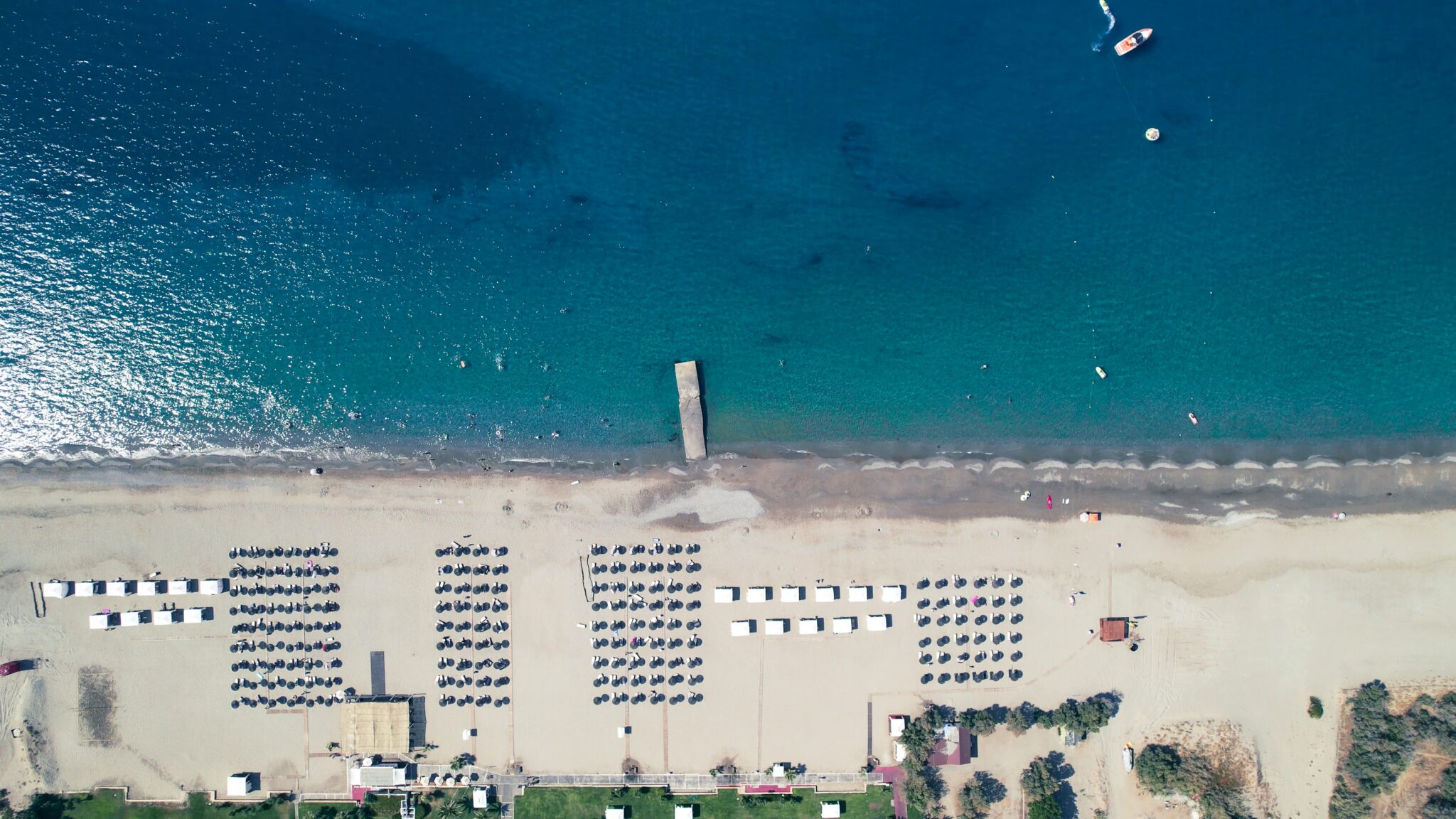
Misiria, Rethymno/Photo: Evangelos Mpikakis, Unsplash
The long-running innovation on the island is well illustrated by the Rythimna hotel’s response to notorious food authority rules implemented in the mid-1980s , specifying dish portion quantity lower limits that needed to be maintained. The hotel introduced breakfast buffets offering local produce, establishing a trend that has continued to flourish in various forms throughout the Cretan tourism industry.
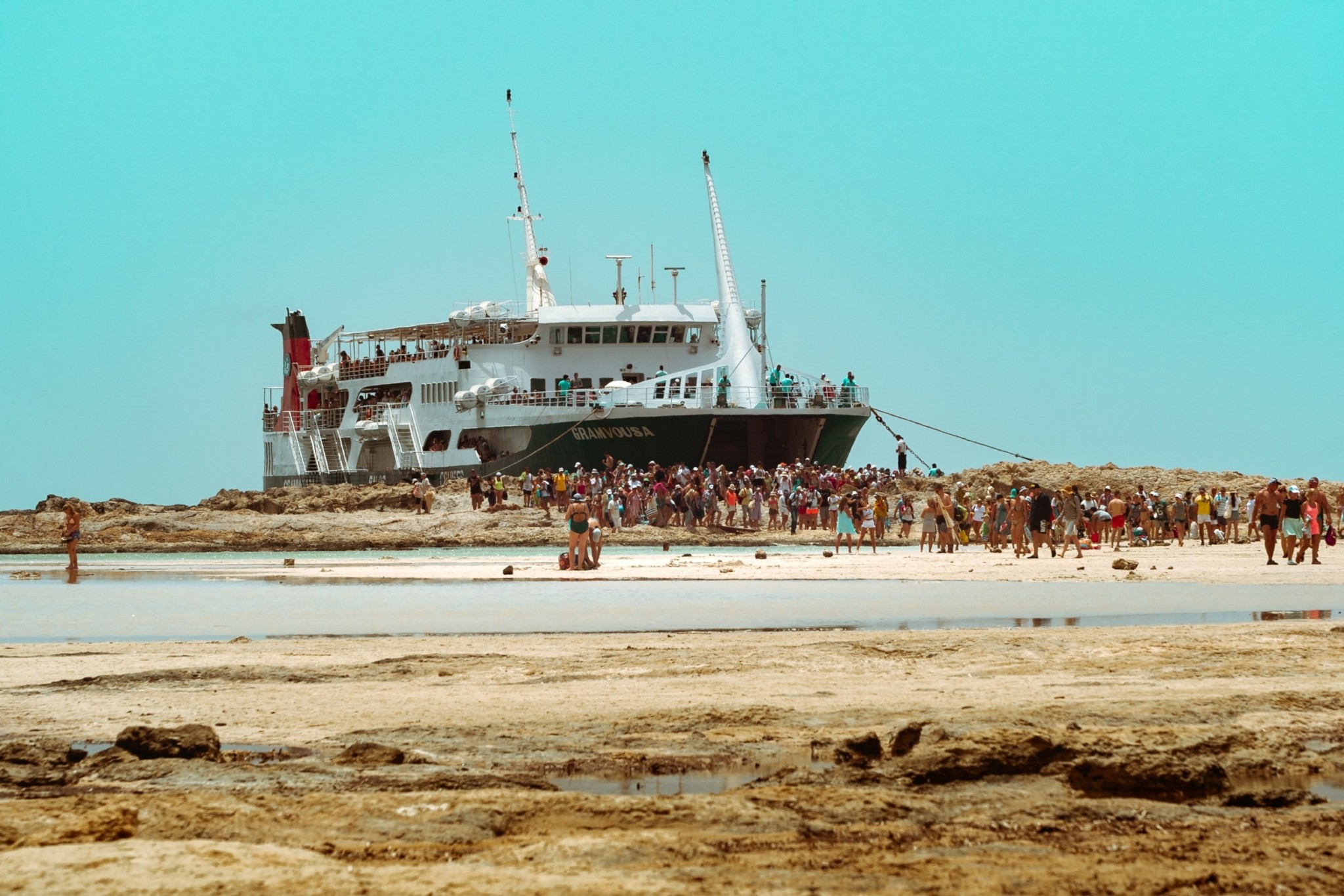
Balos/Photo: DTMH Digital Studio, Marketing Greece
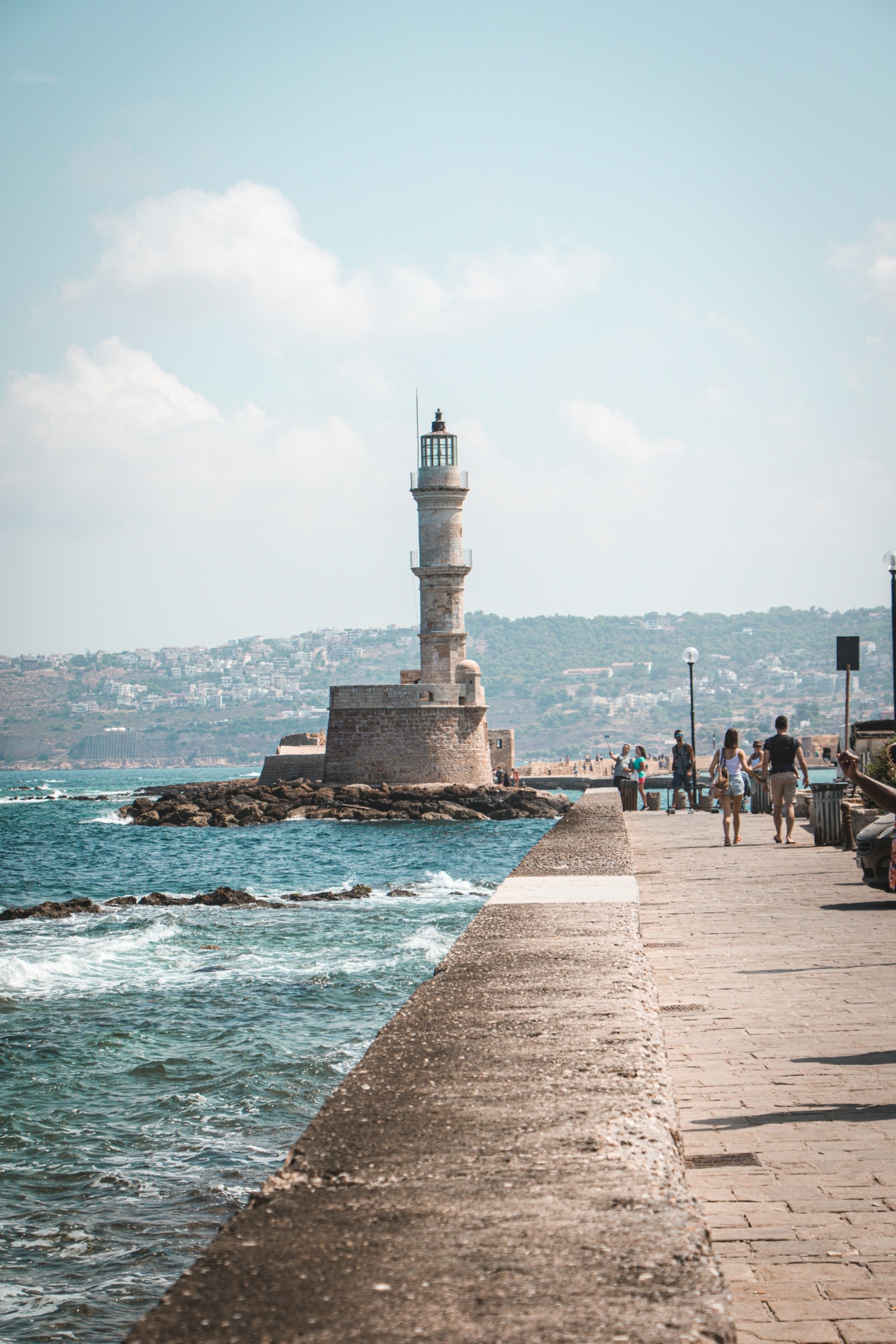
Photo: Adrien Delforge/Unsplash
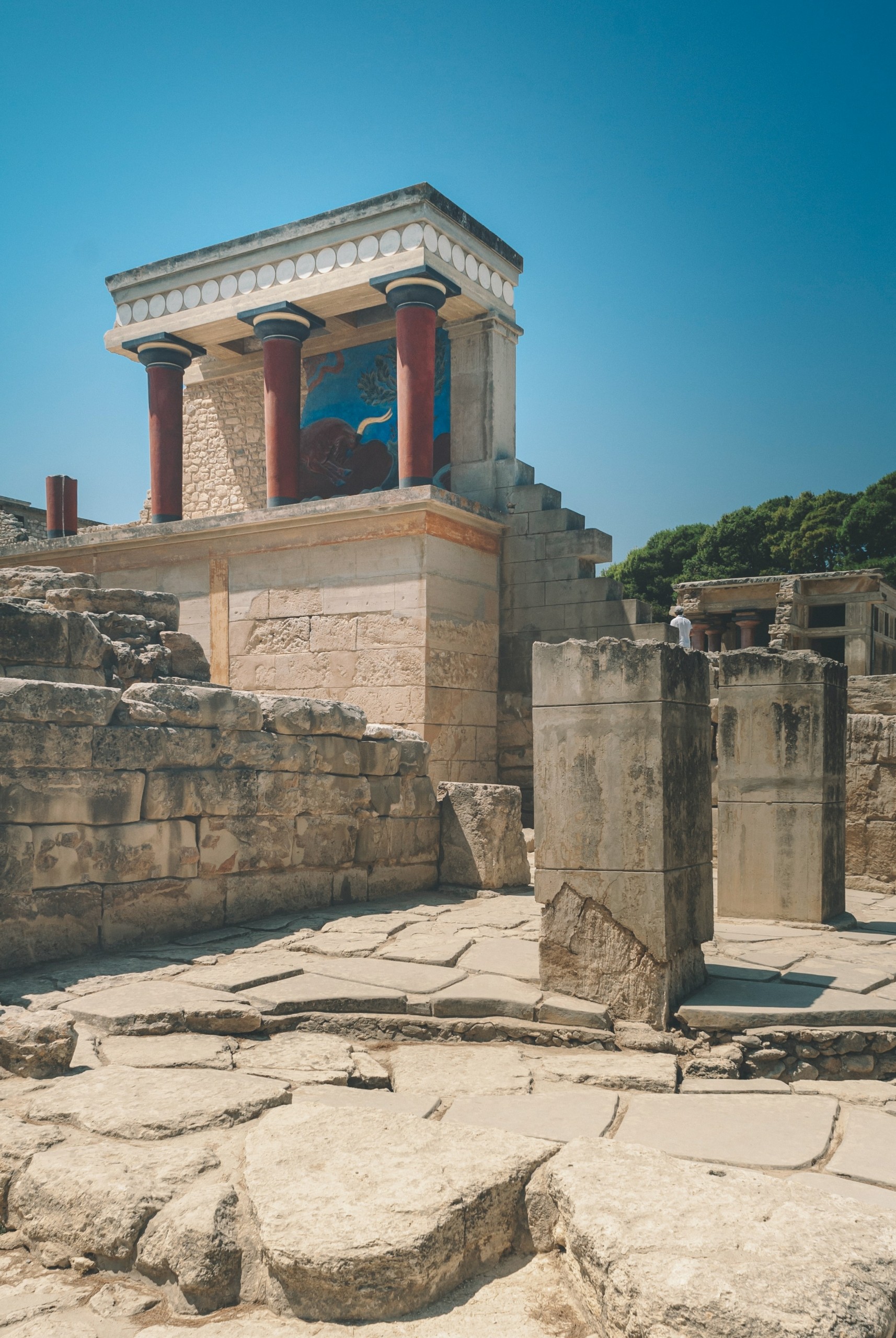
Knossos/Photo: Unsplash
One advantage enjoyed by Crete as a destination, longer stays on the island by visitors, compared to other renowned attractions such as Mykonos or Santorini, has been fully utilised by Cretan hoteliers. “The duration of tourist stays on Crete used to be as long as 15 days . It remains relatively high, averaging 8.2 days ,” explained Dimitris Kalaitzidakis , Director of Operations at Grecotel Hotels & Resorts. “This enabled all of us to approach tourists and acquaint them with Cretan gastronomy and culture. Nikos Daskalantonakis [co-founder of Grecotel] was also a pioneer in this field. After all, before he became involved in tourism, he was an olive oil and organic dairy products merchant who always appreciated the efforts of producers and the quality of produce. He managed to make his food brand synonymous with principles associated with health and culture. His vision to supply hotels with fresh organic food products led to the establishment of the Agreco farm , which created an organic farming culture and offered an exciting experience for visitors.”
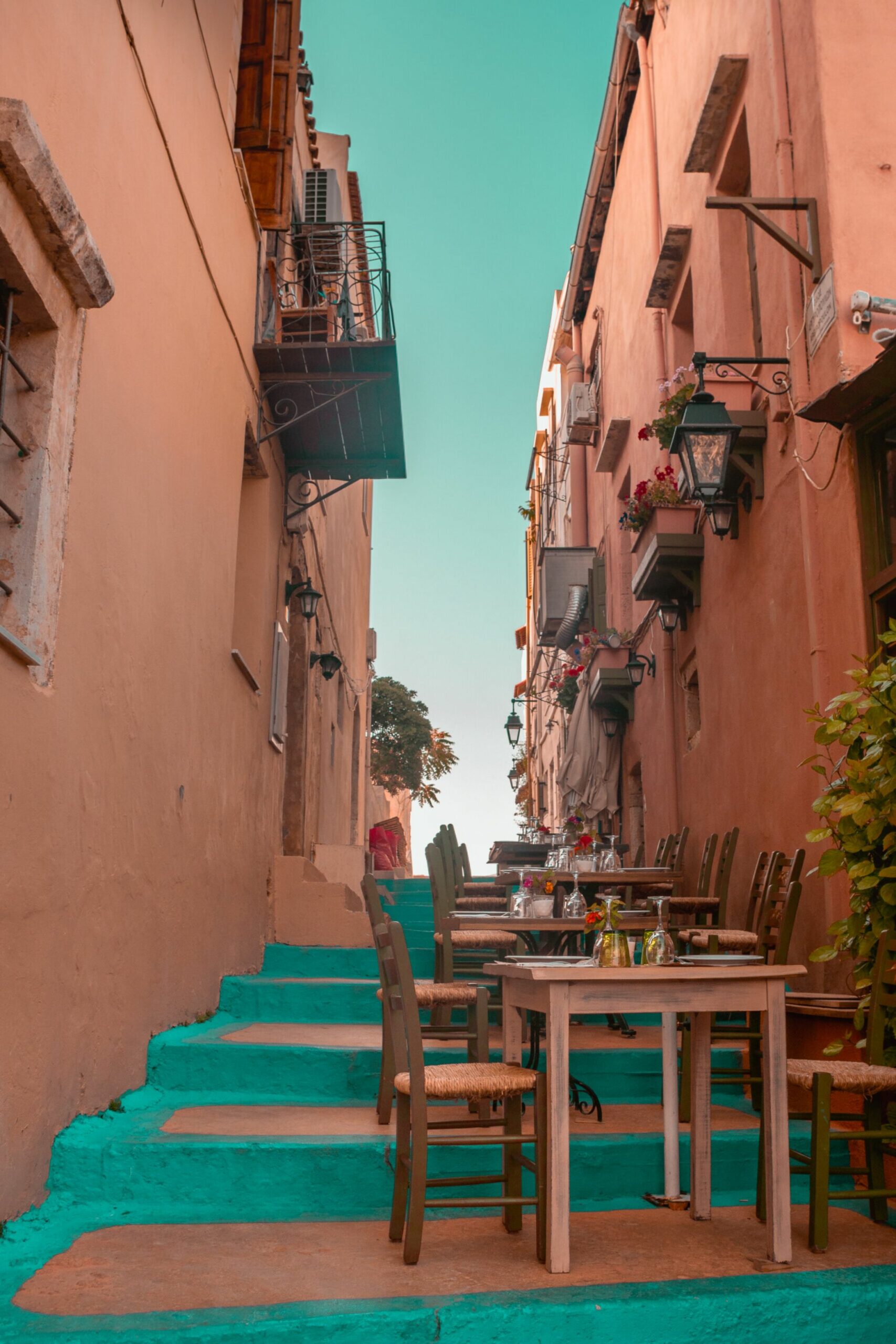
Rethymno/Photo: Μarketing Greece
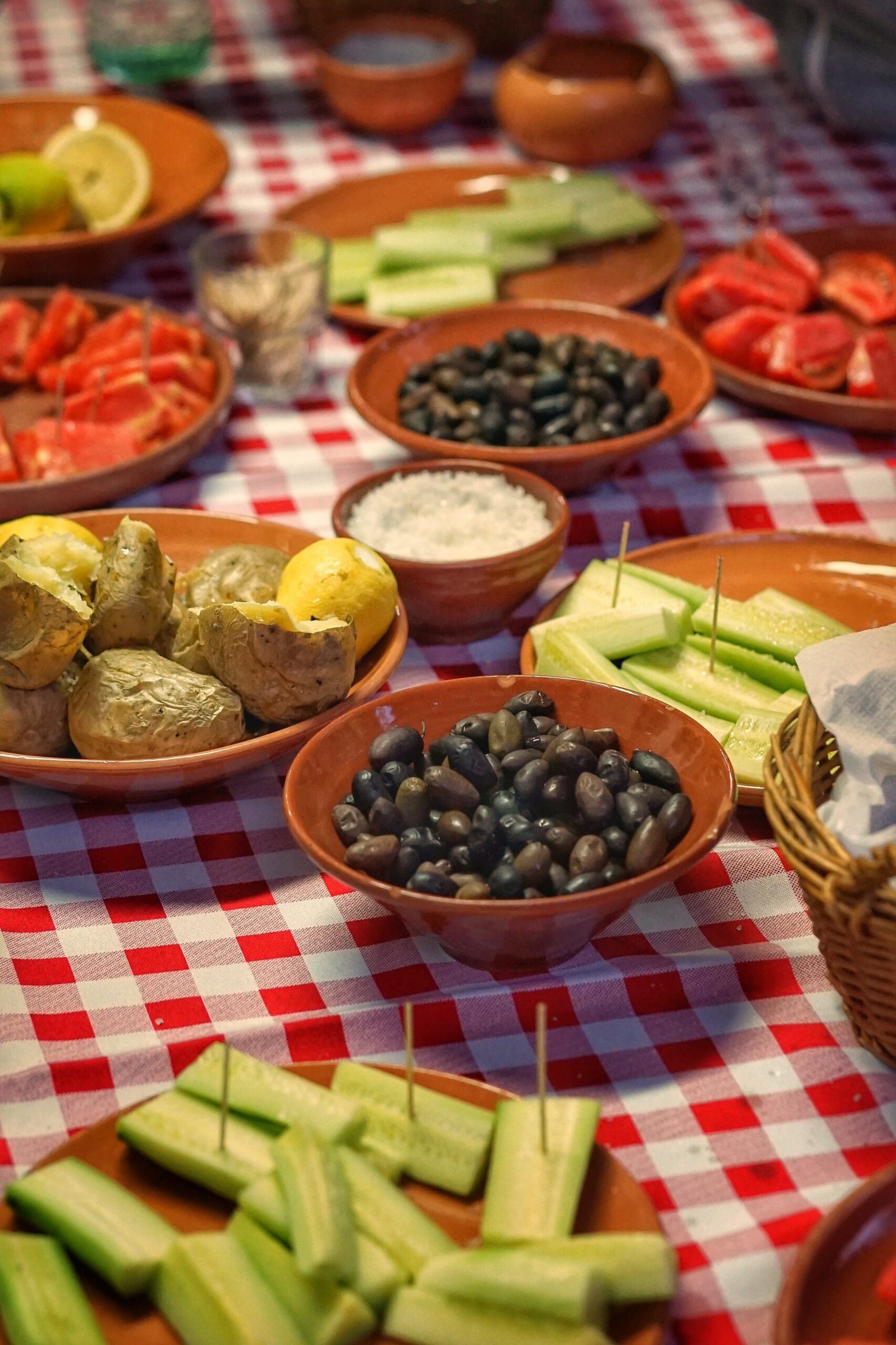
Photo: Robert Anasch/Unsplash
Cretan enterprises supported Cretan gastronomy, designed experiences that highlighted the soul and essence of the island, ultimately establishing a unique tourism product in the global market.
Crete 2021: Occupancy rate between 70 and 94% in August
Crete , this season, is aiming to regain a large percentage of ground lost last summer following record tourism figures registered in pre-pandemic 2019 . Looking further ahead, the island is striving for a return to full normality in 2022 and 2023 .
High occupancy rates have been registered for accommodation units at popular destinations around the island for the week covering the mid-August summer peak.
More specifically, according to Booking.com data, the overall occupancy rate for Hania accommodation booked through the global platform for August 9 to 15 has reached 94 percent . The price range covers all levels, while, in many cases, the owners of accommodation units have offered discount prices, evening during the peak August season, a virtually unheard of strategy prior to the pandemic. Accommodation prices at small units and mountainous areas begin from 174 euros per night,for 6-night bookings , and reach 4,800 euros at luxury hotels.
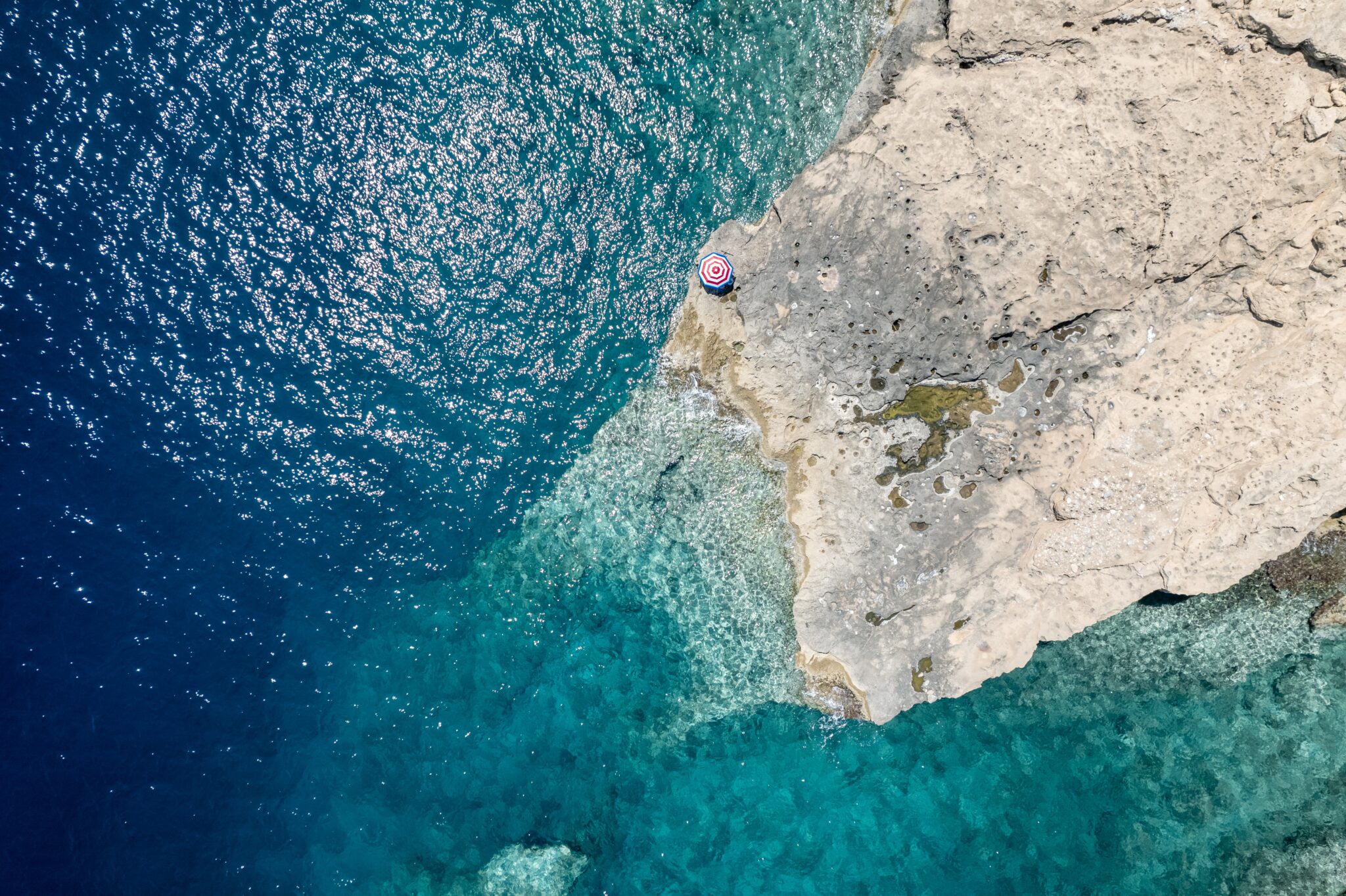
Photo: Evangelos Mpikakis, Unsplash
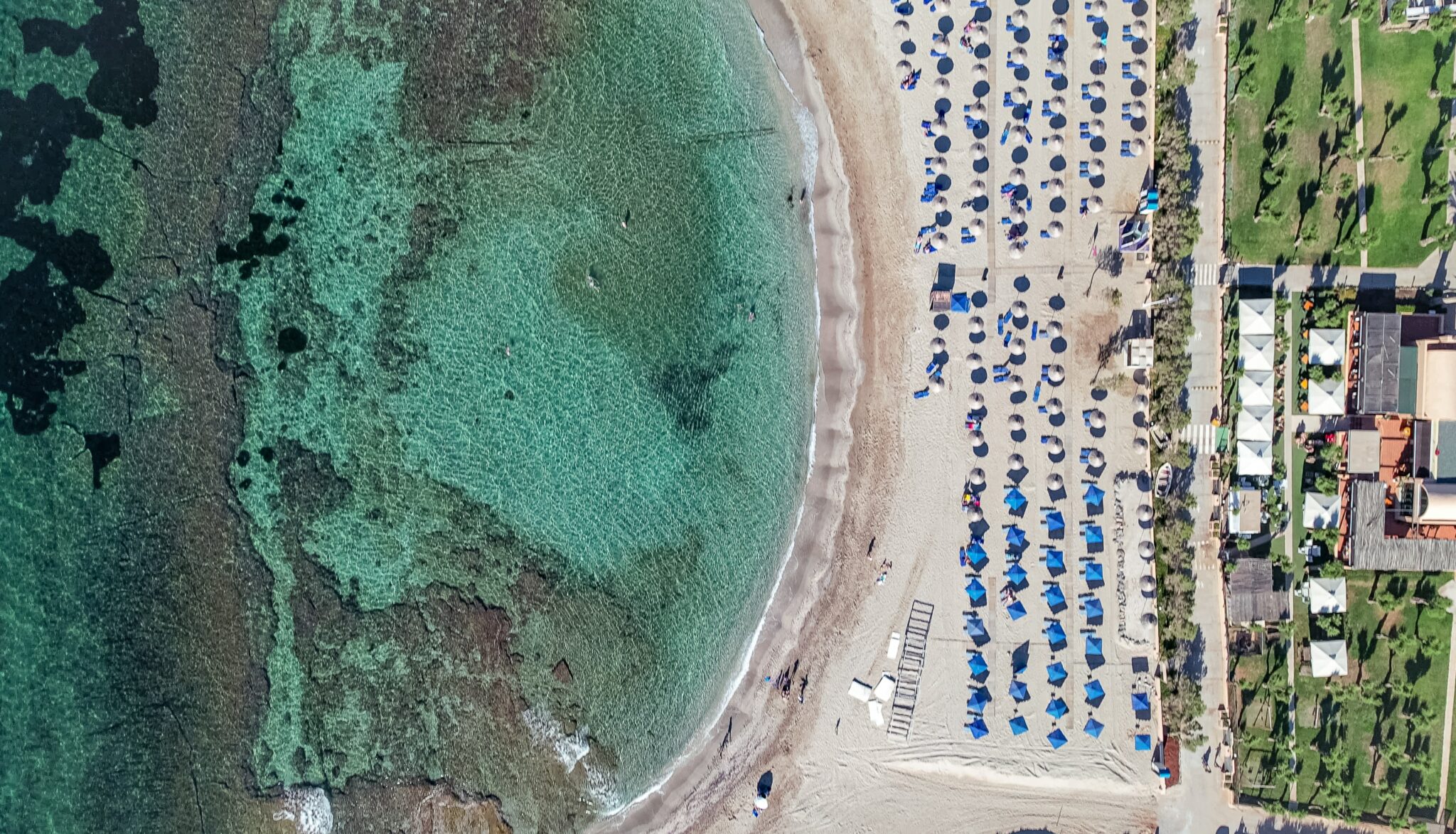
Anissaras/ Photo: Evangelos Mpikakis, Unsplash
In Heraklion, where the accommodation supply is greater, the occupancy rate for the equivalent period has reached 78 percent . Prices begin from 150 euros per night for small studio rooms and reach 13,482 euros at five-star hotels.
In Elounda , a location renowned for its luxury accommodation, the occupancy rate for the August 9-15 period, according to Booking.com , is 86 percent . Prices for apartments begin from 330 euros and reach 9,312 euros at luxury 5-star hotels.
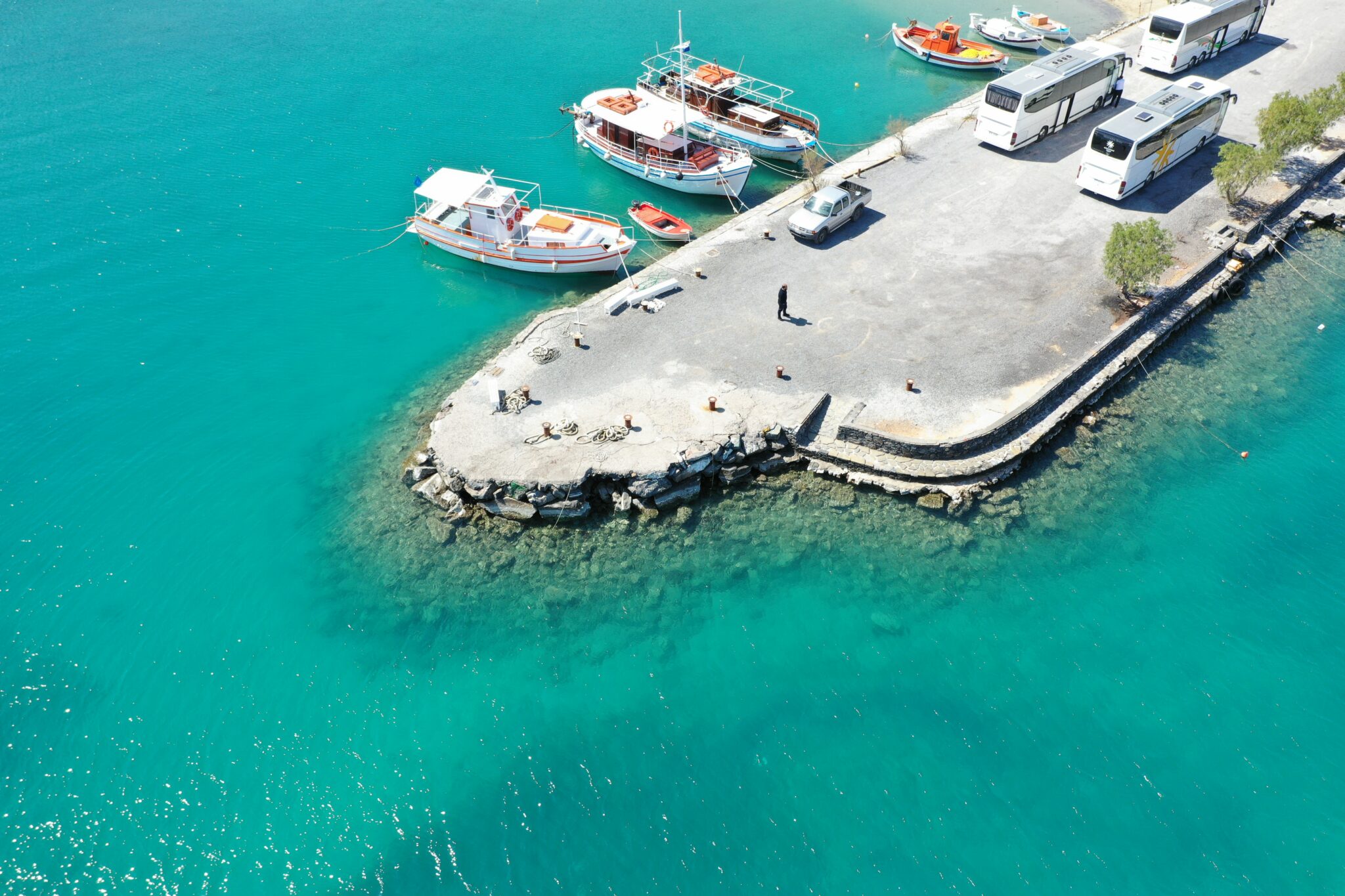
Elounda/Photo: Manousos Bouloukakis, Unsplash
At Ierapetra , the occupancy rate, according to the international booking platform, is 88 percent for the peak August week, prices beginning at 451 euros per night and reaching 1,620 euros per night.
The heightened activity planned by airlines for the weeks beyond mid-August strongly suggests the remainder of the season will be improved compared to the equivalent period last year.
Latest data provided by INSETE , the Association of Greek Tourism Enterprises, has shown that flights carrying a total number of 275,234 passengers from 15 countries are scheduled to arrive at Heraklion airport between August 9 and 22 . Germany is the biggest source of this imminent influx, followed by the UK and France .
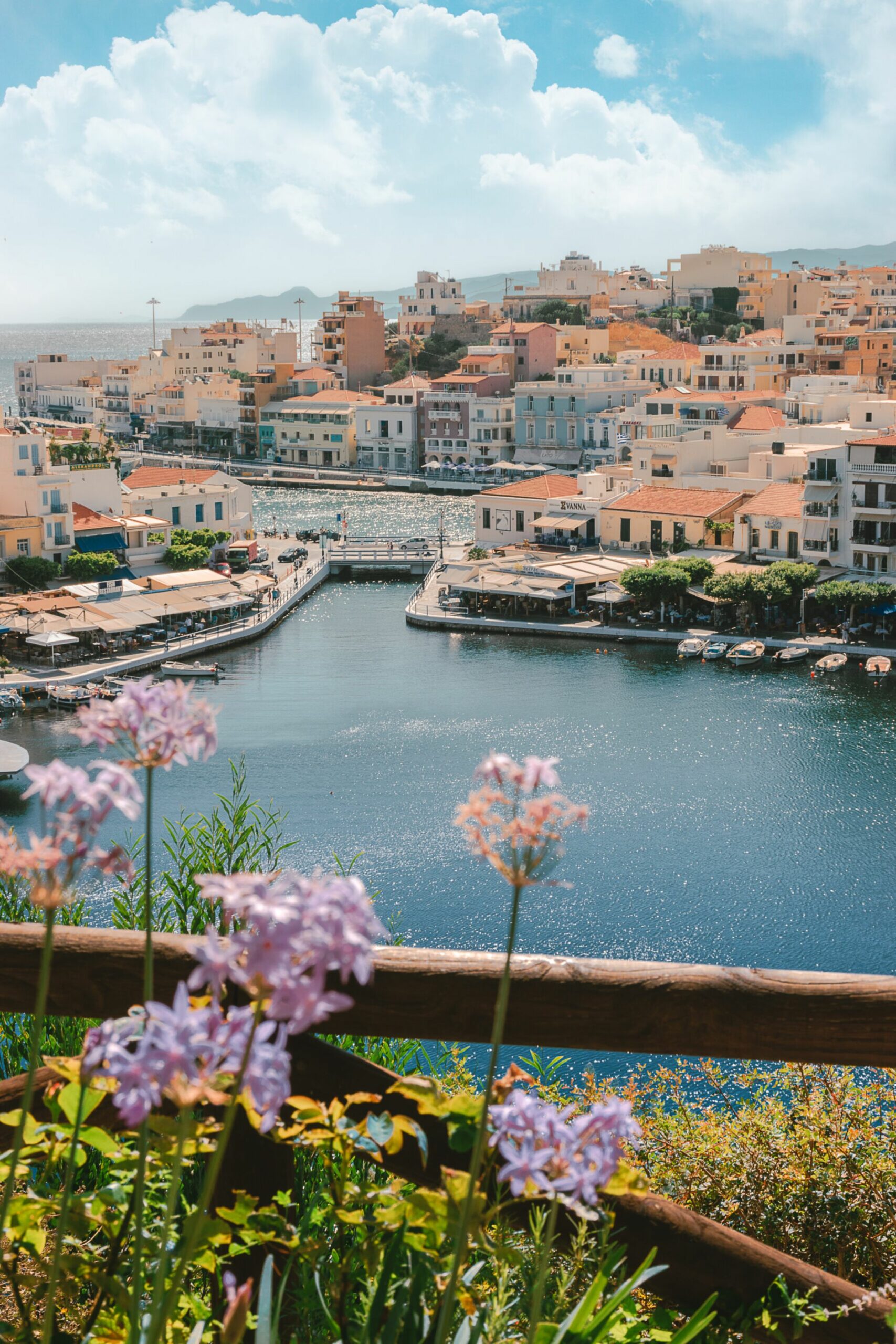
Agios Nikolaos/Photo: Marketing Greece
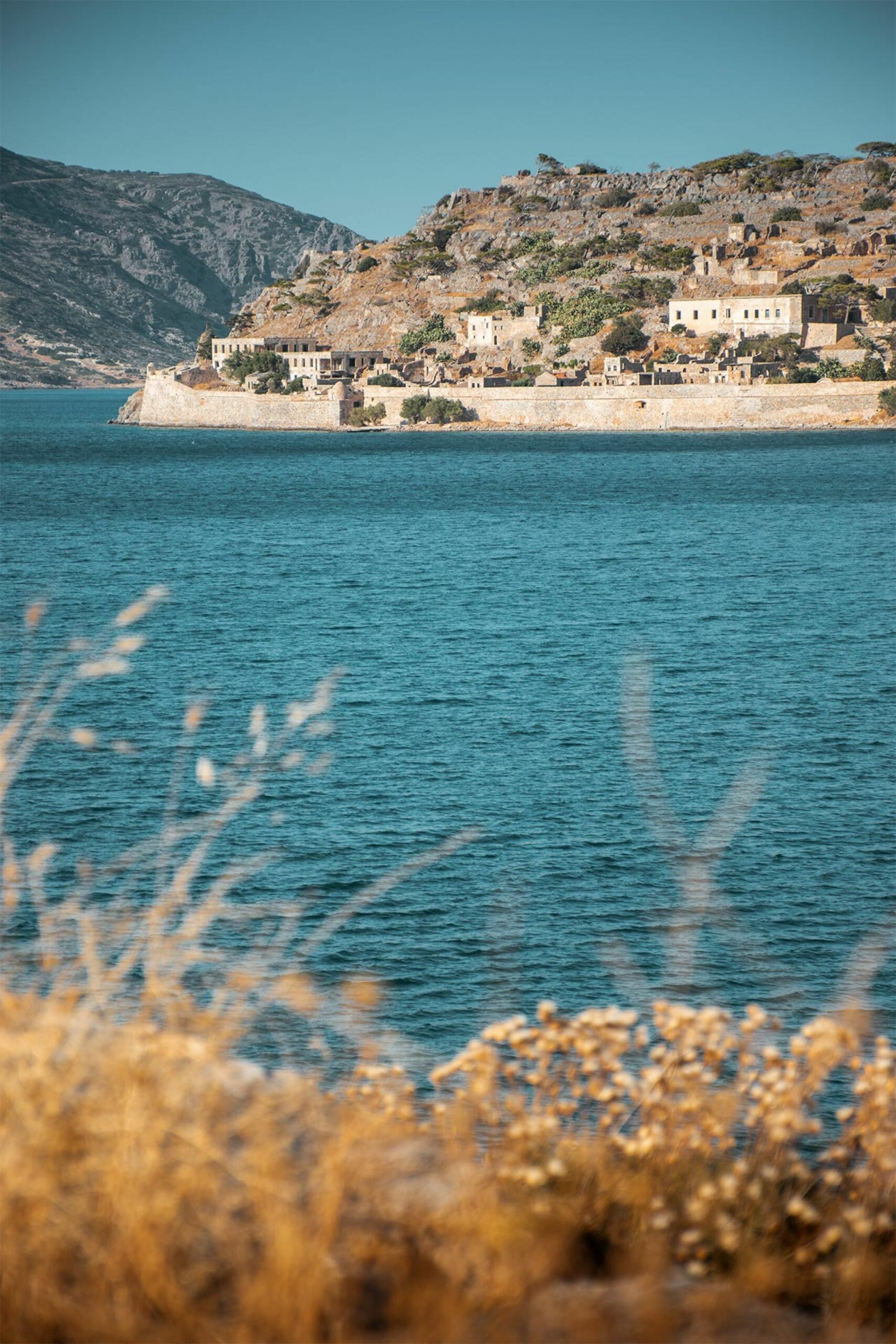
Crete’s upbeat prospects are highlighted by the solid investment interest that was maintained by entrepreneurial groups on the island in 2020 , despite the pandemic-induced flatness, for the development of new hotels on the island. It is estimated that hotel groups last year secured at least 28 project permits for the construction of projects, primarily luxury units. Other key infrastructure that promises to further enhance the island’s profile includes the development of a northern highway linking Kissamo with Sitia , to stretch approximately 300 km. Prime Minister Kyriakos Mitsotakis has already announced funds, for this project, worth 2 billion euros in coming years. In addition, a new airport is planned for Kasteli , southeast of Heraklion. Preliminary work is already underway for this project, to provide further impetus to tourism on the island.
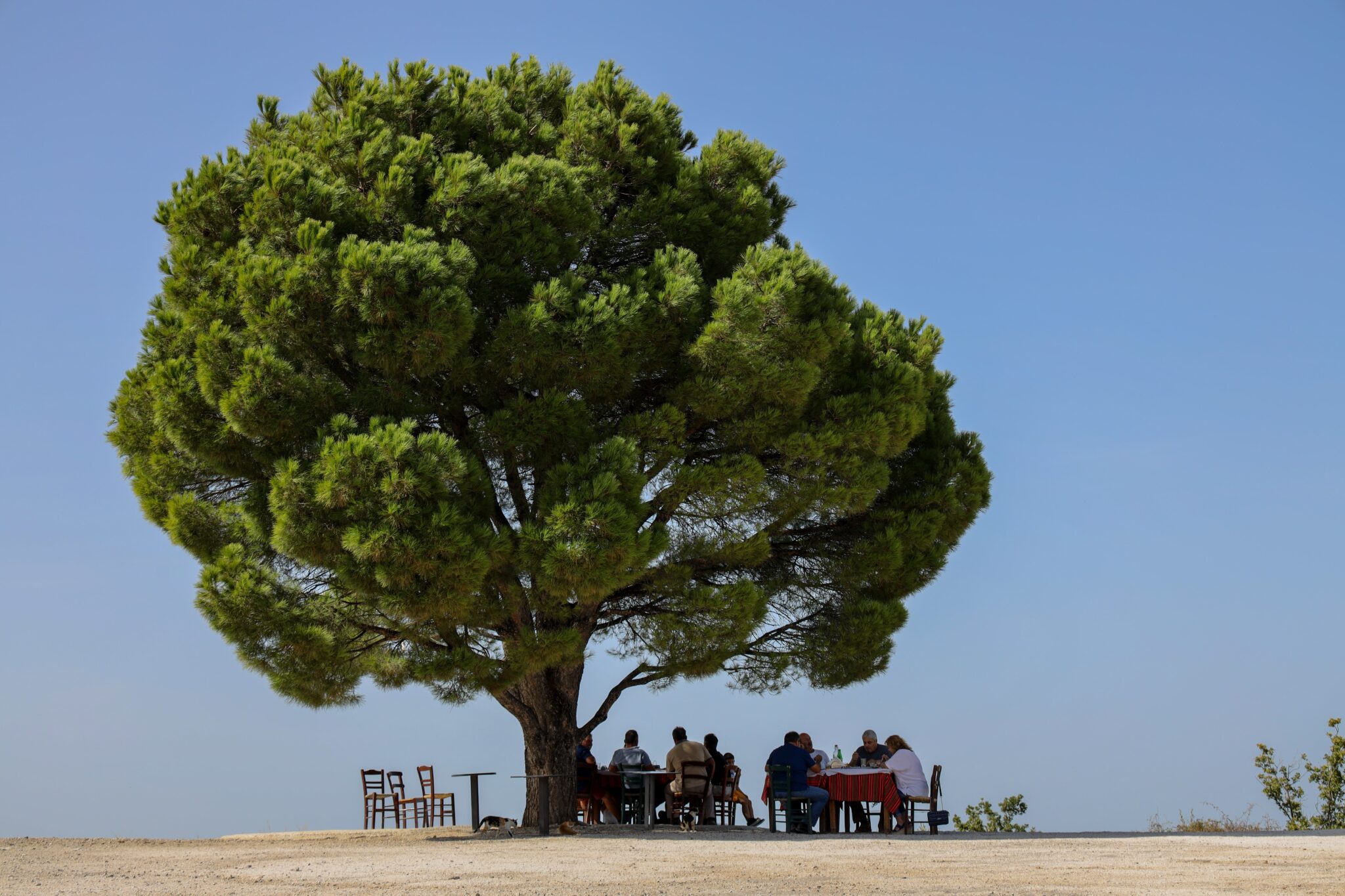
Photo: Mor Shani, Unsplash
According to latest data provided by the Hellenic Chamber of Hotels , a total of 1,619 hotels with 96,367 rooms and 187,599 beds were registered on Crete up until the end of 2019 . Of the total number of hotels, 128 belonged to the five-star category , 330 were four-star , 392 were three-star , 589 were two-star and 180 were one-star . In terms of hotel beds, the total was 48,061 in the five-star hotel category, 63,189 in the four-star category, 32,838 in the three-star category, 34,899 in the two-star category and 8,612 in the one-star category.
In 2020 , Crete hosted 1.23 million tourists , down sharply from 5.29 million in 2019 , according to Bank of Greece data. Germany was the leading market, its arrivals to Crete totaling 449,800 , compared to 1.32 million in 2019 . The UK was ranked second with 149,900 tourist arrivals to Crete, down from 596,100 in 2019, and France was ranked third with 149,600 arrivals from 584,200 in 2019.
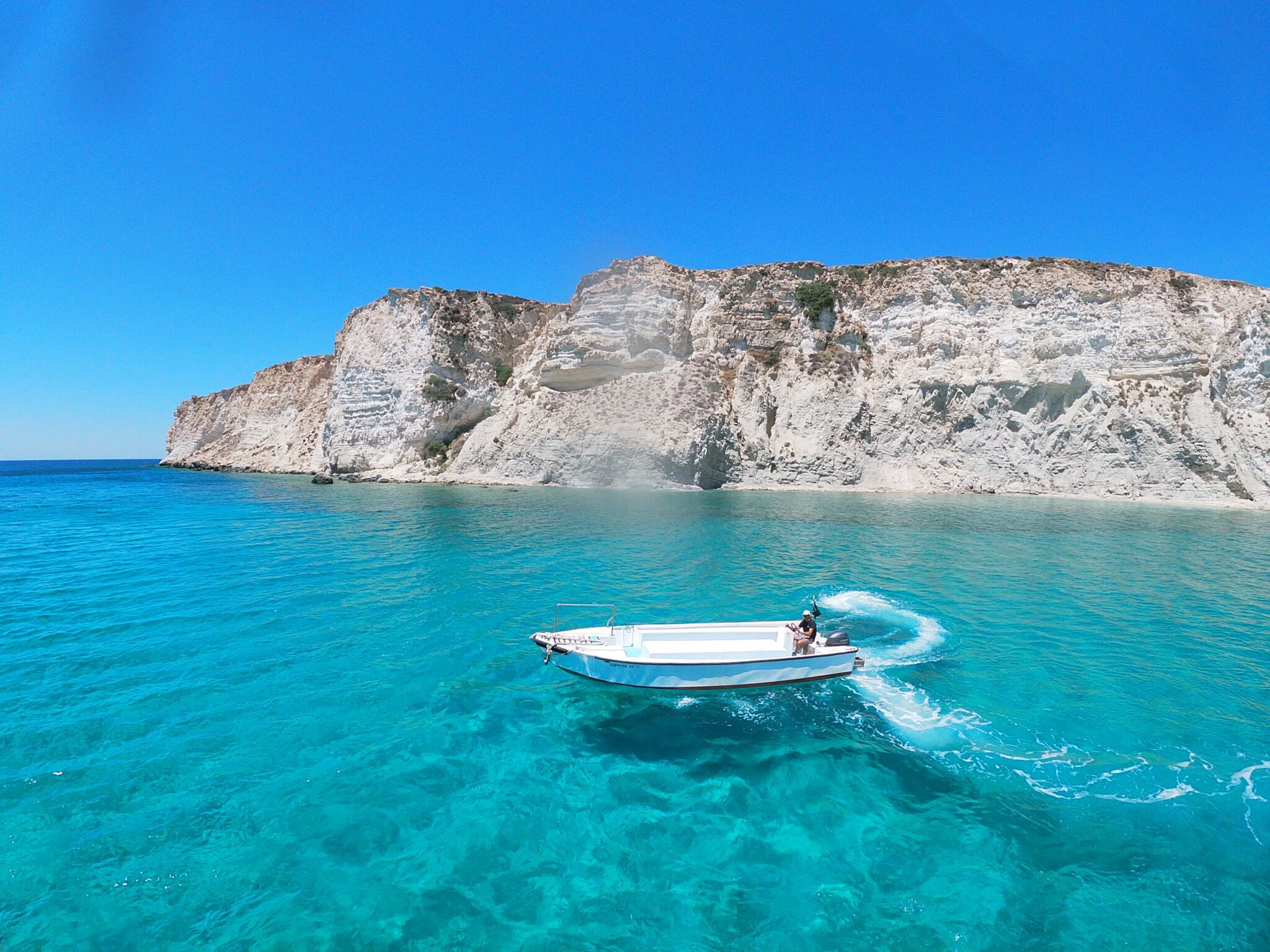
Photo: Elena Dimaki, Unsplash
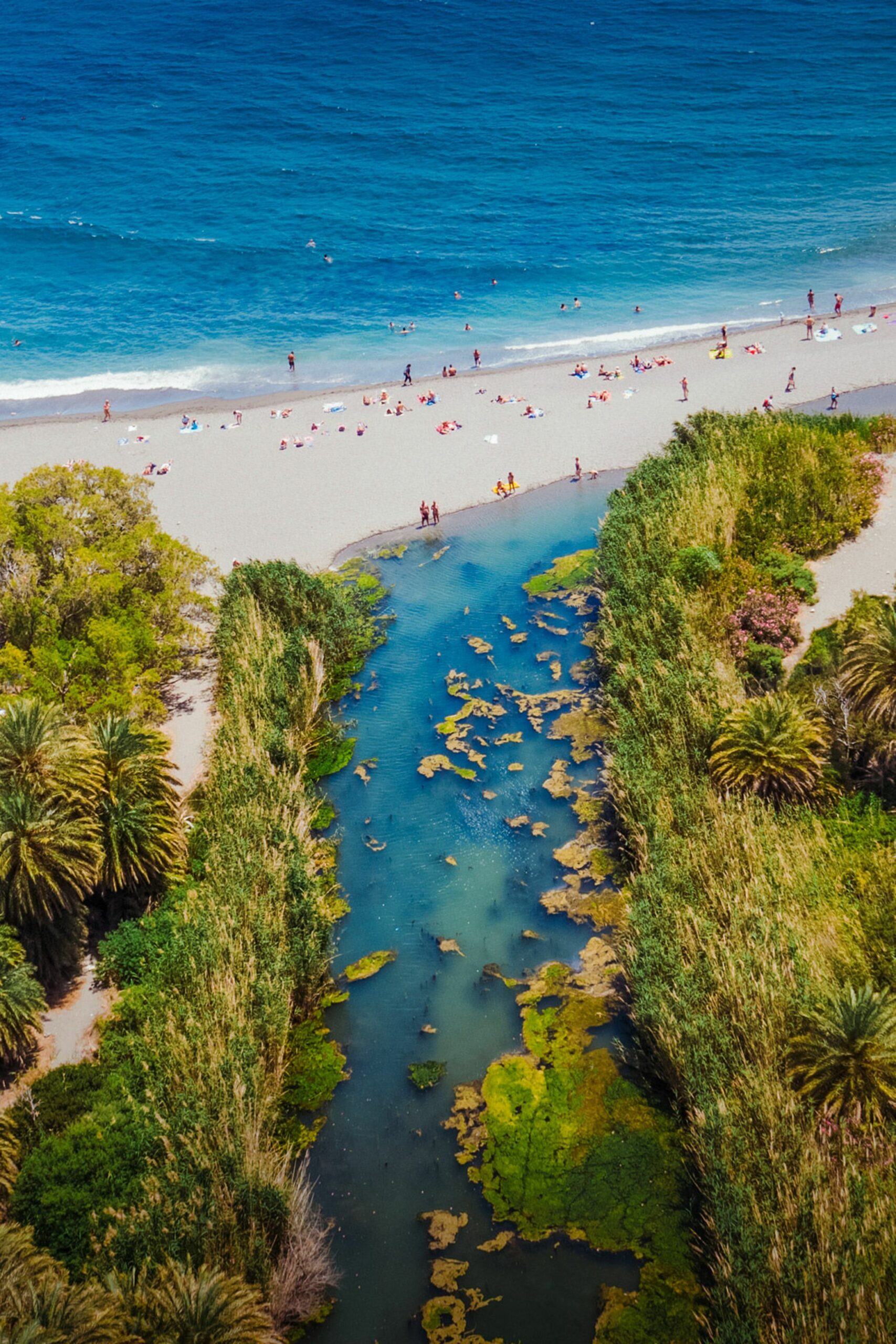
Preveli/Photo: Marketing Greece
Tourism industry revenue on Crete totaled 861.4 million euros in 2020 , sliding from 3.6 billion euros in 2019 . Germany was the leading source of the island’s tourism revenue in 2020 , responsible for the inflow of 330.2 million euros, down from 972.3 million euros in 2019 . The UK followed with 114.9 million euros from 420.1 million euros in 2019 , while France was ranked third, supplying 110.1 million euros in 2020 from 399.5 million euros in 2019 . Crete captured a 20 percent share of total tourism industry revenue in Greece in 2019 , according to INSETE data. International flight arrivals to Crete registered a 26 percent increase between 2014 and 2019 , from 3.5 million to 4.5 million. In addition, Crete holds a 4 percent share of the country’s boat-passenger activity. The figure for Crete rose by 17 percent between 2014 and 2019 , from 2.7 million to 3.1 million. During the same period, the total number of persons employed in the hospitality sector increased by 21 percent , from 17,000 in 2014 to 21,000 in 2019 , while the number of employees at accommodation units increased by 37 percent , from 14,000 to 19,000 .
In 2020 , 10.5 million overnight stays were registered on Crete, approximately one quarter of the 43.26 million recorded in 2019 . The average duration of stays on Crete last year was 8.5 nights, marginally up from 8.2 nights in 2019 . Also, tourists on Crete spent an average of 697.2 euros in 2020 , over their entire stays, compared to 681 euros in 2019 , while the average amount spent per day was 82 euros in 2020 from 83.2 euros in 2019 .
RELATED ARTICLES
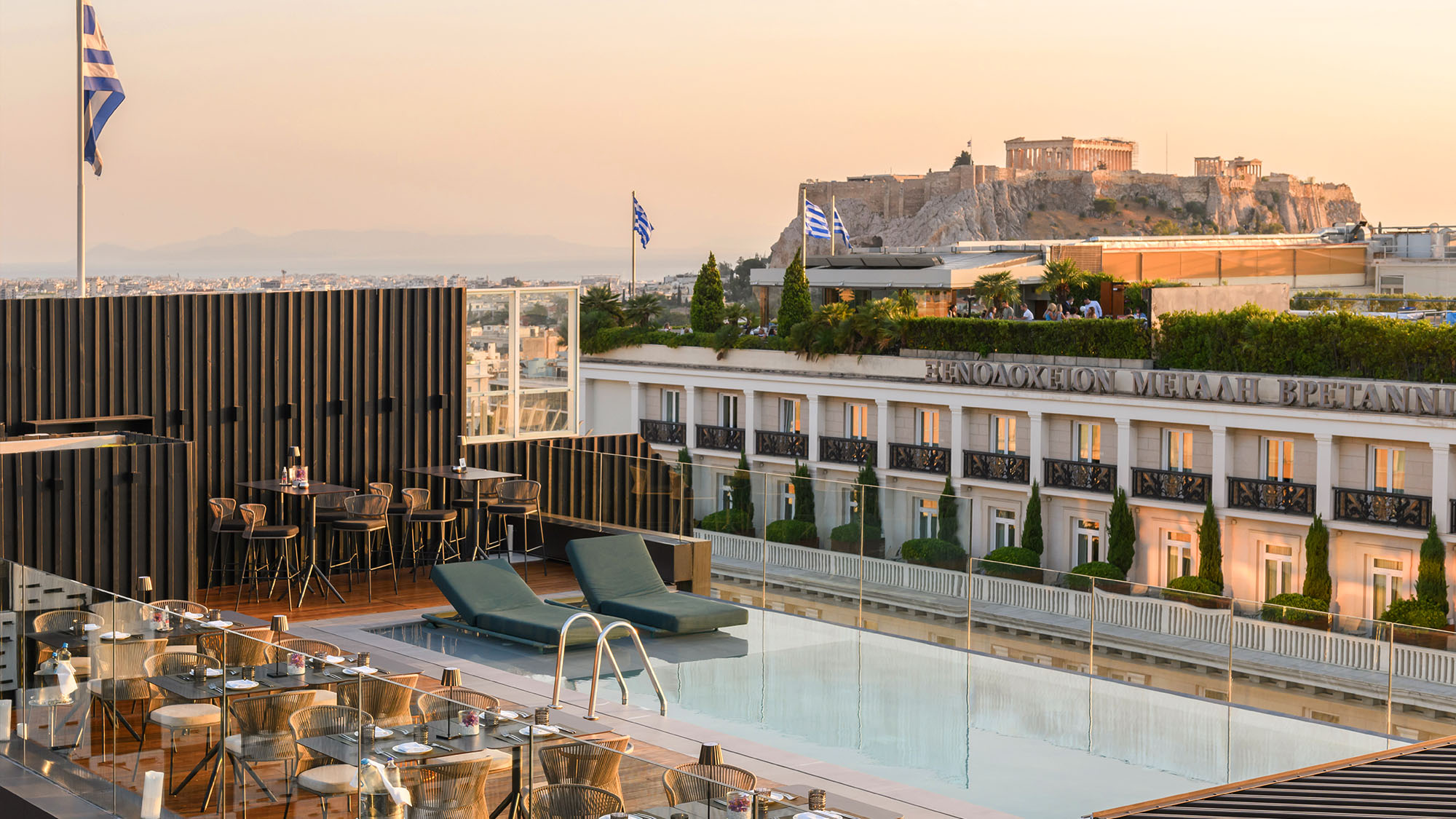
Athens Hotels 2024: Where to Stay Now
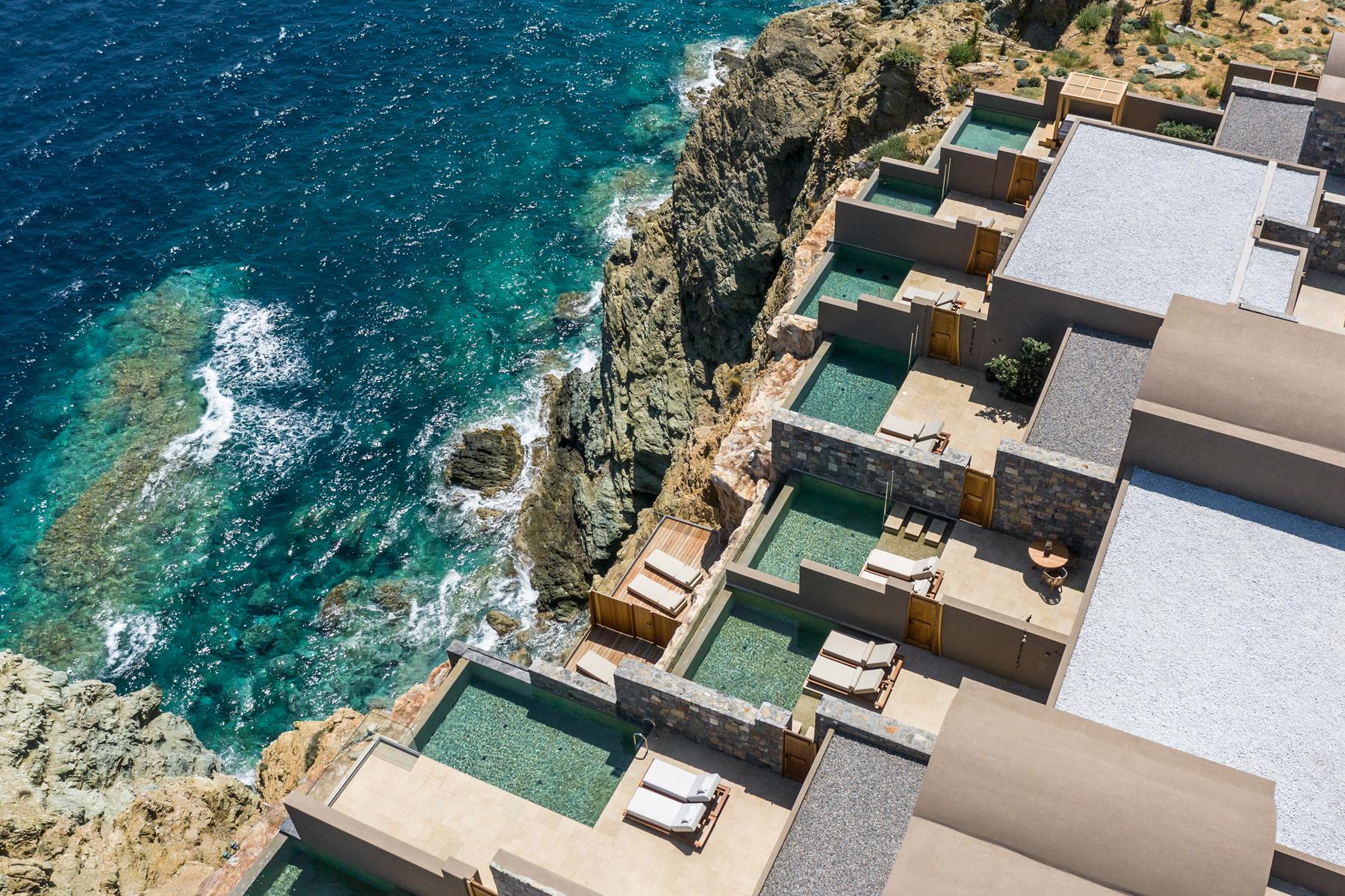
HOTELS & VILLAS
5 adults-only spa hotels in crete that won’t break the bank.
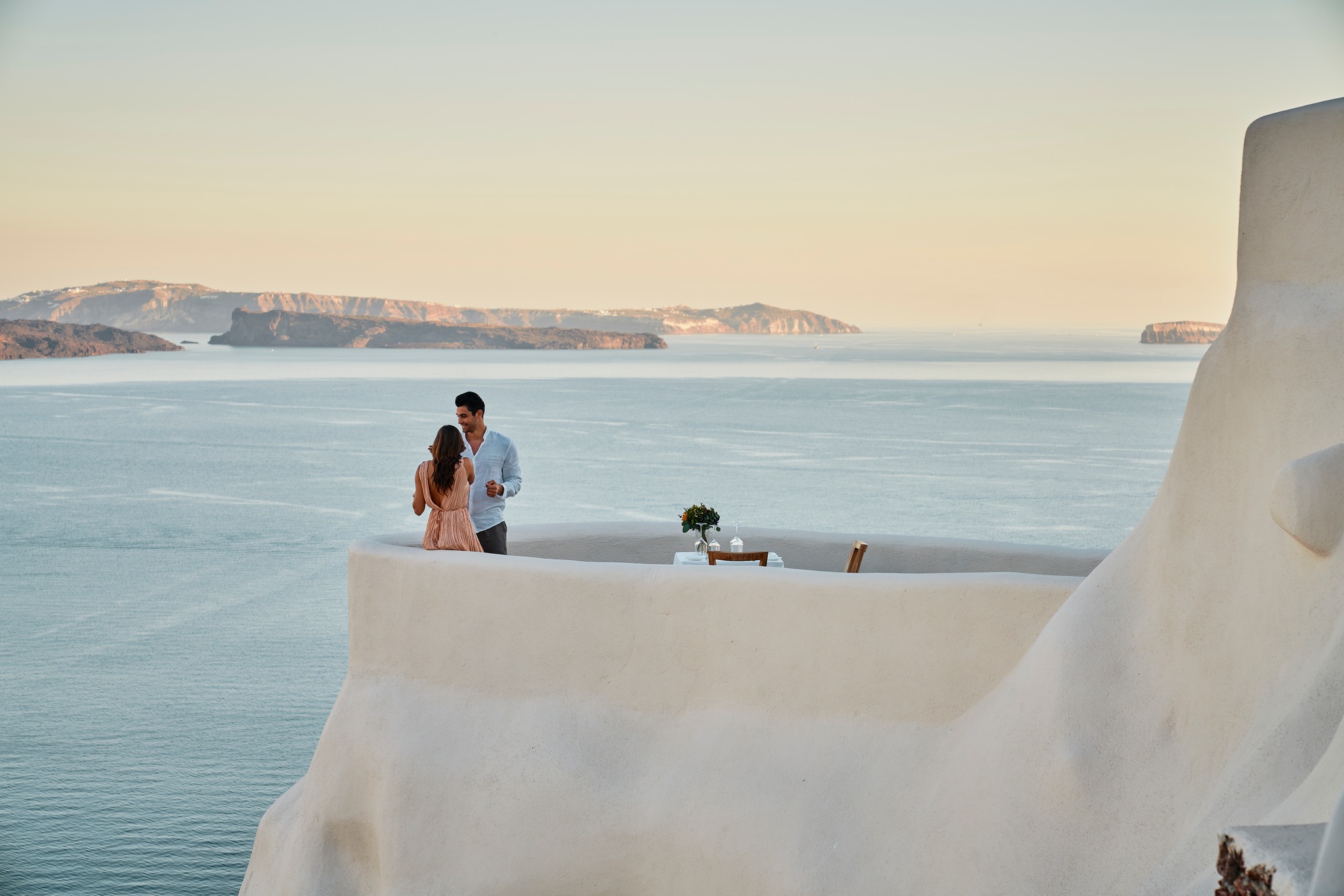
EXPERIENCES
Summer loving: greece’s 7 most romantic islands.
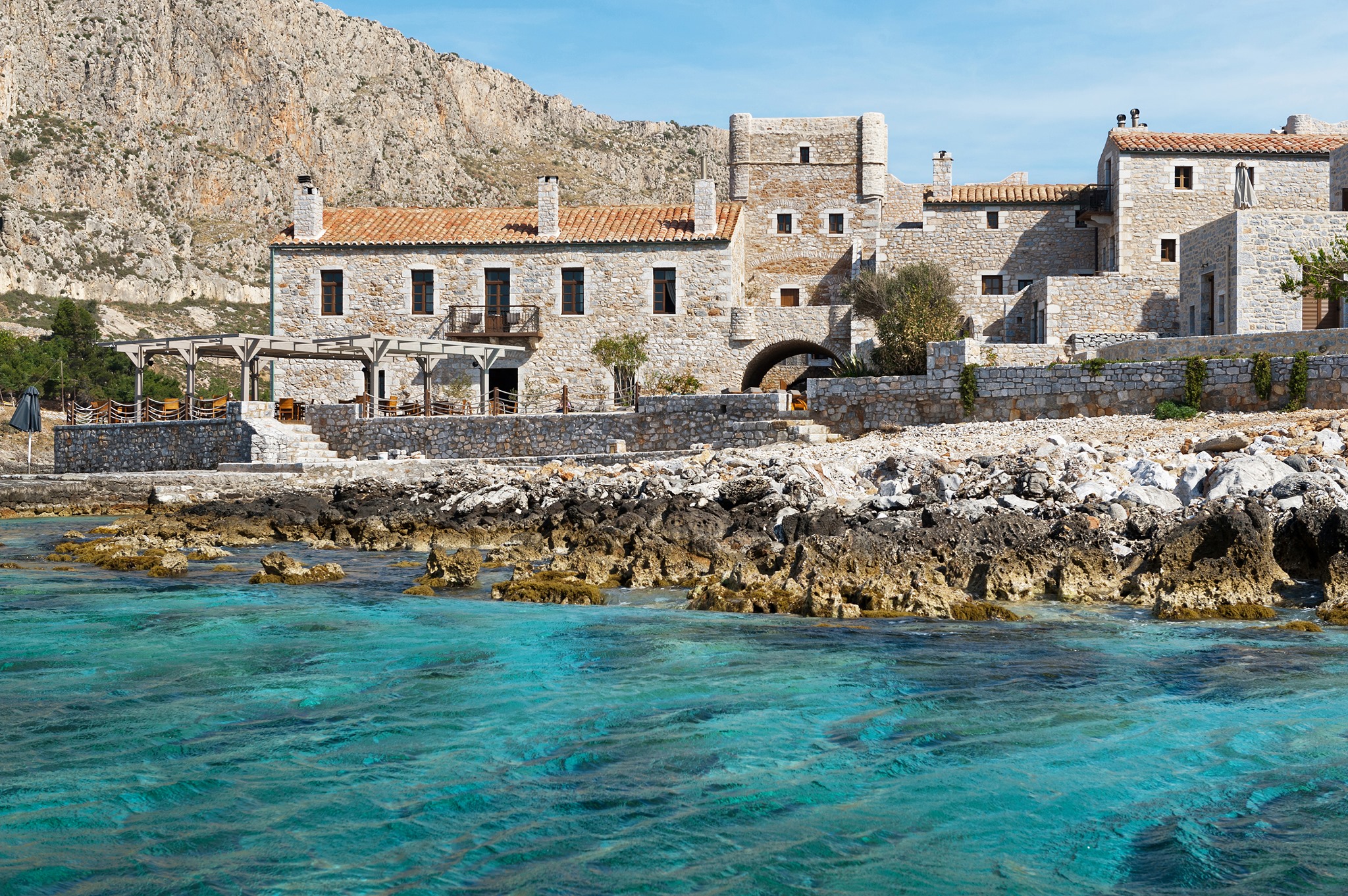
Top 5 Historic Hotels in the Peloponnese

22°C / 71°F Rethymno
#incredible_crete, sense the authentic, welcome to our island.
The mountains and sea, the nature all around you, adventures awaiting you, the overabundant gastronomy, a culture which is expressed in many different ways, the music and art forms.
Crete is the largest Greek island and a landmark in the maritime crossroads between the West and the East, Europe and Africa, a unique and fascinating place full of transitions and surprises.
With its infinite coastline and mountain tops, a history that spans back to the end of times and a distinctive identity that bears its mark on every corner of the Cretan land, it is a one of a kind destination for every type of traveller.
Whether coming to the island for the first time or as a regular visitor, the endless beauty of Crete, either visible or out of sight, is unparalleled and yearns to be discovered.
From one side of the island to the next and from dawn to dusk, let yourself be swept away by its alluring nature and you will uncover YOUR OWN and Authentic Crete!
Necropolis of Armeni
Explore seasons.
Crete is an ideal place to visit all year round. Its mild climate and its unique mountainous features attract visitors before and after the established touristy summer season. Crete’s stunning natural beauty awakens in visitors an imperative need to discover its mountains, its gorges, its paths.
Nothing is repeated in Crete. Enormous geological contradictions and special weather conditions have formed unique landscapes, surprising the visitors and keeping senses constantly alert. Each route in Crete is unique. Variant sensations, pictures, colors, flavors, sounds accompany visitors at every step.
From the dunes of Lafonissi and Xerokambos to the tropical shores of Kedrodasos and Chrissi, from the hidden beaches in the wild gorges of Sfakia and Asteroussia to the emerald bays of Triopetra and Plakias, from Balos and Elounda lagoons to the palm groves of Preveli and Vai, from piney beaches of Ierapetra to the long organized strands of the northern coasts, Crete offers the ultimate combination of carefree holidays and natural beauty.
Crete is a heaven for nature lovers and those combining adventure and fun on their vacation. The island offers a variety of activities and opportunities for exploring nature and promises a unique and unforgettable experience for those who decide to explore it.

Explore Crete
Select an area to learn more about it., explore tastes.
The unique Cretan Diet is a healthy and tasty diet with centuries-old recipes and modern creative versions, which are always cooked, of course, with the same top quality pure products of the blessed Cretan earth. This diet is not just a variety of dishes presented on the table; it embodies a whole philosophy of life, the quality way of life of the Cretan people. The lucky ones that will visit the modern restaurants in the cities or the small taverns and cafes in the country will have wonderful experiences, participating in the life of the local people.
The Cretan Vineyard
Certified companies & products, traditional cretan recipes, latest news, keep what you love.
Create your own personalised experience using our guide. Log in to our website and add your loved posts and locations to your personal favourites page. Create your personal travel guide for your upcoming visit. it’s your Crete, your Experiences!
Login - Register
Find what you like, add to favourites, visit your favourites page, video gallery.

"Crete the island inside you" - Crete Daydreaming

"Crete the island inside you" - Beach Daydreaming

"Crete the island inside you" - Falling in Love Daydreaming

"Crete the island inside you" - Easter Daydreaming

"Crete the island inside you" - Luxury Holiday Daydreaming

"Crete the island inside you" - Inner Self Daydreaming
Events calendar.

The CRETE FESTIVAL – Arts travel to the monuments of Crete
Race of sitia 2022, korissia international regatta canoe kayak sprint & sup in kournas lake, 6ο sitia geopark trail.

When I finally got to Crete , it exceeded all my expectations. There’s a lot to love about Crete beyond its ancient ruins: a beautiful variety of stunning beaches, excellent hiking, quaint historic towns, and incredible food and wine.
Plus, it’s affordable, making it an excellent budget destination to visit. And the island’s size ensures you can explore freely and escape the crowds that flock here during the busy summer months.
This travel guide to Crete can help you plan the perfect visit to this ancient island and ensure you save money in the process!
Table of Contents
- Things to See and Do
- Typical Costs
- Suggested Budget
- Money-Saving Tips
- Where to Stay
- How to Get Around
- How to Stay Safe
- Best Places to Book Your Trip
- Related Blogs on Crete
Top 5 Things to See and Do in Crete
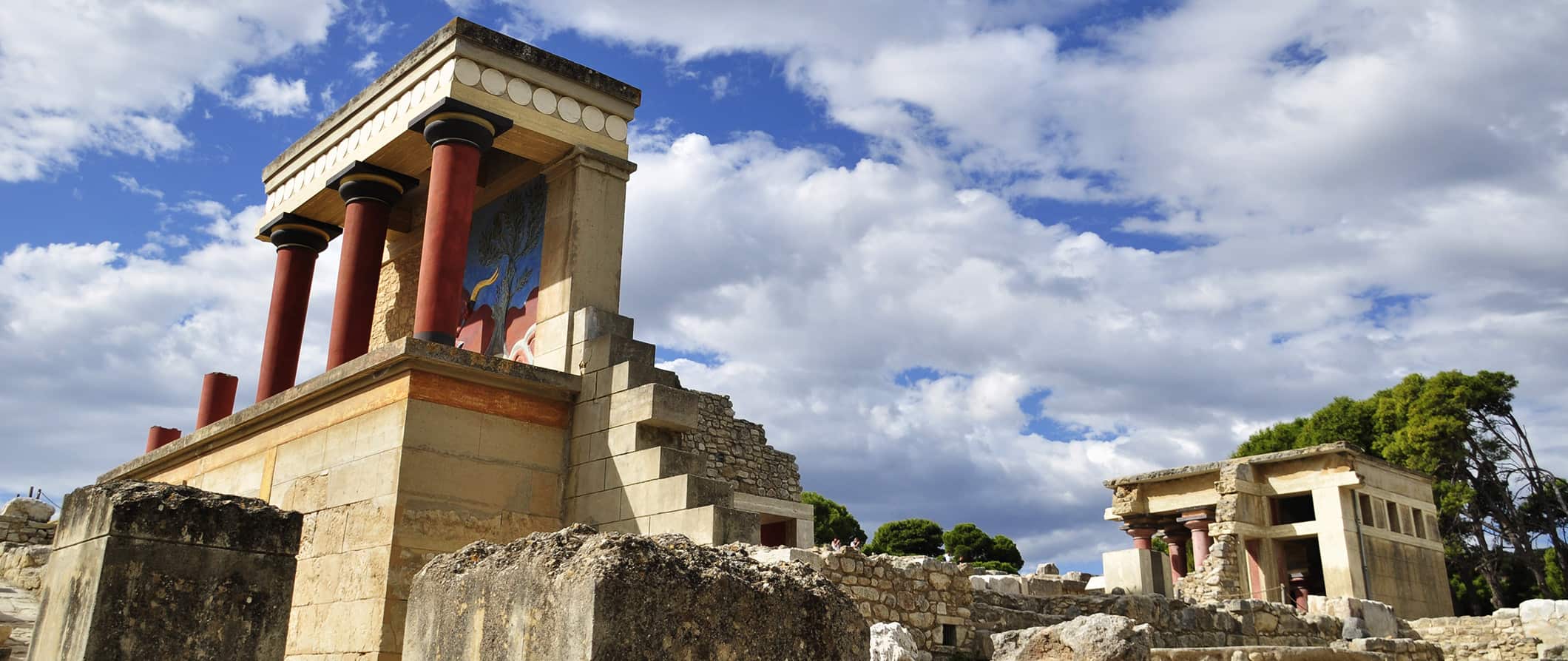
1. Visit the Archaeological Museum of Heraklion
This is Greece’s second-largest archaeological museum. The collection here spans over 5,500 years of history. The museum houses elaborate pottery, jewelry, sarcophagi, colorful frescoes from Knossos, and more. Its Minoan collection is the most extensive in the world. Overall, the museum is incredibly detailed and should not be missed. Tickets are 12 EUR in the summer and 6 EUR in the winter.
2. Relax on the Pink Beach
Elafonisi Beach is located in the southwest corner of Crete, about 75 kilometers (47 miles) from Chania. The waters are crystal clear and the beach has rose-colored sand (hence the name). It is super popular in the summer (so get here early), with rentable sunbeds and umbrellas lining the beach. There are plenty of secluded coves nearby if you want to get away from the crowds. The water is shallow enough that you can walk out to the small island of Elafonisi, which has a tiny lighthouse and unobstructed views of the Mediterranean.
3. Explore Chania
This area has been inhabited since Neolithic times and was a major Minoan settlement named Kydonia. Today, Chania is the second-largest city in Crete and has a scenic Venetian quarter and harborfront lined with tavernas (small Greek restaurants), cafes, and shops. While here, check out the historic Firka Fortress (built in 1620) as well as the Maritime Museum located inside the fortress.
4. Visit Knossos
Knossos was the ancient capital of the Minoan empire and its Bronze Age ruins are some of the oldest in Greece (it’s considered the oldest city in Europe). The area has been inhabited since at least 7000 BCE, flourishing between the 19th-14th centuries BCE. You need a few hours here to roam the rebuilt palaces, courtyards, private apartments, baths, villas, tombs, and more. Admission is 15 EUR (free admission on the first Sunday of every month during the winter).
5. Hike Samaria Gorge
Samaria Gorge is one of Greece’s National Parks and a UNESCO World Biosphere Reserve. The main hike is a 16-kilometer (10-mile) trek that offers wonderful views of the White Mountains and finishes at the beach town of Agia Roumeli. Keep in mind that this is a fairly long, rocky trek that takes around 5-7 hours to complete. Because of the length of the trek, you aren’t allowed to start it after around 2pm (you can still do part of it, but you will have to turn around at a certain point). But for nature lovers, it’s well worth it, and you can grab a beer at one of the seaside tavernas when finished. Try to avoid mid-summer as temps can reach up to 40°C (104°F) and there’s no shade. The park is open May-October and admission is 5 EUR.
Other Things to See and Do in Crete
1. take a trip to spinalonga island.
Located in northeastern Crete, the Venetians built a large fortress here in 1579 to protect Mirabello Bay and Elounda Bay from the Ottomans. The defenses held strong until 1715 when the Ottomans sieged the island. When the Ottomans left in the late 19th century, the island became a leper colony and remained that way for decades. Visitors can now take a boat there and walk a short trail that takes you through the ruined church, a leper disinfection room, a hospital, and a cemetery. Admission is 8 EUR and it’s open from April-October.
2. Explore Koules Fortress
Located in Heraklion, Koules Fortress was built in the 13th century when Crete was under Venetian rule. It was designed to protect the city from invasion and at its height housed a mill, bakery, prison, barracks, and more. Nowadays, you can walk through the tunnels and visit the various rooms. There are a lot of informative exhibits explaining the history of the castle and area too. Admission is 4 EUR (closed on Tuesdays).
3. Visit Aptera
This ancient 12th-century monastery is located just 13 kilometers (8 miles) outside of Chania. During your visit, you can admire the restored monastery as well as the remains of the original fortified tower, a temple from the 5th century BCE, a city gate, monastic walls, Roman cisterns and baths, and an amphitheater. There was also a Turkish fortress built here in 1872 that overlooks Souda Bay. Admission is 4 EUR.
4. See the Lassithi Plateau
The Lassithi Plateau in eastern Crete stands 900 meters (2,952 feet) above sea level. To get there, you have to drive up winding mountain roads overlooking the Dikti mountain range (which is dotted with white windmills). While here, you can visit Psychro, home to the Dikteon Cave that, according to Greek mythology, is the birthplace of Zeus and the place where he was hidden as an infant to be protected from his father. It’s 6 EUR to visit the cave, or you can combine it with a full-day ATV experience across the plateau for 75 EUR.
5. Wander Rethymnon
Located in northwestern Crete, this city is the third-largest in Crete (after Heraklion and Chania). Rethymnon is famous for its spectacular 11-kilometer (7-mile) long beach as well as its Venetian old town, port, and fortress. I love getting lost in the streets here, exploring the 16th-century fortress, and eating all the tasty food the city has to offer. It has a phenomenal food scene!
6. Tour the Historical Museum of Crete
If you’re interested in the more modern history of Crete (from the early Christian period to the mid-20th century), this museum in Heraklion is awesome. It’s small, but there’s a lot to see, including two stunning paintings by El Greco: The Baptism of Christ and View of Mt. Sinai and the Monastery of St. Catherine . There’s also a giant model of the city from the Venetian era (around 1650 CE) before its Turkish occupation, and a re-creation of author Nikos Kazantzakis’s study where he wrote Zorba the Greek (a popular novel-turned-film written in 1946). Admission is 5 EUR.
7. Hit Balos Beach
Balos Beach in the northwest corner of Crete offers a nice mix of white and pink sand, as well as a lagoon that is a warm place for a swim. It’s a peaceful place to hang out and soak up the sun, though it does get very crowded in the summer as it is one of the most popular beaches on Crete. You can get here by car (and then hike down to the beach), ferry (though it doesn’t leave a lot of time at the beach), or private boat. There are no places to buy food here so bring your own.
8. Take a wine tour
Crete is one of the oldest wine-producing areas in Europe, with a history that dates back 4,000 years. There are some 30 wineries around the island and you can explore many of them as day trips from Chania or Heraklion. If you don’t have a car, there are several wine tours that leave from both cities, including Chania Wine Tours and Made in Crete (Heraklion). Both offer dedicated wine tours as well as wine and olive oil tours. Tours start from 85 EUR per person.
9. Wander Chrissi Island
Located 15 kilometers (9 miles) off the coast of southeastern Crete, this Caribbean-looking island is a protected nature reserve with a unique cedar forest covering most of the island. Its deep blue waters and white sand beach make it a popular spot to spend the day, snorkeling, swimming, and lounging around. Ferries leave from the mainland in the morning and come back starting around 3pm in the afternoon. The island is completely uninhabited, meaning that there are no services, so bring everything you need (though you can buy food and drinks on the ferries if you need to). The round-trip ferry costs around 25 EUR.
10. Visit Plakias
Located 30 kilometers (19 miles) south of Rethymno in the southern part of the island, this little town is popular with older tourists looking for a quiet time. I don’t really love the beach here (too rocky for me) but there are some phenomenal sunsets and a few nearby hikes that make it worth a visit. It’s a good base to visit nearby beaches (a boat taxi hops between a bunch of them).
11. Relax at Preveli Beach
Located close to Plakias, this beach is famous for its palm trees and swimmable river. It starts a few kilometers up and runs through a gorge before emptying out into the sea. Legend says the palm trees were brought here by pirates. It’s one of the nicer beaches and the river is super nice to swim in. You can sometimes hike through the gorge depending on trail and river conditions. Be sure to check beforehand. It’s a hugely popular day-trip destination so expect crowds.
12. Take a Cretan cooking class
Greek food is legendary, and after eating your way around the island, you might want to bring a taste of your trip home with you. By taking a cooking class, you can learn how to make uniquely Cretan dishes like dakos (a Cretan version of bruschetta), kalitsounia (sweet cheese pastries), and tsigariasto (a stewed meat dish). Vamos Village and Cretan Cooking Classes both offer a variety of classes starting at 75 EUR per person.
13. Visit a Cretan olive oil farm
Dive deep into the island’s olive oil tradition by visiting a farm and taking a tour to learn more about this iconic staple. The aptly named Cretan Olive Oil Farm and The Olive Farm in Chania both offer tours of the groves and production facilities, which also include tastings. Both farms also offer a variety of other classes and workshops, including wine tastings, cheese making, and other cooking classes. Tours start at 45 EUR.
For more information on other destinations in Greece, check out these guides:
- Athens Travel Guide
- Corfu Travel Guide
- Ios Travel Guide
- Mykonos Travel Guide
- Naxos Travel Guide
- Santorini Travel Guide
- Sparta Travel Guide
Crete Travel Costs
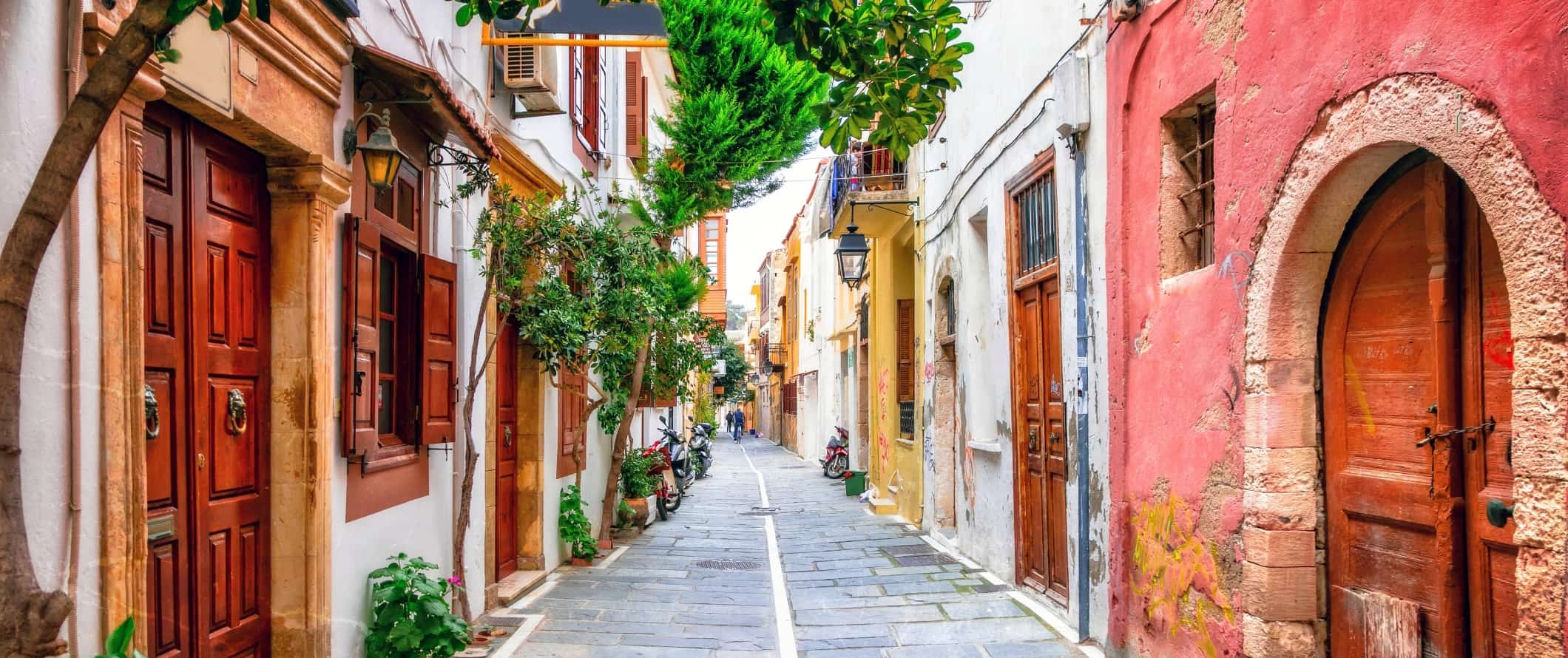
For those traveling with a tent, basic plots without electricity for one person start at 13.50 EUR per night in the summer and 11 EUR per night off-season.
Budget hotel prices – Budget two-star hotels start at 25 EUR in any of the main cities during the summer. In the off-season, prices start around 20 EUR per night. Expect basic amenities like free Wi-Fi and free breakfast.
Airbnb is available everywhere in Crete. For a private room, expect to pay at least 40 EUR, while an entire home/apartment averages closer to 150 EUR per night (you can find them for half that if you book early though).
Food – Traditional Greek cuisine is very healthy with a lot of fresh vegetables, olive oil, lamb, fish, pork, cheeses (especially feta), and yogurts. Filo pastries stuffed with meat or spinach and cheese are a local favorite as are souvlaki and gyros.
Crete also has its own unique dishes, such as snails in cracked wheat ( kohli bourbouristi ), slow-cooked pork with potatoes ( psitos ), Cretan dakos (Crete’s version of the Greek salad), and horta (wild greens).
Street food like gyros or souvlaki costs about 4.50 EUR each, or less. A hearty Greek salad also costs about 4.50 EUR, while a warm cheese pie (called kalitsounia ) is about 2 EUR. A combo meal at McDonald’s costs about 11 EUR.
If you stick mostly to traditional Greek dishes, you can eat very well on a budget in Crete. A plate of pork souvlaki is around 9 EUR while calamari is about 7.50 EUR. A hearty dish of moussaka starts at 7 EUR, while a platter of grilled chicken or beef costs between 8-11 EUR. A beer to go with it costs from 3.50 EUR.
At a higher-end restaurant, you can get an appetizer and a seafood or steak entree for about 25 EUR. Pasta dishes are about 16 EUR, while a vegetarian main starts from about 12 EUR. A glass of local wine is another 4.50 EUR.
If you’re cooking your own meals, expect to spend around 45-50 EUR on groceries per week. This gets you basic staples like pasta, veggies, eggs, cheese, and some meat.
Backpacking Crete Suggested Budgets
If you’re backpacking Crete, expect to spend about 55 EUR per day. This budget covers staying in a dorm, cooking some meals and eating some cheap fast food, limiting your drinking, taking public transportation to get around, and mostly sticking to free activities like hanging out on the beach and hiking.
On a mid-range budget of 115 EUR per day, you can stay in a budget hotel, eat out for all your meals, take the occasional taxi, drink more, and do some paid activities like visiting the Archeological Museum and Knossos.
On a “luxury” budget of 205 EUR or more per day, you can stay in a hotel, eat out anywhere you want, enjoy some drinks, get a scooter rental, take more taxis, and do all the tours and activities you want. This is just the ground floor for luxury though. The sky is the limit!
You can use the chart below to get some idea of how much you need to budget daily, depending on your travel style. Keep in mind these are daily averages – some days you spend more, some days you spend less (you might spend less every day). We just want to give you a general idea of how to make your budget. Prices are in EUR.
Crete Travel Guide: Money-Saving Tips
Crete, like the rest of Greece, is very budget-friendly. But if you’re looking to cut down your expenses even more, here are some of my favorite ways to save money in Crete:
- Use the Greek salad/bread rule – If the bread cover is .50 EUR or a Greek salad is less than 7 EUR, the restaurant is cheap. If the cover is around 1 EUR and a salad is 7-8.50 EUR, the prices are average. Anything more than that and the place is expensive. Use this rule to figure out how to eat at cheap restaurants.
- Travel in the off-season – Crete is one of the rare Greek islands that has a sizeable year-round tourist population, so hotels and attractions are almost always open (unlike places like Santorini and Mykonos). If you come during the shoulder season or off-season, you can find lower accommodation rates and tour prices while still getting the best of what the Greek islands have to offer.
- Stay with a local – If you plan ahead, you can usually find a Couchsurfing host that can host you for your stay. This way, you not only have a free place to stay but you’ll get access to a local that can share their insider tips and information. Just be sure to send your requests early as there are not a lot of hosts here.
- Go to museums on their free admission days – Most museums have some days when admission is free. Check the Odysseus Culture website for details as they vary from museum to museum.
- Bring a water bottle – The tap water here is safe to drink so bring a reusable water bottle to save money and reduce your plastic use. LifeStraw is my go-to brand as their bottles have built-in filters to ensure your water is always clean and safe.
- Eat super cheap – Gyros (and other street snacks) usually only cost a few euros. They are quick and easy and can keep you full for less than 10 EUR per day!
Where to Stay in Crete
Crete’s a big island and you’ll likely book a few different places if you’re planning on exploring the full extent of the island. These are my recommended places to stay while you’re here:
- Youth Hostel Plakias
- Rethymno Youth Hostel
- Cocoon City
- Intra Muros
How to Get Around Crete
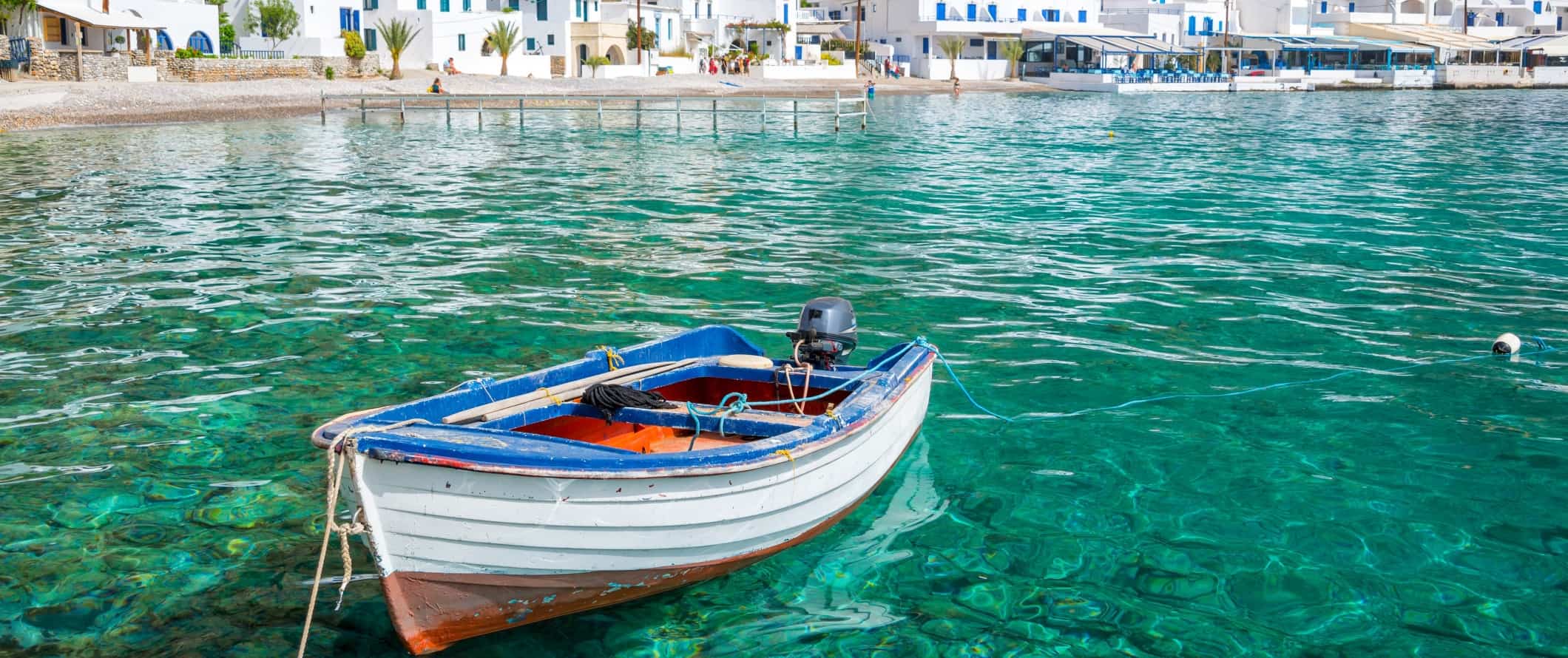
Most buses cost between 4-10 EUR per trip. For example, a 90-minute trip from Heraklion to Rethymnon costs around 6 EUR, while a three-hour trip from Heraklion to Chania is about 10 EUR.
Boat Scooter Rental – If you want more flexibility in getting around, a scooter rental is the way to go. They cost as little as 14 EUR per day. There are lots of rental companies, but I recommend Greenways.
Bicycle – Daily rentals start from about 20 EUR per day for a mountain bike or road bike but decrease the longer you rent them for. Joyride is an excellent company to rent from, though since scooter rentals are cheaper you might as well get one of them instead!
Taxi – Taxis in Crete charge about 1.20 EUR per kilometer and have a 1.80 EUR starting charge. There is usually a surcharge to and from the airport. In short, skip the taxis if you can as they add up!
Car rental – Car rentals can be found for as little as 25 EUR per day for a multi-day rental when booked in advance. Drivers must be at least 21 years old and have had their license for at least one year. An International Driving Permit (IDP) is required. For the best rental car deals, use Discover Cars
When to Go to Crete
Crete has lovely weather year-round, with temperatures rarely dropping below 12°C (61°F) in the coldest months and averaging 26°C (79°F) daily during the summer.
May to the end of September are the busiest tourist months, so if you want to avoid the crowds and inflated prices, come during the shoulder seasons (spring and autumn). October is a particularly nice time to visit, as the average daily temperature is still pleasant 21°C (69°F), and the crowds are virtually gone.
That said, it’s a big island so there are always places here during peak season without crowds if you don’t mind getting off the beaten path.
Unlike other Greek islands, Crete has a large year-round population. While some businesses are seasonal, you won’t have any problem finding a place to stay, and most museums and attractions are open all year.
How to Stay Safe on Crete
Crete is a very safe place to travel. Violent crime is rare and petty crime (like pick-pocketing) is your only real concern (and even that is uncommon). Keep your valuables close at tourist attractions and while on the beach and you should be fine.
If you’re driving, be extra cautious on Crete’s winding roads. Locals drivers can be erratic. Moreover, some of the roads are under-developed and there’s no real signage. Drive cautiously.
Solo female travelers should generally feel safe here, however, the standard precautions apply (never leave your drink unattended at the bar, don’t walk home alone intoxicated, etc.)
If you’re going hiking, bring lots of water and always wear sunscreen and bring a hat too. It can get sweltering in the summer!
Scams here are rare, but if you’re worried about getting ripped off you can read about common travel scams to avoid here .
If you experience an emergency dial 112 for assistance.
Always trust your gut instinct. Make copies of your personal documents, including your passport and ID. Forward your itinerary along to loved ones so they’ll know where you are.
The most important piece of advice I can offer is to purchase good travel insurance. Travel insurance protects you against illness, injury, theft, and cancellations. It’s comprehensive protection in case anything goes wrong. I never go on a trip without it as I’ve had to use it many times in the past.
Crete Travel Guide: The Best Booking Resources
These are my favorite companies to use when I travel. They consistently have the best deals, offer world-class customer service and great value, and overall, are better than their competitors. They are the companies I use the most and are always the starting point in my search for travel deals.
- Skyscanner – Skyscanner is my favorite flight search engine. They search small websites and budget airlines that larger search sites tend to miss. They are hands down the number one place to start.
- Hostelworld – This is the best hostel accommodation site out there with the largest inventory, best search interface, and widest availability.
- Booking.com – The best all around booking site that constantly provides the cheapest and lowest rates. They have the widest selection of budget accommodation. In all my tests, they’ve always had the cheapest rates out of all the booking websites.
- HostelPass – This new card gives you up to 20% off hostels throughout Europe. It’s a great way to save money. They’re constantly adding new hostels too. I’ve always wanted something like this and glad it finallt exists.
- Get Your Guide – Get Your Guide is a huge online marketplace for tours and excursions. They have tons of tour options available in cities all around the world, including everything from cooking classes, walking tours, street art lessons, and more!
- The Man in Seat 61 – This website is the ultimate guide to train travel anywhere in the world. They have the most comprehensive information on routes, times, prices, and train conditions. If you are planning a long train journey or some epic train trip, consult this site.
- Rome2Rio – This website allows you to see how to get from point A to point B the best and cheapest way possible. It will give you all the bus, train, plane, or boat routes that can get you there as well as how much they cost.
- FlixBus – Flixbus has routes between 20 European countries with prices starting as low 5 EUR! Their buses include WiFi, electrical outlets, a free checked bag.
- SafetyWing – Safety Wing offers convenient and affordable plans tailored to digital nomads and long-term travelers. They have cheap monthly plans, great customer service, and an easy-to-use claims process that makes it perfect for those on the road.
- LifeStraw – My go-to company for reusable water bottles with built-in filters so you can ensure your drinking water is always clean and safe.
- Unbound Merino – They make lightweight, durable, easy-to-clean travel clothing.
- Top Travel Credit Cards – Points are the best way to cut down travel expenses. Here’s my favorite point earning credit cards so you can get free travel!
- Ferry Hopper – If you’re looking to book your ferries, this website is an easy way to search the various companies, piece together routes, and book your tickets.
Crete Travel Guide: Related Articles
Want more info? Check out all the articles I’ve written on backpacking/traveling Greece and continue planning your trip:
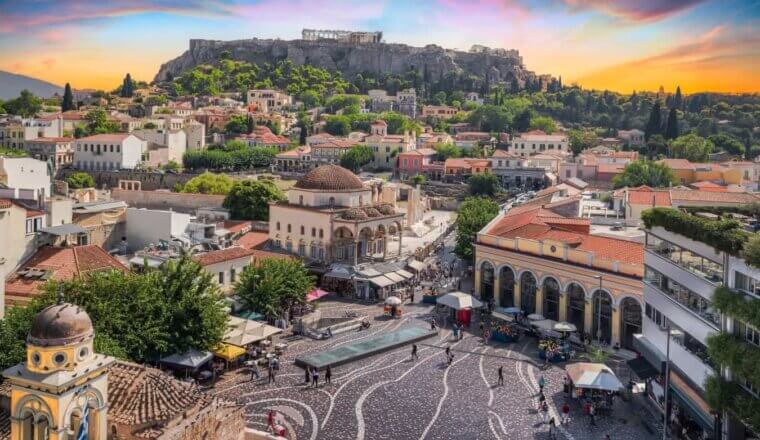
The 6 Best Hotels in Athens
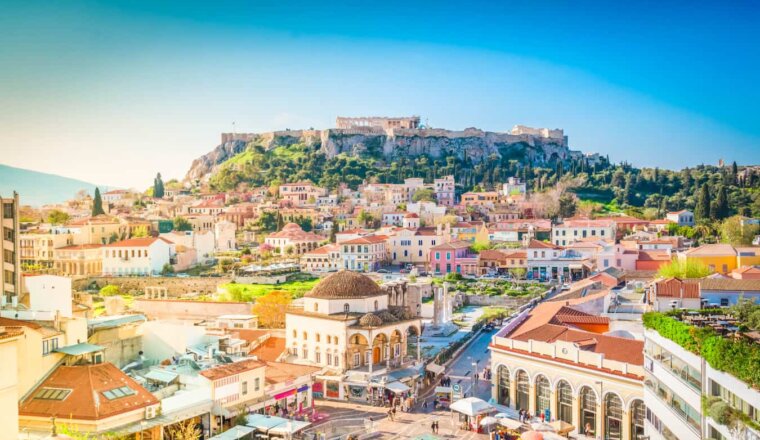
The 6 Best Hostels in Athens
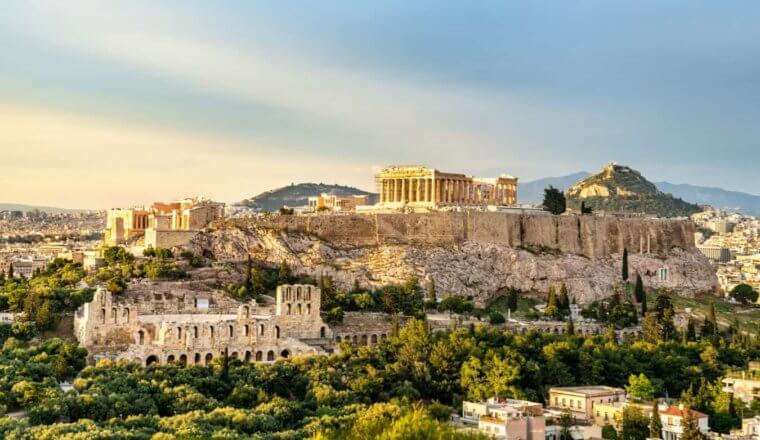
Where to Stay in Athens: The Best Neighborhoods for Your Visit
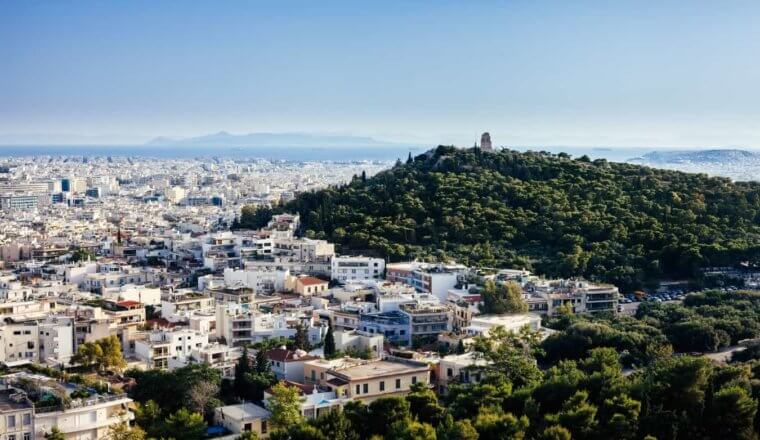
The Best Walking Tours in Athens
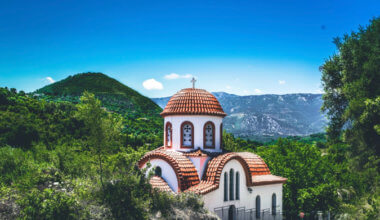
Traveling Greece: How Much Does It Cost?
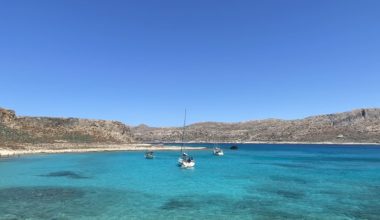
Fulfilling Childhood Dreams in Crete
Get my best stuff sent straight to you, pin it on pinterest.
- Where To Stay
- Transportation
- Booking Resources
- Related Blogs

14 Top-Rated Attractions & Places to Visit on Crete
Written by Lana Law Updated Mar 1, 2023
Rimmed by more than 1,000 kilometers of coastline, and with stunning beaches backed by mountains that rise more than 2,400 meters, Crete is unlike any other island in Greece. It is the largest of the Greek islands and the fifth biggest island in the Mediterranean.
The main attractions on Crete are the incredible golden-sand beaches and turquoise waters of the Mediterranean, but the island is also home to important Minoan archaeological sites , dramatic gorges, lovely cities with Venetian harbors and fortresses, and small coastal towns where you can escape to a leisurely pace of life.
On the north coast are the centuries-old harbor towns and cities of Chania, Rethymnon, Heraklion, and Agios Nikoloas, the most popular tourist destinations on the island. The best places to visit on Crete for shopping, nightlife, museums, and cultural attractions are all found along the north coast.
On the remote south coast, looking towards Africa across the Libyan Sea, are quaint seaside villages where you can escape from the main tourist scene. This is the best place for travelers looking for a quiet escape but still wanting to enjoy a beach vacation.
The scenic, mountainous interior is home to fertile soil and is where you'll find much of the country's agriculture, along with charming villages of whitewashed houses on narrow, twisting streets. Good roads and highways connect cities on the north coast with the towns on the south coast, and make for beautiful drives through the mountains.
Learn more about where to go and what to see with our list of the best places to visit on Crete.
1. The Beaches of Crete
2. the palace of knossos, 3. agios nikolaos, 5. samaria gorge, 6. heraklion, 7. rethymnon, 8. heraklion archaeological museum, 9. preveli monastery, 10. preveli beach, 11. plakias, 12. matala beach, 13. frangokastello, 14. diktaion (psychro) cave, crete - climate chart.
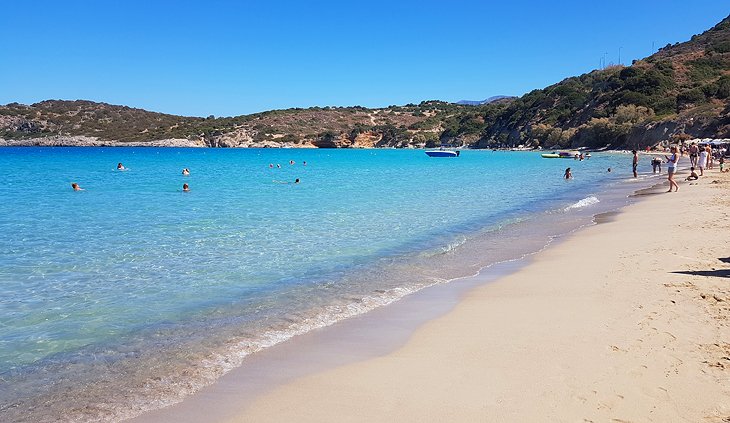
For most visitors coming to Crete between spring and fall, one of the top things to do is lounging on the island's beautiful beaches. Not all beaches here are created equal. Some of Crete's beaches are pebble, but some are among the most beautiful soft-sand beaches in the world, with crystal-clear water that glows a turquoise color under the Mediterranean sun.
The most famous beaches are Elafonissi, known for its white and pink sand , and Balos , or the Balos Lagoon as it's also frequently called. Both of these are within striking distance of Chania. And while these are must-see places, these are really just the tip of the iceberg when it comes to outstanding beaches on Crete.
For dramatic scenery, head to the remote south coast. Here, you'll find Matala, a lovely small town with a fantastic stretch of beach, lined at one end by caves. Preveli beach , set at the end of a gorge and backed by huge cliffs, yet still accessibly via a short hike, is another top attraction on this side of the island.
On the north coast, you may also want to set your sights on beaches around Agios Nikolaos, on picturesque Mirabello Bay. One of the top choices here is Voulisma beach , but if you have time to explore a little further afield, Vai Beach, also known as Palm Beach , is one of the top beaches on Crete.
- Read More: Best Beaches on Crete
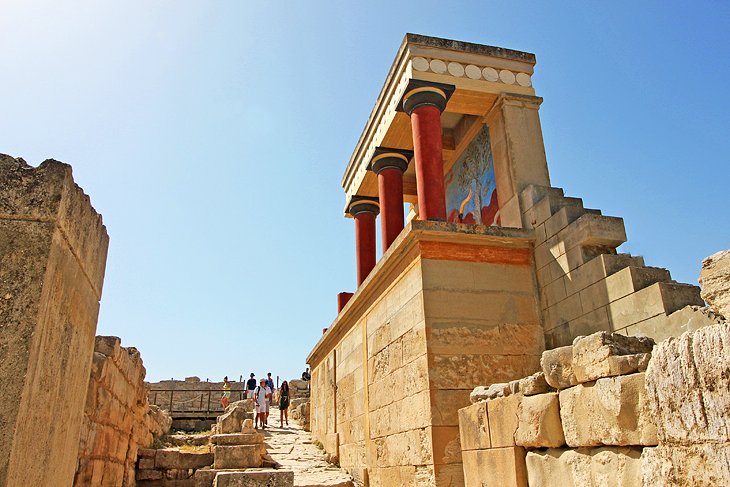
Knossos is the most important archeological site on Crete. A pre-Greek Bronze Age culture and the first maritime power in the Mediterranean, the Minoans were named after the legendary King Minos. Knossos, near the city of Heraklion , is believed to have been the palace of King Minos .
The Minoan palace is a monumental residential complex that centers on a vast courtyard, where it seems they staged "Bull-Leaping," an activity that involved running towards a bull, grabbing it by the horns, and somersaulting over it.
Knossos was abandoned around 1450 BC. Archaeologists are not sure why-it may have been a catastrophic earthquake following the volcanic explosion on Santorini, or perhaps Crete was ravaged by invaders. Whatever the cause, the Minoans completely disappeared.
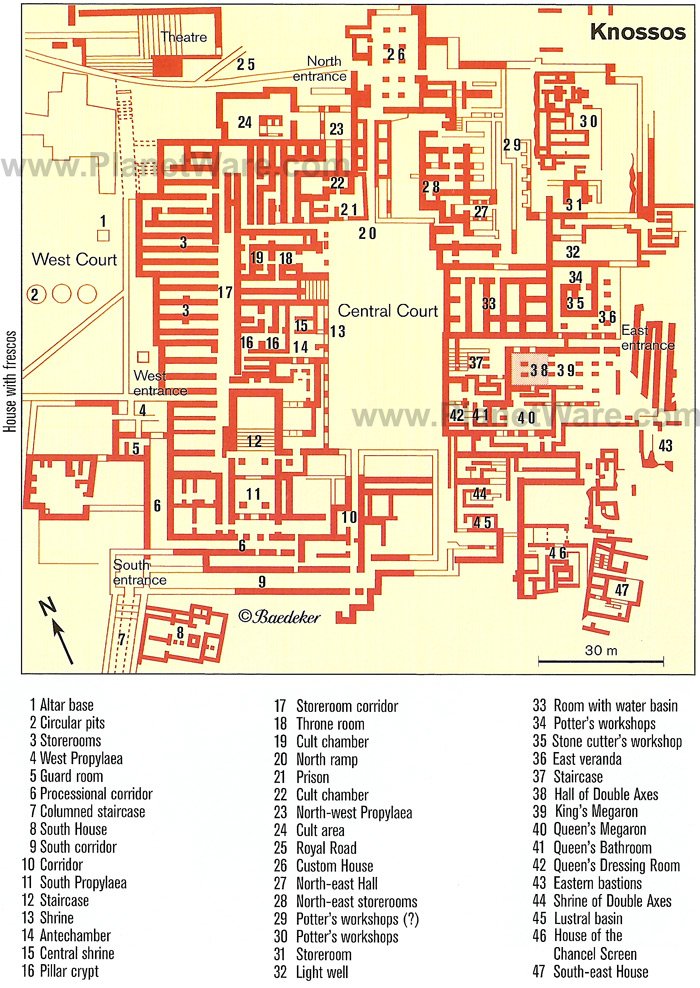
Rimmed by beautiful beaches and looking across scenic Mirabello Bay, Agios Nikolaos is a charming small city on the north coast of eastern Crete, about 65 kilometers east of Heraklion. Although it is definitely a tourist town, it feels much less touristy than places like Chania.
Highlights of a visit here include a stroll along Lake Voulismeni , with its many waterfront cafés and restaurants, and the nearby port area, looking out to sea. A walk around the point from the port to Kitroplatia beach takes you past two famous statues and provides stunning views out across Mirabello Bay to the towering mountains of eastern Crete.
Near Agios Nikolaos, you can also visit the Diktean Cave , with its stalactites and stalagmites, or venture into the mountains to the hillside village of Kritsa , where local artisans sell traditional crafts such as leather goods, ceramics, and hand-woven rugs. On the way to Kritsa, stop by the little 13th-century church of Panagia Kera (Our Lady of Kera) to admire the superb Byzantine frescoes.
Not far from Agios Nikolaos are the posh beach hotels and villas of Elounda . You can drive out here to see Elounda and look across the bay to the see the ruins on the island of Spinalonga , which was also once used as a leper colony . Most people take a boat tour to the island, which leaves from the harbor in Agios Nikolaos.
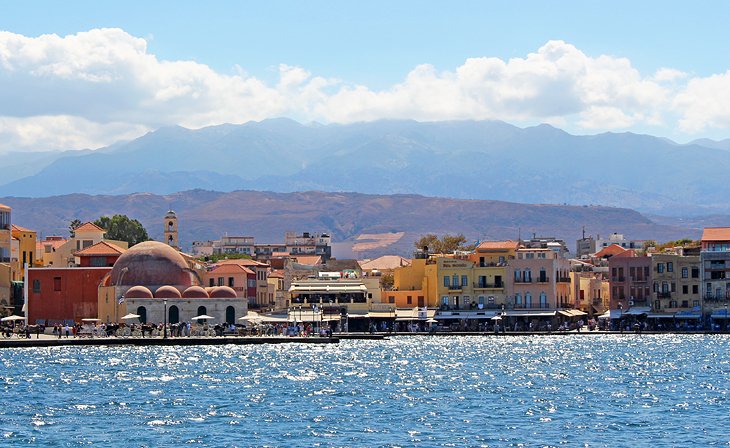
Chania is the main town in Western Crete , and was the capital of the island until 1971 when it moved to Heraklion. Overlooking the Aegean Sea and backed by the White Mountains, which are snow-capped in winter, the old town's appearance dates from the centuries spent under Venice (1204-1645). Chania is a lovely place to explore on foot.
A warren of romantic alleys with pastel-colored buildings enclosed within the remains of 16th-century defensive walls, the town extends to a pretty fishing harbor. The Municipal Market, built in 1911, is worth a look for its fresh seasonal produce and gifts such as Cretan cheese and honey.
Chania has an airport (12 kilometers northeast of town on Akrotíri peninsula ) and is served by regular ferries from Athens' port, Piraeus. It makes a good base for visiting the beaches of Elafonissi and Balos , and hiking the Samaria Gorge .
- Read More: Top-Rated Tourist Attractions in Chania
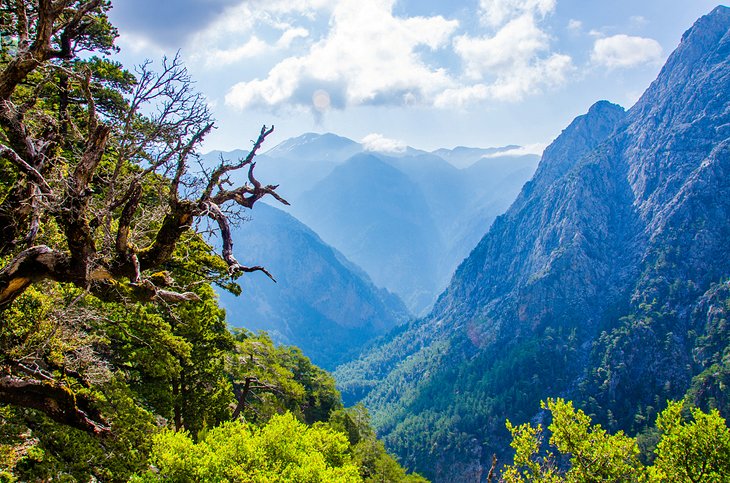
Crete is known for its outstanding gorges, but the most impressive is the Samaria Gorge. Contained within the Samaria National Park , it is a UNESCO Biosphere Reserve. Walking the popular 16-kilometer trail that runs through the gorge is one of the most popular things to do on Crete for tourists looking to get active.
From Xylóskalo , just outside the mountain village of Omalos, the gorge descends 1,250 meters to arrive at the Libyan Sea in Agia Roumeli on Crete's sunny south coast. The river Tarraios, which dries up in summer but floods in winter, runs the length of the gorge with high rocky cliffs to each side. The gorge is open to visitors from May through mid-October.
Although the hike is mostly downhill, with most of the elevation loss occuring in the first couple of kilometers, the stony path is a bit challenging and not recommended for people with knee problems. It's a must-do for hikers who don't mind a good day hike.
The walk can take four to six hours depending on how fit you are, but with transportation, plan on a 12-hour day at a minimum from the time you leave your hotel in Chania to the time you return. This is a one-way hike, with a ferry and bus shuttling visitors back to town.
Most people do the hike as part of an organized hiking day trip from Chania, which takes care of all your transport. You can also do the Samaria Gorge hike from Heraklion, but this makes for a very long day.
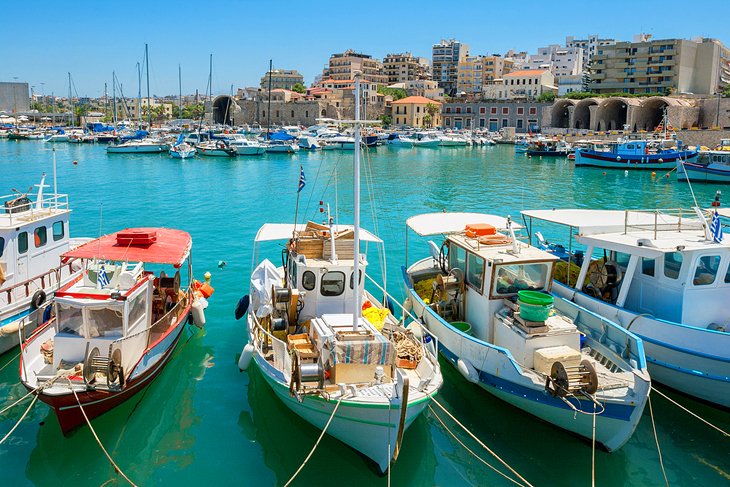
Heraklion is the island's capital and a pleasant surprise for first-time visitors. The Old Town is a maze of lovely pedestrian streets lined with shops and restaurants. Huge trees provide ample shade in the squares, where you can linger over a coffee for hours at an outdoor café.
Heraklion is also an obvious base for visiting Knossos and exploring central Crete. Like many of Crete's finest coastal towns, it gained its present layout under the Venetians, who ruled from 1204 to 1669, a period which saw a considerable cultural flowering on the island, producing artists such as El Greco, from Fódele, near Heraklion.
The noted 20th-century writer, Nikos Kazantzakis (author of Zorba the Greek, 1946) was also from Heraklion, and you can see his tomb within the old town walls.
Many tourists start their trip in Heraklion, which has an international airport (five kilometers east of town), and a ferry port with service to Athens' port, Piraeus, as well as several other Greek Islands. You can also visit Santorini on a day trip from Heraklion.
- Read More: Top-Rated Tourist Attractions in Heraklion
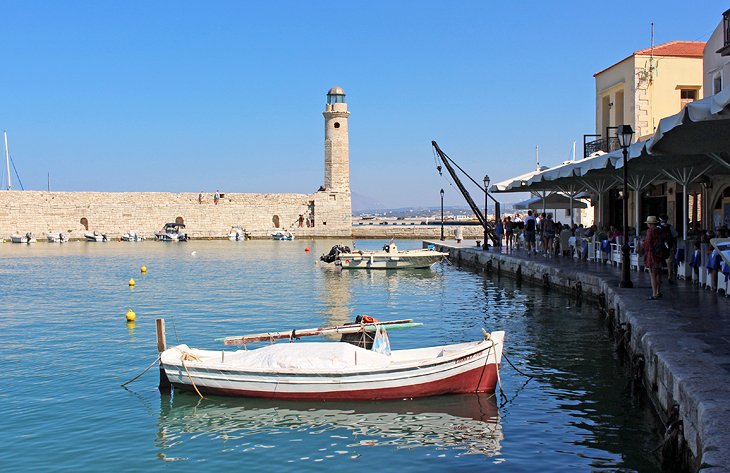
Midway between Chania and Heraklion, Rethymnon's lovely old town is made up largely of Venetian-era buildings , though there is some evidence of the year spent under Turkish rule (1669-1898) such as the towering minaret.
A perfect place to day trip from the resorts of the north coast, Rethymnon has everything you need to justify leaving the beach for a day.
Many historic buildings have been turned into small boutique hotels, shops, and restaurants. Wandering the shady, twisty streets and alleys in a quest to find the perfect photo followed by a long lunch on the ancient Venetian Harbour is a fine way to while away an afternoon.
The mountains behind Rethymnon are home to rural villages and some excellent agritourism centers. The area makes a good base for visiting nearby attractions such as the Samaria Gorge and Mount Psiloritis .
- Read More: Top-Rated Tourist Attractions & Things to Do in Rethymnon
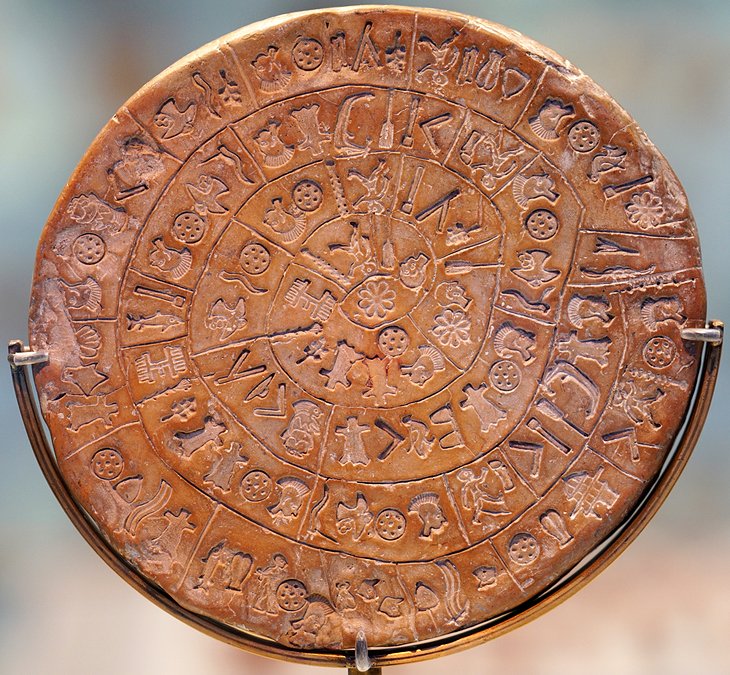
You'll be sure to get your fill of ancient Cretan history at the Heraklion Archaeological Museum. Artifacts spanning 550 years are displayed across 27 different halls. Things to keep an eye out for are beautiful 3,500-year-old frescoes from Knossos, and the glazed ceramic Snake Goddess dating from 1600 BC. Another item of note is the Phaistos Disc. Dating from 100 BC it is a clay disc bearing a curious spiral of symbols.
The pride of place goes to the Minoans, with their enchanting frescoes depicting proud and slender young men and women in vivid shades of terracotta-red, ochre yellow, and cobalt blue.
This world-class museum is Heraklion's principal tourist attraction and lies in the eastern part of the old town.
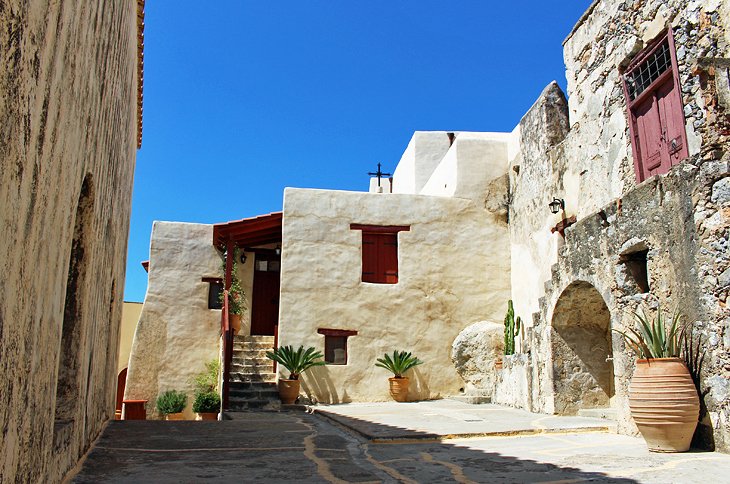
Set near the top of a mountain and offering extensive views over the Libyan Sea, the 17th-century Preveli Monastery makes a nice day trip from nearby towns and cities, like Rethymnon or Georgioupoli. Highlights include the courtyards and terraces, the mountain spring, and the small air-conditioned museum with a collection of religious artifacts. You'll also find a host of friendly cats here waiting to greet visitors.
A small fee is charged to enter the monastery, and modest dress is required. Skirts are provided for women if their clothing does not extend down past their knees.
The monastery is located just a short drive from the seaside village of Plakias , which makes a nice lunch stop. Not far from the monastery is Preveli Beach , another of Crete's popular tourist attractions. It's a bit of a walk down to the beach, but you can simply stop for a view over the beach and coast if you don't want to go right to the water's edge.
Official site: http://www.preveli.org/files/moni/enindex.htm
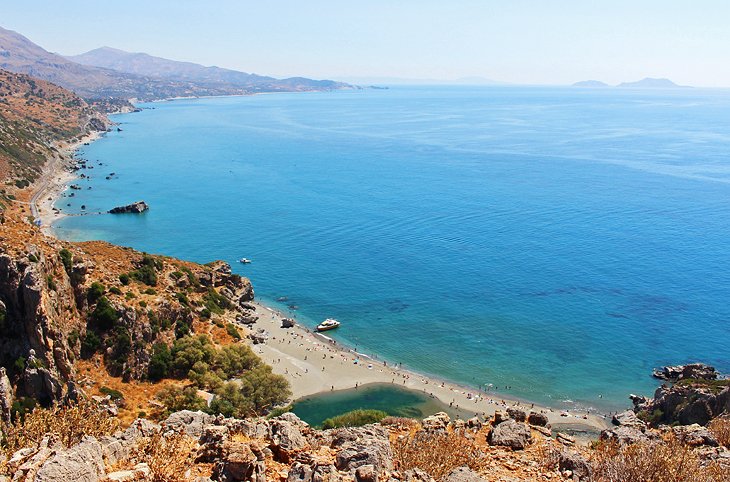
Preveli Beach is considered one of the most spectacular beaches on Crete. Located on the south coast, it is set at the mouth of a small river and hemmed in on both sides by towering cliffs, and looks out over the Libyan Sea.
Easily reached from the north coast across good roads, this beach makes for a great day trip. However, bear in mind that from the parking area, you will need to walk down 30 minutes along a rock pathway. This may not seem that difficult, however, coming back up in the blazing afternoon sun will definitely be more onerous, so bring good shoes and plan accordingly. You can also reach Preveli Beach by boat from nearby Plakias.
If you are out for a day of sightseeing, combine a trip here with a stop at nearby Preveli Monastery . Then, head over to Plakias for lunch and enjoy some traditional Greek food.
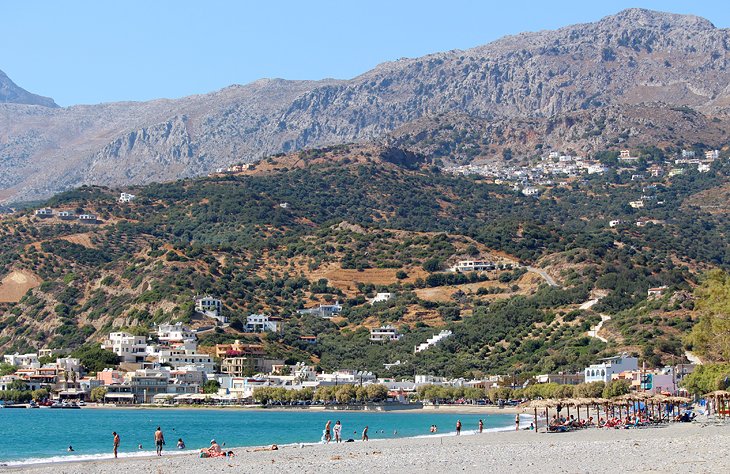
What once started as a humble fishing village has now changed into one of the most relaxed and enjoyable beach towns on the south coast. Unlike many of the northern beach areas, which are highly developed, Plakias retains a small-town feel and has some of the best dining in the surrounding area.
Here, you'll find a long crescent beach set in a very wide inlet. The beach close to the town center is a mix of pebbles and sand and is backed by tavernas and shops, but farther to the east, is quieter and has soft sand.
Plakias is a good place to base yourself for trips to Preveli Beach; Preveli Monastery; Souda Beach; and Rethymmon , which is 40 minutes away.
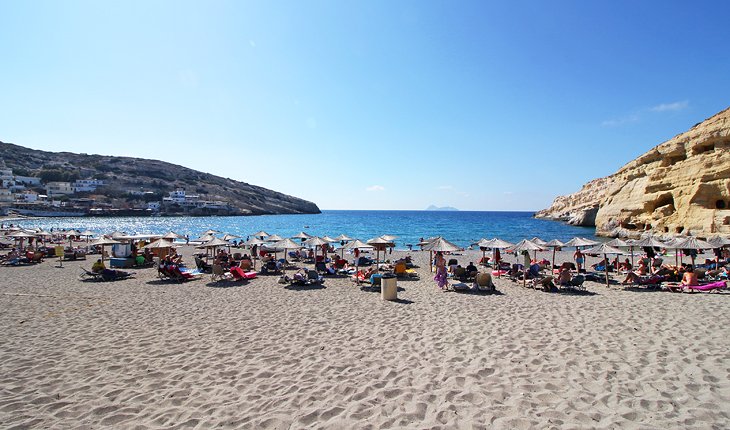
Matala Beach is one of the most interesting and most visited beaches on the south coast of Crete. The beach is a huge arc of sand with a rock wall on one side riddled with ancient caves that look down on impossibly blue waters.
Matala makes for a great day trip from destinations on the north coast, like Heraklion or Rethymnon. You can lounge in the sun, swim, explore the ancient caves, and have lunch at a seaside restaurant. Afterwards, do a bit of souvenir shopping at one of the shops along the pedestrian-only walkways behind the beach.
The caves were the haunt of hippies in the 1960s. Travelers of a certain age will recognize the name of the beach from the famous Joni Mitchell song called Carey.
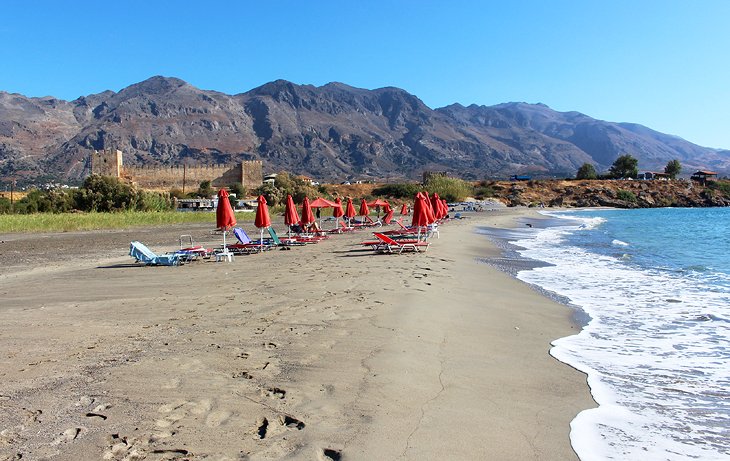
If you are searching for a friendly small town with not a whole lot going on, FrangoKastello may be just what you're looking for. This seaside town does not have tourist shops but does have good restaurants, an ancient fort, and some lovely beaches . It's one of Crete's true hidden gems.
Located on the south coast, about a 45-minute drive west of Plakias, Frangokastello is out of the way and off the usual tourist route. The drive here either takes you via Plakias, over a mountain pass with incredible views up and down the south coast, or down through the impressive Imbros Gorge and across the small plains, with the soaring mountains on one side and the sea on the other.
In Frangokastello, you can lie on the beach and gaze out at the blue waters of the Libyan Sea, or turn your chair towards the mountains behind and be staring at the town's imposing Venetian fortress. You can also walk a short distance from town and be on a completely undeveloped beach backed by sand dunes.
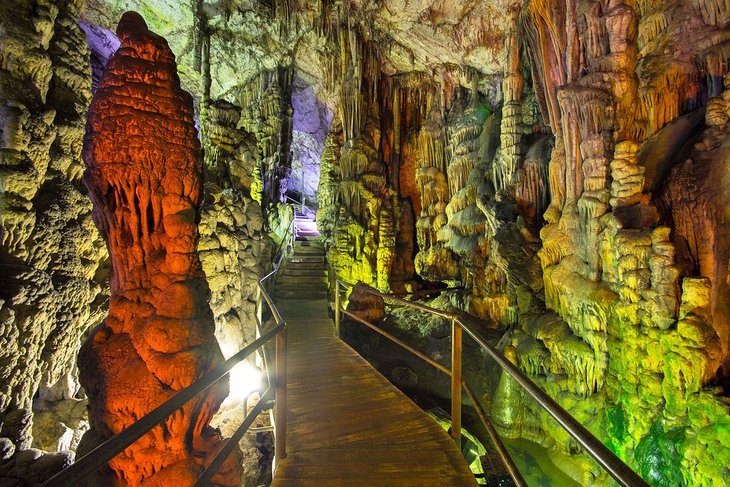
As you wander around Crete (and Greece for that matter), you'll no doubt come across tales of the ancient Gods, their duties, lives, and origins. Considered the most important Greek god, Zeus was the god of the sky, thunder, and the king of all other gods and men. It's in Diktaion Cave that this famous god was brought forth for all humanity.
Legends aside, the Diktaion Cave is considered one of the best of the 4,500 caves and sinkholes found throughout Crete . Its cool environs are a pleasant escape from the sun and heat of the Crete. You'll pass through five antechambers as you make your way down deep into the earth. At the bottom of the cave is a glass-calm lake surrounded by immense stalactites and stalagmites. Across the lake in a small chamber is the area where Zeus was apparently born.
Diktaion Cave is located up on the Lasithi plateau, an area quite unlike the rest of Crete. This high area is mostly flat and is the breadbasket of the island, with orchards and extensive farms. Stop in a small village and grab a lunch consisting of the fresh, local produce capped off with a cold beverage.
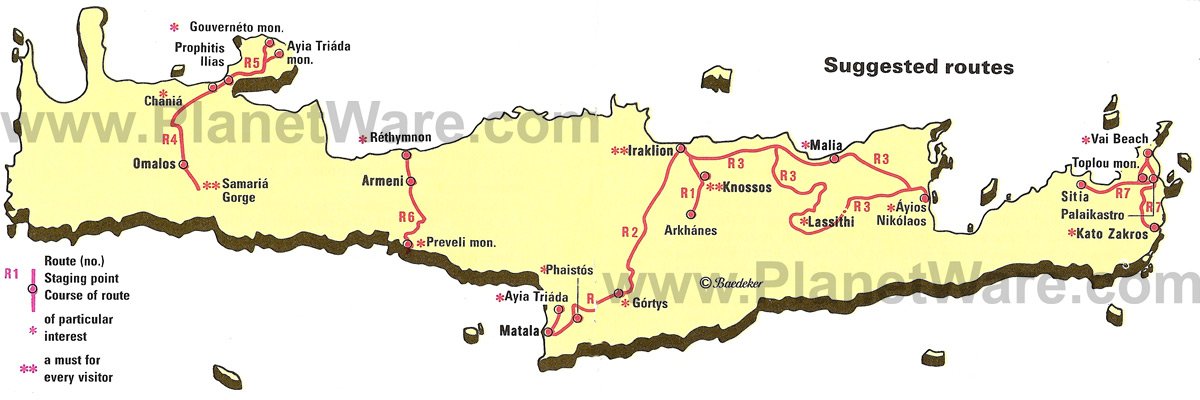
More on Greece
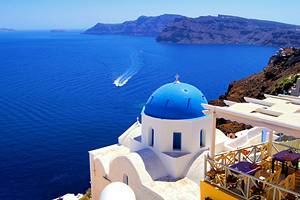
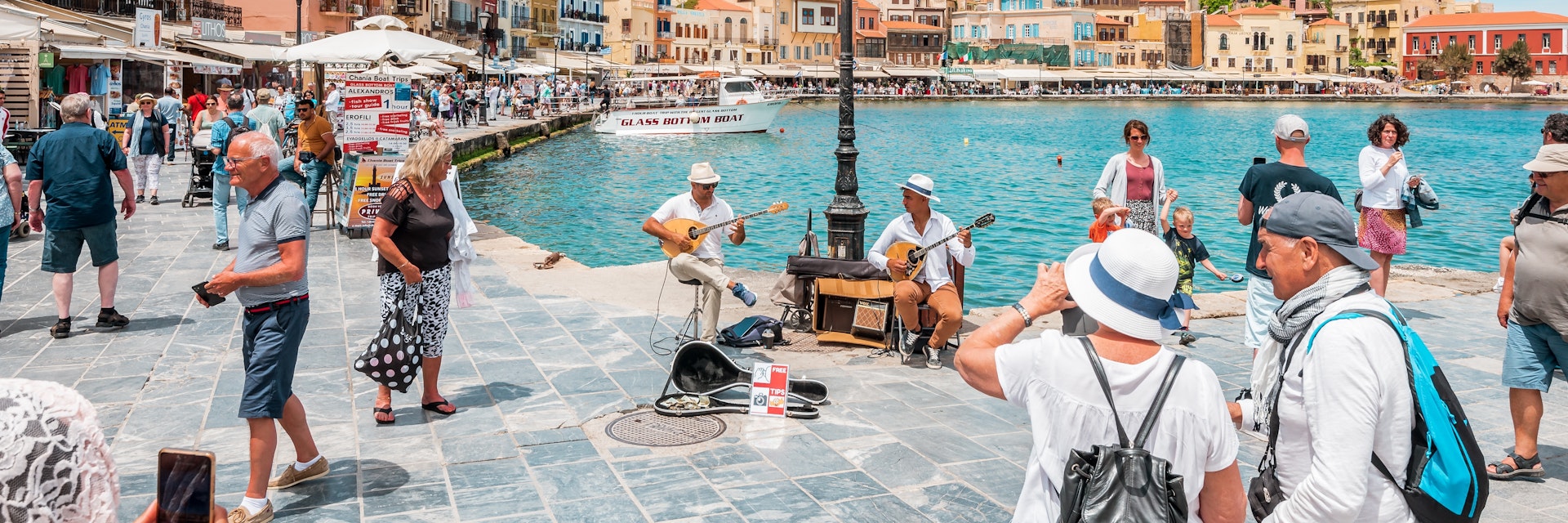
Crete is a tapestry of splendid beaches, ancient treasures and landscapes, weaving in vibrant cities and dreamy villages, where locals share their traditions, wonderful cuisine and generous spirit.
Best Time to Visit
Best places to visit, leave the planning to a local expert.
Experience the real Crete. Let a local expert handle the planning for you.
Attractions
Must-see attractions.
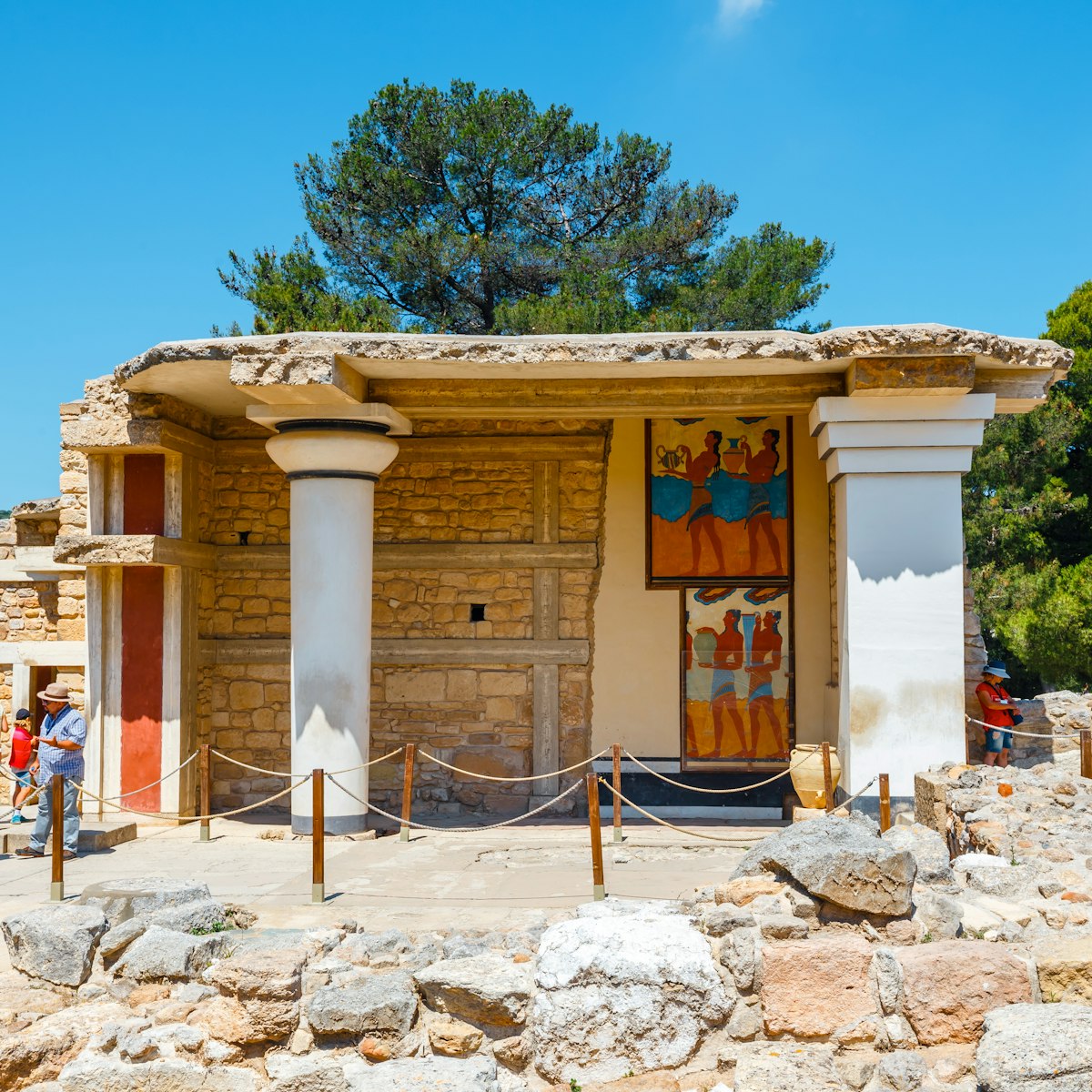
Palace of Knossos
Crete’s most famous historical attraction is the Palace of Knossos, the grand capital of Minoan Crete, located 5km south of the city of Iraklio. The…
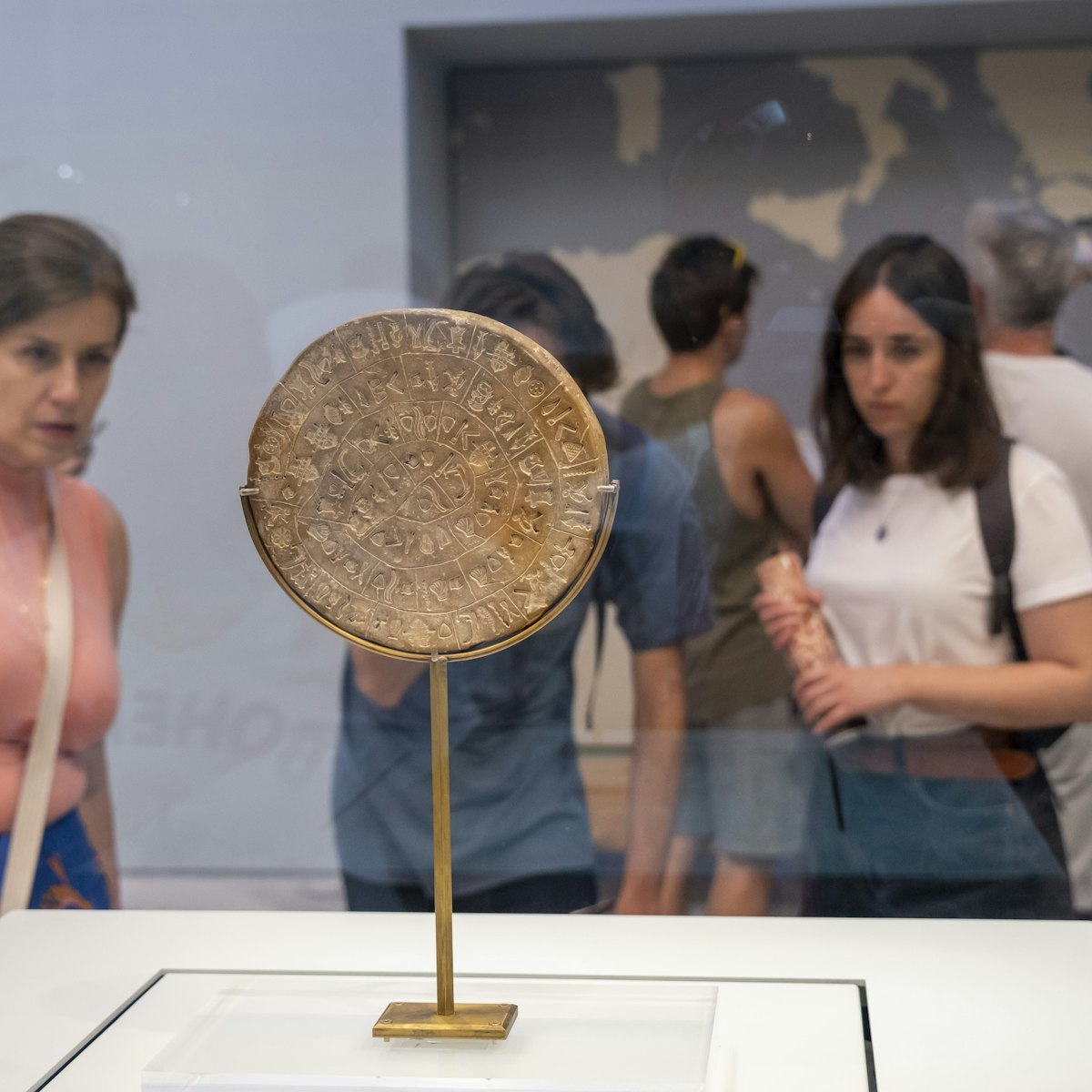
Heraklion Archaeological Museum
This state-of-the-art museum is one of the largest and most important in Greece. The two-storey revamped 1930s Bauhaus building makes a gleaming showcase…
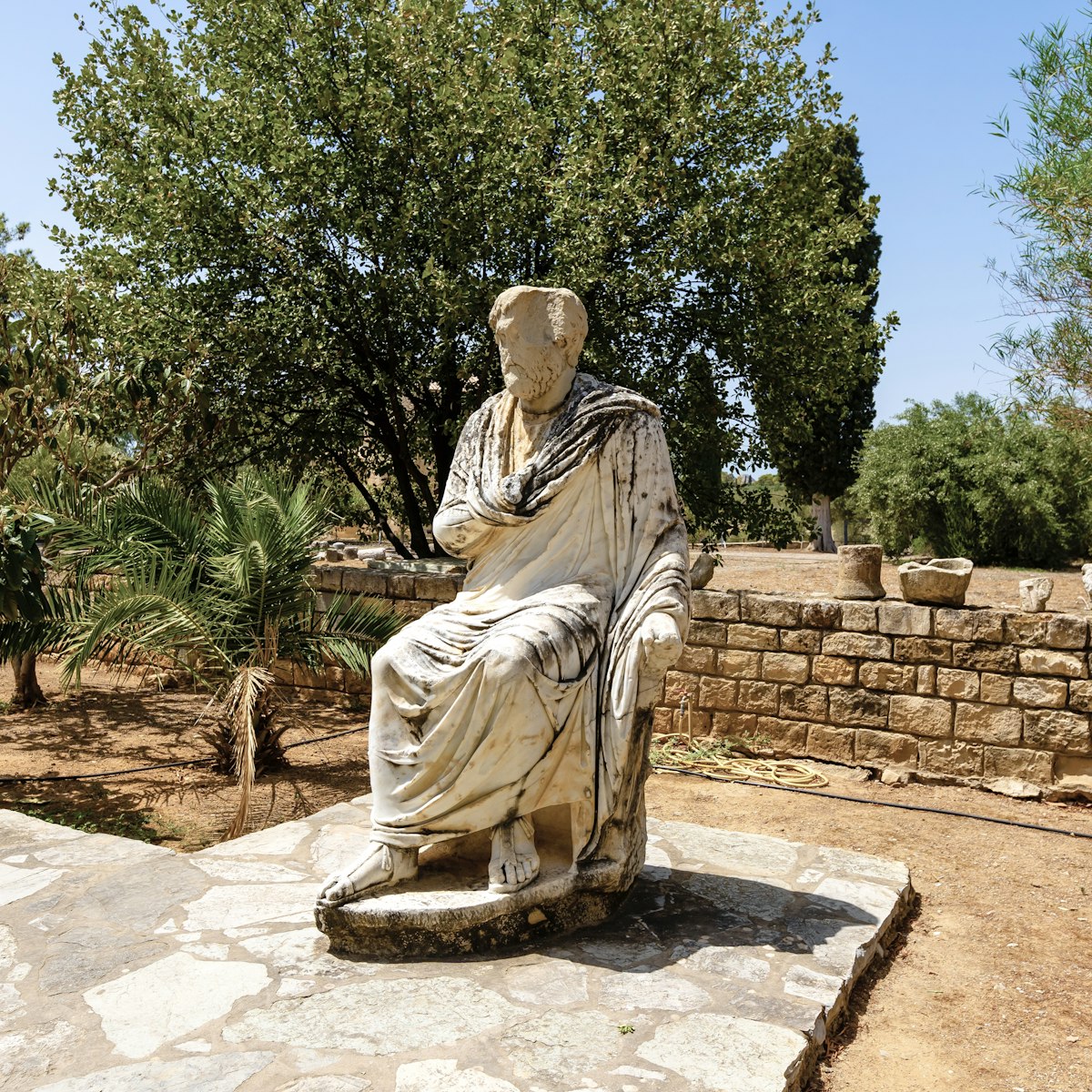
Iraklio Province
Gortyna (also Gortyn or Gortys) has been inhabited since Neolithic times but reached its pinnacle after becoming the capital of Roman Crete from around 67…
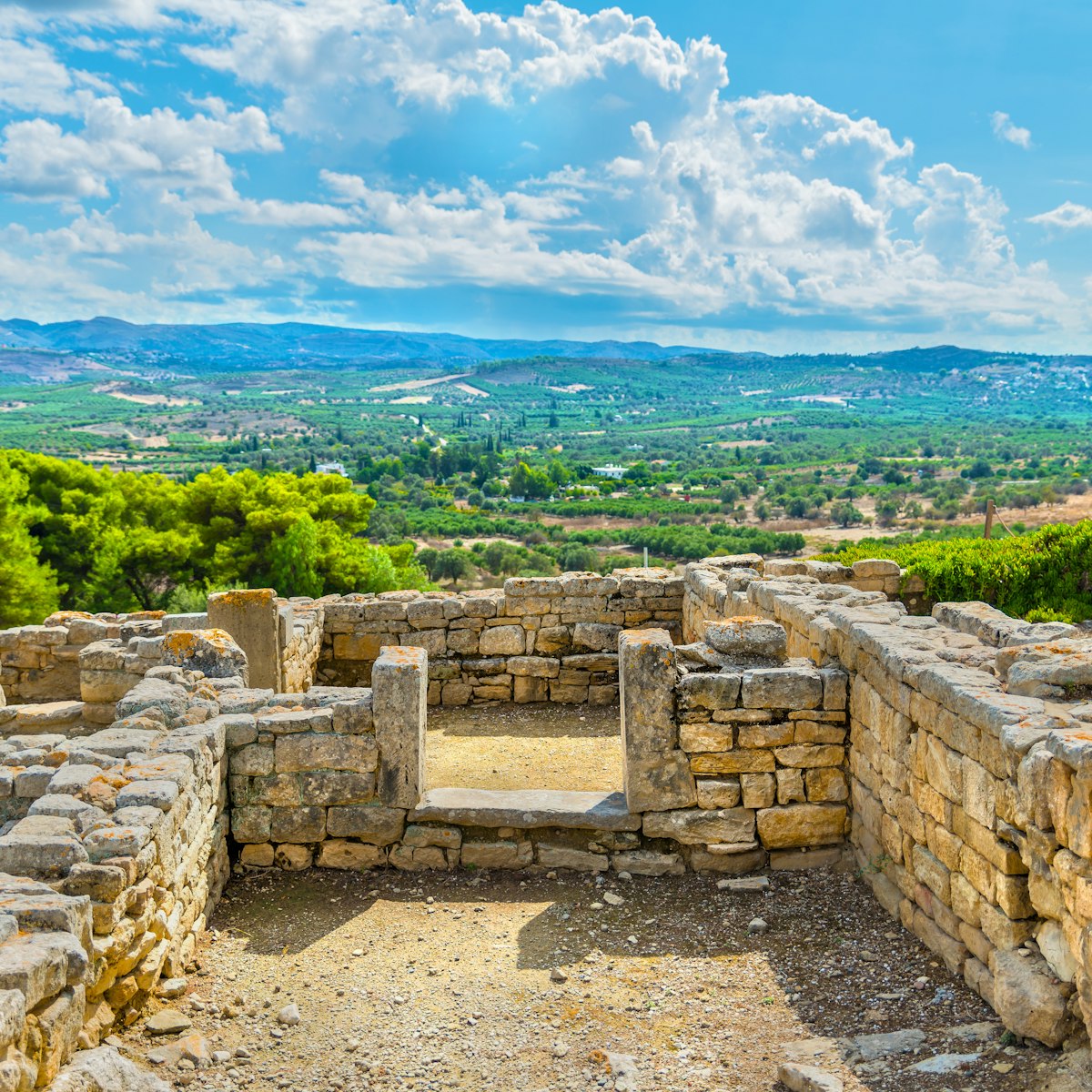
Phaestos was the second-most-important Minoan palace-city after Knossos and enjoys an awe-inspiring setting with panoramic views of the Messara Plain and…
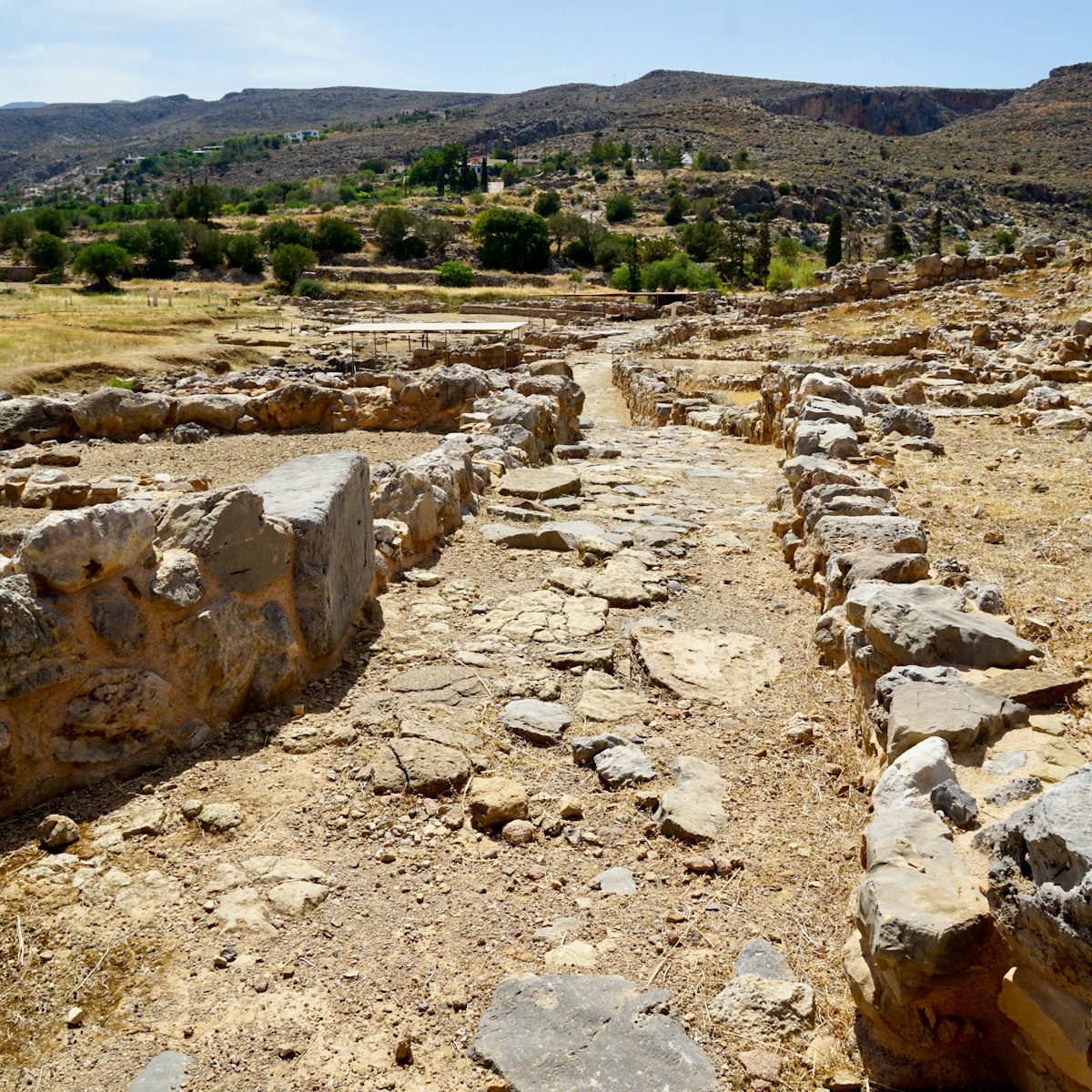
Zakros Palace
Lasithi Province
Ancient Zakros, the smallest of Crete’s four Minoan palatial complexes, sat next to a harbour and was likely engaged in sea trade with the Middle East, as…
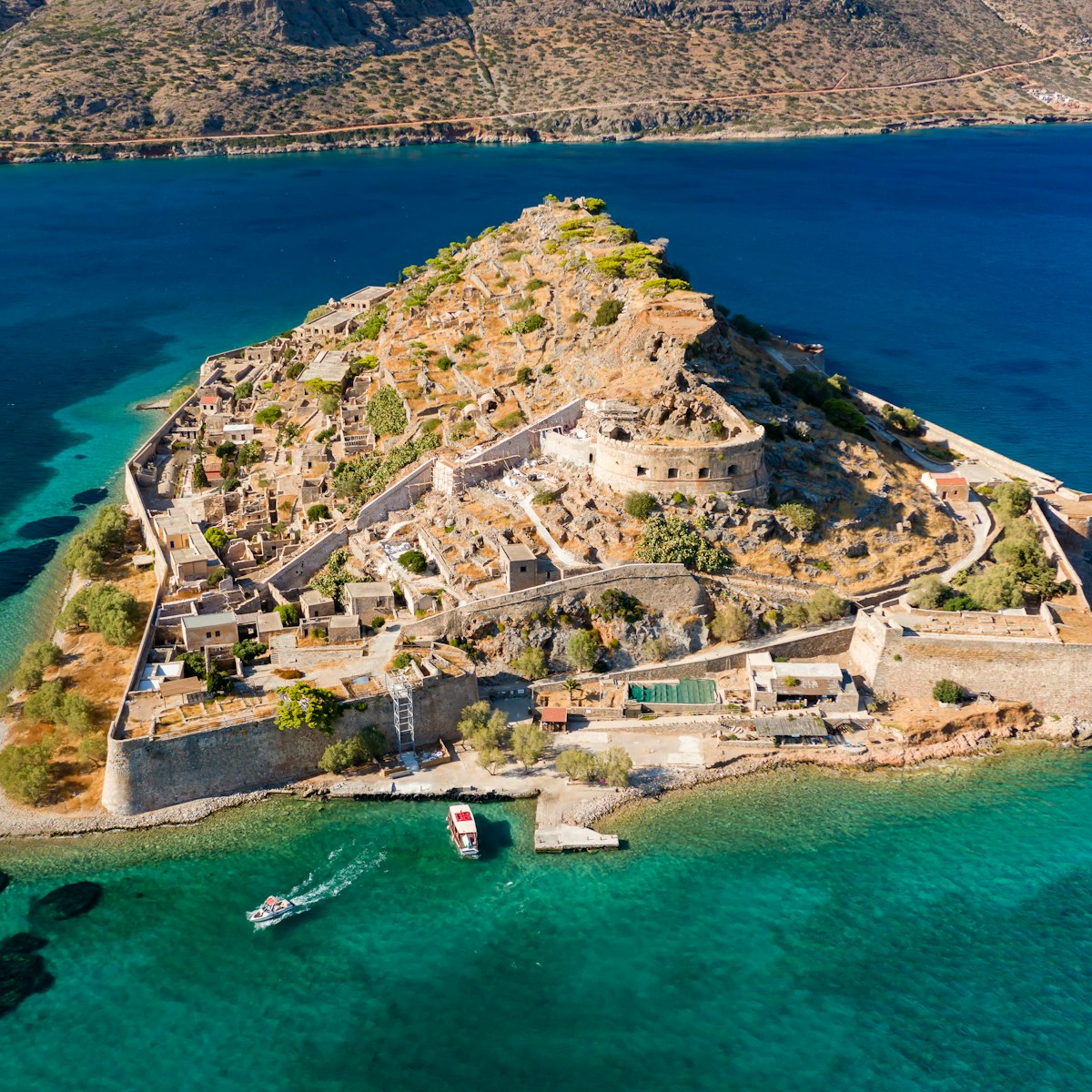
Spinalonga Island
Tiny Spinalonga Island became a leper colony in 1903 and catapulted into pop-cultural consciousness thanks to Victoria Hislop's 2005 bestselling novel The…
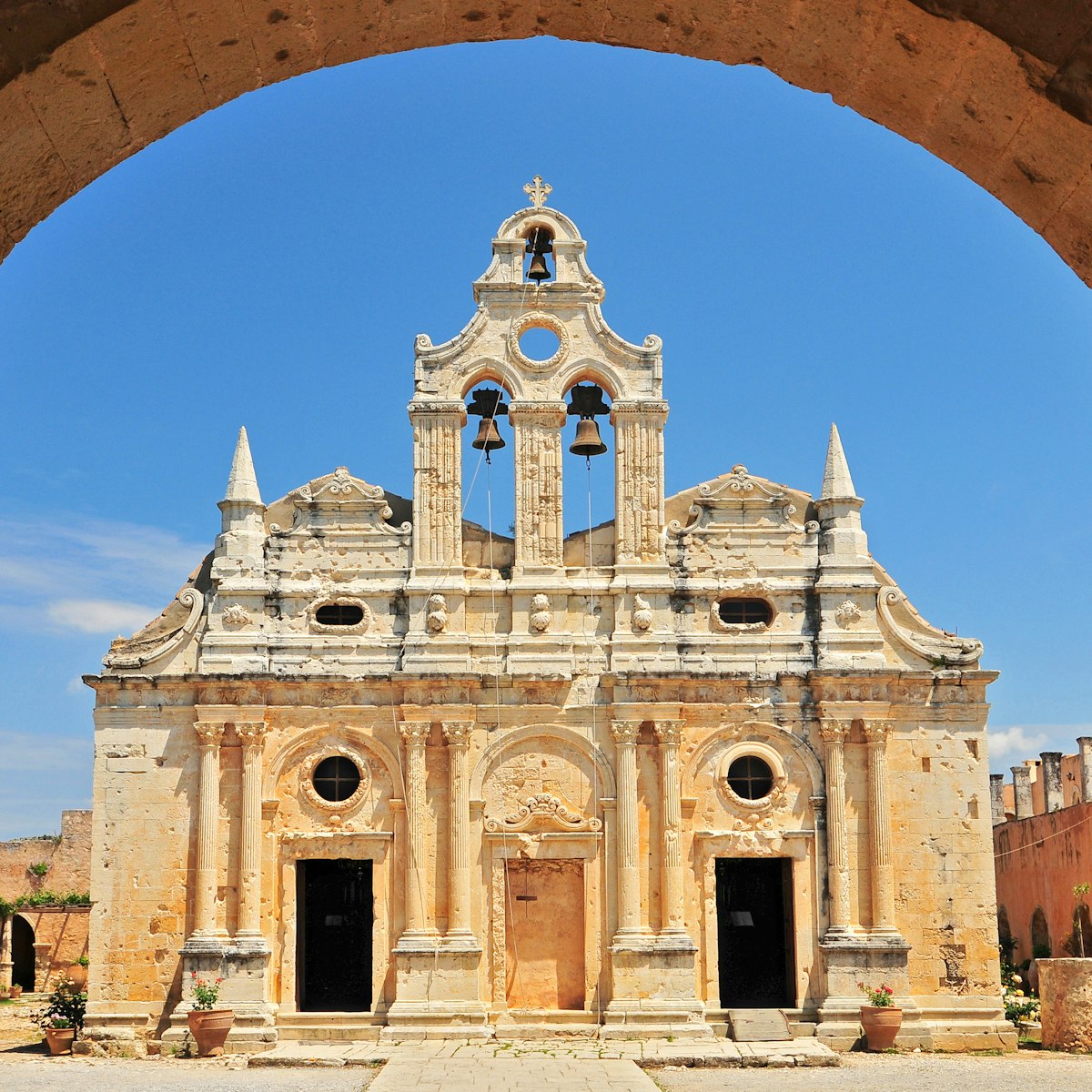
Moni Arkadiou
Rethymno Province
The 16th-century Arkadi Monastery, 23km southeast of Rethymno, has deep significance for Cretans. As the site where hundreds of cornered locals massacred…
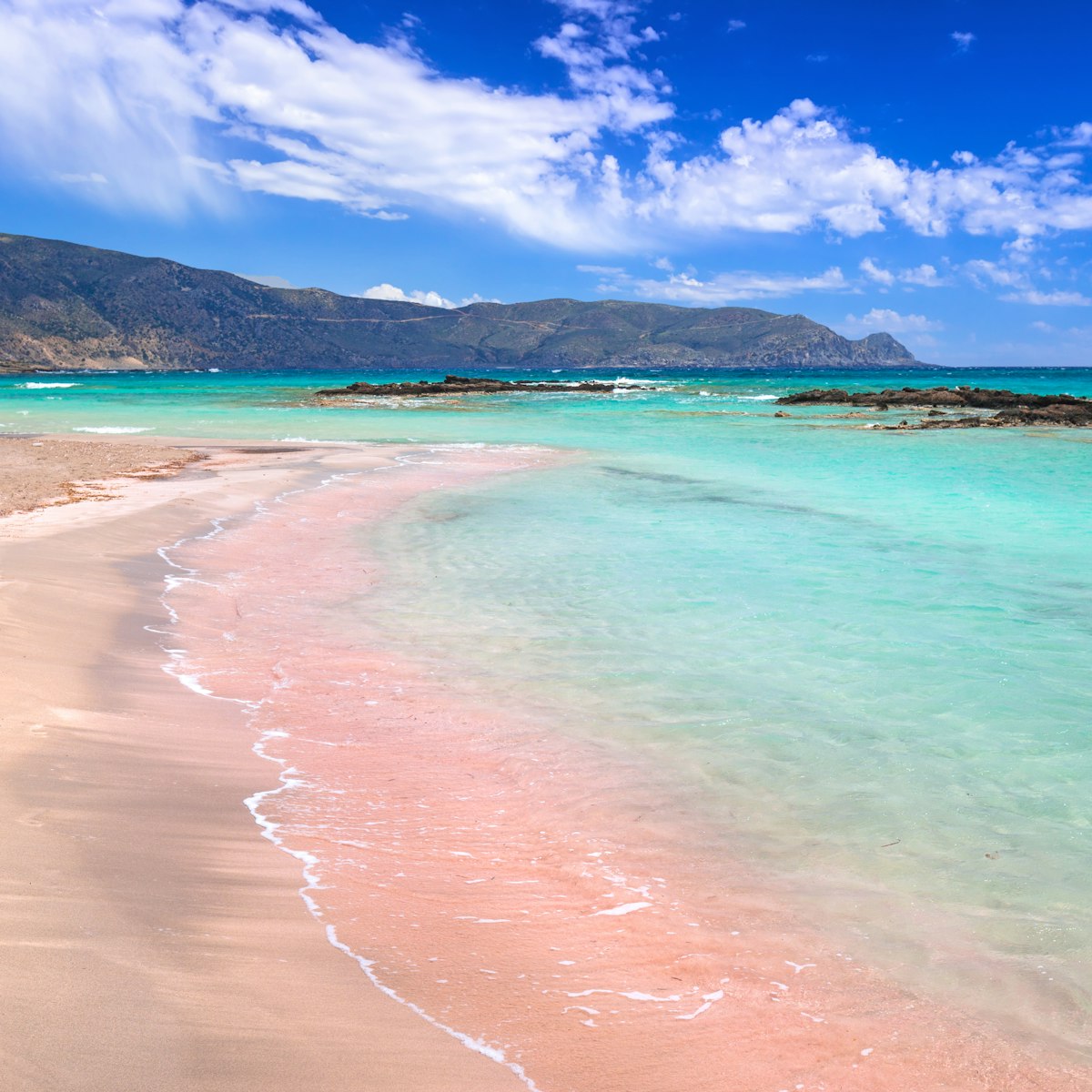
Hania Province
Tucked into Crete’s southwestern corner, this symphony of fine pink-white sand, turquoise water and gentle rose dunes looks like a magical dreamscape. As…
Top picks from our travel experts
15 of the best things to do in crete.

Agios Georgios
Built in 1856 atop a much older church possibly dating to the Venetian era, this handsome house of worship is dedicated to St George, the patron saint of…
The best free things to do in Crete: from beaches to historical landmarks
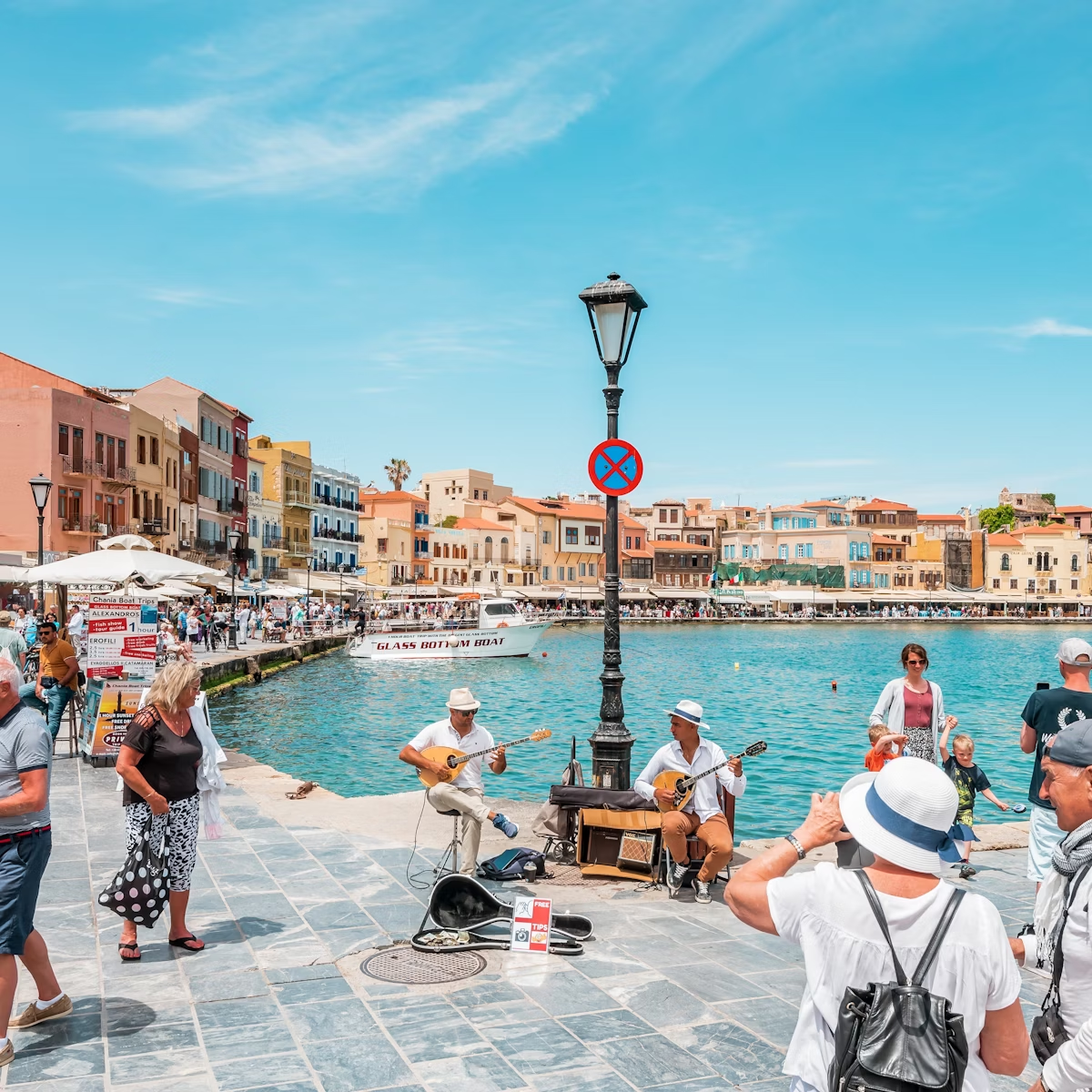
Venetian Harbour
There are few places where Hania's historic charm and grandeur are more palpable than in the old Venetian Harbour. It's lined by pastel-coloured buildings…
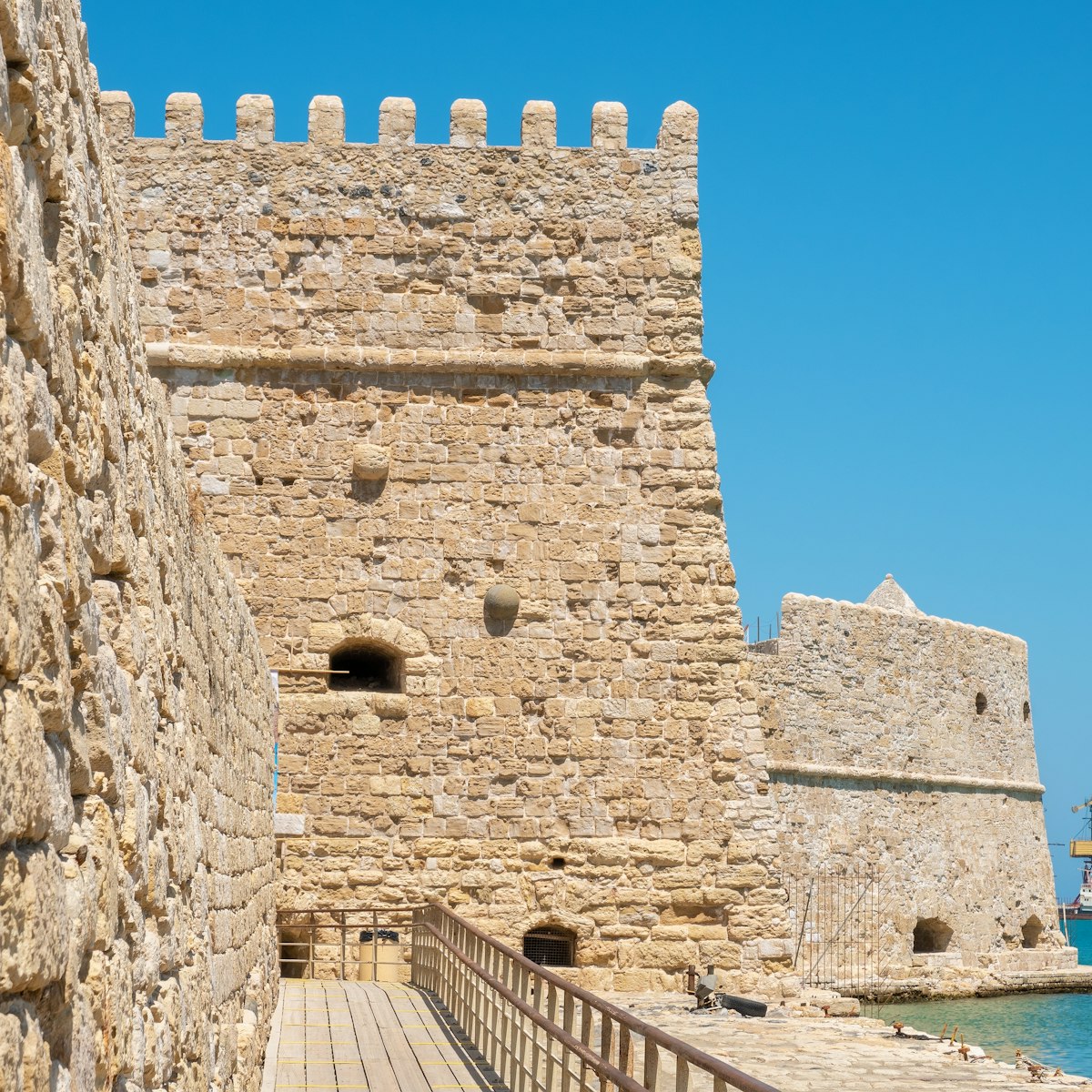
Koules Fortress
After six years of restoration, Iraklio’s symbol, the 16th-century fortress called Rocca al Mare by the Venetians, reopened in August 2016 with a brand…

Church of Agios Nikolaos
One of Hania’s most intriguing buildings is this Venetian-era church with both a bell tower and a double-balconied minaret – the latter replaced a second…

Iraklio Central Market
An Iraklio institution, if slightly touristy these days, this busy, narrow agora (market), along Odos 1866 between the Meidani crossroads and Plateia…

Etz Hayyim Synagogue
Crete’s only remaining synagogue (dating from the 15th century) was badly damaged in WWII and reopened only in 1999. It sports a mikveh (ritual bath),…
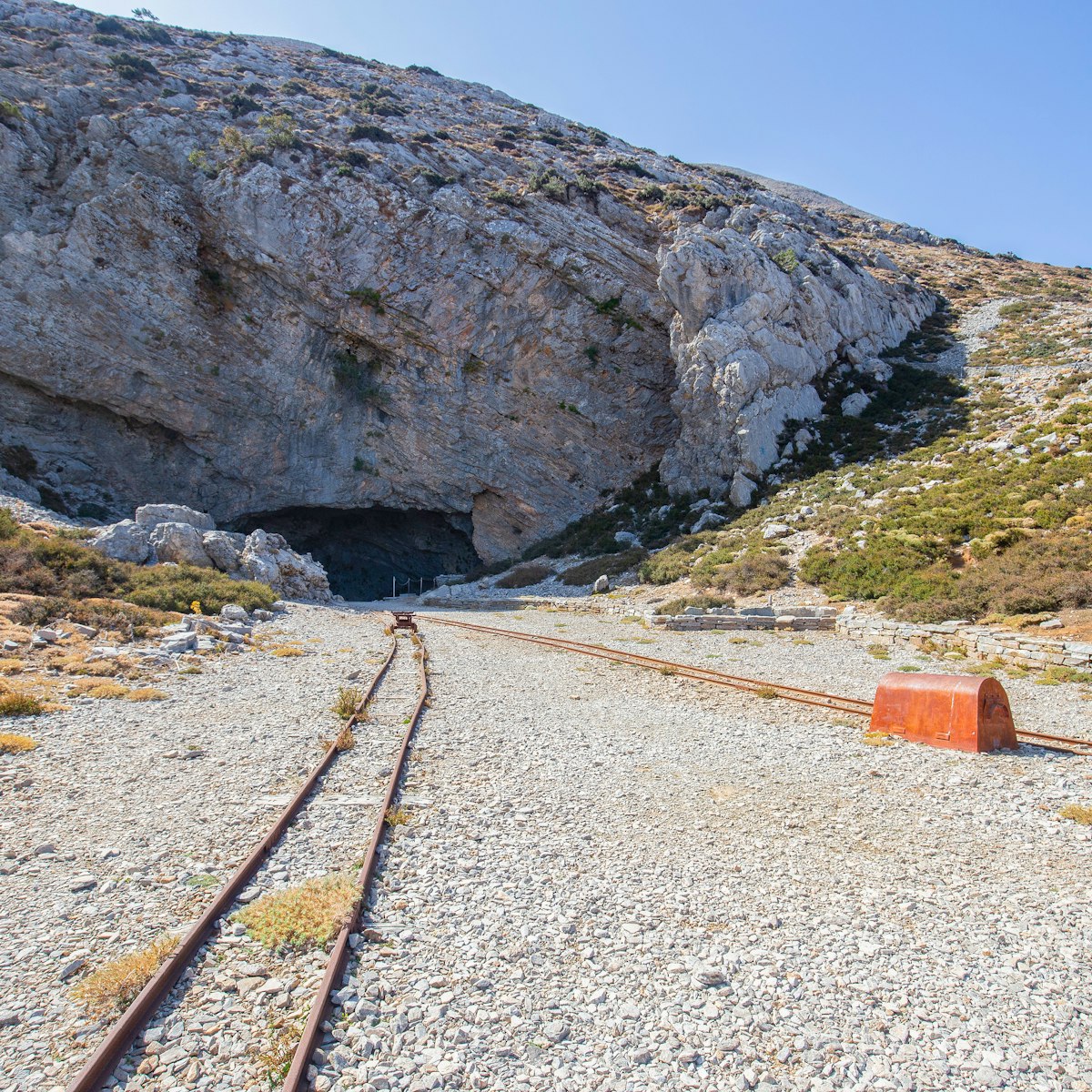
Although just a huge and fairly featureless hole in the ground, Ideon has sacred importance in mythology as the place where Zeus was reared by his mother,…

Skinakas Observatory
Near the top of Mt Psiloritis, at 1750m, Skinakas Observatory is operated by the University of Crete and is the country's most significant stargazing…
Planning Tools
Expert guidance to help you plan your trip.
Best Things to Do
Experience the best of Crete with this guide to the island's top things to do.
Things to Know
Before you travel to the glorious Greek island of Crete, read up on etiquette, destination practicalities, health concerns and more.
Transportation
Exploring the mountainous island of Crete is like navigating a small country. Here are our top tips for getting around Greece's largest island.
Money and Costs
Crete is a very popular destination but that doesn't mean there aren't ways to visit on a budget. Here are some top tips to stretch your euros even further.
Free Things to Do
Check out our top tips on free things to do in Crete. From beaches to historical landmarks, there are plenty of activities that won't break the bank.
Best Road Trips
These road trips in Crete will take you to mountains, beaches, monasteries, wineries, unspoiled villages and Venetian old towns.
Plan with a local
Experience the real Greece
Let a local expert craft your dream trip.
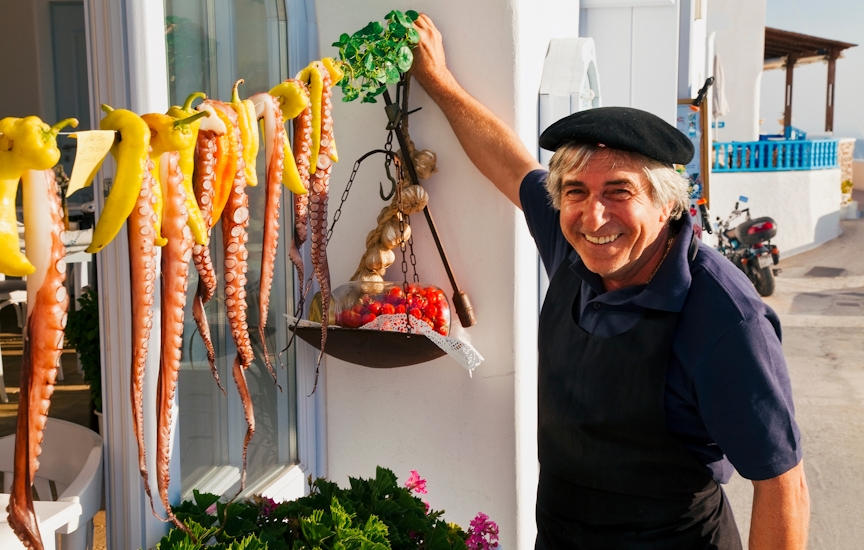
Latest stories from Crete
Filter by interest:
- All Interests
- Adventure Travel
- Art & Culture
- Beaches, Coasts & Islands
- Food & Drink
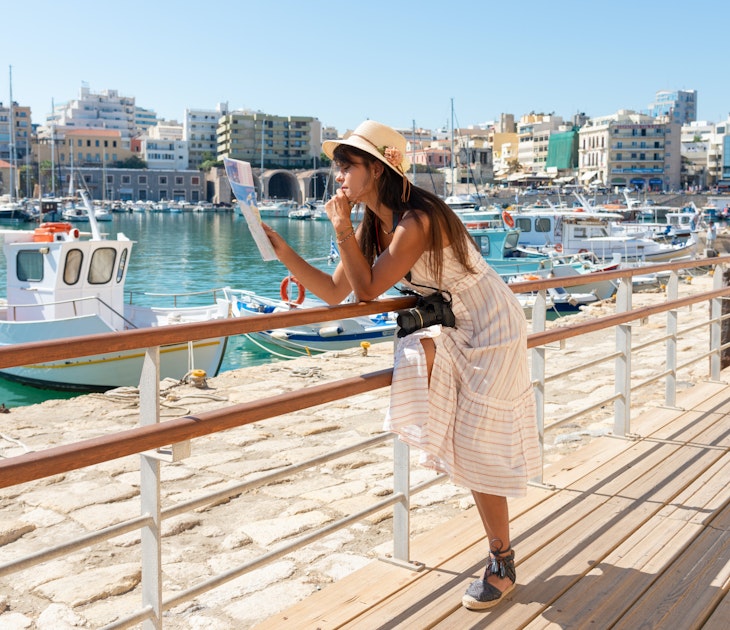
Feb 3, 2024 • 6 min read
Crete packs a lot of incredible attractions onto one island. Here are eight of our favorite places to visit when you get there.
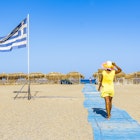
Jan 4, 2024 • 7 min read
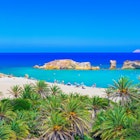
Jul 26, 2022 • 6 min read
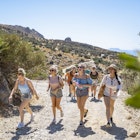
Jul 25, 2022 • 6 min read
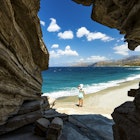
Jul 24, 2022 • 7 min read
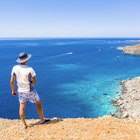
Jul 23, 2022 • 6 min read

Jul 21, 2022 • 7 min read
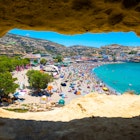
Jul 14, 2022 • 7 min read

Jul 12, 2022 • 5 min read
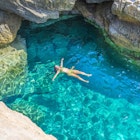
Jul 10, 2022 • 5 min read
in partnership with getyourguide
Book popular activities in Crete
Purchase our award-winning guidebooks.
Get to the heart of Crete with one of our in-depth, award-winning guidebooks, covering maps, itineraries, and expert guidance.
Crete and beyond
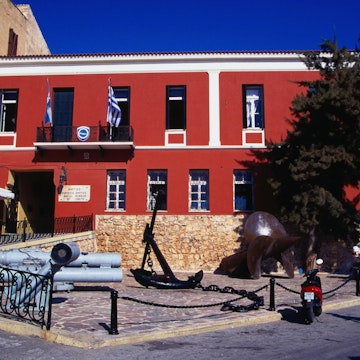
Crete simply has it all!
Crete is the largest island in Greece, and the fifth largest one in the Mediterranean Sea. Here, you can admire the remnants of brilliant civilizations, explore glorious beaches, impressive mountainscapes, fertile valleys and steep gorges, and become part of the island’s rich gastronomic culture. Crete is, after all, a small universe teeming with beauties and treasures that you will probably need a lifetime to uncover!
Where to go...
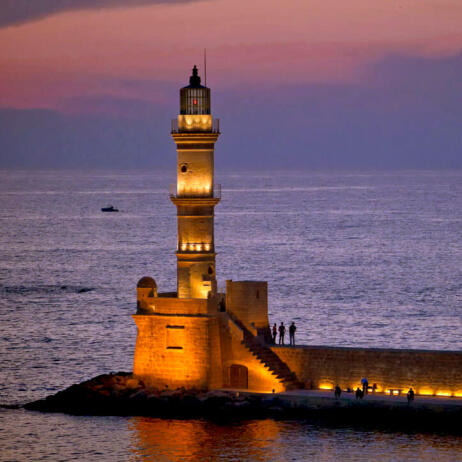
Chania (also spelled Hania) is the capital city, a place where different civilizations have flourished throughout the centuries. Strolling around the Old Town’s maze-like alleys with the beautiful Venetian mansions, the fountains and the churches will guide you through well-preserved historical monuments. The city of Chania is built on the area of Minoan Kidonia, at the end of the homonym gulf between Akrotiri and Onicha peninsulas. It was the former capital city of Crete (from 1847 until 1972). Nowadays, it is the second largest city of Crete after Heraklion and capital of the homonym prefecture. Get familiar with the city of Chania by wandering around in its streets, visiting its museums and admiring the different architectural styles presenting the historical route of the city.

Rethymno is located in the north end of the prefecture, built by the sea and is a city with many faces. Rethymno or Rithymna as it was once called has been inhabited since the Later Minoan III period. Nowadays, it keeps the elements inherited by its history (from antiquity up to now), preserving at the same time the characteristics of a modern city. You can reach Rethymno by boat from Piraeus or by plane from Athens to Chania and then drive 60 km to Rethymno.

Heraklion is the largest city of Crete and one of Greece’s major urban centres. The city flourished under a multicultural influence throughout the centuries; that’s why there is a plethora of Byzantine , Venetian and Ottoman structures to look out for! The city’s landmark is the 16th c. Koules fortress in the westernmost side of the old Venetian port , which along with the fortification walls (dating back to the same period) are among the most significant and imposing sights.

Agios Nikolaos
Agios Nikolaos (“Ag Nik” as the British visitors love to call it) is the capital town of Lassithi. Here, the bottomless salt lake Voulismeni dominates the area. A narrow channel of water connects the lake with the sea, while an imposing backdrop of red rock and trees adds to the natural beauty of the scenery. A small pine tree park lies above the lake, and a stone path leads to its southern section to a cute small harbour for fishing boats. The city boasts interesting Archaeological, Folklore, and Natural History museums, Byzantine churches, a well-organised marina, bustling pedestrian streets (ideal for leisurely walks), and traditional squares with buzzing cafés and restaurants.
10 reasons to fall in love with Crete

Local Dishes
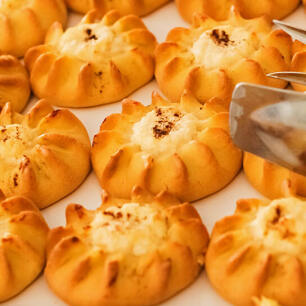
Kalitsounia
Tips for your trips.
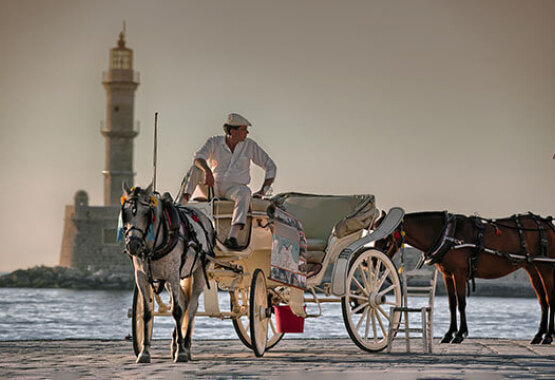
The Old Port Area of Chania
Chania’s Venetian Harbour was carefully built in the 14th century for commercial purposes and for protection against pirate raids. Today it is a point of reference for the city of Chania, and a much-photographed place with a touch of magic!
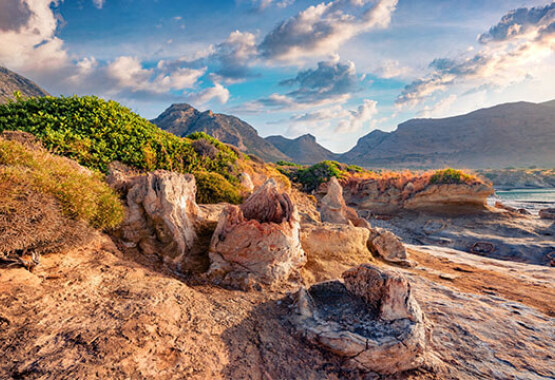
Geoparks in Greece
Greece is a land of major geological change. Millions of years of continuous mountain building have endowed this part of the planet with amazing natural monuments.
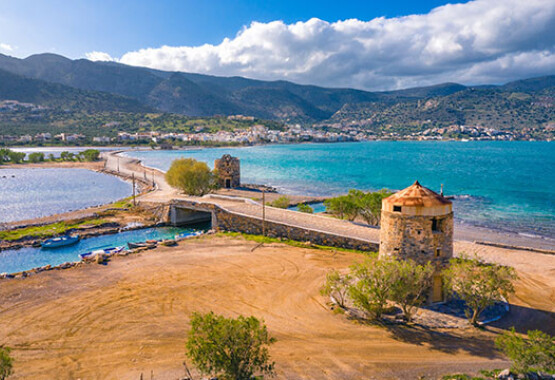
Explore the east part of Crete
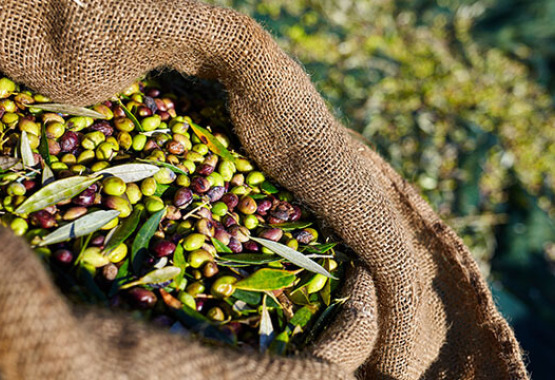
Take part in a traditional harvest activity!
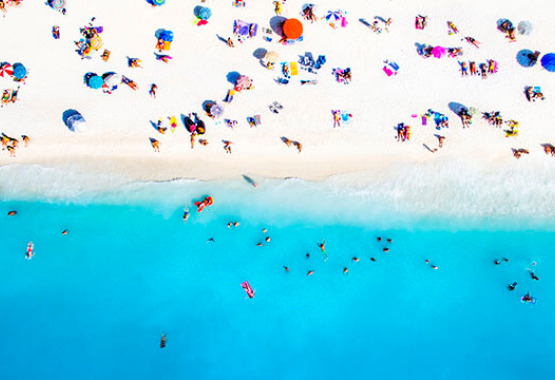
13 Oscar winning beaches
The first thing that comes to mind when you think about Greek summer are the endless coasts and the charming seashores that “flirt” with the magical waters of the Aegean, Ionian and Lybian Sea.

- Destinations
- Accommodation
- Rentals - Cruises
- Travel Guide
- Things to Do
Welcome to the beautiful island of Crete, a heavenly and pure land brimming with natural beauty, history and culture. Discover marvelous beaches, explore rugged gorges, enjoy unique local flavors and enjoy the rare Cretan hospitality.

Welcome to the beautiful island of Crete...
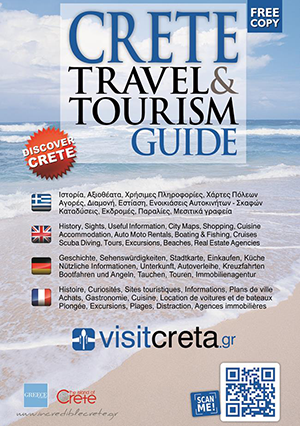
Read now! Read the Crete Travel & Tourism Guide and find out everything about Crete....

Crete Travel & Tourism Guide
History / Sightseeing / Useful Information / Cities’ Maps / Markets, Shopping / Accommodation / Dining, Kitchen / Car Rentals Tours, Beaches / Long Road Map / Entertainment.

Exquisite options, original ideas and unique suggestions for purchases.
ACCOMMODATION
Modern city hotels with nice view, luxury beach resorts on the north coast and chances for isolation and relaxation at the south side.
Fine Mediterranean cuisine, traditional restaurants, traditional taverns, fresh fish and other fashionable bar-restaurants await you.
RENTALS - CRUISES
Many modern choices for excursions by car or motorcycle and wonderful trips.
Advertising

Visitcreta.gr is member of bestgreece.gr.
bestgreece.gr - visitcreta.gr
Copyright 2013, All rights reserved.

Visit Crete: Top 27 Things to Do and Must See Attractions
The 27 best things to do in crete (bucket list).
You’re planning to visit Crete during your next trip? You want to know more about the best places to visit?
You’re at the right place!
In order to help you plan your stay, i have prepared this guide of the 27 best things to do in Crete , with all the must-see attractions of this beautiful island located at the very South of Greece .
In this guide, you will learn everything about the most beautiful towns such as Chania or Heraklion , the best beaches ( Balos Beach , Elafonissi “the pink beach”) and activities as well as the natural wonders such as Samaria Gorge .
So, where to go in Crete? What are the best points of interest?
Let’s find out!
2. Balos beach
3. elafonissi beach, 4. the samaria gorge, 5. heraklion and the archaeological museum, 6. the palace of knossos, 7. rethymnon, 8. vai beach, 9. preveli beach / preveli monastery, 10. the other most beautiful beaches of crete, 11. hikes in crete, 12. the botanical garden of crete, 13. akrotiri peninsula, 14. kournas lake, 15. the lassithi plateau – zeus cave, 16. monasteries to visit in crete, 17. spinalonga island, 18. agios nikolaos, 19. the most beautiful caves to see in crete, 20. richtis gorge and waterfall, 21. xerokampos and its beaches, 23. hora sfakion and the south-east coast, 24. the cretan islets, 25. activities to do in crete, 26. typical villages, 27. discover cretan gastronomy in the taverns, best things to do in crete: the tourist map, crete tours, renting a boat in crete, you’re traveling to crete these articles will help you, visit crete: the 27 best places to visit and must-see attractions.
In order to help you plan your stay in Crete, I have prepared detailed itineraries depending on your trip duration . You should read them after reading this article.
You can find them here, simply click on the orange links to read the articles:
- Itinerary: 4-5 days in Crete – Itinerary to prepare a short stay in East or West Crete
- Itinerary: One week in Crete – The perfect itinerary to visit Western Crete
- Itinerary : 7 days in Crete – The best itinerary to visit East Crete in 1 week
- Itinerary: 10 days in Crete – How to visit Crete in 10 days
- Itinerary: 2 weeks in Crete – The perfect itinerary for 14-15 days in Crete
They will allow you to plan your trip very easily!
And if you have any question, don’t hesitate to ask me in the comments section, at the end of the article. I would be glad to help you plan your stay.
You must you start this tour guide of Crete with one of the prettiest towns on the island: Chania .
Located to the North-West , it is an excellent starting point for a trip to Crete : it has one international airport and is a good base for visiting some of the most famous places, such as the lagoon of Balos, the Elafonissi beach or the Samaria Gorge, as day-trips.
Places of interest to see in Chania:
- The Venetian Old Port, with its entrance marked by its lighthouse. It is bordered by nice cafés and restaurants where you can go for a drink.
- Fort Firkas offers a beautiful view of the port from the ramparts. Access to the inner courtyard is free.
- The maritime museum of Crete , which is part of the fort. It exhibits navigational instruments, boat models and other documents related to the history of the Navy.
- The old town and the alleys around the port for leather shops, jewellery shops and traditional souvenir shops.
- The covered market also has shops selling souvenirs and local products (cheese, pastries, alcohol).
- The archaeological museum of Chania for its collection of relics from the Neolithic to the Roman period.
- The Greek Orthodox cathedral, located in a pretty square in the old town.
Near Chania , you will also find some beaches if you want to a refreshing stop:
- Nea Chora , the closest to the centre and therefore very busy, but not necessarily the prettiest because it is located on the roadside
- Hrisi Akti , ideal for surfers
- Eastern Gulf, a small protected sandy cove bordered by pine forests. For me, it’s the prettiest beach near Chania!
- Agii Apostoli / Iguana Beach that looks a lot like Eastern Gulf but bigger.
Want more information about all places to visit in Chania? You can find it in my detailed article on the city, which you can read by clicking here: The best things to see and do in Chania?
Chania is not very big, you can easily cover everything on foot (especially as the city centre only allows pedestrians).
Keep 1 morning to visit Chania.
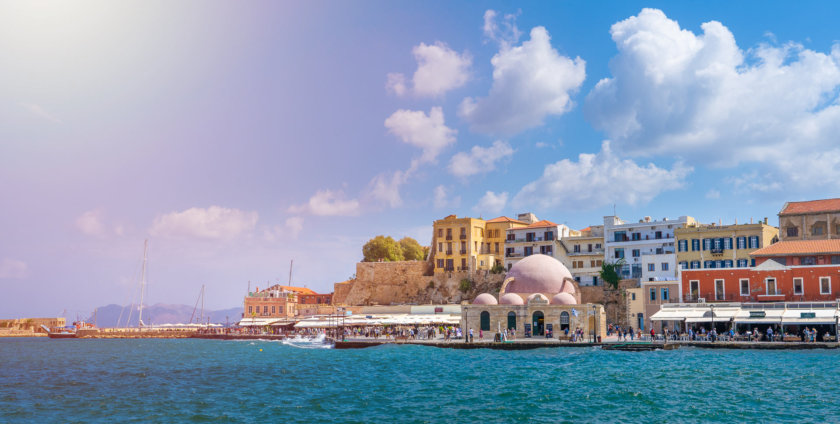
If there is one place you should not miss when in Crete , it is the famous Balos Beach, also called Balos Lagoon
Considered one of the most beautiful beaches in Crete , it is located about 90 minute West of Chania.
The lagoon offers a superb stretch of shallow turquoise waters where it is impossible to resist a dip!
Bordered by a beautiful beach with fine sands of pink hues, with cape Tigani in the background and a view of the island of Gramvoussa , the setting is truly sublime and heavenly.
All the detailed information to get to Balos can be found in my article here: The guide to visit the lagoon of Balos.
You can go to Balos by car or opt for a day trip from Chania or Kissamos. You will then reach Balos Beach directly by boat.
You must particularly take one of these 2 cruises (click on the orange link to get all the info and book):
- From Kissamos – Boat trip to the lagoon of Balos + swimming (with stop at the island of Gramvoussa).
- From Chania – Hotel pick-up + Bus transfer to Kissamos + Cruise to Gramvoussa and Balos.
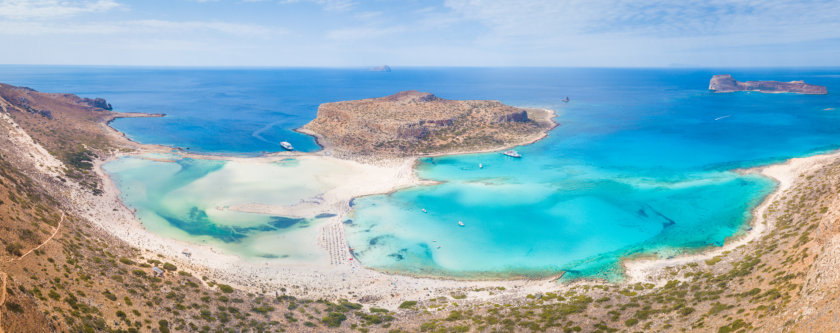
Along with the lagoon of Balos, the Elafonissi beach is definitely one of the most beautiful places in Crete.
What makes this island’s most famous beach special , regularly ranking among the top 10 most beautiful beaches in the world , is its pink sand and shallow translucent water.
Enough to stock-up with photos for your Instagram account!
But if I have one advice for you, you shouldn’t stay on the main part of the beach (where everyone is) but cross over to the other side to enjoy a wilder setting.
Here you will find turquoise waters, pink sands and big rocks, and above all you, a much quieter setting for a swim!
All the practical information about Crete’s best known pink sand beach is in my other post: Elafonissi: the definitive guide.
Elafonissi beach is quite isolated , so if you haven’ t rented a car for your tour in Crete , you will have to take a transport-included trip to get there.
These trips are offered from 3 cities (click on the orange link for information):
- From Chania – my recommendation because it is the closest to Elafonissi!
- From Rethymnon
- From Heraklion.
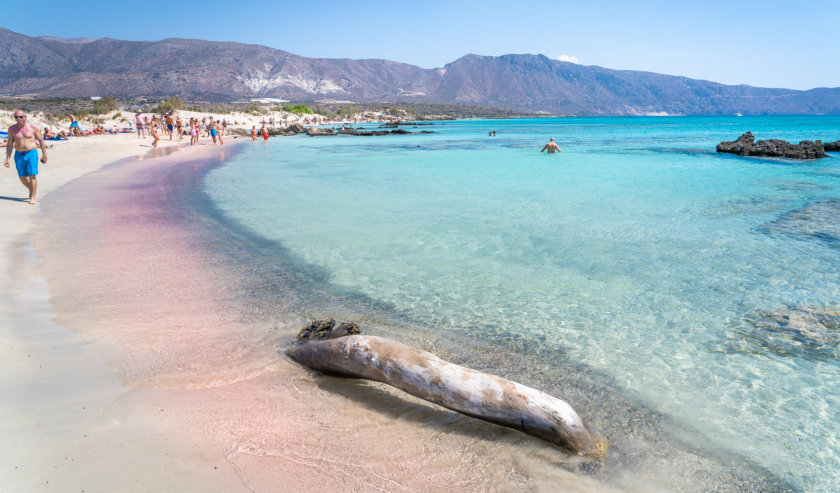
Are you looking to go on a hike in Crete ?
Then head to the Samaria Gorge, in West Crete, for a hike of approximately 16 km in one of the longest gorges in Europe.
The trail starts with a steep descent of 4 km through the shady forest before reaching the bottom of the Gorge and the main rest area, 7 km away.
The most spectacular and famous part of Samaria is located at km 11 . At the “ Iron Gates” , you will pass through the narrowest passage of the Gorge which barely measures 3.50 metres and whose walls reach 300 metres.
The path alternates only between downhill and flat, but you should definitely bring a good pair of shoes because there are stones everywhere and it is slippery.
The Samaria Gorge hike ends at the small seaside village of Agia Roumeli where you will have to take a boat and then a bus to return to the car park or to Chania.
Please note that if you have decided to visit to Crete out of peak season, the Samaria Gorge us closed from October 15th to May 1st.
To learn more about this hike , you must read my dedicated article by clicking on the following link: How to visit the Samaria Gorge?
Good news: if you don’t have a car, you can still visit the Samaria Gorge from Chania by booking a round-trip in a bus in advance.
Click the button below for details:
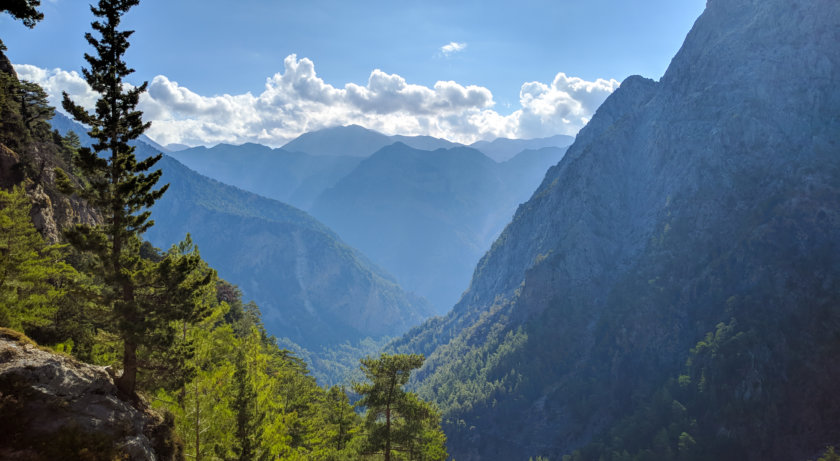
Along with Chania, Heraklion is the second main city to visit in Crete .
It also has an international airport and can be used as a starting point for your itinerary in Crete .
The best things to see and do in Heraklion?
- The archaeological museum of Heraklion and its vast collection of objects ranging from the Neolithic to the Roman period. It is one of the largest museums in Greece. Modern and well developed, I consider it an unmissable spot when visiting Crete!
- The Koules fortress and its exhibition on the history of the city. You can also enter the ramparts to enjoy the view of the port and the sea.
- A walk in the old town , along rue 1866, lined with shops and restaurants with shaded terraces
- The historical museum of Crete to know everything about the history of the island
- The Agios Minas cathedral and its ceiling covered with frescoes.
The details with all the things to do in Heraklion can be found in my dedicated article. Read here: Visit Heraklion.
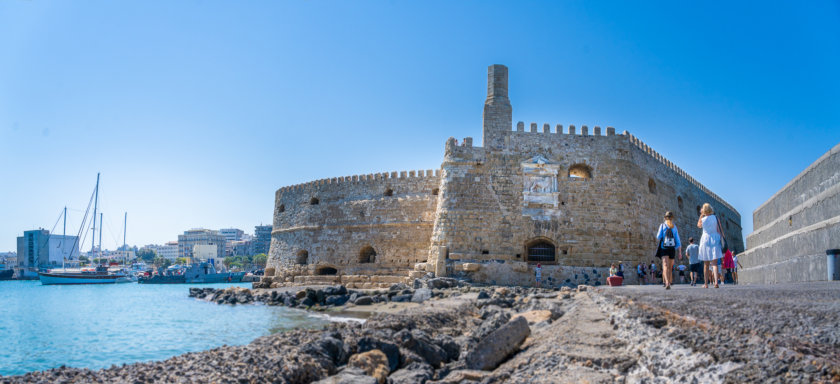
Only a 10-minute drive from the centre of Heraklion, the Palace of Knossos is the most visited tourist site in Crete as of now.
The ruins of the palace were discovered in 1878, but the actual excavations only began 20 years later thanks to the archaeologist Sir Arthur Evans, who devoted 35 years of his life and most of his savings in uncovering the ruins.
The ruins uncovered a new civilisation , which Evans himself chose to name the Minoan civilisation, in reference to King Minos (the legendary king of Crete).
Today, it takes a lot of imagination to imagine the grandeur of the palace and the surrounding buildings , but you can explore:
- The famous bull fresco at the North entrance
- The Throne Room
- The megaron (the bedroom) of the Queen and its fresco with Dolphins
- The fresco room where copies of the works can be found (the originals are displayed at the archaeological museum of Heraklion)
- The mural of the Prince of the Lilies.
As you might have guessed, history buffs should not miss this archaeological site in Crete!
All the practical information can be found in my dedicated article: Visit the Palace of Knossos.
To visit the Palace of Knossos and the Archaeological Museum of Heraklion, you must buy a combined ticket in advance.
This will save you from queues and you will also have an included audio guide:
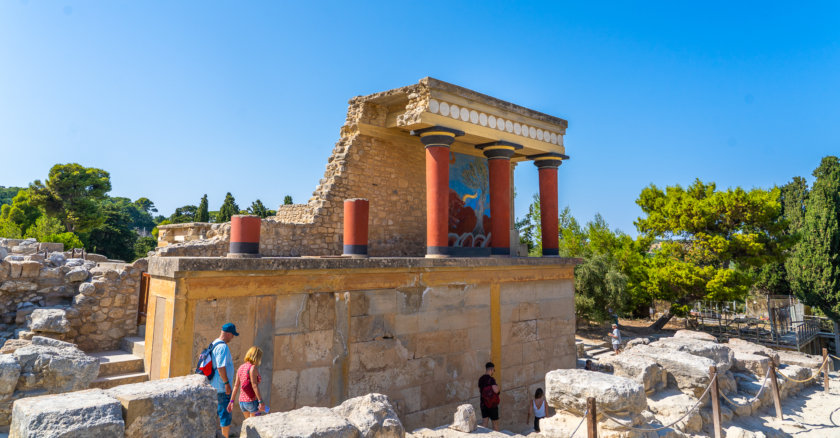
We will continue this guide to Crete with a small town on the road between Chania and Heraklion: Rethymnon
I particularly enjoyed walking around the old town , which I found super pleasant and really picturesque with its charming cobbled streets lined with shops and taverns.
You can also discover the Venetian fortress of Rethymnon (€4) and go to the Old Port that has small cafés/restaurants with terraces by the water.
From Rethymnon, you can easily visit the main places of interest in Crete (Balos, Elafonissi, Samaria, Chania…) via trips.
To organise your visit to Rethymnon and not miss out on anything, you can read my article: What are the things to do in Rethymnon?
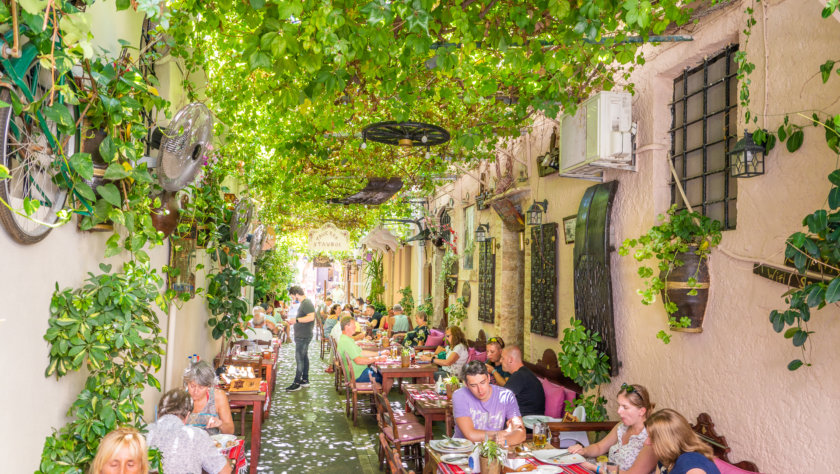
If you want to spend a day sunbathing and swimming during your holiday in Crete, I recommend Vai beach.
Located in the north-east of the island , this beautiful sandy beach bordered by palm trees and crystal clear water is one of the best known in Crete.
You can rent deckchairs/parasols from €10 a day and practice several water sports activities: jet ski, paddle boat, buoy.
To enjoy a beautiful view, go up the stairs to the right of the beach.
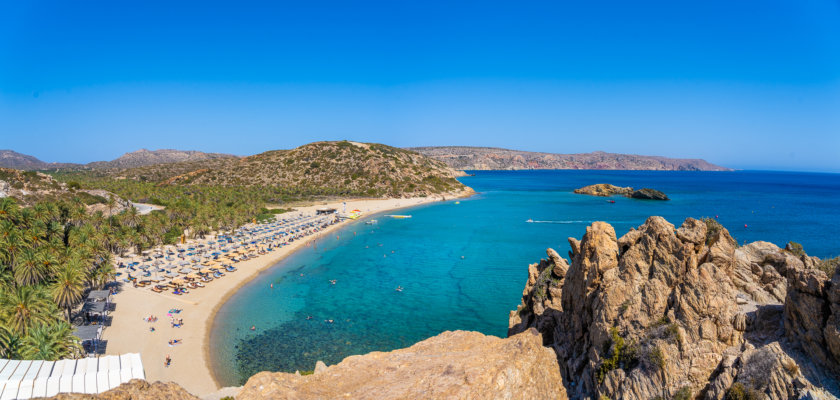
To continue with the list of the famous beaches to visit in Crete , you must not miss Preveli beach.
It actually looks a lot like Vai beach because it is also a small sandy beach bordered by a palm grove. But there is a river crossing the beach, that flows into the sea.
You can also swim in fresh water!
The Preveli beach is located at the end of a rather steep path (about 15 minutes for the descent) but you can have a very nice view overlooking it at a 5-minute walk from the car park.
Just a 5-minute drive from the beach , you can also visit the Preveli Monastery (Moni Preveli) which has a pretty church and a museum displaying beautiful icons.
To reach Preveli beach without a car, you can book this organised trip from Chania or Rethymnon:
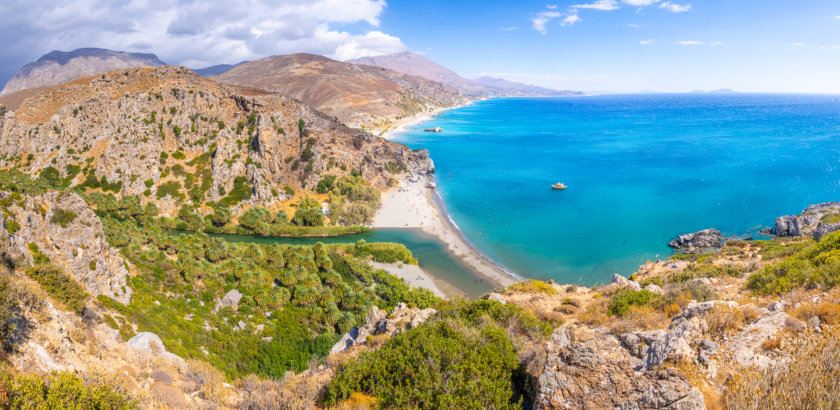
By now, it should be clear to you that it is impossible to visit Crete without spending a little time at the beach!
In addition to the 4 unmissable beaches I just mentioned (Balos, Elafonissi, Vai and Preveli), here is my selection of the most beautiful places to swim in Crete:
- The pink sand beach of Falassarna , 40 minutes away from the lagoon of Balos
- Seitan Limani beach, 20 km from Chania, in the Akrotiri peninsula
- Kedrodasos beach, 5 minutes by car from Elafonissi
- Karavostasi beach, on the road between Rethymnon and Heraklion
- Kolokitha beach, Elounda. Much less known than the others, for me it deserves its place in the top 5 most beautiful beaches on the island!
- Voulisma beach, at Agios Nikolaos
- The beach in the small village of Mohlos
- The 2 small beaches of Itanos , not far from Vai beach
- The beaches of Xerokampos: a succession of beautiful beaches and creeks with turquoise waters, very little frequented. My favourite on my road trip in Crete !
- Red Beach in Matala
- Triopetra beach is famous for its stratified rocks – It is worth seeing if you go there before going to Preveli but the beach itself is not interesting.
The best way to discover Crete’s most beautiful beaches is to opt for a VIP boat trip, far from other tourists!
For this, you have 2 options:
1) Book a private boat trip in Crete
You can rent a boat with a captain , and he will take you to the most beautiful corners of Crete.
Motor boat, sailing boat, catamaran : you can choose the right boat for a dream day!
You must rent your boat with a captain as early as possible , since as you can imagine, this type of a VIP day at sea is greatly in demand, and it would be a shame to not have a spot!
You will find all boats with a captain in Crete by clicking on the button below:
2) Rent a boat and discover the Cretan coasts by yourself
If you have a boat licence, the 2nd solution for a great day at sea is simply to rent a boat!
Simply click on the button below and book your boat immediately:
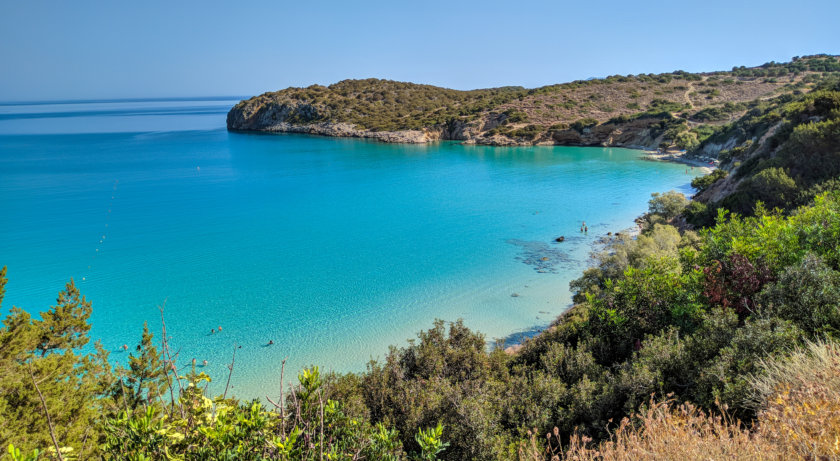
Hiking is one of the best activities to do in Crete to discover beautiful wild landscapes.
The island is full of paths and you will be spoilt for choice, no matter your level or where you are located.
But you must particularly take the paths where you can explore the impressive Cretan Gorges.
In addition to the Samaria Gorge, here is a brief overview of the most beautiful walks in Crete:
- The Imbros Gorge – From Imbros to Hora Skafion – South-West Crete
- The Agia Irini Gorge – South-West
- The Aradena Gorge where you can go down to the Marmara creek – South-West
- The Mili Gorge, towards Rethymnon
- The Zakros Gorge in the Valley of the Dead – East Crete
- Richtis Gorge to discover the beautiful waterfall of the same name – East Crete
- The Kritsa Gorge – East Crete
- The Anydri Gorge, towards Paleohora – South-West
- The coastal path of Paleohora in Sougia
- The Rouvas Gorge from Lake Votomos (between Heraklion and Matala).
For experienced hikers , there are the following options:
- The climb up Mount Gingilos – Departure from Xiloskalo, from Samaria Gorge
- Trypiti Gorge – Departure from Omalos
- The climb up Mount Psiloritis, the highest point in Crete
- The E4 trans-European long-distance hiking trail that crosses Crete from West to East over a length of 320 km. This road, which has a total length of 10,450 km, starts in Portugal and passes through Spain , France , Switzerland , Greece and other countries before ending in Cyprus.
The hiking trails in Crete are very rocky, you really need to wear good shoes .
Bring enough drinking water, sunscreen and always check the weather before leaving.
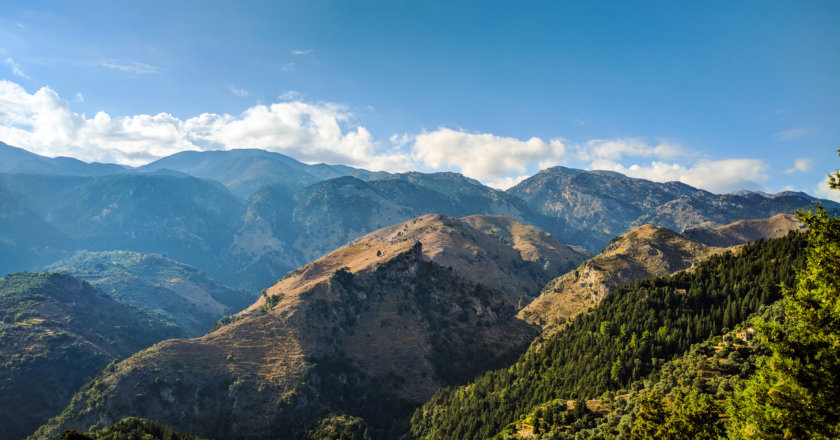
To continue this list of the top things to see in Crete, you must visit the botanical garden of Crete.
Located in the surroundings of Chania , on the mountain-side, the 2.5 km trail, has several varieties of plants and fruit trees from Greece and also from all over the world.
A pleasant walk that takes about 90 minutes.
The garden also has a small lake with a few animals and several peacocks roam freely around the park. If you’re wondering what to do in Crete with kids , it’s a good idea for a trip.
Entrance fee is € 6, and a small water bottle is provided. More information on the official website.
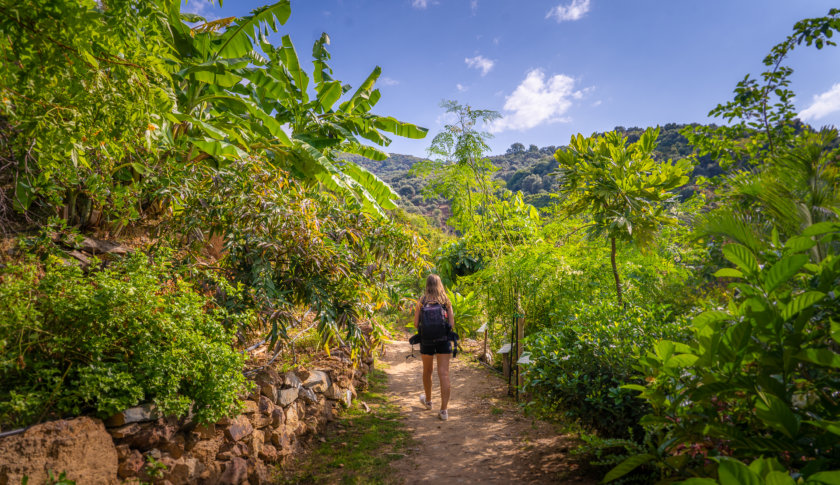
You must continue with touring Crete by exploring the peninsula of Akrotiri.
The airport is located on this peninsula just outside Chania, but I can assure you that this is not the only point of interest.
Not to be missed in Akrotiri:
- Stavros beach: a beautiful and very quiet sandy beach with a part that is protected from the wind
- The Agia Triada monastery that I found really beautiful with its well developed garden and flowers
- The Governto Monastery
- Seitan Limani beach, a small canyon with turquoise waters that opens into a creek surrounded by cliffs. One of Crete’s best known tourist attractions.
- Marathi beach, a sandy beach split into 2 small coves, very crowded but which I didn’t find extraordinary
- Loutraki beach.
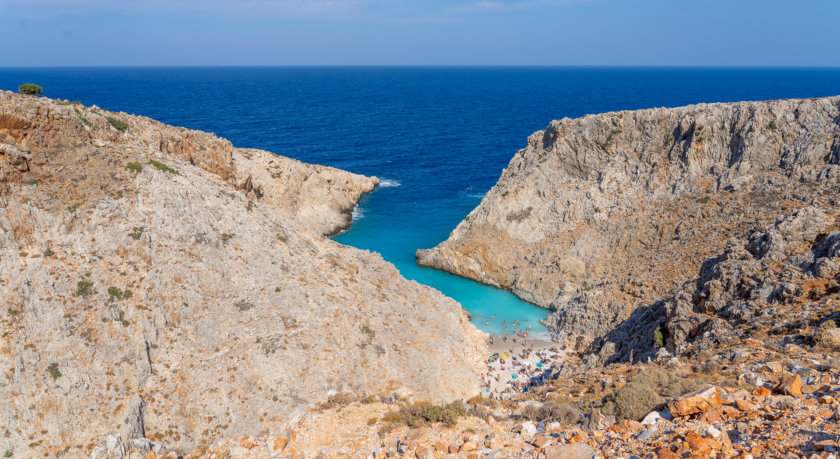
Lake Kournas is one of the other places to go in Crete to swim , but this time in fresh water.
Located 5 km away from Georgiopouli (between Chania and Rethymnon) and surrounded by mountains, it is the only natural lake in Crete . The water here is crystal clear and very clean, so you won’t have to when swimming.
You can also rent a paddle boat (between €7 and €12 an hour) to go around and discover the many water turtles and fish that hide there.
At the entrance to the lake you will find a few souvenir shops and taverns.
The first car park on your right costs at €2 per day, but if you continue a little further down you will have a free car parking spot.
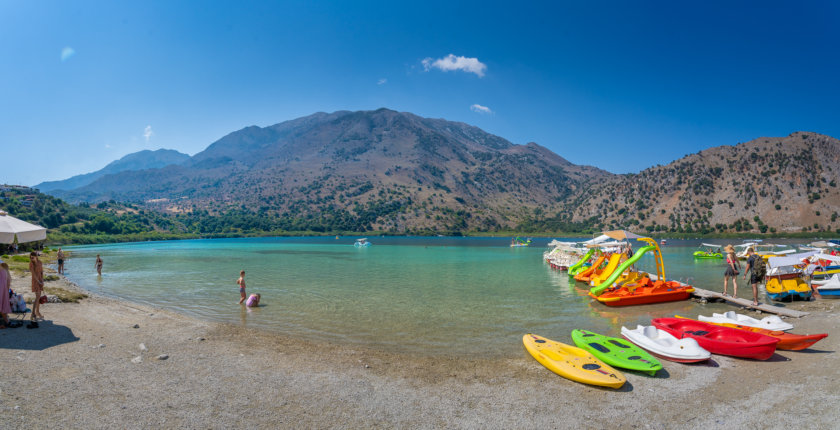
For half a day road trip in Crete, you must complete a circuit of Lassithi plateau.
This rural area in the East of the island is very typical with its small villages and the few windmills left out of the 20,000 used for irrigation.
Following the Lassithi plateau circuit in a car , you will visit:
- Tzermiado, the largest of the 20 villages in Lassithi
- Agios Georgios where the Cretan folk art museum is located
- The Homo sapiens museum on the evolution of man – I won’t recommend it but the car park offers a beautiful view of the plains.
- The cave on Mount Dicte, also called the Cave of Zeus or the Psichro cave , because according to legend it is here that Zeus was born. The cave is very deep and has large stalactites and stalagmites. Entrance fee costs €6 (a 10-minute climb + descending a long staircase). It is the main tourist site in Lassithi.
- Greek Mythological Park where you can discover Greek mythology thanks to an audio guide in English and truly representative scenery. I was really surprised (well!) with the quality of the explanations and the facilities.
- Lasinthos Eco Park where you can discover weaving workshops, wood turning, pottery. Free entry.
- The ancient city of Latho offers a beautiful view of the entire bay and is a renowned archaeological site
- Kritsa village and the Panagia Kera church known for its very well preserved Byzantine frescoes.
You can’t visit the Lassithi plateau by public transport. If you don’t have a car, the only way is to book a day trip in 4*4.
You will cross villages, visit the Zeus cave and have lunch in a traditional tavern.
This trip with an English-speaking guide is available from several cities (click on the links in orange to book):
- From Heraklion – Safari by Land Rover to Lassithi
- From Malia/Elounda/Gouves/Ierapetra
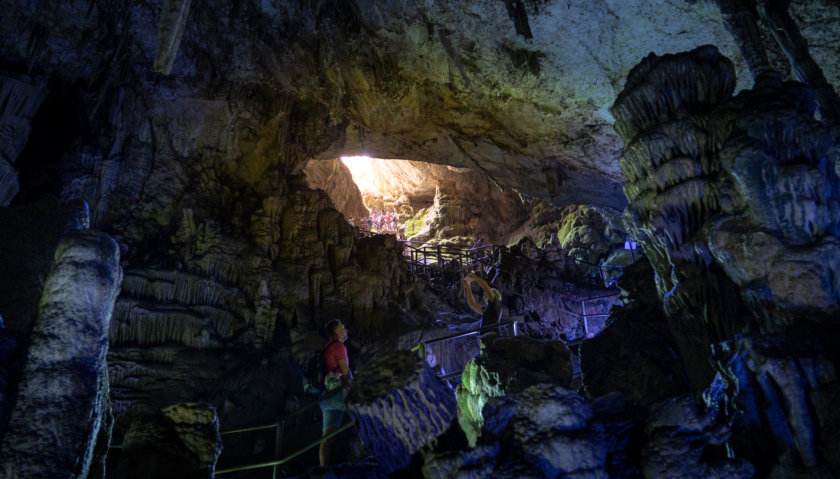
If you’re still wondering what to see in Crete , you must visit some of the many monasteries on the island:
- The Agia Triada monastery, on the Akrotiri peninsula (next to Chania) – After driving all around Crete, I thought it was the prettiest.
- The Governto Monastery, also in Akrotiri
- The monastery Chrisoskalitissis (before arriving at Elafonissi beach)
- Arkadi monastery, near Rethymnon
- Moni Toplou , before visiting Vai beach
- The Preveli monastery, next to the famous beach of the same name.
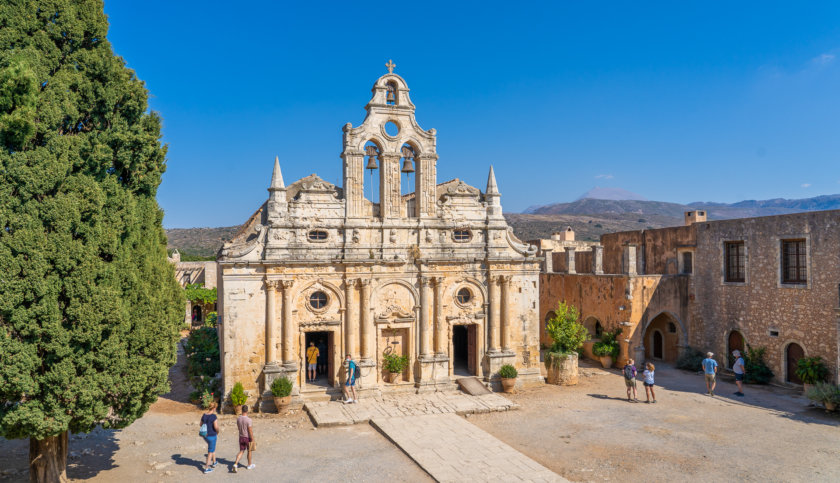
If you’re planning an itinerary in East Crete , a visit to Spinalonga island is a must.
The island was once a fortress in the 16th century, occupied by the Venetians and then by the Ottomans. It was then used as a leper colony in the 1900s.
But if Spinalonga ranks among the most important tourist sites in Crete today, it is thanks to the famous novel by Victoria Hislop, “The Island”. The book, whose story takes place in Spinalonga, was successful worldwide and was later adapted into a film and series.
Today, by docking at the island, you can walk through the village ruins, the fort, the leper hospital and the church.
It takes a good hour to walk around, and don’t forget to climb up the hill to admire the view of the Plaka peninsula.
Entrance fee for Spinalonga: €8
To go to Spinalonga, you can take the boat to Plaka or Elounda (€12). In peak season, there is a shuttle every 1/2 hours and the journey takes just 1/4 hour.
You can also visit the island of Spinalonga through an organised trip including pick -up from your hotel, transport by bus and the visit to Agios Nikolas and Elounda:
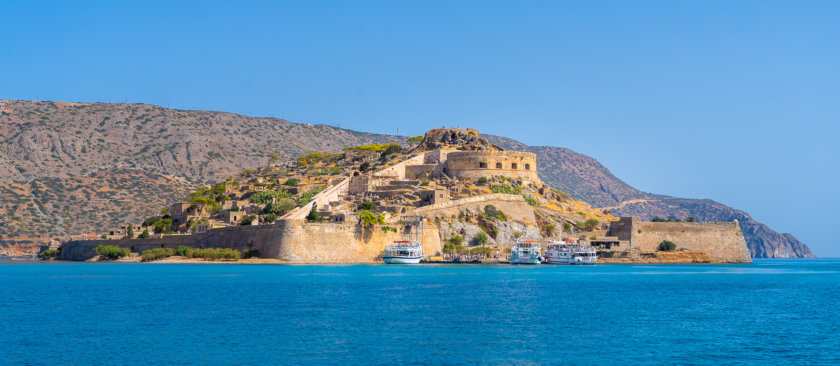
Agios Nikolaos is a small and well-known town not far from the island of Spinalonga.
You must park your car in the municipal car park and to follow the seafront promenade until you reach Voulismeni lake, the main attraction of the place.
There are plenty of restaurants and shops all around.
Sea excursions also leave from Agios Nikolaos to visit Spinalonga .
And if you’ve decided to go to Crete with your children, you can take a transparent -bottomed boat ride to observe the fish.
Close to Agios Nikolaos, there are also several beaches that are not among the most beautiful on the island but you can go there to refresh yourself.
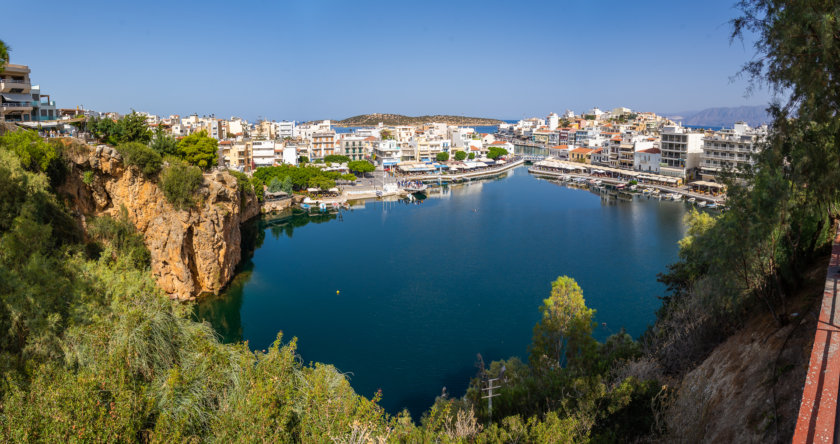
If you are driving around Crete, there are several caves you can visit:
- The Zeus cave on the Lassithi plateau (which I have already mentioned in point 15 of this article) is the best known for its history – Entrance costs €6
- The Melidoni cave where you can admire beautiful stalactites and stalagmites and which I found very pretty – Entrance at €4
- Agia Sofia cave for a 10-minute photo stop on the road before reaching Elafonissi beach – Free entrance
- The Sfendoni cave and its 7 chambers where you can admire numerous stalactites and stalagmites – 40-min guided tour at €5
- Kronion cave (also in Lassithi): inhabited in the Neolithic and which later served as a burial site during the Minoan period – Free entry
- The Matala , caves carved into the cliff on the seashore (see point 22) – Entrance fee: €4.
- The Milatos cave where 2500 people who had taken refuge to escape the Turks were found and killed – Free entry
- The Mount Ida cave where Zeus allegedly hid to escape his father. Several offerings have been discovered here, but the cave is of no particular interest except for mythology lovers – Free entry.
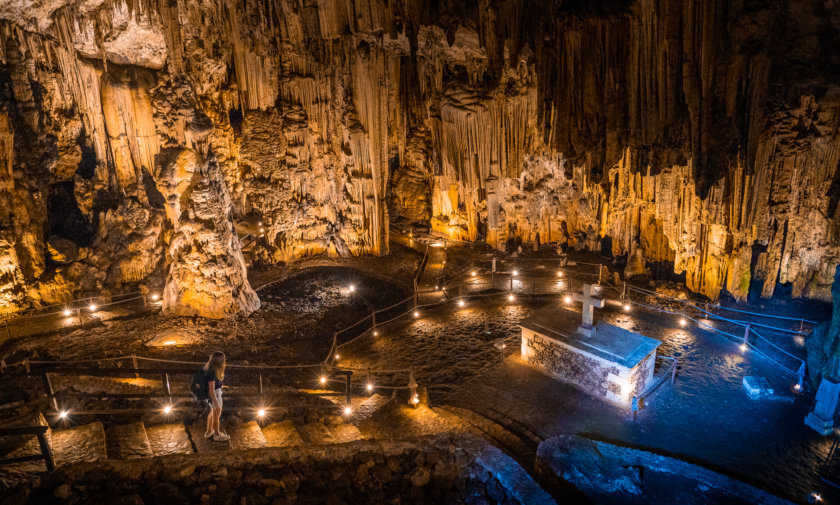
For a little refreshing walk when visiting Crete, you must go on the the Richtis Gorge hike.
From the car park located at the exit of the village of Exo Mouliana , you will need about 90 mins on a shady path running through the forest and along a small river to reach the Richtis waterfall.
Apart from a patches with large, slippery rocks, there is no particular difficulty if you are wearing good shoes. Of course, if you’re wearing flip-flops (as I’ve seen some people do), things can be difficult…
The waterfall is really beautiful and if you are not feeling chilly, you can even take a swim.
From the waterfall, you can then continue on your way to a small beach (not very pretty and very windy by the way) which takes 30 minutes.
From there, you can choose to turn back, take the tarmac road that leads to the village on foot (I wouldn’t recommend this it gets dry, the sun is high, and it’s not interesting!) or take a taxi that will take you up to the car park (the number is displayed on the trees – €25 for 2).
Note that access to the Gorge is charged: €3 per person.
Good news for those who don’t have a car, you can visit the waterfall in a 4*4 trip with an English-speaking guide.
You can book it directly by clicking here!
If you want to walk there and back, you can save some time by parking your car closer to the waterfall.
Drive along the small road from the left of the car park to a small bridge . There are a few parking spots on the roadside (if you arrive early).
You can also access the waterfall directly from the beach in 30 minutes on foot . To reach the beach from the top of the village in a car, you have to take a very narrow and winding road.
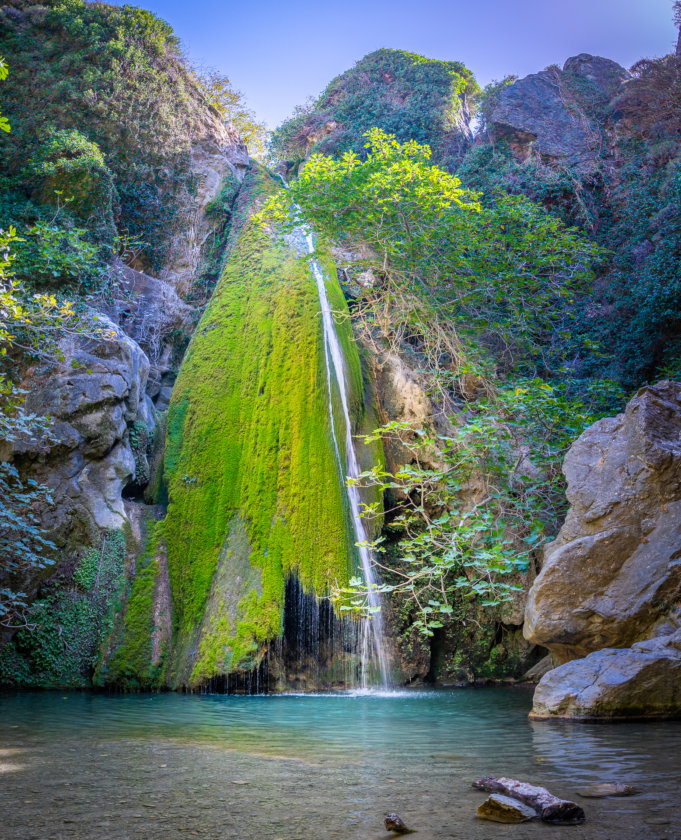
If you want to visit an off-beat place during your stay in Crete, go to the town of Xerokampos, at the Eastern tip of the island.
Not only does the road leading to it offer splendid views , but you will also discover a succession of beaches and coves , each more beautiful than the last.
Fine sands, shallow turquoise waters and, above all, very few people, this is doubtlessly one of the most beautiful places in Crete, a true favourite!
And if I had to name the 2 most beautiful beaches of Xerokampos, I would say:
- Katsounaki beach (Maps.me name), also called “ Paralia Anola” (Google Maps): a pretty cove with fine sands accessible by car via a dirt road.
- The Ambelou beach (on Maps.me) or “Paralia Mazida Ammos” (if you search on Google Maps) which is just beautiful!
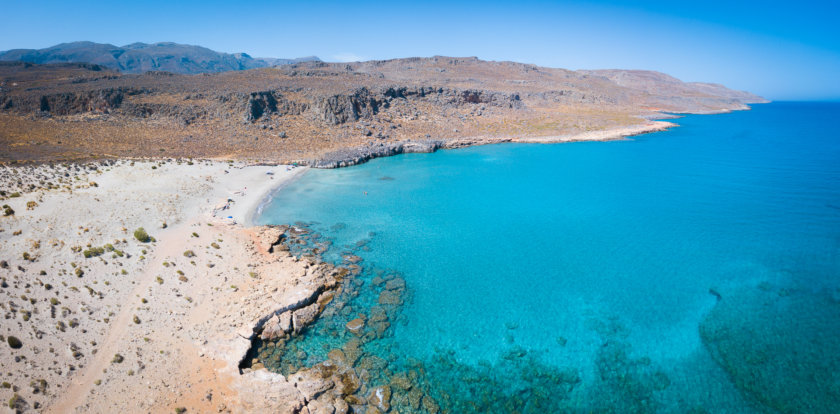
Matala is a small seaside resort known for its caves carved into a cliff by the sea-side and overlooking a pretty cove with turquoise waters in the shape of a crescent moon.
The caves, dug in the Neolithic period, served as a Roman necropolis, before being used as a squatting spot in the 1960s by a community of hippies who made them their hippy “Peace and Love” Camp.
With such a view and direct access to the beach for evenings around the fire, you can understand why they chose the place!
Entry to the caves is charged: €4
Matala also has another beach: Red Beach, a small beach with golden sands and deep and turbulent water. You can walk there in only 30 minutes along the path that starts from behind the village.
At the beginning of the Red Beach trail, on the right after the first set of stairs, you will have a magnificent view of Matala and the caves.
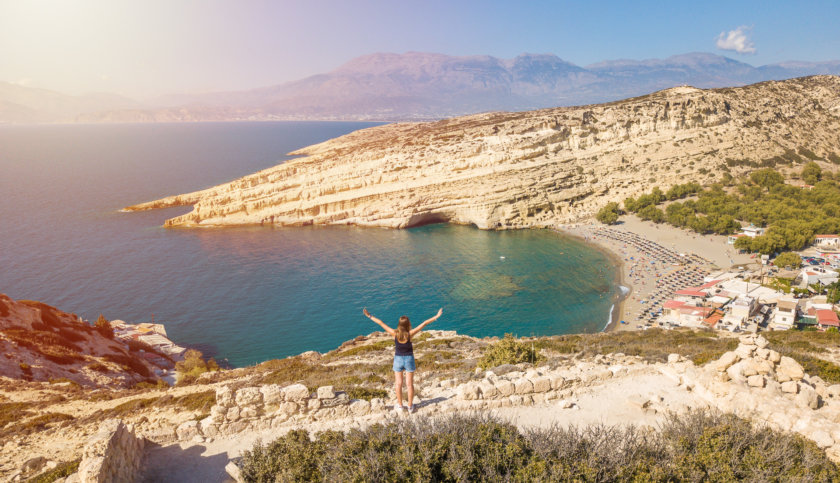
In South-East Crete , you’ll find some of the least accessible seaside villages on the island.
They are very isolated, and you can only reach them by taking long, winding mountain roads, and in some cases, only by boat.
What are the things to see in Crete along the South-East coast?
- Hora Sfakion: a very cute village that is the departure point for boats to Loutro, Sweet Water beach or Gavdos island (see below).
- Loutro , located in a tiny creek, the village is only accessible from Hora Sfakion by sea (by ferry in 20 minutes) or on foot (6 km).
- Agia Roumeli, the village located at the exit of the Samaria Gorge, which can only be reached on foot or by boat from Hora Sfakion, Loutro, Sougia and Paleohora.
- Sougia where the boat from Agia Roumeli arrives filled with hikers who have completed the Gorge of Samaria. Then everyone gets on the bus back to the car park or to Chania.
- Paleohora, a small picturesque village located 70 minutes by car from Elafonissi beach. From Paleohora you can take the ferry to Sougia, Agia Roumeli, Loutro, Hora Sfakion and Gavdos.
You can view the different ferry routes, schedules and rates on the official website of the boat company: Anendyk .
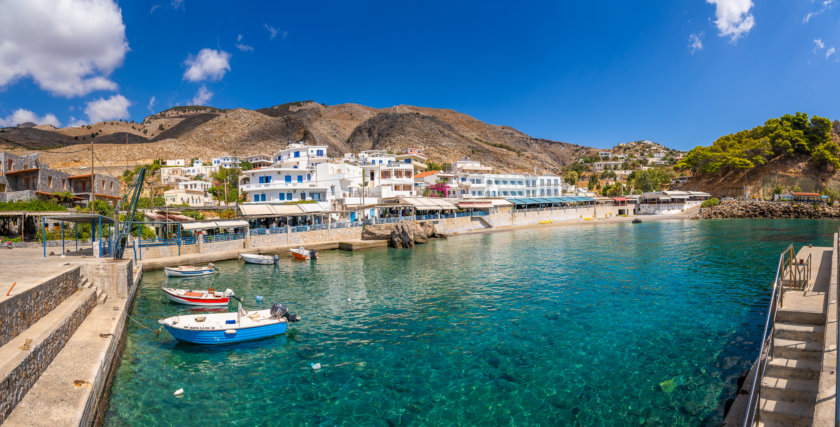
Visiting Crete also means taking the time to go on beautiful day trips by boat to discover one of the pretty Cretan islets:
- Gavdos is an untamed island where you will find heavenly beaches – Ferry access from Paleohora and Hora Skafion
- Chrissi, a tiny uninhabited island classified as a nature reserve and accessible by boat from Ierapetra. Day trips with transport (bus + boat) included from Heraklion and Agios Nikolaos are also available by clicking here!
- Koufonissi where you will also find turquoise waters and a completely wild landscape – Book your cruise to Koufonissi here
- Dia accessible by boat from Heraklion
- Gramvoussa , which you can visit during the same boat trip that goes to the lagoon of Balos (click here!).
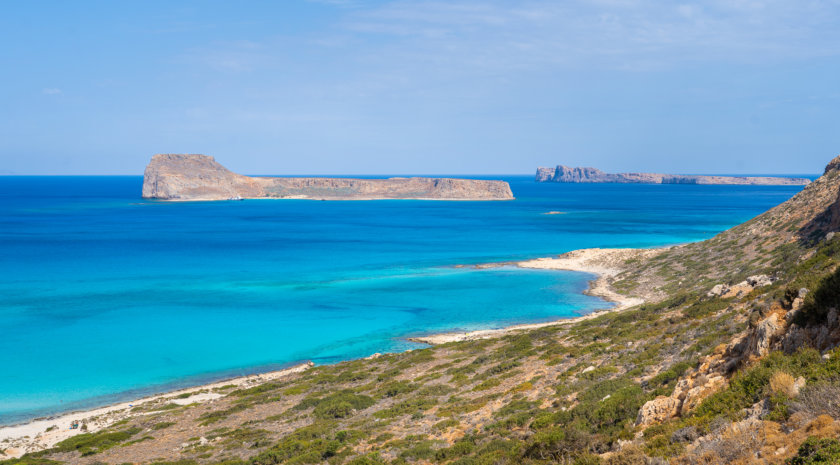
Throughout your trip, you will have the opportunity to enjoy several activities in Crete.
And I’ll start with my favourite activity, a quad bike safari to discover the traditional villages and beautiful mountain landscapes.
The best way for an authentic experience of Crete, far from the classic tourist circuits. For me, this is the best quad bike trip in Crete!
For a quad bike trip from Georgiopoulis , you must book in advance by clicking on the green button:
For a departure from Rethymnon (with an English-speaking guide!), here you go:
Here is a list of the main activities offered in various places on the island (click on the orange links to access details and make your reservation).
We’ll start with water activities/activities to do in Crete:
- 3 hour cruise with swimming stop from Chania
- Cruise on a pirate boat from Rethymnon – Also available at sunset by clicking here!
- Scuba diving with an English-speaking instructor in Heraklion – Also available in Chania
- Diving adventure for certified divers
- Paddle boat outing with an instructor + snorkelling around Chania
- Snorkelling trip with an English-speaking instructor in Heraklion
- Sea kayaking from Bali beach
- Sea kayaking in Elounda
- Sea kayaking from the magnificent Elafonissi beach
- Canyoning in Kalami gorge in South Crete – Canyoning in Portela gorge, in Viannos, South Crete – Canyoning in Seitan Limani near Chania
- Coasteering, with cliff-jump and zipline , not far from Matala
- A day at the Acqua Plus water park in Heraklion – For a family holiday in Crete!
- A day at the Limnoupolis water park with transport included from Chania or Rethymnon
- Jet ski rental in Heraklion
- Parasailing in Heraklion
- Surfing lessons
- Windsurfing lessons in Elafonissi
And here is my selection of the best land/sports activities:
- Safari by Land Rover on the Lassithi plateau with an English-speaking guide
- Land Rover safari in the White Mountains with a visit to a vineyard and an olive oil production workshop
- Jeep trip to Preveli beach from Heraklion and Rethymnon
- Buggy trip from Rethymnon
- Paragliding at Chania
- 2-hour horse ride with lunch or dinner included, near Heraklion
- Guided tour of the old town of Chania by Segway
- Guided tour of the old town of Rethymnon by Segway
- Guided tour of Heraklion on electric bikes
- Climbing session in South Crete
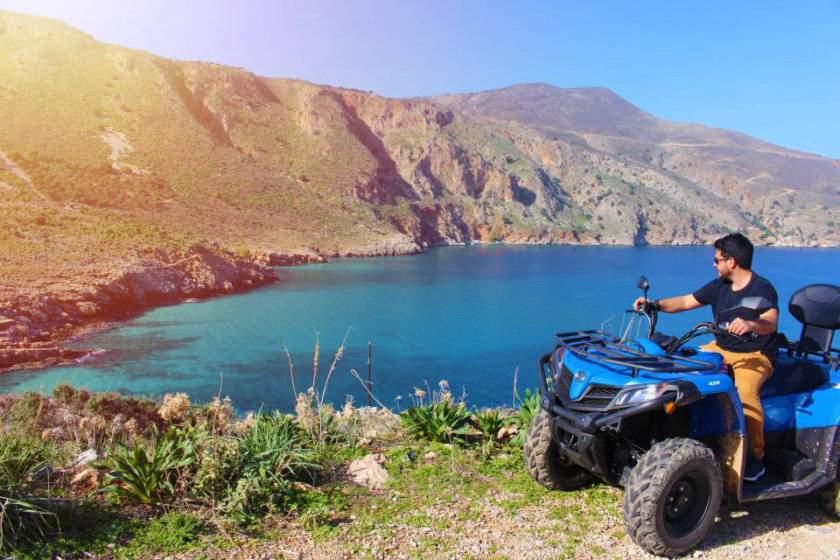
On your trip to Crete, you will have the opportunity to visit many traditional Cretan villages.
You should not expect charming white façades with blue shutters typical of the Cycladic islands like Santorini or Naxos for example, but more to mountain village houses made of stone.
One of the best known villages of Crete is Margarites . Nicknamed the potters’ village, there are several workshops and shops selling bowls, dishes and other terracotta objects.
And a piece of advice: you’d better rent a small car to drive around the narrow streets.
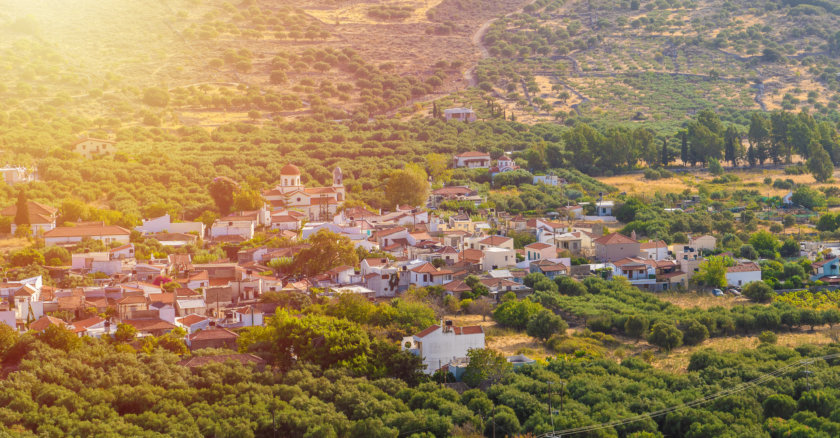
To taste the best Cretan cuisine, there’s no doubt, you have to eat in the small taverns.
They have often been run by the same family for generations and offer simple but tasty traditional cuisine.
You will always be greeted very warmly and at the end of your meal, you will be offered a small dessert and of course a glass of raki, the traditional Cretan alcohol.
Here are some examples of the culinary specialities that you should definitely try in Crete:
- Pastitsio: pasta and meat gratin, the equivalent of lasagne
- Stifado : rabbit stew with small onions and shallots
- Mezze , the Cretan version of the tapas: tomato/feta bread, tzatziki, stuffed vine leaves, meat or fish croquettes, fried zucchini flowers. Some taverns in Crete offer “Mezze” platters.
- Apaki, pork meat marinated and smoked and flavoured with local herbs
- Fish and seafood
- Keftedes: succulent, spicy meatballs
- Antikristo or “ofto” lamb, lamb slow-cooked on a spit – Some taverns also offer pork.
- Souvlakis and gyros: a pita served with chicken, pork or lamb, yoghurt sauce, salad, tomatoes, onions and chips. We tried many of these dishes and each tavern adds its own personal touch, so it never tastes exactly the same.
- Kaltsoúnia: cheese-stuffed pastries
- Raki, a traditional Cretan alcohol, served as a liqueur after every meal.
To discover all the secrets of traditional Cretan cuisine, you can also opt for a cooking class:
- Cooking classes in the traditional village of Arolithos , towards Heraklion
- Cooking lessons in the White Mountains – Pick up from Chania included.
Crete also produces excellent wines, olive oil and delicious cheeses.
If you would like to visit the vineyards, an olive oil factory and of course wine tastings, you must book this visit from Chania: Day focused on wine and olive oil.
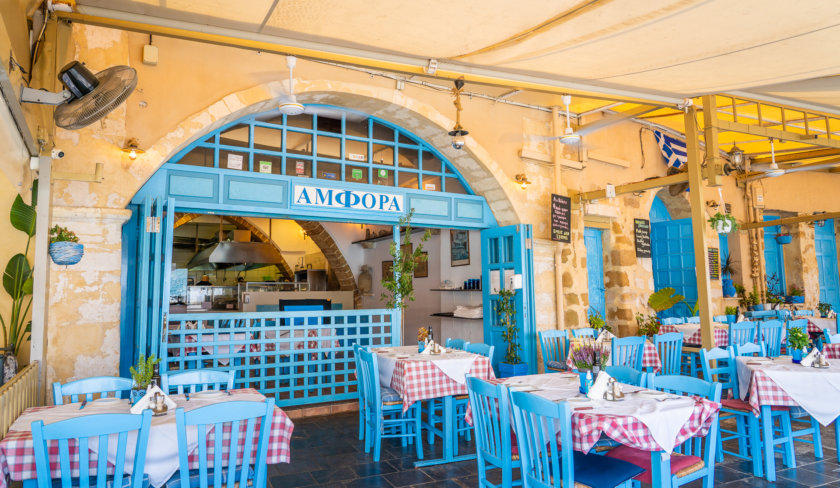
To help you visualize the island a bit better, I have created this tourist map of Crete , with all the places to visit and things to do in Crete.
You can display the map legend by clicking on the top left button, the one with a small arrow on it.
On Voyagetips.com , I give you all my best tips and itineraries to plan your trip to Crete by yourself. (All my Crete guides are here)
However, if you prefer to book a Crete tour with a travel agency , I recommend you to check the 10 best Crete tours by clicking the button below:
If you want to rent a boat for a nice day at sea during your stay in Crete, you should book it with Samboat.
Motorboats, sailboats, yachts, small boats without a license, with or without a skipper: they simply have the most complete offer for boat rental!
So, what are you waiting for to book your boat trip in Crete? 😊
What are the places of interest that you would like for your trip to Crete?
Discover all my articles about Crete : All my articles to help you plan your trip to Crete are listed there.
- 27 Best things to do in Crete : All the best places to visit and activities
- Road trip to Crete: The best itineraries for 5, 7, 10 and 15 days
- Chania : The 15 best places to discover
- Heraklion : TOP 13 places to visit
- Rethymnon: The 13 best things to do
- Balos Beach : All my best tips to visit Balos Lagoon!
- Elafonissi Beach : The definitive guide to discover Crete’s famous pink sand beach
- Palace of Knossos: The definitive guide to visit the most famous archaeological site of Crete
- Samaria Gorge : How to plan the best hike in Crete
- Where to stay in Crete? The guide to the best hotels, ordered by city and budget
You’re using Pinterest? Here is the picture to pin!
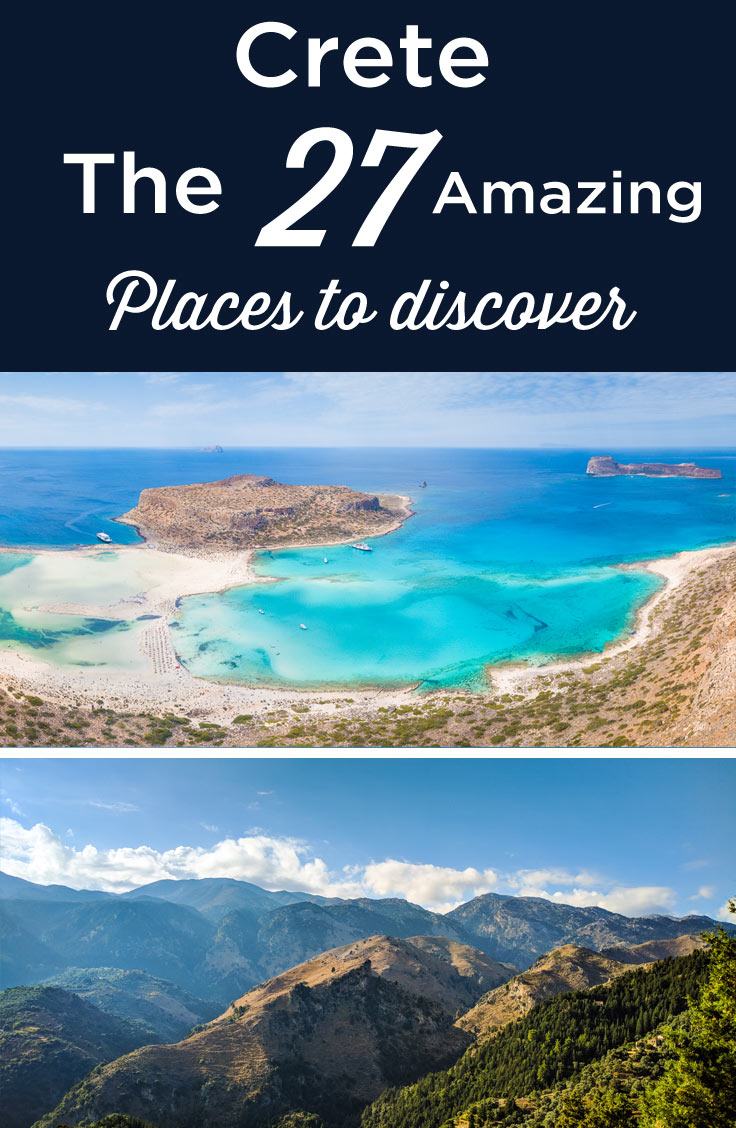
Creator of the Voyage Tips blog, travel and photography lover. I give you all my best tips to plan your next trip.
Related Stories
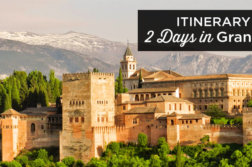
2 Days in Granada: The Perfect Itinerary (First Time Visit)
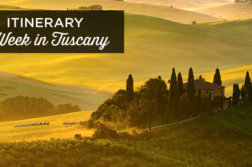
One week in Tuscany: Epic 6-7-8 Day Itinerary (First Time Visit)
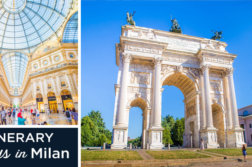
4 days in Milan: the perfect Itinerary (first time visit)
Leave a reply cancel reply.
Your Name (required)
Your Email (required)
Your Website (optional)
Save my name, email, and website in this browser for the next time I comment.
- Middle East
- North America
- Cheap car rentals: my best advice
- Back to Homepage

Greek Tourism 2022 Statistics
The Greek Tourism 2022 Statistics by the Institute of the Association of Greek Tourism Enterprises includes the profile of the largest foreign markets for Greek tourism, namely Germany, the United Kingdom, France, the USA and Italy.
German tourists vote for Crete
The market share of the German market in terms of arrivals for 2021 amounted to 20.4%, while the most popular destinations were Crete, the South Aegean and Central Macedonia.
Collections in the period 2016-2019 showed an increase of 39.0% (from € 2.1 billion in 2016 to € 3.0 billion in 2019), while on the contrary in the period 2019-2021 a decrease of 21.7% (to € 2.3 billion). The share of the German market in 2021 in terms of receipts amounted to 22.4%.
At the same time, the Average Capital Expenditure (ACP) for the German market in the period 2016-2019 increased by 8.4% (from € 678.0 in 2016 to € 734.8 in 2019), while in the period 2019- 2021 the increase amounted to 5.0% (to € 771.7).
The average expenditure of the English is high
The most popular destinations for UK tourists to Greece in 2021 were the South Aegean, the Ionian Islands and Attica. With reference to overnight stays, in the period 2016-2019 there was an increase of 14.2% (from 26.6 million in 2016 to 30.3 million in 2019), while in the period 2019-2021 there was a decrease of 46.8% (in 16.1 million).
The Average Per Capita Expenditure in the period 2016-2019 increased by 9.1% (from € 671.7 in 2016 to € 732.8 in 2019), while in the period 2019-2021 it increased by 25.7% (to € 921 ,2). The TDI of tourists from the United Kingdom in 2021 was 31.2% higher than that of the country as a whole (€702.4).
Strong seasonality from the French market
Inbound tourism from France in the period 2016-2019 saw an increase of 17.4% (from 1.3 million in 2016 to 1.5 million in 2019). In the period 2019-2021, arrivals from France recorded a decrease of 23.8% (to 1.2 million). The market share of the French market in inbound tourism in 2021 was 8.0%, when in 2016 it was 5.3% and in 2019 it was 4.9%.
The Greek Tourism 2022 Statistics most popular destinations for tourists from France to Greece in 2021 were the South Aegean, Crete and Attica.
In terms of overnight stays, in the period 2016-2019 there was an increase of 11.9% (from 11.6 million in 2016 to 12.9 million in 2019), while in the period 2019-2021 a decrease of 12.9 % (to 11.3 million).
Receipts from France showed an increase of 22.6% (from € 889 million in 2016 to € 1.1 billion in 2019), while on the contrary in the period 2019-2021 a decrease of -9.0% (to € 992 million).
The Americans tourists
Inbound tourism from the USA registered an increase in the period 2016-2019 by 51.4% (from 779 thousand in 2016 to 1.2 million in 2019). Collections in the period 2016-2019 showed an increase of 63.3% (from € 728 million in 2016 to € 1.2 billion in 2019), while on the contrary in the period 2019-2021 a decrease of 49.8% (to € 596 million). The share of the American market in 2021 in terms of receipts reached 5.8%, when in 2016 it was 5.7% and in 2019 it was 6.7%. The majority of receipts for 2021 were recorded in Q3 (69.4%), while the corresponding figures for Q1, Q2 and Q4 were 0.3%, 10.0% and 20.4%.
Rise in receipts from Italians
The most popular destinations for tourists from Italy to Greece were the South Aegean, the Ionian Islands and Crete. In 2019, 12,609 thousand overnight stays were recorded (+8.7% compared to 2016, 11.6 million). On the contrary, in the period 2019-2021 there was a decrease of -44.1% (to 7.0 million).
Receipts from Italy in 2019 reached €1,009m (+39.7% compared to 2016) with a market share of 5.7%, when in 2016 the total receipts were €722m with the same share.
- Privacy Policy
- P.O.Box 14527
Financial Service
- Corporate Taxation
- Company Incorporation
- Industrial Business
Hospitality
- Development and Consulting
- Lease of Hotel Assets
- Hotel management
- Sales and Marketing
- Buy - Sell property
- Individual tax
- Golden Visa in Greece
Investment Management
- Asset, Property Management
- Residential Sales
- Acquisitions & Dispositions
- Development
- Integrated Facilities Management
- Grec Insider
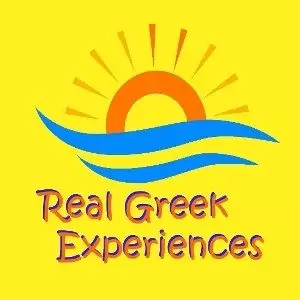
Real Greek Experiences
Greek Culture, Travel Information, Itineraries, Life in Greece
2023 Record-Breaking Tourist Season In Greece
Despite the ongoing challenges, the 2023 tourist season in Greece concludes on a positive note, and a new record in tourist numbers.
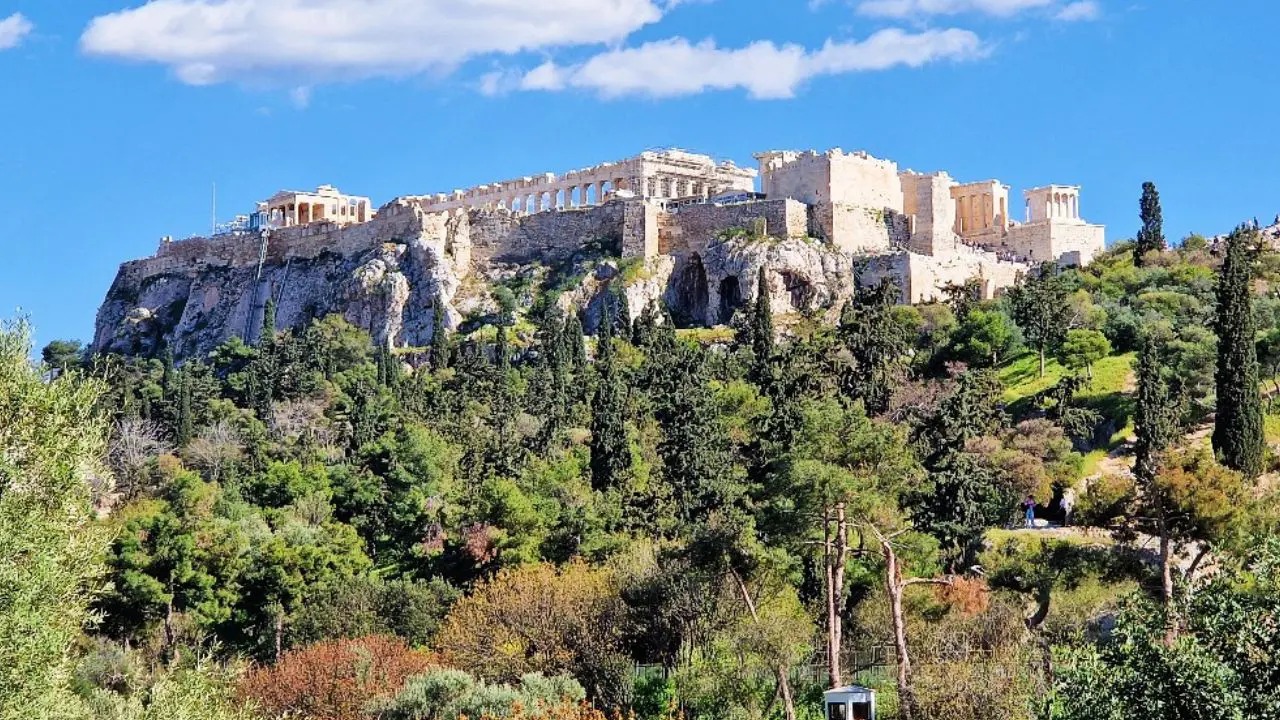
The 2023 tourist season in Greece wraps up with great success
Despite facing numerous challenges, the 2023 tourist season in Greece will conclude on a high note.
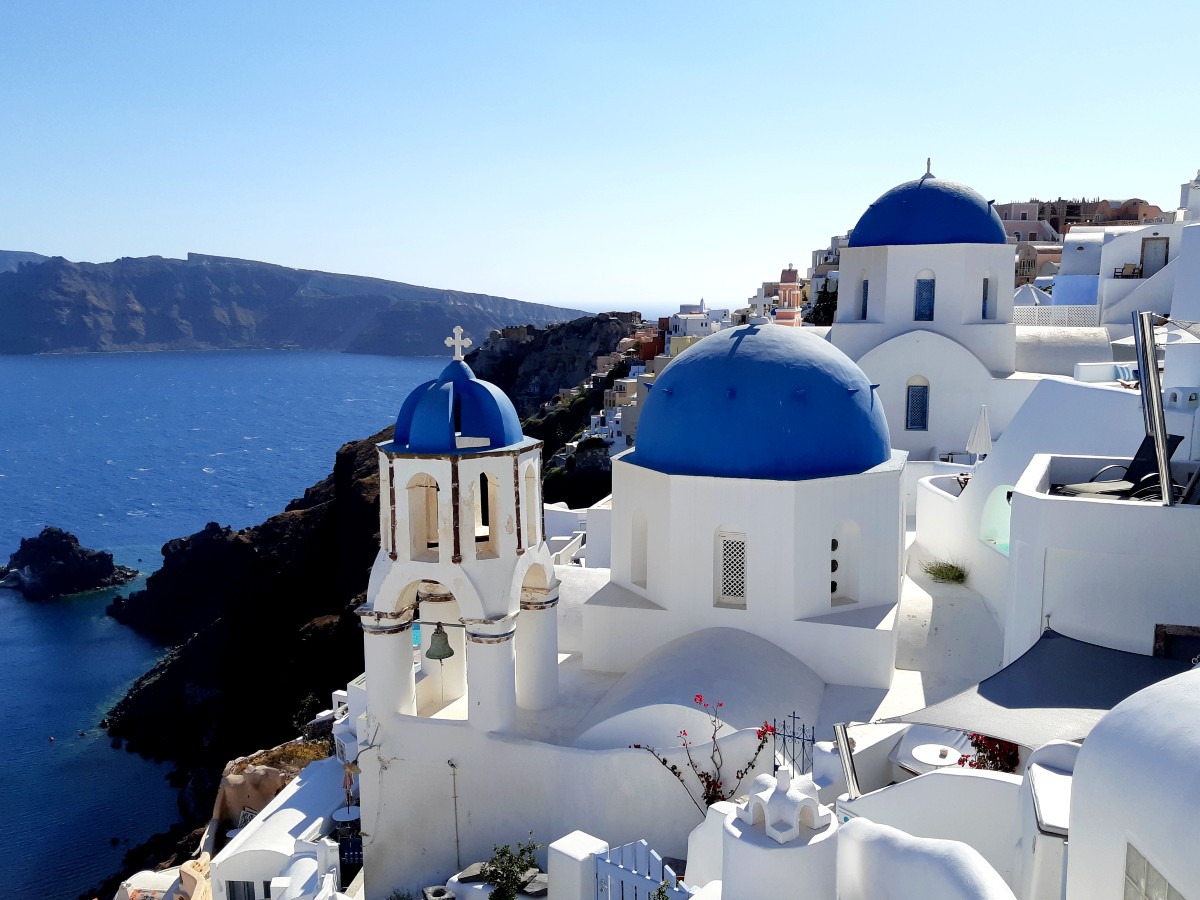
This year, certain major tour operators have chosen to extend their programs this year. As a result, a few prominent hotels, primarily located in Crete and Rhodes will remain operational until mid-November.
In 2023, the tourism season in Greece kicked off with very high expectations. Last year’s great recovery after COVID, in combination with an excellent start of the season, led to a lot of excitement and optimism in the tourism industry.
Indeed, the 2023 season commenced in February, witnessing the arrival of predominantly German tourists in the Peloponnese. They were all eager to indulge in a round of golf at the magnificent Costa Navarino courses .
In early March, TUI encouraged travelers to quickly secure their holiday bookings in Greece, as 50% of hotel rooms in various destinations have already been reserved.
Around mid-March, hotels and local authorities in Crete, Rhodes , Corfu , Santorini , Halkidiki and other areas started welcoming their first guests, who came primarily from European countries.
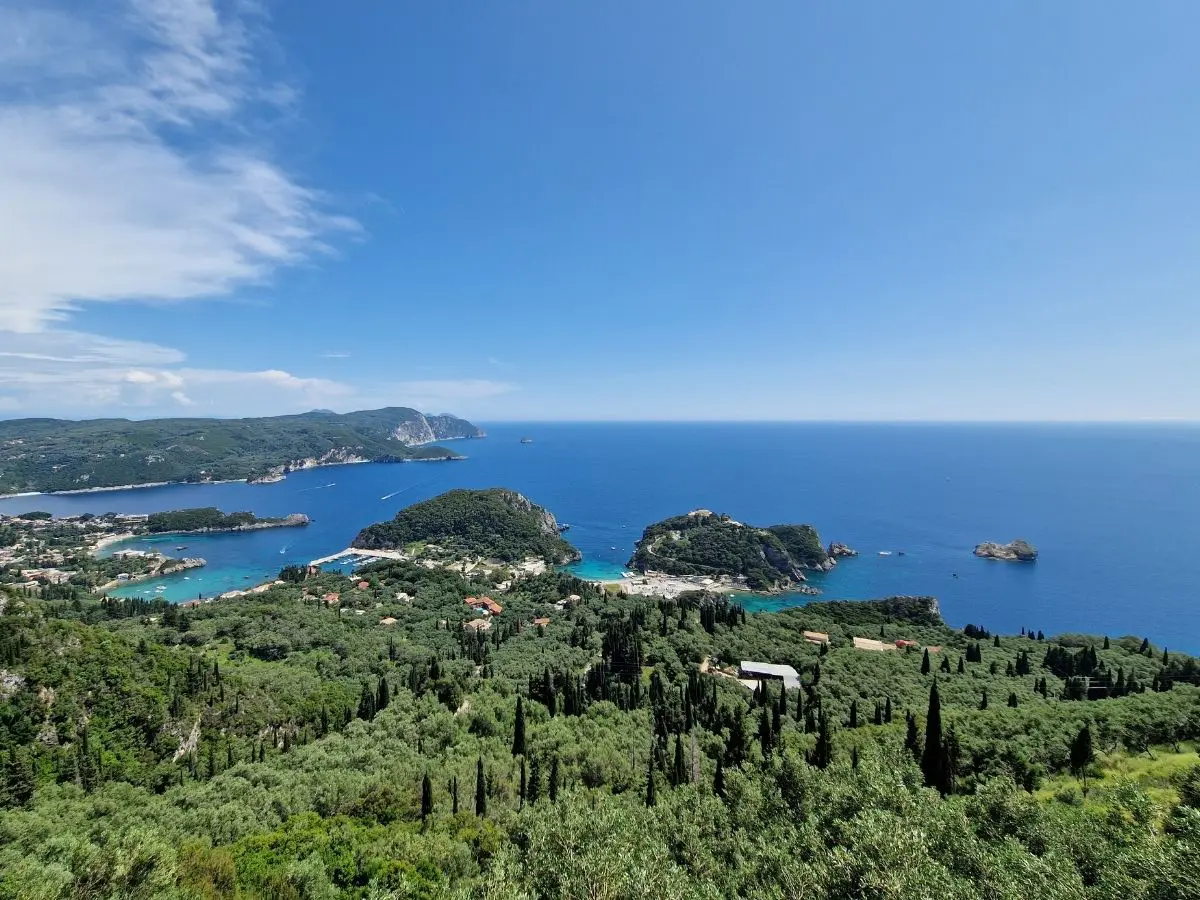
As we moved into mid-April and May, an increasing number of smaller hotels and rooms to let in major destinations, such as the Cyclades , opened their doors to visitors.
A promising start, but a disappointing follow-up
The celebration of Catholic and Greek Orthodox Easter drew numerous foreign tourists to our country, enriching their holiday experience and contributing to increased traffic in April.
However, the month of May proved to be a disappointment for hoteliers nationwide, defying expectations and abruptly bringing the April season to a halt. Hotels in nearly every destination experienced moderate occupancy rates and a lack of anticipated last-minute bookings.
There were multiple factors contributing to this, including the significant rise in airfare prices and the increase in rates for Greek hotels. As a result, the cost of organized packages surged by up to 30%.
Despite the record arrivals reported by the country’s airports, hoteliers, catering services, and trade were left unsatisfied. The “pie” is now divided among many, as there has been a significant increase in both hotel beds and AirBnB accommodations.
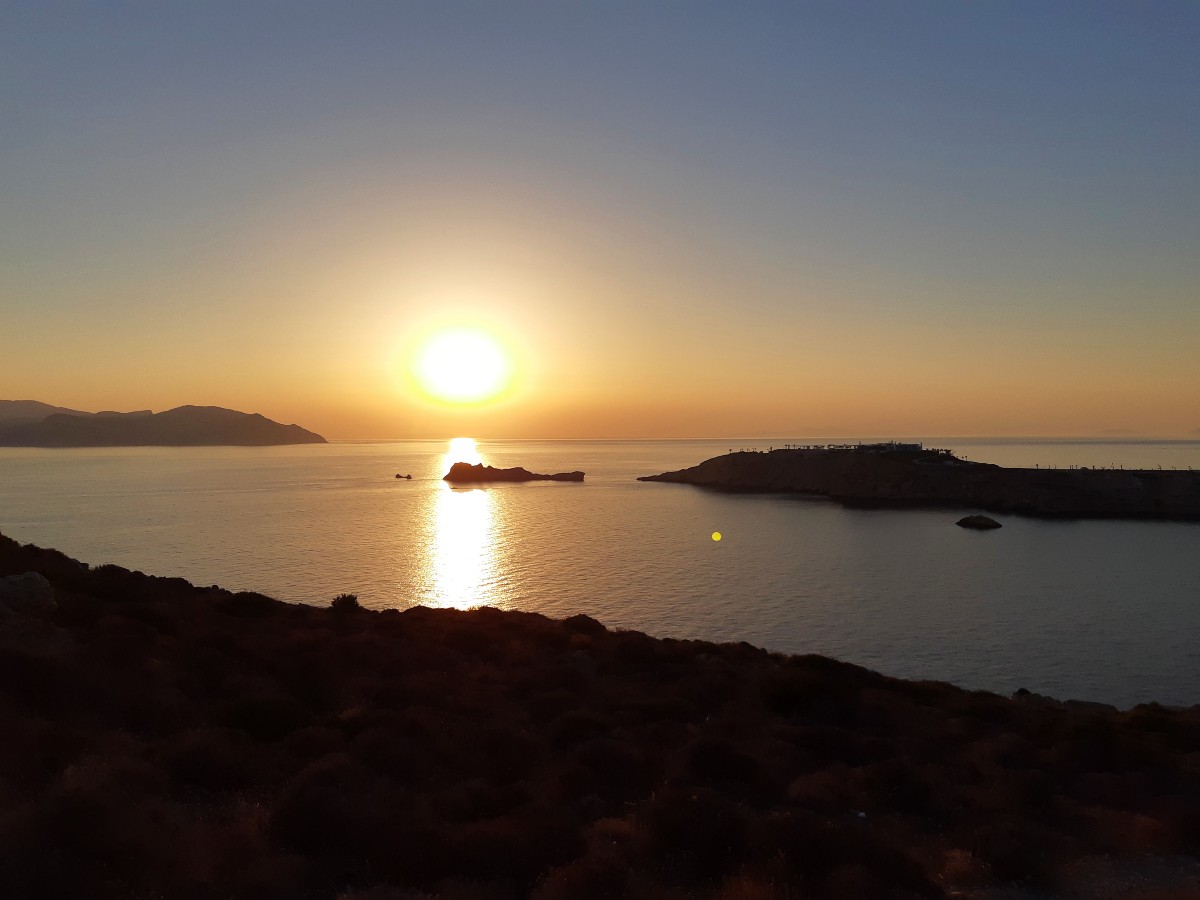
Additionally, foreign tourists did not spend as extravagantly as they did in 2022, but rather showed moderation.
Late June was a turning point for tourism
Starting in June, hoteliers nationwide launched sales and promotions to attract last-minute bookings for the remaining summer season.
The first weeks of June were plagued by unpredictable weather, which posed additional challenges. Fortunately, the last ten days of the month marked a turning point, bringing some much-needed stability to the industry.
The following months showed a positive trend, as nearly all tourist destinations experienced a rise in foreign visitor numbers. The cruising industry, in particular, witnessed a significant surge.
However, this growth has brought increased scrutiny to popular ports like Mykonos and Santorini . The high volume of disembarking passengers has put a strain on public infrastructure and inconvenienced visitors staying on the islands.
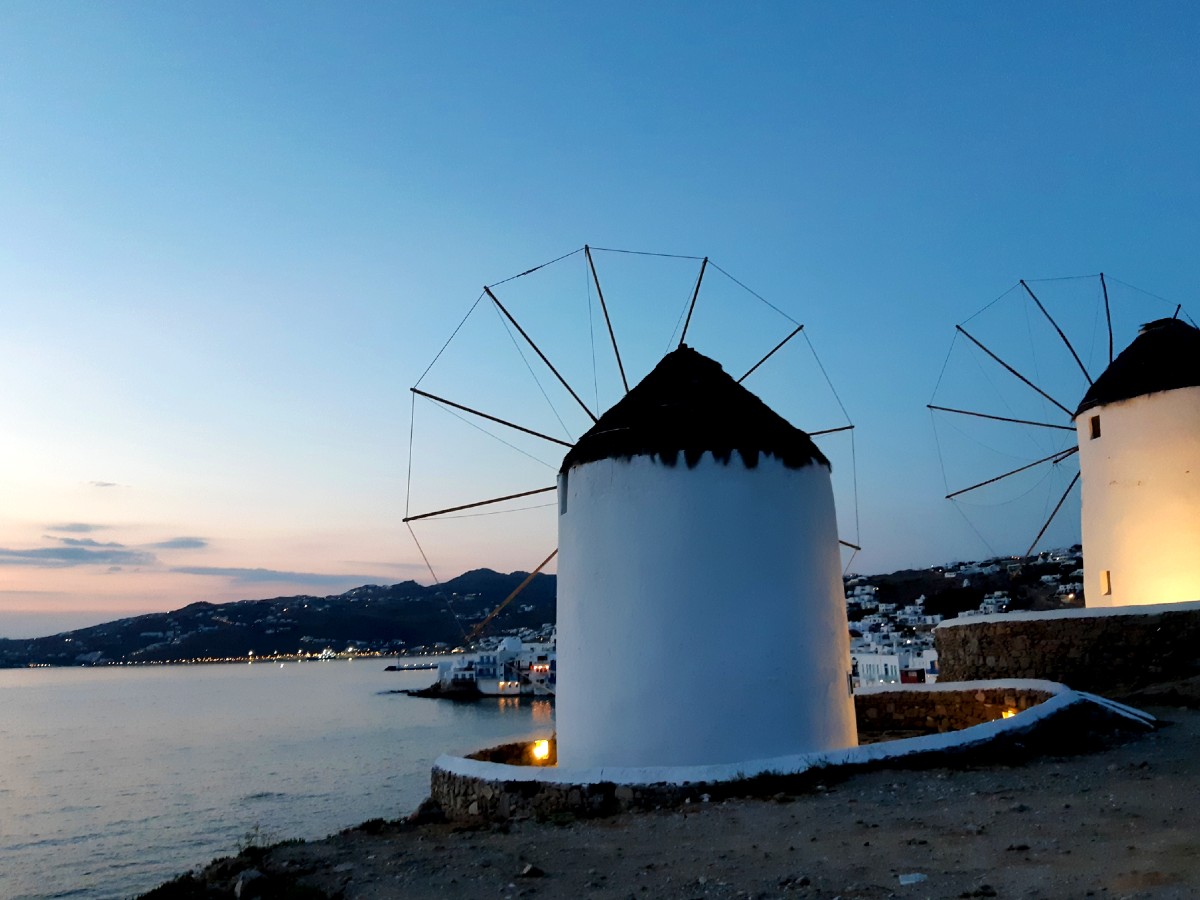
Unprecedented numbers of arrivals in 2023
Based on the data collected until September, Greece has been steadily approaching the number of international air arrivals recorded in 2022. This doesn’t take into account the official figures for October, which have not been released yet.
By the end of September, Greece has already welcomed a staggering 21 million tourists, almost reaching the total arrivals of 21.3 million recorded in 2022.
So, even if air arrivals in the last quarter of 2023 return to levels seen in the previous year, Greece is on track to set an all-time record , with over 23.5 million tourists arriving via air travel.
Meanwhile, road tourism is displaying notable signs of recovery after experiencing a steep decline in the previous year. While it may not reach the levels seen in 2019, when it surpassed 12 million tourists, the optimistic trend is certainly encouraging.
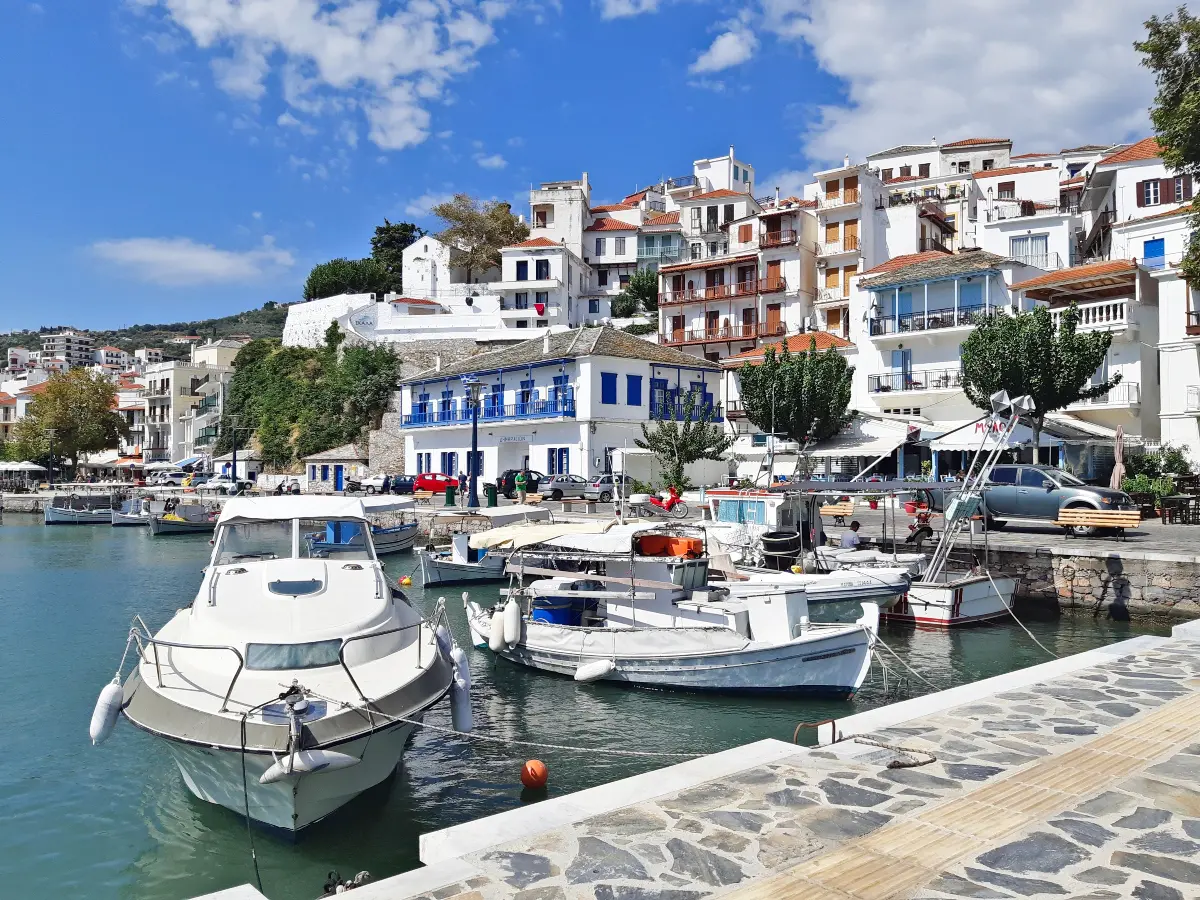
This trend highlights the growing momentum and positive trajectory of Greece’s tourism industry, a remarkable achievement considering all circumstances.
Record-breaking earnings
In terms of tourism earnings, the Bank of Greece’s figures for the first eight months of 2023 appear to support the initial estimates, which projected over 20 billion euros.
From January to August 2023, travel earnings saw a notable increase of 15.3% compared to the same period in 2022, reaching a total of 14.6 billion euros.
With four months remaining to be accounted for, optimistic estimations suggest further growth.
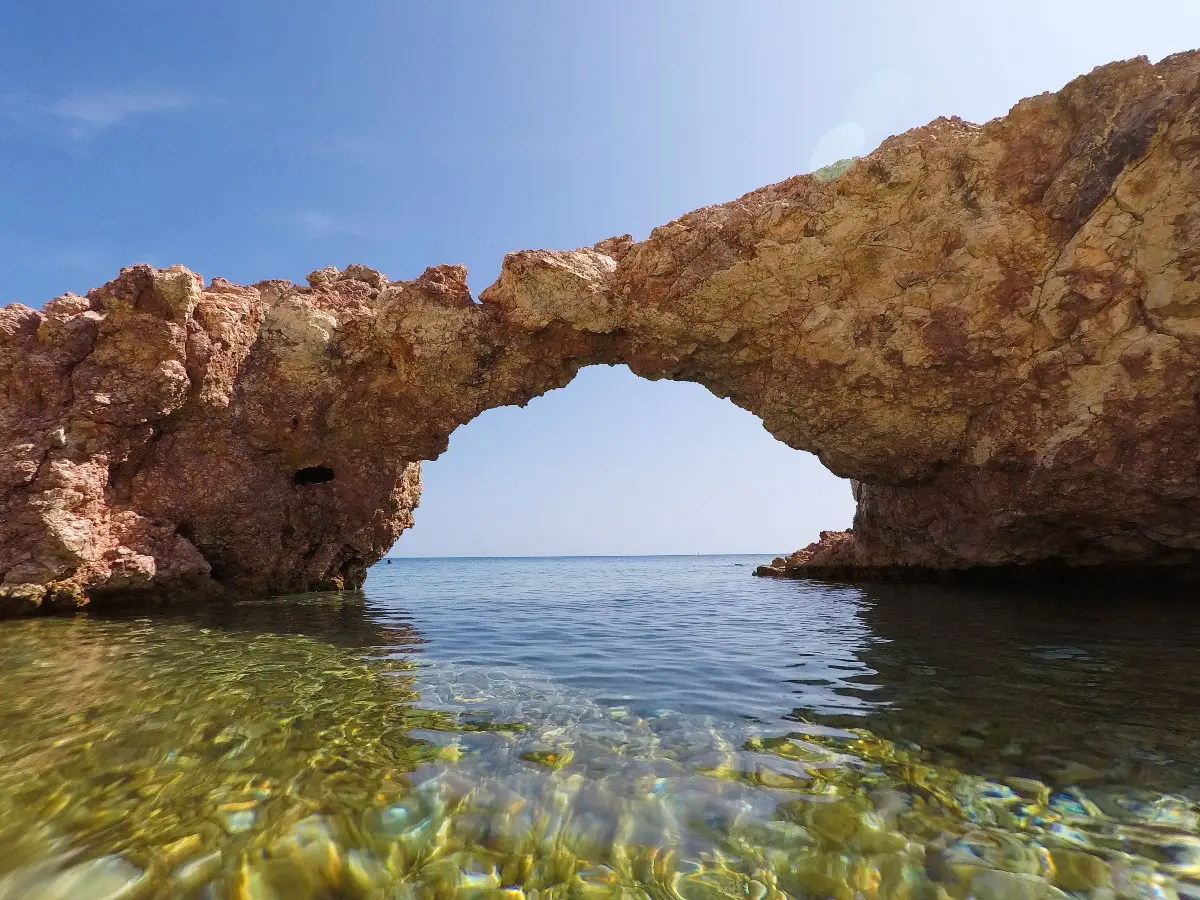
The winners and losers of the season
According to the data, Athens has emerged as the top-performing destination this season. The Greek capital is rapidly establishing itself as a sought-after destination, with Eleftherios Venizelos International Airport reporting monthly double-digit growth in international passenger traffic.
Thessaloniki emerges as the second top-performing destination, boasting a remarkable 20% surge in passenger traffic from abroad between January and September. Notably, Kavala and Mytilini also experienced significant double-digit growth.
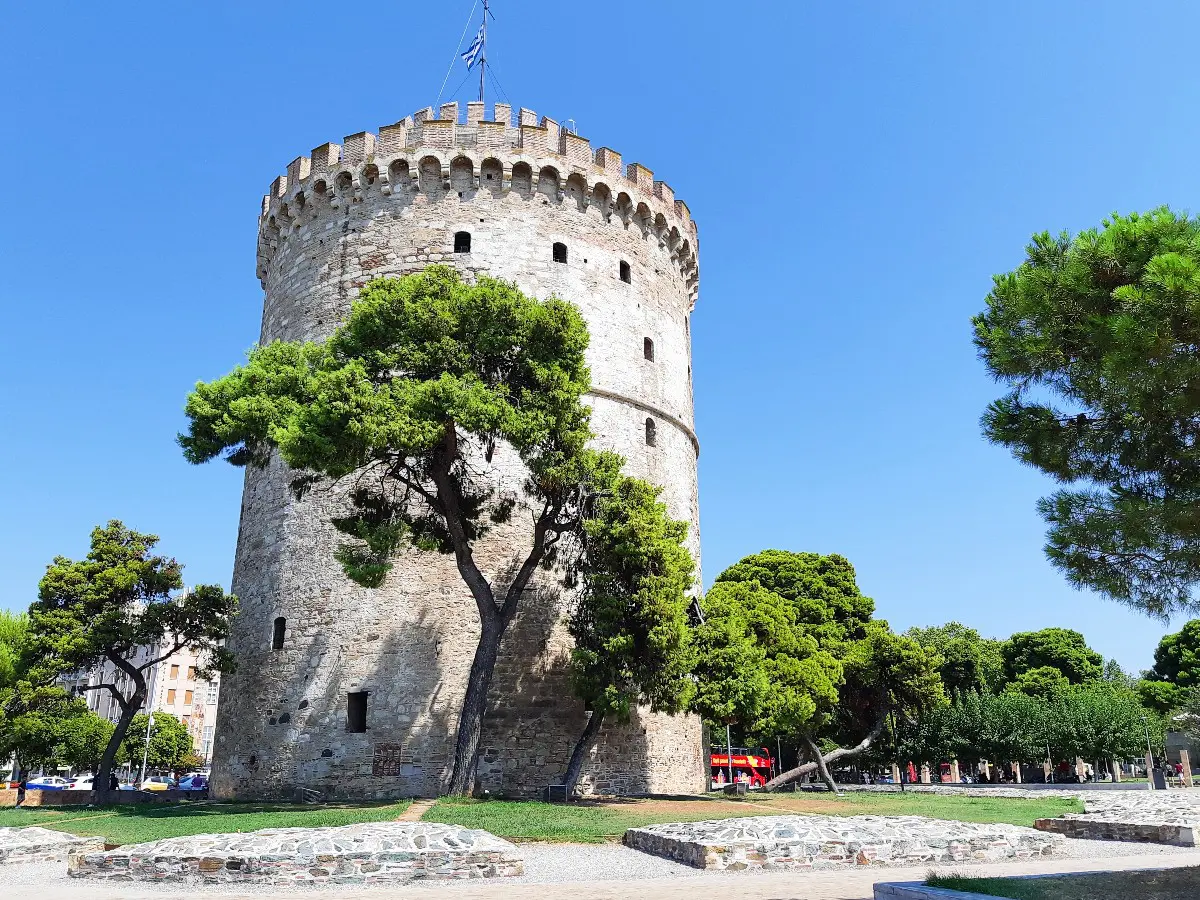
Corfu witnessed a commendable increase of over 8%, while Chania saw nearly 8% growth. Kos and Heraklion exhibited more modest yet positive performance, with a 5.5% and 5% increase, respectively.
Despite the huge challenges posed by the devastating forest fires in July, Rhodes concluded the list with a growth rate of 2%.
Following the remarkable surge they witnessed in 2022, Santorini and Mykonos experienced a decrease in tourist arrivals this year. However, it is important to note that the decline only amounts to a few thousand tourists for each destination.
Let’s see what 2024 brings!
Related article: Overtourism in Athens

1 thought on “2023 Record-Breaking Tourist Season In Greece”
As a Greek American, thanks for the info and Greece deserves a great break from all they have been through with the refugees!
Leave a Comment Cancel reply
Save my name, email, and website in this browser for the next time I comment.
Crete Travel Guide
Book your individual trip , stress-free with local travel experts
- roughguides.com
- Travel guide
- Itineraries
- Local Experts
- Travel Advice
- Accommodation
Crete (Kríti) is a great deal more than just another Greek island. In many places, especially in the cities or along the developed north coast, it doesn’t feel like an island at all, but rather a substantial land in its own right. Which of course it is – a precipitous, wealthy and at times surprisingly cosmopolitan one with a tremendous and unique history. At the same time, it has everything you could want of a Greek island and more: great beaches, remote hinterlands and hospitable people.
Brief history
Adventure sports, wine tasting in crete, festival island, ecotourism in crete, central crete, eastern crete, réthymnon and around, western crete, reconstruction of the palace, the archaeological site, the legend of the minotaur, the samariá gorge.
With enough land for agriculture (and some surprisingly good vineyards), it’s one of the few Greek islands that could probably support itself without visitors. Nevertheless, tourism is an important part of the economy, particularly exploited along the north coast, where many resorts cater almost exclusively to rowdy young revellers lured by thumping bars and cheap booze. The quieter, less commercialized resorts and villages lie at either end of the island – west, towards Haniá and the smaller, less well-connected places along the south and west coasts, or east around Sitía. The high mountains of the interior are still barely touched by tourism.
Of the cities, sprawling Iráklion often gives a poor first impression of the island but is well worth a visit for its excellent archeological museum. It’s also close to the fabulous Minoan sites of Knossos, Phaestos and Ayía Triádha to the south (with Roman Gortys to provide contrast). Further east, the upmarket resort of Áyios Nikólaos provides sophisticated restaurants and hotels, while quiet, lazy Sitía is a perfect base for exploring the eastern coastline. Heading west, Réthymnon boasts a pretty old town and an excellent beach, though Haniá in the extreme west arguably beats it in terms of style and atmosphere. South of here is the Samariá Gorge, one of the best hikes in the country.
In terms of climate, Crete has by far the longest summers in Greece, and you can get a decent tan here right into October and swim at least from May until early November. The one seasonal blight is the meltémi, a northerly wind, which regularly blows harder and more continuously here than anywhere else in Greece – the locals may welcome its cooling effects, but it’s another reason (along with crowds and heat) to avoid an August visit if you can.
Tailor-made travel itineraries for Greece, created by local experts

10 days / from 2657 USD
The Historical and Mythological Cyclades islands
The Cyclades islands include two of the most famous Greek Islands: Mykonos and Santorini. Visit these and some of the smaller, quieter, islands. With white washed houses, narrow cobbled streets, blue domed roofs and stunning beaches, they are what Greece is all about.

9 days / from 2246 USD
A secluded villa stay on Mainland Greece
Stay in a secluded private villa with magnificent views to the sea and explore this beautiful corner of Mainland Greece with your own rental car. Under the impressive Mt Taygetos in Southern Peloponnese, the region of Mani will give you a snapshot of authentic Greece.

10 days / from 2030 USD
Along the Coast of Crete: from Heraklion to Platanias
As Greece's largest island, Crete's culture and atmosphere is distinctly different from mainland Greece. Thousands of years of unique culture and rich history complement the island's untamed natural beauty. Explore Crete at your own pace with this unique self-drive trip!
Tailor-made trips for Greece
Crete is distinguished above all as the home of Europe’s earliest civilization, the Minoans. They had a remarkably advanced society, and formed the centre of a maritime trading empire as early as 2000 BC. The island’s strategic position between east and west has since continued to play a major role in its history. Control of the island passed from Greeks to Romans to Saracens, through the Byzantine empire to Venice, and finally to Turkey for more than two centuries. During World War II, Crete was occupied by the Germans and attained the dubious distinction of being the first place to be successfully invaded by paratroops.
With its temperate climate and varied topography Crete is a great place for adventure holidays, and there are numerous companies across the island offering everything from mountain biking and canyoning to trekking and horseriding. Here’s a selection of what’s on offer.
Climbing/adrenaline sports
- Liquid Bungy White-knuckle bungee jumping (Europe’s second highest) at the Arádhena Gorge, Haniá.
- Trekking Plan Rock climbing, mountaineering, canyoning, rappelling, kayaking and mountain biking in Haniá province.
Horseriding
- Melanouri Horseriding holidays (one to seven days) from a stable near Mátala.
- Odysseia One- to six-day guided and unguided horse treks from their base at Avdhoú near the Lasíthi Plateau.
- Zoraïda’s Horseriding Horseriding holidays and treks from their stables in Yeoryoúpoli, Haniá.

Walking and cycling
- Alpine Travel Hiking, rock climbing, sea kayaking and biking holidays (or combinations thereof) in Haniá province.
- Cretan Adventures Hiking, horseriding and jeep safaris throughout Crete.
- The Happy Walker Walking tours from one day to two weeks from €30 (for the day-hike which includes minibus from your hotel to start point).
- Hellas Bike One- to seven-day bike tours from Ayía Marína in Haniá province.
Hiking and climbing holidays in central, southern and western Crete.
- Olympic Bike Guided bike tours from €139 for three one-day trips, or bike rental only from €20 per day.
- Strata Walking Tours Guided trekking holidays in the Kastélli Kissamou area of Haniá.
As well as the large Péza region near Knossos and the ancient vineyard at Vathýpetro, there are also vineyards in eastern Crete, around Sitía, another major producer, and smaller vineyards in the west around Haniá. The main grape varieties grown on the island are the white Vilana and the red Mantilari, Kotsifari and Syrah grapes. Wine tasting and cellar tours can be undertaken during the summer months.
The Cretans love a glendi (party) and festivals are celebrated with plenty of eating, drinking, live music and dancing. Here are some of those which celebrate local harvests (check locally for specific dates):
- Chestnut Festival Élos and Prásses, West Crete, end of October. The village squares are packed with tables and chairs as the villages celebrate the local chestnut harvest with eating, drinking, dancing, and roast chestnuts, of course.
- Sardine Festival Néa Hóra, Haniá. The first Monday in September is the date for this annual festival at the small harbour by the town beach, with plentiful free fish and wine with local musicians and dancers.
- Sultana Festival Sitía, in August. The region is well known for its sultana production, and the harvest is celebrated with traditional Cretan music and dance in the main square, accompanied by food and wine.
- Tsikoudiá (Raki) Festival Haniá, Iráklion and Voukoliés, mid-October and early November. At the end of the grape harvest the must-residue from the wine press is boiled and distilled to make tsikoudiá, the local fire water. Hot tsikoudiá, with an alcohol content as high as 60 percent, is scooped from the vats and proffered in shot glasses, and so the merriment begins.
Crete has an incredibly diverse landscape, flora and fauna, and a number of environmentally aware locals have set about preserving its natural and cultural heritage. A range of retreats and lodges has sprung up across the island, offering the chance to experience sustainable, eco-friendly living and participate in everything from hiking to making the local firewater tsikoudhiá.
The hub of central Crete is the capital city, Iráklion, a busy but convenient base for visits to the nearby Minoan palace of Knossos. The area immediately around the city is less touristy than you might expect, mainly because there are few decent beaches of any size on the adjacent coast. To the west, mountains drop straight into the sea virtually all the way to Réthymnon, with just two significant coastal settlements: Ayia Pelayia, and the more attractive Bali. Eastwards, the main resorts are at least 30km away, at Hersónissos and beyond, although there is a string of rather unattractive developments all the way there. Inland, there’s agricultural country, some of the richest on the island, a cluster of Crete’s better vineyards and a series of wealthy villages. To the south lie the sites of Gortys, Phaestos and Ayía Triádha which can all be visited in a day, with a lunchtime swim on the south coast at Mátala or Léndas thrown in.
Crete’s biggest city, IRÁKLION (Heraklion) is a hectic place, a maelstrom of bustle, noise and traffic-congested thoroughfares. On the positive side, though, the city does have superb fortifications, a fine market, atmospheric old alleys and some interesting lesser museums. Virtually everything you’re likely to want to see lies within the northeastern corner of the walled city. The most vital thoroughfare, 25-Avgoústou, links the harbour with the commercial city centre. Further up 25-Avgoústou, Kalokerinoú leads down to Haniá Gate and westwards out of the city; straight ahead, Odhós-1821 is a major shopping street, and adjacent Odhós-1866 is given over to the animated street market, perhaps the best on the island. To the left, Dhikeosínis heads for the city’s main square, Platía Eleftherías, paralleled by the pedestrian alley, Dedhálou, lined with many of the city’s swankier fashion stores and the direct link between the two squares.
Inland from Iráklion
Heading south from Knossos, the zone around Arhánes and Péza is one of Crete’s major wine-producing areas. Nearby are some more Minoan sites at Anemospiliá and Vathýpetro, plus a few diverting villages. The main inland route southwest from Iráklion climbs through the mountains before winding down to Áyii Dhéka and the Messará plain. Here on the Messará, all within a 40km range of each other, lie the three major archeological sites of Phaestos, Ayía Triádha and Gortys. Once you get this far south you’re within a short drive of the coastal resorts of Mátala and (accessed via a mountain road) Léndas.
East of Iráklion: the package-tour coast
East of Iráklion, the main package-tour resorts are at least 30km away, at Hersónissos and Mália, although there is a string of rather unattractive developments all the way there; the merest hint of a beach is an excuse to build hotel and apartment complexes. That said, there are one or two highlights amid the dross, which are well worth a visit: the impressive Cretaquarium at Goúrnes, the old villages in the hills behind Hersónissos, and, beyond the clubbing resort of Mália, a fine Minoan palace that will transport you back three and a half millennia.
Mount Psilorítis
Mount Ida, also now known as Mount Psiloritis, is the highest mountain in Crete, with the highest summit being Timios Stavros. Mount Ida may be the highest mountain on the mystical island of Crete, but only by a mere 3 m, beating Pachnes, the highest summit of Lefka Ori. Mount Ida holds legends that date back to prehistory and makes an ideal landscape for hiking and exploring higher altitudes.
Hiking routes on Mount Ida
The easiest route to the summit is part of the E4 trail starting at the Ideon Andron cave. Beginning in the Nida Plateau at around 1500 metres high, the way to the summit from here is only about 3 hours. The Nida Plateau is on the east side of the mountain and around 15 km from the village of Anogeia, where there is a road in good condition leading from Heraklion.
For more experienced hikers, there is a trail to the summit from the village of Fourfouras or Kouroutes, with an ascent for more than 2000 metres. The trip typically takes around 8 - 10 hours. All trails and routes are marked with dots of coloured paints and the occasional sign, but be sure to take a map with you for safe measure!
Getting to Mount Ida
Heading for the mountains from Anóyia, a smooth road ascends 21km to an altitude of 1400m on the Nídha Plateau at the base of Mount Psilorítis. Here, at the end of the road and opposite the Taverna Nida, is the path up to the celebrated Idean cave (about a 15min walk) and the start of the way to the top of Mount Psilorítis (2456m).
History of Mount Ida
In Greek mythology, Mount Ida is sacred to the Goddess Rhea and holds the legendary Idaean cave in which the Greek God Zeus was supposedly born.
Climbing Mount Psilorítis
Climbing to the summit of Mount Psilorítis, for experienced and properly equipped hikers, is not at all arduous. The route, which diverts from the path to the Idean Cave just beyond a small chapel, forms a stretch of the E4 Pan-European footpath and is marked with the red arrows and the E4 waymarkers. It should be a 6–8hr return journey to the summit, although in spring, thick snow may slow you down. Don’t attempt the walk alone as you could face a very long wait should you run into trouble, and mobile phones may not have a signal in places.
If you’re prepared to camp on the Nídha plateau (it can be very cold), or rent a room at the Taverna Nida, you could continue on foot the next day down to the southern slopes of the range. It’s a beautiful hike and also relatively easy, four hours or so down a fairly clear path to Vorízia where there is no food or accommodation, although Kamáres, 4km west, has both.
Eastern Crete is dominated by Áyios Nikólaos, a small cosmopolitan town and resort, and its close neighbour Eloúnda, the home of luxury hotel and villa complexes, and the gateway to the mysterious islet of Spinalónga. Inland from Áyios Nikólaos, Kritsá with its famous frescoed church and textile sellers and the imposing ruins of ancient Lato make for good excursions. Further inland, the extraordinary Lasíthi Plateau is worth a night’s stay if only to observe its abidingly rural life. Far fewer people venture beyond the road south to Ierápetra and east to Sitía, where only the famous beach at Váï ever sees anything approaching a crowd.
Áyios Nikólaos
ÁYIOS NIKÓLAOS, known simply as “Áyios” to the locals, is set around a supposedly bottomless salt lake, now connected to the sea to form an inner harbour. It is supremely picturesque and has some style and charm, which it exploits to the full. The excellent archeological museum (Tues–Sun 8.30am–3pm; €3) on Paleológou north of the lake, and an interesting Folk Museum (Tues–Sun April–Oct 10am–2pm and 5–7pm; €3) near the tourist office are both worth seeking out. Both the lake and the harbour area are surrounded by charming restaurants and bars.
The small and busy Kitroplatía beach lies just around the southwest corner of the port and is lined with tavernas and cafés, while 1km beyond here, past the marina, lies the much larger, and well-kept, municipal beach. There are further swimming opportunities to the north around Eloúnda, and some great backcountry inland – perfect to explore on a scooter.
Lasíthi Plateau
Scores of daily tour buses visit the LASÍTHI PLATEAU to view the “thousands of white-cloth-sailed windmills” which irrigate the high plain. In fact there are very few working windmills left, although most roadside tavernas seem to have adopted many of those made redundant as marketing features. The drive alone is worthwhile, however, and the plain is a fine example of rural Crete at work, every inch devoted to the cultivation of potatoes, apples, figs, olives and a host of other crops; stay in one of the villages for a night or two and you’ll see real life return as the tourists leave.
SITÍA is the port and main town of the relatively unexploited eastern edge of Crete. It’s a pleasantly scenic, offering a plethora of waterside restaurants, a long sandy beach and a lazy lifestyle little affected even by the thousands of visitors in peak season. The town attracts a number of French, Italian and Greek tourists, and it grows on you, perhaps inviting a longer stay than intended. For entertainment there’s the town beach, providing good swimming, windsurfing and diving. In town there’s a small folklore museum (Mon–Fri 10am–1pm; €2), an excellent archeological museum (Tues–Sun 8.30am–3pm; €2) and a Venetian fort to explore. A colourful weekly market takes place on Tuesdays between 7am and 2pm along Odhós Itanou near the archeological museum.
Island escape: Gaidhouronísi
One way to escape the urban hubbub for a few hours is to take a boat to the island of Gaidhouronísi (aka Donkey Island or Chrissi Island ) some 10km out to sea from Ierápetra. No one seems to know how the 5km-long island got its name as there are no donkeys; instead you’ll find a cedar forest, the fabulous “Shell Beach” covered with millions of multicoloured mollusc shells, some good sandy beaches and a couple of tavernas. Excursion boats (May–Sept daily 10.30am & 12.30pm out, 4pm & 7pm return; €24, under-12s €12) leave from Ierápetra seafront harbour, and you can buy tickets on the boat or at any of the town travel agents in advance. The voyage to the island takes fifty minutes and the boats have an on-board bar.
The province of Réthymnon reaches to Mount Psilorítis in the east and towards the White Mountains in the west. The fertile Amari Valley, with its pretty villages, lies in the central plain, while on the south coast, in particular around Plakiás, there are beaches as fine as any Crete can offer.
Réthymnon itself is an attractive and lively city, with some excellent beaches nearby, although the coastline to the east has seen a great influx of tourists, with the development of a whole series of large hotels extending almost 10km along the beach.
RÉTHYMNON remains one of the most beautiful of Crete’s major cities (only Haniá is a serious rival), with an enduringly provincial air. A wide sandy beach and palm-lined promenade border the old town, a labyrinthine tangle of Venetian and Turkish houses where ancient minarets lend an exotic air to the skyline. Dominating everything from the west is the superbly preserved outline of the fortress built by the Venetians after a series of pirate raids had devastated the town.
Hiking the Amári valley
A good base for touring the Amári valley is Thrónos, a sizeable village at the valley’s northern end with an inviting place to stay, Rooms Aravanes. The proprietor here – Lambros Papoutsakis – is a keen walker and conducts guided treks to the peak of Mount Psilorítis, which at 2456m is Crete’s highest. Although he does guide groups up in the daytime, his preferred approach is during the full moons of June, July and August, which avoids the extreme summer temperatures. Phone in advance for details; it’s not a difficult climb, but you’ll need sturdy footwear and a sleeping bag. The summit is reached at around dawn, and the sunrise is always spectacular: on clear days the mountain offers a breathtaking view of the whole island and its four seas spreading in all directions.
Other hikes from Thrónos include a relatively easy path leading north through the foothills in a couple of hours to themonastery of Arkádhi, while south from Thrónos is an easy stroll on a paved road running back into the main valley via Kalóyerosa. A map detailing these walks is available from Rooms Aravanes.
Crete’s westernmost quarter is one of its least visited, partly because there are no big sandy beaches to accommodate resort hotels, and partly because it’s so far from the great archeological sites. But for mountains, scattered coves and unexploited villages, it’s unrivalled.
The city of Haniá (Chania) is an excellent reason to come here, but the immediately adjacent coast, especially to the west of the city, is overdeveloped and not particularly exciting; if you want beaches head for the south coast or the far west. Here, Paleóhora is the only place which could really be described as a resort, and even this is on a thoroughly human scale; others are emptier still. Elsewhere on the south coast, Ayía Rouméli and Loutró can be reached only on foot or by boat; Hóra Sfakíon sees hordes passing through but few who stay; Frangokástello, nearby, has a beautiful castle and the first stirrings of development. Behind these lie the White Mountains (Lefká Óri) and the famed walk through the Samariá Gorge. In the far west, great beaches at Falásarna and Elafoníssi are mostly visited only as day-trips.
HANIÁ, as any of its residents will tell you, is spiritually the capital of Crete, even if the political title was passed back to Iráklion. It is also the island’s most attractive city, especially if you can catch it in spring, when the White Mountains’ snowcapped peaks seem to hover above the roofs. Although it is for the most part a modern city, you might never know it as a tourist. Surrounding the harbour is a wonderful jumble of Venetian streets that survived the wartime bombardments, while simply wandering the old town you will discover old city walls, Ottoman, Byzantine and Minoan ruins. Restoration and gentrification, consequences of the tourist boom, have made inroads of late, but it remains an atmospheric place.
The southwest coast
The ancient capital of the Sfakiá region, Hóra Sfakíon, lies 70km south of Haniá, reached via a spectacular twisting asphalted road over the mountains. It’s the main terminus for gorge walkers, with a regular boat service west along the coast to Ayía Rouméli and Loutro, which are accessible only by foot or boat. Frangokastello, with its castle fortress and sandy beaches, lies a few kilometres east of Hóra Sfakíon, along the coastal road. Other main routes south over the mountains from Haniá are those to the small town of Paleóhora (from the north-coast highway at Tavronítis) and to the laidback seaside village of Soúyia (via Alikianós on the Omalós road).
KNOSSOS, the largest and most important of the Minoan palaces, and the most visited, lies some 5km southeast of Iráklion. The mythological home of King Minos and the Minotaur, it dates from the second millennium BC, and its vast interconnected rooms and corridors provide a fitting backdrop to the legend.
Knossos itself is considered the oldest city in Europe, dating back to the Neolithic period. The palace was considered the ceremonial and political centre Minoan civilisation until it was abandoned at the end of the Bronze Age for reasons unknown. Now you will find a sacred archaeological site that holds wonder and ancient history.
The discovery of the palace is among the most amazing tales of modern archaeology. Heinrich Schliemann, the German excavator of Troy, suspected that a major Minoan palace lay under the various tumuli here, but was denied the permission to dig by the local Ottoman authorities. It was left for Sir Arthur Evans who excavated and liberally “restored” the palace from 1900 onwards. His restorations have been the source of furious controversy among archaeologists ever since. Even so, his guess as to what the palace might have looked like is certainly as good as anyone’s, and it makes Crete’s other Minoan sites infinitely more meaningful if you have seen Knossos first.
As soon as you enter the Palace of Knossos through the West Court, the ancient ceremonial entrance, it is clear how the legends of the labyrinth grew up around it. Even with a detailed plan, it’s almost impossible to find your way around the complex with any success, although a series of timber walkways channels visitors around the site, severely restricting the scope for independent exploration. If you haven’t hired a guide and are worried about missing the highlights, you can always tag along with a group for a while, catching the patter and then backtracking to absorb the detail when the crowd has moved on. You won’t get the place to yourself, whenever you come, but exploring on your own does give you the opportunity to appreciate individual parts of the palace in the brief lulls between groups.
For some idea of the size and complexity of the palace in its original state, take a look at the cutaway drawings (wholly imaginary but probably not too far off) on sale outside.
Royal Apartments
The superb Royal Apartments around the central staircase are not guesswork, and they are plainly the finest of the rooms at Knossos. The Grand Stairway itself is a masterpiece of design, its size bringing light into the lower storeys.
In the Queen’s Suite, off the grand Hall of the Colonnades at the bottom of the staircase, the main living room is decorated with the celebrated dolphin fresco – it’s a reproduction; the original is now in the Iráklion Archeological Museum – and with running friezes of flowers and abstract spirals. Remember, though, that all this is speculation; the dolphin fresco, for example, was found on the courtyard floor, not in the room itself, and would have been viewed from an upper balcony as a sort of trompe l’oeil, like looking through a glass-bottomed boat. A dark passage leads around to the queen’s bathroom and a clay tub, the famous “flushing” toilet (a hole in the ground with drains to take the waste away – it was flushed by throwing a bucket of water down).
The much-perused drainage system was a series of interconnecting terracotta pipes running underneath most of the palace. Guides to the site never fail to point these out as evidence of the advanced state of Minoan civilization.
The Grand Stairway ascends to the floor above the queen’s domain, and the King’s Quarters; the staircase opens into a grandiose reception chamber known as the Hall of the Royal Guard, its walls decorated in repeated shield patterns. Immediately off here is the Hall of the Double Axes (or the King’s Room); believed to have been the ruler’s personal chamber, its name comes from the double-axe symbol carved into every block of masonry.
The Throne Room
At the top of the Grand Stairway you emerge onto the broad Central Court; on the far side, in the northwestern corner, is the entrance to another of Knossos’s most atmospheric survivals, the Throne Room. Here, a worn stone throne – with its hollowed shaping for the posterior – sits against the wall of a surprisingly small chamber; along the walls around it are ranged stone benches, suggesting a king ruling in council, and behind there’s a reconstructed fresco of two griffins.
Theatre Area
Try not to miss the giant pithoi in the northeast quadrant of the site, an area known as the palace workshops; other must-see areas and features include the storage chambers (which you see from behind the Throne Room), the reproduced frescoes in the reconstructed room above it, the fresco of the Priest-King looking down on the south side of the central court, and the relief of a charging bull on its north side. Just outside the North Entrance is the theatral area (another Evans designation), an open space a little like a stepped amphitheatre, which may have been used for ritual performances or dances. From here the Royal Road claimed as the oldest road in Europe, sets out. Circling back around the outside of the palace, you can get an idea of its scale by looking up at it; on the south side are a couple of small reconstructed Minoan houses which are worth exploring.
Knossos was the court of the legendary King Minos, whose wife Pasiphae, cursed by Poseidon, bore the Minotaur, half-bull, half-man. The labyrinth was constructed by Daedalus to contain the monster, and every nine years seven youths and seven maidens were brought from Athens as human sacrifice. Hearing of this, the Greek hero Theseus arrived on Crete vowing to venture into the labyrinth and slay the beast. Ariadne, daughter of the king, promptly fell in love with him and, as every cub scout knows, showed Theseus how to find his way back using a simple ball of thread. The legend has inspired writers from Homer to Dante, who famously depicts the best in his vision of Hell:
Dante, Inferno, Canto XII
'Into the chasm was that descent: and there
At point of the disparted ridge lay stretch’d
The infamy of Crete, detested brood
Of the feign’d heifer: and at sight of us
It gnaw’d itself, as one with rage distract.'
Top Image: Knossos Palace © Constantinos Illiopoulos / Shutterstock
From Haniá the spectacular SAMARIÁ GORGE, which claims to be Europe’s longest (it’s a 16km hike), can be visited as a day-trip or as part of a longer excursion to the south. It’s strenuous – you’ll know all about it next day – the path is rough and it’s not a walk to be undertaken lightly, particularly in the heat of summer, and walking boots or solid shoes are vital.
The gorge begins at the xylóskalo, or “wooden staircase”, a stepped path plunging steeply down from the southern lip of the Omalós plain. The descent is at first through almost alpine scenery: pine forest, wild flowers and greenery – a verdant shock in the spring, when the stream is at its liveliest. About halfway down you pass the abandoned village of Samariá, now home to a wardens’ station, with picnic facilities and toilets. Further down, the path levels out and the gorge walls close in until, at the narrowest point (the sidherespórtes or “iron gates”), one can practically touch both tortured rock faces at once and, looking up, see them rising sheer for well over 300m.
At an average pace, with regular stops, the walk down takes between five and seven hours (though you can do it quicker); beware of the kilometre markers: these mark only distances within the National Park and it’s a further 2km of hot walking before your reach the sea at Ayía Rouméli. On the way down there is plenty of water from springs and streams, but nothing to eat. The park that surrounds the gorge is a refuge of the Cretan wild ibex, the krí-krí, but don’t expect to see one; there are usually far too many people around.
Discover more places in Greece

- Travel Guide Morocco
- Travel Guide Namibia
- Travel Guide South Africa
- Travel Guide China
- Travel Guide India
- Travel Guide Indonesia
- Travel Guide Japan
- Travel Guide Laos
- Travel Guide Malaysia
- Travel Guide Myanmar (Burma)
- Travel Guide Nepal
- Travel Guide Philippines
- Travel Guide Singapore
- Travel Guide South Korea
- Travel Guide Sri Lanka
- Travel Guide Taiwan
- Travel Guide Thailand
- Travel Guide Australia
- Travel Guide Fiji
- Travel Guide New Zealand
- Travel Guide Belize
- Costa Rica Travel Guide
- Travel Guide Cuba
- Travel Guide Guatemala
- Travel Guide Honduras
- Travel Guide Jamaica
- Travel Guide Nicaragua
- Travel Guide Panama
- Travel Guide Puerto Rico
- Travel Guide Trinidad and Tobago
- Travel Guide Albania
- Travel Guide Austria
- Travel Guide Belgium
- Travel Guide Bosnia-Herzegovina
- Travel Guide Bulgaria
- Travel Guide Cyprus
- Travel Guide Czechia (Czech Republic)
- Travel Guide Denmark
- Travel Guide England
- Travel Guide Estonia
- Travel Guide Finland
- Travel Guide France
- Travel Guide Germany
- Travel Guide Greece
- Travel Guide Hungary
- Iceland Travel Guide
The Rough Guides to Greece and related travel guides
In-depth, easy-to-use travel guides filled with expert advice.
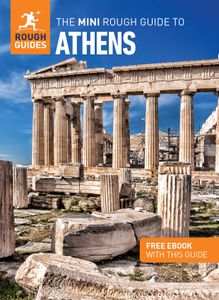
Find even more inspiration here

Planning your own trip? Prepare for your trip
Use Rough Guides' trusted partners for great rates
written by Rough Guides Editors
updated 19.05.2021
Ready to travel and discover Greece?
Get support from our local experts for stress-free planning & worry-free travels.
- Where to stay
- Travel advice

Home » Travel Guides » Greece » 15 Best Things to Do in Crete (Greece)
15 Best Things to Do in Crete (Greece)
The Mediterranean’s fifth-largest island was the birthplace of the oldest civilisation in Europe, blossoming in 2700 BC. To get to know the Minoans you can venture through Bronze Age archaeological sites across the island, and call in at the phenomenal Archaeological Museum in the capital, Heraklion.
These Minoan palaces and cities blur the lines between fact and Greek mythology, and conjure thoughts of King Minos, Daedalus and Icarus.
Many centuries later, the Venetians also made a lasting contribution to Crete’s cities, building ports, walls and fortresses that stand tall today in Heraklion, Chania and Rethymno.
And away from civilisation the island is sprinkled with mountain ranges and gorges like the life-changing Samaria, and has some of the most beautiful beaches you’ll ever lay your eyes on.
Let’s explore the best things to do in Crete :

A few kilometres south of Crete’s modern capital, Heraklion was the capital of Minoan Crete.
Knossos is the name of a palace and its encompassing city, which had a population of up to 100,000 in the 18th century BC. The palace was built around 3,000 years ago and features in Greek mythology as the seat of King Minos, where he had Daedalus build a labyrinth to hold his son, the Minotaur.
Knossos was affected by repeated catastrophes like invasions, earthquakes and the Theran Eruption in about 1625 BC. It was excavated for the first time in 1900 by the British Archaeologist Arthur Evans, who restored some of the architecture and frescoes.
You can check out the sweeping reception courtyard where the royal family would entertain guests, and enter the Throne Room, Sanctuary, walk a section of the Royal Way in the direction of the coast and see the Royal Apartments, built on four levels.
Recommended tour : Knossos Palace Skip-the-Line Entry with Guided Walking Tour
2. Heraklion Archaeological Museum

To fully understand the oldest civilisation in Europe, look no further than Heraklion’s outstanding archaeological museum.
This has the biggest collection of Minoan artefacts of any museum, and has 20 rooms in chronological order.
You’ll start in Neolithic times, long before Crete’s palaces were built, and in the following rooms there’s jewellery, liturgical figurines, vases, weapons and armour.
Whole frescoes have been transferred to the museum from Crete’s Minoan sites, as well as the emblematic ivory figurine of the bull leaper from Knossos Palace.
One artefact that remains a mystery is the Phaistos Disc, 15 cm in diameter and covered with symbols arranged in a spiral.
Another piece with strange inscriptions is the Arkalochori Axe, found in the cave of the same name and etched with 15 symbols.
3. Elafonisi Beach

Often cited as one of the world’s best beaches, Elafonisi Beach has to be seen to be believed.
The beach is a nature reserve on the channel between the mainland and Elafonisi, a rectangular island famed for the pink sand on its beaches and dunes.
The water between the mainland and the island is clear, shallow and lagoon-like, and often you can pass from one to the other on sand bars without getting your feet wet.
There’s an enormous natural pool where you can paddle or lie back and float in shimmering water no more than ankle or knee deep.
Add to this the white sand, turquoise water, azure sky and views to Crete’s mountainous southwest coast and you’ve got a small patch of paradise.
4. Samaria Gorge

Walking this ravine the real way, from the Omalos Plateau is something that will stay with you for a lifetime.
The 16-kilometre hike begins at a viewing platform at the bottom of a circuitous path and wooden steps, where you’ll be bowled off your feet by the walls of rock that climb to almost 300 metres.
On the way the ravine will narrow to a stretch named the “Gates” or “Iron Gates”, where the gorge tapers to just four metres across.
Look up as you walk, to catch sight of the endangered kri-kri, a kind of feral goat that makes light work of even sheer rock faces.
At the end of the gorge it’s another three kilometres to the coastal village of Agia Roumeli, where you can catch the ferry to Sougia in the west or Sfakia in the east.
Recommended tour : Samaria Gorge Trek: Full-Day Excursion from Rethymno
5. Rethymno Old Town

The third-largest city in Crete also has what may be the best preserved old town on the island.
Originally behind walls, the city’s tight cobblestone alleys were laid out in the 14th century when Crete was in the hands of the Republic of Venice, and has held onto its Renaissance mansions, arches and catholic churches.
If one building can sum up Rethymno’s tumultuous history it’s the Neratze Mosque.
This started life as a Venetian Church, before becoming a mosque for almost 300 years up to 1925. Now it’s Rethymno’s municipal odeon, staging regular music concerts.
Venetian monuments surviving in Rehtymno include the 17th-century Loggia (also converted into a mosque by the Ottomans) and the Rimondi Fountain from 1629, framed by two pairs of Corinthian columns next to a Gothic arch.
Available tour : Rethymno Old Town Segway Tour
6. Balos Lagoon

A beach to rival Elafonisi, Balos Lagoon is equally paradisiacal and is one of Crete’s most famous images.
Balos is some 60 kilometres northwest of Chania and is frequented by day-trippers by ferry from Kissamos, 18 kilometres away.
The lagoon is wedged between two capes, Gramvousa and Tigani, trapping a pool of shallow, turquoise water as beautiful as it is safe.
If you make the journey by road the walk down the rugged hillside is an experience of its own, and you’ll turn a bend to be confronted by the lagoon fringed by white sand against the rocky mass of Tigani.
By boat you’ll also have the chance to take a closer look at the Gramvousa islands, one of which, Imeri Gramvousa, has a historic fort built by the Venetians.
7. Chania’s Venetian Harbour

The Venetians started building Chania’s glorious harbour in 1320 and work would continue for the next three centuries.
From the eastern end there’s a mole, several hundred metres in length, leading all the way to the lighthouse, a symbol for the city.
This was built at the turn of the 17th century and got its minaret-like form in the Egyptian period in the 1830s.
The western part of the harbour was where goods were brought ashore, while the more sheltered eastern pocket was for ship building and maintenance.
There you can still find the terrace of dry docks and repair yards known as the Arsenali, constructed from the mid-1400s to 1599. Separated from this row, the Grand Arsenal has had many different roles over the years, as a Christian School, hospital and Chania’s Town Hall.
After post-war renovations it now hosts the Centre of Mediterranean Architecture.
8. Arkadi Monastery

Of all the memorable man-made and natural landmarks on Crete none mean quite as much to its people as this monastery just over 20 kilometres southeast of Rethymno.
Supposedly founded by the Byzantine emperor Arcadius in the 5th century, the Arkadi Monastery rests on a plateau surrounded by vineyards, olive trees and oaks.
The present architecture is from a 16th-century makeover in the early Venetian Baroque style.
In Ottoman times it was famed for its gold embroidery and an exceptionally rich library.
Then in 1866 came a watershed, when during the Cretan Revolt 943 Greeks, mainly women and children, walled themselves at the monastery holding out against the Ottomans for three days.
The siege was brought to a devastating close when the Cretans ignited their gunpowder barrels, choosing martyrdom over surrender.
The site is now a Greek national sanctuary, and 8 November, the day of the explosion, is observed in Arkadi and Rethymno.
Fun tour available : Arkadi Monastery e-Bike Tour with Lunch
9. Falassarna Beach

Often ranking as the best beach on Crete and one of the best in Europe, Falassarna beach is on the west coast where the Gramvousa Peninsula joins the mainland.
There are in fact five separate beaches here, around a large bay that was a harbour in antiquity.
The town’s acropolis is on a promontory on the north side of the bay, climbing 90 metres above the water and with the remains of wells, cisterns, fortifications and a temple going back to the 4th century BC. The main destination for sun-seekers is the centremost beach, which has a wide band of pale sand, bathed by clear shallow sea with only moderate surf.
Right on the beach you can go on a tandem paragliding trip, worthwhile because of the towering rugged hills in the background.
10. Phaistos Palace and Archaeological Site

The second largest Minoan palace on Crete after Knossos, Phaistos is in a dramatic position on a rise over the Messara plain in south central Crete.
In Greek mythology, this was the home of Radamanthus, the brother of Minos.
Phaistos is the origin of the enigmatic Phaistos Disc at the Heraklion Archaeological Museum, and a settlement that existed in Neolithic times and reached its apogee around 1700 BC when the fourth iteration of the palace was built on the ruins of its destroyed predecessors.
The city thrived for 17 centuries and was designed with the landscape in mind.
This is most obvious when you stand on the original paving stones of the main courtyard (above an ancient sanitation system), and marvel at the unbroken views of the plain.
11. Lake Voulismeni

This unusual body of water is ringed by boats, coffee shops and restaurants in the eastern town of Agios Nikolaos.
Lake Voulismeni is no longer strictly a lake as in 1870 a channel was laid.
connecting it with the town’s harbour and the sea.
You may notice from the darkness of the water that it’s extremely deep, despite the lake’s width of just 137 metres.
There’s a local legend that the lake is bottomless, but that’s a tall story as it descends to a maximum depth of 64 metres.
Stop by for a coffee by day to watch the fish, or see the lights on the water over a meal in the evening.
On the Saturday night before Orthodox Easter most of the town gathers on the water’s edge for a fireworks display and to light their own firecrackers.
12. Malia’s Minoan Palace

East of Heraklion, Malia is a boisterous modern resort, but a little way east is Crete’s third-largest Minoan palace.
According to tradition, Sarpedon, another of King Minos’ brothers, had his throne here.
The ruins are kept partially under a glass roof canopy, and because the site was abandoned at the end of the 2nd millennium BC and never resettled, there are no interfering newer buildings.
One artefact uncovered during French excavations in the 20th century is a gigantic vase for oil or wine, 1.75 metres in height and with a volume of more 1,000 litres.
In its day the palace had two storeys and boasted a loggia, theatre, western and central court, magazines, workshops and royal quarters.
The section under a roof is the recently excavated hypostyle crypt, where the city’s lords would sit for political meetings.
13. Holy Trinity Monastery

This 17th-century monastery is on the Akrotiri Peninsula, ensconced in vineyards, olive groves and cypress trees.
Founded towards the end of Venetian rule on Crete, it lies in a compound approached along a stairway at the end of which is a portal beneath a narrow bell tower.
Passing through you’ll be met by the three domes of the monastery church, fronted by four powerful Doric columns and two smaller Corinthian columns that flank the entranceway.
The church is a blend of Greek Orthodox and Western Mannerist architecture and has an interior lined with icons, and a dark blue ceiling sparkling with golden stars.
In the museum you can view a portable icon of St John the Theologian from the early 16th century, along with paintings and rare manuscripts.
Wine and olive products made by monks are sold at the monastery shop.
14. Lychnostatis Open Air Museum

This private museum is the brainchild of a doctor, Yiorgos Markakis, who spent six years from 1986 to 1992 building a group of traditional-style houses in the village of Hersonissos.
Equipped with an audioguide you’ll learn all about Cretan folk culture, the island’s natural wealth and its traditional trades.
There’s a distillery, a farmhouse, wine and olive presses, workshops for weaving and crafting ceramics, and a merchant’s warehouse.
You can also peruse an exhibition of minerals and stones, a gallery for Cretan folk art, and head out into gardens to see the island’s native fruit, cactuses and herbs.
Be here in September for traditional dance, concerts and grape and wine-tasting workshops.
Book online : Lychnostatis Open Air Museum
15. Aquaworld Aquarium

A change of pace from Crete’s Minoan ruins and epic landscapes, this intimate attraction in Hersonissos is one of only three aquariums in Greece.
Aquaworld’s charm comes from its modest size, with enthusiastic staff who are happy to talk about the inhabitants and let you touch many of them.
Most of the creatures at Aquaworld have been rescued and nursed back to health, or are unwanted pets.
For kids the highlight will be getting to handle harmless reptiles like iguanas, snakes and a blind tortoise.
15 Best Things to Do in Crete (Greece):
- Heraklion Archaeological Museum
- Elafonisi Beach
- Samaria Gorge
- Rethymno Old Town
- Balos Lagoon
- Chania's Venetian Harbour
- Arkadi Monastery
- Falassarna Beach
- Phaistos Palace and Archaeological Site
- Lake Voulismeni
- Malia's Minoan Palace
- Holy Trinity Monastery
- Lychnostatis Open Air Museum
- Aquaworld Aquarium
- Travel, Tourism & Hospitality ›
Leisure Travel
Industry-specific and extensively researched technical data (partially from exclusive partnerships). A paid subscription is required for full access.
- Number of inbound tourist visits to Greece 2019-2022, by region
What are the leading inbound travel markets in Greece?
How many greek tourists travel abroad, number of international visits to greece from 2019 to 2022, by region (in 1,000s).
- Immediate access to 1m+ statistics
- Incl. source references
- Download as PNG, PDF, XLS, PPT
Additional Information
Show sources information Show publisher information Use Ask Statista Research Service
2019 to 2022
Data refer to visits not visitors, as travelers may visit more than one region during their trip. The release date is the access date. Figures have been rounded.
Other statistics on the topic Travel and tourism in Greece
- Leading international travel markets in Greece 2019-2022, by arrivals
- Leading inbound travel markets in Crete, Greece 2019-2022, by number of visits
Travel, Tourism & Hospitality
- Number of inbound tourists in Greece 2005-2022
Accommodation
- Number of hotels and similar accommodation in Greece 2013-2022
To download this statistic in XLS format you need a Statista Account
To download this statistic in PNG format you need a Statista Account
To download this statistic in PDF format you need a Statista Account
To download this statistic in PPT format you need a Statista Account
As a Premium user you get access to the detailed source references and background information about this statistic.
As a Premium user you get access to background information and details about the release of this statistic.
As soon as this statistic is updated, you will immediately be notified via e-mail.
… to incorporate the statistic into your presentation at any time.
You need at least a Starter Account to use this feature.
- Immediate access to statistics, forecasts & reports
- Usage and publication rights
- Download in various formats
You only have access to basic statistics. This statistic is not included in your account.
- Instant access to 1m statistics
- Download in XLS, PDF & PNG format
- Detailed references
Business Solutions including all features.
Statistics on " Travel and tourism in Greece "
- Travel and tourism's total contribution to GDP in Greece 2019-2022
- Travel and tourism: share of GDP in the EU-27 and the UK 2019-2022, by country
- Distribution of travel and tourism expenditure in Greece 2019-2022, by type
- Distribution of travel and tourism expenditure in Greece 2019-2022, by tourist type
- Travel and tourism's total contribution to employment in Greece 2019-2022
- Average duration of stay by inbound tourists in Greece 2022, by country
- International travel receipts in Greece 2003-2022
- International tourist expenditure in Greece 2019-2022, by purpose of trip
- Number of international air arrivals in Athens, Greece 2010-2023
- Number of international air arrivals in Thessaloniki, Greece 2010-2023
- International air arrivals to South Aegean region of Greece 2010-2023, by island
- Number of international air arrivals in Crete, Greece 2010-2023
- International air arrivals on the Ionian Islands, Greece 2010-2023, by island
- Leading inbound tourist markets in the Ionian Islands, Greece 2019-2022
- Total number of domestic trips in Greece 2015-2021
- Number of domestic trips in Greece 2015-2021, by type
- Number of domestic overnight trips in Greece 2015-2021, by purpose
- Number of domestic overnight trips in Greece 2015-2021, by transport
- Domestic tourism spending in Greece 2019-2022
- Number of outbound tourists from Greece 2005-2022
- Leading outbound travel destinations from Greece 2016-2022
- Outbound travel expenditure in Greece 2003-2022
- Outbound travel expenditure by Greek residents 2016-2022, by destination
- Number of tourist accommodation establishments in Greece 2013-2022
- Number of nights in tourist accommodation in Greece 2013-2022
- Number of tourist accommodation establishments in Greece 2022, by type
- Travel and tourism revenue in Greece 2017-2027, by segment
Other statistics that may interest you Travel and tourism in Greece
- Basic Statistic Travel and tourism's total contribution to GDP in Greece 2019-2022
- Basic Statistic Travel and tourism: share of GDP in the EU-27 and the UK 2019-2022, by country
- Basic Statistic Distribution of travel and tourism expenditure in Greece 2019-2022, by type
- Basic Statistic Distribution of travel and tourism expenditure in Greece 2019-2022, by tourist type
- Basic Statistic Travel and tourism's total contribution to employment in Greece 2019-2022
Inbound tourism
- Premium Statistic Number of inbound tourists in Greece 2005-2022
- Premium Statistic Leading international travel markets in Greece 2019-2022, by arrivals
- Premium Statistic Average duration of stay by inbound tourists in Greece 2022, by country
- Premium Statistic Number of inbound tourist visits to Greece 2019-2022, by region
- Premium Statistic International travel receipts in Greece 2003-2022
- Premium Statistic International tourist expenditure in Greece 2019-2022, by purpose of trip
Inbound tourist destinations
- Premium Statistic Number of international air arrivals in Athens, Greece 2010-2023
- Premium Statistic Number of international air arrivals in Thessaloniki, Greece 2010-2023
- Premium Statistic International air arrivals to South Aegean region of Greece 2010-2023, by island
- Premium Statistic Number of international air arrivals in Crete, Greece 2010-2023
- Premium Statistic Leading inbound travel markets in Crete, Greece 2019-2022, by number of visits
- Premium Statistic International air arrivals on the Ionian Islands, Greece 2010-2023, by island
- Premium Statistic Leading inbound tourist markets in the Ionian Islands, Greece 2019-2022
Domestic tourism
- Premium Statistic Total number of domestic trips in Greece 2015-2021
- Premium Statistic Number of domestic trips in Greece 2015-2021, by type
- Premium Statistic Number of domestic overnight trips in Greece 2015-2021, by purpose
- Premium Statistic Number of domestic overnight trips in Greece 2015-2021, by transport
- Basic Statistic Domestic tourism spending in Greece 2019-2022
Outbound tourism
- Premium Statistic Number of outbound tourists from Greece 2005-2022
- Premium Statistic Leading outbound travel destinations from Greece 2016-2022
- Premium Statistic Outbound travel expenditure in Greece 2003-2022
- Premium Statistic Outbound travel expenditure by Greek residents 2016-2022, by destination
- Basic Statistic Number of tourist accommodation establishments in Greece 2013-2022
- Basic Statistic Number of nights in tourist accommodation in Greece 2013-2022
- Basic Statistic Number of tourist accommodation establishments in Greece 2022, by type
- Premium Statistic Number of hotels and similar accommodation in Greece 2013-2022
- Premium Statistic Travel and tourism revenue in Greece 2017-2027, by segment
Further related statistics
- Premium Statistic European travelers in Spain 2022, by origin
- Premium Statistic International tourism volume in Andalusia 2000-2022
- Premium Statistic Chile: number of inbound tourists 2019, by purpose of travel
- Premium Statistic Inbound tourists from Europe to the Netherlands 2019-2022, by country
- Premium Statistic Inbound same-day visitor spending in Poland 2020-2022, by country of residence
- Premium Statistic Number of tourist arrivals from Brazil to Europe 2019-2022, by destination
- Premium Statistic Inbound and outbound visitor growth worldwide 2020-2025
- Premium Statistic International visitor spending in Singapore 2010-2018
- Premium Statistic Inbound visitor growth in the Americas 2020-2025, by region
- Premium Statistic Latin America: most visited cities by foreign travelers 2017-2019
- Premium Statistic Number of inbound overnight tourists in Lithuania 2021, by country
- Premium Statistic Italy: international tourists´ arrivals in Basilicata 2016, by province
- Premium Statistic Italy: international tourists´ arrivals in Lazio 2016, by province
- Premium Statistic Average hotel room rates in top travel destinations worldwide
- Premium Statistic Distribution of arrival of international tourists in the GCC 2019, by country
- Premium Statistic Inbound tourism volume in Trinidad & Tobago 2010-2020, by type
Further Content: You might find this interesting as well
- European travelers in Spain 2022, by origin
- International tourism volume in Andalusia 2000-2022
- Chile: number of inbound tourists 2019, by purpose of travel
- Inbound tourists from Europe to the Netherlands 2019-2022, by country
- Inbound same-day visitor spending in Poland 2020-2022, by country of residence
- Number of tourist arrivals from Brazil to Europe 2019-2022, by destination
- Inbound and outbound visitor growth worldwide 2020-2025
- International visitor spending in Singapore 2010-2018
- Inbound visitor growth in the Americas 2020-2025, by region
- Latin America: most visited cities by foreign travelers 2017-2019
- Number of inbound overnight tourists in Lithuania 2021, by country
- Italy: international tourists´ arrivals in Basilicata 2016, by province
- Italy: international tourists´ arrivals in Lazio 2016, by province
- Average hotel room rates in top travel destinations worldwide
- Distribution of arrival of international tourists in the GCC 2019, by country
- Inbound tourism volume in Trinidad & Tobago 2010-2020, by type

A Complete Guide to Visiting Crete in October: 16 Best Things To See & Do!
Marco Santos
Sharing is caring!
Discover the pure magic of visiting Crete in October, where serene landscapes meet vibrant culture in an autumnal Mediterranean paradise.
When most people think of Greece, visions of sun-soaked islands and crystal-clear waters often come to mind. And while summer in Greece has its undeniable charm and tends to be the most desired time to visit, there’s a secret season that the discerning traveler should not overlook: that being, autumn in Crete.
As the throngs of summer tourists begin to wane, the island of Crete ( the largest islands in Greece ) reveals a quieter, more introspective side. The beaches, once packed and abuzz with activity, become serene stretches of sand, and the many ancient ruins, devoid of the peak season crowd, are all the more appealing.
But what truly sets October apart is the weather. While most of Europe starts to brace itself for the impending cold of the winter months, Crete basks in comfortable moderate temperatures.
It’s certainly not the scorching heat of midsummer, nor the chill of winter – an idyllic climate to explore all the very best that Crete has to offer. Perfect for exploring ancient ruins without breaking a sweat, hiking the island’s famed gorges without the oppressive heat, or simply enjoying a glass of local wine al fresco.
In the following post, we’ll dive deeper into the October weather specifics and chart out a journey across Crete’s must-visit spots and things to do.
Whether you’re a history buff, nature enthusiast, or someone simply looking to escape the clichéd autumn destinations, Crete in October offers up an exciting array of experiences that will no doubt turn into long lasting memories.

Why Visit Crete in October?

Let’s get to grips with the basics first. Why would you consider ditching the summer sun and embrace the more moderate autumn climates of Crete. Here are a few top reason why you should visit Crete in October:
Fewer Crowds
Because many folks are back to work and school, Crete becomes much quieter, allowing for a far more relaxing island experience. As a result, you won’t be elbowing through throngs of tourists, making it a much more enjoyable visit.
Budget-Friendly
Autumn also brings with it wallet-friendly benefits if you are an October tourist in Crete. Summer prices begin to dip and hotels roll out tempting deals. So, you can enjoy a Greek island getaway without breaking the bank.
Don’t pack away your beachwear just yet. October still offers its fair share of sunny days, letting you soak up the sun and enjoy the best beaches in Crete before winter officially sets in.
Vibrant Towns
The main towns of Chania and Heraklion keep their liveliness year-round. Restaurants stay open, ensuring you’ll have plenty of sightseeing to tick off your list and dining options to indulge in.
Harvest Festivals
October is when Crete celebrates its harvest with colourful festivals. It’s a chance to immerse yourself in local culture and traditions. Read on down below for more information on these and other festivals during this period.
What to Expect from the Weather in Crete in October:
October in Crete ushers in the autumn season, subtly transforming the landscape and offering a refreshing contrast to the island’s renowned scorching summer. As the month progresses, the intensity of the summer sun softens, paving the way for a more moderate climate but still somewhat retaining the summer charms.
Daytime temperatures generally hover around a comfortable 20°C to 25°C, (around 68 to 77°F), making it ideal for exploring the island’s myriad attractions without the discomfort of sweltering heat. However, evenings can be slightly cooler, with temperatures often dipping to around 15°C, so packing a light sweater or jacket is definitely advisable.
While the chances of rainfall increase compared to the arid summer months, the showers are typically brief and sporadic. These rainfalls, although short-lived, definitely helps to revive the local vegetation, making for a fresher and more lush landscape.
It’s a picturesque time, with the olive groves and vineyards looking especially lush, set against the backdrop of the azure sea that’s still warm enough for a swim. With sea temperatures averaging around 22°C to 24°C in October, many beachgoers seize the opportunity for a dip without the crowdedness of peak season.
Another distinctive aspect of Crete’s October weather is the meltemi winds. Originating from the north, these winds, which are prevalent during the summer, begin to subside, leading to calmer seas – great for those looking to indulge in water sports or coastal cruises.
Additionally, the clear October air offers enhanced visibility, making it a fantastic time for hiking and capturing panoramic views from the island’s elevated regions.
How to Get to Crete

Due to its beauty and active island life, Crete has been on the bucket list of many as one of the best Greek islands worth visiting. If you ask me, you should certainly spend at least a couple of days to get the most of your visit here.
Since Crete is a favorite tourist destination by travellers, it is fairly easy to get to. The island has several passenger ports along with 2 international airports (in Heraklion and Chania).
Read along to discover the different ways to reach Crete in October:
By Ferry or By Flight?
You can visit Crete by air, or by ferry. Crete accommodates both local and European flights connecting from many of the major European hubs.
However, you may also be interested in reaching Crete through one of the many ferry services that operate between Athens and Crete .
Travelling From Athens to Crete
By flight: .
The three airports on Crete (Heraklion, Chania, and Sitia) are directly linked to Athens International Airport Eleftherios Venizelos throughout the year. You can book a flight and reach Crete swiftly in just over an hour by air. It is advisable to book a flight early to avoid any hassle and to get the best deals.
By Ferry:
Another option is to take a ferry from the Port of Piraeus. Ferries regularly sail to Heraklion, Chania, and Sitia. Occasionally, there are also sailings to Rethymnon and Kissamos, offering you multiple choices to reach Crete by sea.
The only downside to travelling by ferry from Athens to Crete is the much longer travel time as the journey does last a couple of hours compared to the far quicker flight times.
From Other Cycladic Islands to Crete
Direct Ferries : If you’re planning an island hopping experience and visiting other islands such as Santorini, Mykonos, Naxos, or Paros, you’re in luck. They offer direct ferry connections to Crete, mainly to the port of Heraklion. These direct ferries provide a more straightforward and quicker route to Crete.
Indirect Routes : If you’re on a different Cycladic island like Amorgos, Syros, or Folegandros, you can still reach Crete, but you may need to take “indirect” ferry routes. These routes might have stops at other islands along the way, adding to the travel time.
Ferry Options : You have a choice between slow and fast ferries, and your travel time will depend on the type of vessel you select and your starting location when booking. Slower ferries are larger and offer more outdoor space, which can be a smoother ride for those prone to seasickness.
Ticket Choices : Ferries typically offer economy and business class tickets , with some providing private cabin options for added comfort which can be very beneficial on these longer journeys. If you want to bring your vehicle, like a car or motorbike, you can do so, but it will increase your ticket price.
Getting around Crete
Once you’ve arrived on the island, there are several modes of transportation to choose from. Each has its advantages and disadvantages so we always advise to choose which will be most beneficial to you, based on your preferences and budgetary requirements.
Taxis operate in Crete. You can either call a taxi in advance or flag one down on the street.
Be sure to always agree on the fare before entering the taxi. Have the address of your destination written down to avoid confusion.
Car Rentals
Car hire is widely available in Crete, with major rental companies present at airports, sea ports, and throughout the cities and this is undoubtedly our favourite and best way to explore the island.
Renting a car offers flexibility and the freedom to explore at your own pace. It can also be cost-effective, especially for intercity travel. Drivers should be at least 21 years old, and having an International Driving Permit is recommended.
Crete’s bus services are operated by KTEL. Fares within the city are reasonably priced, and buying tickets in advance is often cheaper than paying on the bus.
You can also use buses for intercity travel. Routes connect major cities like Agios Nikolaos, Chania, Heraklion, and Rethymno. Note that intercity bus fares can be more expensive, and service is generally more frequent in the northern part of the island.
Bicycle Hire
If you enjoy cycling and want to explore the countryside while staying eco-friendly and active, consider renting a bicycle.
Several cycle hire companies are located along the northern coast, and there are cycling trails in natural areas, beaches, and public parks. Crete is a great cyclist destination, with winding roads and low traffic between cities.
Best Areas to Stay

When deciding where to stay in Crete, you have several options, each with its advantages and attractions:
Coastal Regions
Staying along the coast offers the allure of beautiful beaches and stunning sea views. You can enjoy water activities, sunbathing, and easy access to the Aegean Sea. Coastal areas are perfect for a relaxed beach holiday, and you’ll find numerous seaside resorts and accommodations to choose from.
Inland Areas
If you’re looking for a more traditional and authentic Cretan experience, consider staying in inland areas. Here, you’ll discover charming villages where you can immerse yourself in local culture and cuisine.
Inland regions also provide access to hiking and exploring the island’s rugged terrain, making it ideal for nature enthusiasts.
For a Classic Crete Experience Stay at Chania
Porto veneziano hotel .
For a touch of luxury and romance, the Porto Veneziano Hotel is an ideal choice. Located right on the waterfront, it offers a range of plush and comfortable rooms, some with captivating sea views. Guests can enjoy a hearty breakfast each morning and take advantage of various amenities.
Click here to book your stay at Porto Veneziano Hotel in Chania !
Suites Pandora
If you prefer the convenience of your own self-serviced accommodation option, Suites Pandora is an excellent option. They offer fully furnished suites and rooms with equipped kitchens, some also offering sea views. The location is perfect for exploring the city and its surroundings.
Click here to view and book Suites Pandora !
For a Relaxing Holiday Stay at Agios Nikolaos
Hotel port 7 – boutique collection .
This upmarket and luxurious hotel is ideally situated in the Agios Nikolaos port and only a mere 100 meters from the beach in Agios Nikolaos, offering guests a prime location for beachfront relaxation.
Hotel Port 7 offers a variety of wonderful rooms, providing guests with a range of choices to suit their preferences. Guests can start their day with a delicious breakfast offered each morning. Additionally, the hotel provides plenty of other amenities, ensuring a comfortable and enjoyable stay.
Click here to book Hotel Port 7 in Agios Nikolaos !
For Your Family Getaway Stay at Hersonissos
Nest resort .
Another perfect destination for those seeking a luxurious escape in Hersonissos is the Nest Resort. This resort offers a selection of rooms as well as villa options, catering to different preferences and group sizes.
Set against the backdrop of a stunning seaside location, The Nest Resort provides an unbeatable setting for a relaxing and indulgent getaway. Whilst staying here, guests can enjoy a gorgeous pool during their stay, along with various other top facilities on site.
Click here to view and book the Nest Resort !
What to do in Crete in October
Whilst visiting Crete in October, you’d want to make sure to ticket off a few of these top activities and things to do in Crete!
Historical Sites and Districts
Cave of zeus.
The Cave of Zeus , also known as Psychro Cave or Dikteon Cave, is a captivating historical site in Crete that holds immense significance in Greek mythology. According to ancient tales, this cave is believed to be the very birthplace of Zeus, the mighty god of the sky and thunder.
Located in the charming village of Psychro, this cave is a must-visit destination for history enthusiasts and curious travellers alike. It’s a show cave that welcomes visitors to explore its mystical depths.
During the summer months, you can delve into its secrets from 8:00 a.m. to 6:00 p.m., while in winter, it’s open from 8:00 a.m. to 3:00 p.m.
To enter this historical site, there’s a ticket fee of €6 per person. Keep in mind that reaching the cave involves a 10-15 minute uphill walk, and the path can be rocky and uneven. It’s essential to wear proper footwear for this journey, especially as you ascend a steep unpaved path leading to the sacred part of the cave.
You may also consider booking this full day Shepherd’s Life – Cave of Zeus at Lasithi Plateau tour that also includes sampling some delicious local Cretan dishes too!
Palace of Knossos

This remarkable Greek landmark , constructed by the Minoans, is steeped in history and offers a glimpse into the ancient world.
Situated near the north coast of Crete, the Palace of Knossos welcomes visitors throughout the year, making it accessible for history enthusiasts and curious travellers alike.
Its doors are open from 8:00 am to 7:00 pm. To explore this historical gem, there’s an entrance fee of €10, except during the months of November to March and Greek holidays when admission is free.
Getting to the Palace of Knossos is convenient, especially when travelling from the city of Heraklion. While you can opt for various modes of transportation, renting a car is often the quickest way to reach this intriguing site.
Spread across approximately 14,000 square metres, which is roughly the size of two football fields, the Palace of Knossos was ingeniously designed to serve as a hub for civic, religious, and economic activities. Its grandeur and scale are a testament to the advanced civilization of the Minoans.
What makes this historical site truly captivating are the artifacts discovered within its ancient walls. Gold jewellery, glazed pottery, and bronze items are just a glimpse of the treasures that have been unearthed here.
To get a truly in-depth experience, consider booking a skip-the-line guided tour of the Knossos Palace site !
This archaeological marvel holds immense significance and is exceptionally well-preserved, making it a compelling attraction for history enthusiasts and curious travellers.
Archaeological excavations at the Palace of Phaistos have yielded a treasure trove of artifacts. These discoveries provide valuable insights into the material culture and daily life of the Minoan civilization. Among the finds are clay tablets, bronze figurines, pottery, jewellery, weapons, and beautifully preserved frescoes.
Getting to Phaistos is convenient, with a one-hour journey to the south from Heraklion, the capital of Crete. Alternatively, it’s approximately 70 kilometres from Rethymnon, another notable city on the island.
To explore this remarkable historical site, there’s an entrance fee of €8 per person. Special discounts apply, with reduced rates of €4 for university students, escorts on educational excursions, and European senior citizens aged 65 and above.
Additionally, visitors can enjoy free admission on specific dates, including the 6th of March, the 18th of April, the 18th of May, the final weekend of September, the 28th of October, and every first Sunday from November to March.

The Island of Spinalonga, often referred to as the Leper Island, is an absolute must-visit historical site in Crete. Steeped in a rich and poignant history, this island offers a unique and insightful journey for those seeking to explore its past.
Accessible only during the summer season, the Island of Spinalonga is a place of great historical significance. To enter the Spinalonga archaeological site, there’s a small admission fee and the cost of the boat trip to Spinalonga varies depending on your starting point:
You may also consider booking a full day guided tour to Spinalonga , including lunch too!
Natural Attractions
Elafonisi beach.

Elafonisi Beach stands as an absolute must-visit natural wonder on Crete Island, and it’s easy to see why. This stunning beach is a true gem, captivating visitors with its extraordinary beauty and unique landscape.
With its crystal-clear blue waters and striking pink sand, Elafonisi Beach offers an enchanting setting that welcomes thousands of visitors each year. It has earned well-deserved recognition as one of the world’s most beautiful beaches. Together with its surrounding shores, Elafonisi Beach is proudly part of the Natura network, a testament to its exceptional natural allure.
For those planning to experience the best of Elafonisi, early autumn is the ideal time to visit. In September and October, the weather is delightful, and the waters of the lagoon are likely to be calm and pleasantly warm, creating the perfect conditions for a memorable beach getaway.
Samaria Gorge
Samaria Gorge, which you may find at Samaria National Park in the White Mountains of Crete, is another Cretan natural wonder. This UNESCO Biosphere Reserve is a magnet for nature enthusiasts and hikers, drawing tens of thousands of visitors every year to experience its breathtaking beauty.
Among the gorges in the region, Samaria Gorge is unrivaled in size—it’s, in fact, the second-largest canyon in all of Europe. Stretching over 10 miles, the trail begins at the top of the gorge and leads adventurers through a landscape of towering cliffs, panoramic vistas, and the unique flora and fauna that define the island of Crete. The journey culminates at the Libyan Sea in the charming town of Agia Roumeli.
One of the most captivating aspects of Samaria Gorge is its narrowest point, aptly named “The Gates”. Here, the gorge narrows to a mere 13 feet wide, with cliffs soaring to nearly a thousand feet in height, creating a dramatic and awe-inspiring natural spectacle.
To explore Samaria Gorge, it’s essential to plan your visit during late spring and summer, coinciding with the peak tourist season. Typically, the trail is open from May 1st through October 30th, subject to weather conditions. This natural wonder promises an unforgettable hiking experience amidst the pristine beauty of Crete’s wilderness.
Balos Lagoon

What immediately strikes visitors about Balos is the sheer beauty of its pristine landscape. With crystal-clear seawater that glistens under the Cretan sun, Balos Lagoon unfolds before your eyes like a scene from a postcard.
While Balos Beach used to lack facilities in the past, today you’ll find a limited number of conveniences to enhance your visit. These include sun lounges and umbrellas, a small shop or canteen, and restroom facilities.
For those with a penchant for underwater exploration, don’t forget to bring your snorkeling gear. The water in the lagoon boasts excellent visibility, making it an ideal spot to discover the vibrant marine life beneath the surface. It’s also wise to wear aqua shoes as there are rocky areas in the water throughout the lagoon.
Vai Palm Beach
Vai Palm Beach, specifically the palm forest of Vai, is an absolute must-visit natural wonder in Crete, boasting its status as one of the Mediterranean’s most beautiful and unique destinations.
This enchanting locale in Crete draws a multitude of visitors each year, and it’s easy to see why. Beyond its captivating palm forest, Vai is famed for its golden sandy beach that stretches out at its feet, creating a picture-perfect setting for all who come to explore its natural beauty.
Naturally, with its popularity, Vai sees a substantial influx of visitors during the summer months, particularly in July and August when crowds are at their peak. However, for those who prefer a more serene experience, visiting Vai at the beginning or end of the tourist season, such as October, offers the opportunity to relish the scenery and sea in a quieter atmosphere.
Unique Spots
Seitan limania.

Seitan Limania is a truly unique attraction in Crete that will no doubt leave a lasting impression. This hidden gem is unlike any other.
The beach itself may be small and nestled amidst tall cliffs, creating a sheltered haven that comes with its own set of advantages and quirks. On the one hand, the compact size of the beach and the towering cliffs provide excellent protection from the wind, making swimming a comfortable and enjoyable activity.
However, this also means that the sun graces the beach for only a few hours each day, and the water tends to be refreshingly cool due to the limited sunlight. Even with just a few dozen people, the beach can quickly feel crowded.
Seitan Limania has gained fame as one of the most popular Instagram-worthy spots on Crete. The views from the beach, gazing up at the dramatic gorge, and looking down from the top of the cliff onto the entire scene, are nothing short of breathtaking.
Milatos Cave
The journey to the Milatos Cave begins with a roughly 200-meter walk along an old footpath from where you park your car. This footpath not only leads you to the cave but also treats you to an incredible panoramic view of Milatos Bay, setting the stage for an unforgettable exploration.
As you make your way to the cave, you’ll be greeted by the striking bas-relief of the area, where the vibrant red of the ground gives way to the subtle gray of the limestone. Along the footpath, a lush tapestry of carob trees, prickly bushes, wild olive trees, and various other vegetation creates a vibrant green backdrop, adding to the excitement of the journey.
Upon reaching the entrance of the cave, you’ll find yourself immersed in total darkness, making a flashlight an absolute necessity. After venturing just 10 meters inside, you’ll encounter a small church constructed in 1935, accompanied by a memorial housing the remains of those who tragically lost their lives at the hands of the Turks.
It’s a place of deep historical significance, with an annual liturgy performed here in their memory.
Cultural Events in October
October in Crete will keep you busy as there are a host of cultural events that will no doubt enhance your stay on the island. Check out these special days:
Grape Harvest Celebration
The Grape Harvest Celebration in Crete is a vibrant festival that takes place during the harvest season, from mid-August to the beginning of October. It offers visitors a unique opportunity to immerse in the age-old tradition of grape harvesting and join the local winemakers in this exciting and hands-on experience.
If you happen to be in Crete during this time of year, you can partake in the grape harvest festivities. The experience allows you to work alongside local vineyard experts for a day of grape-picking and wine-making activities.
Chestnut Festival
The Chestnut Festival in Crete is a noteworthy autumn event that captures the essence of the season and the island’s rich traditions.
This delightful festival typically takes place every October or November, though it’s advisable to check with locals for the exact date to ensure you don’t miss out on the festivities.
Traditionally, the Chestnut Festival unfolds in the charming village of Elos, nestled just a short distance from Kissamos on the western part of Crete.
Elos is cocooned by picturesque chestnut trees, which not only provide a scenic backdrop but also yield a bountiful harvest. To herald the arrival of autumn and showcase the chestnut harvest, the local community in Elos dedicates special attention to the Chestnut Festival.
Despite its small scale, this authentic event holds a special place in the hearts of the locals and entices curious visitors over the weekend set aside for this extraordinary celebration.
Oxi Day, also known as “ Ohi Day ” is a significant and patriotic festival celebrated in Crete, just as it is throughout Greece. This national holiday, observed on October 28th each year, holds great historical importance and is a testament to the unwavering spirit of the Greek people.
The festival commemorates a pivotal moment in World War II when Greece’s fate hung in the balance. On that fateful day in 1940, Italian dictator Benito Mussolini presented Greece with an ultimatum, demanding access for Italian forces to Greek territory. However, Greek leader Ioannis Metaxas responded with a resolute “Oxi” (Greek for “No”), rejecting the ultimatum and standing firm against the impending Italian invasion.
Metaxas’ courageous act signified Greece’s entry into World War II and its alignment with the Allied forces. This historical event is remembered and celebrated with immense pride and patriotism.
Throughout Crete, and indeed across Greece, Oxi Day is marked by a series of special events and gatherings. Parades wind through the streets, school activities are held to educate the younger generation about the significance of the day, and military ceremonies pay homage to those who bravely defended the nation.
Other Activities To Enjoy in Crete in October
Once in Crete, you’ll find several things to do that could help you connect with the island’s breathtaking nature and rich culture.

Crete offers a variety of hiking trails suitable for all levels of hikers. Whether you’re conquering Mount Ida, following the E4 hiking trail, exploring the dramatic Samaria Gorge, or enjoying a leisurely Preveli hike, there’s a trail for you to discover. Here are some recommended hike trails:
- Chora Sfakion – Glyka Nera (Sweet Water) Beach – Loutro
- Zourva – Tromarissa Springs
- Margarites – Eleftherna
- Gious Kambous – Agia Fotia Gorge
Water Sports
In October, Crete still offers a range of exciting water sports for enthusiasts to enjoy. Some popular options include scuba diving, sea kayaking, snorkeling, stand-up paddleboarding, canyoning, jet skiing, windsurfing, parasailing, and boat wakeboarding.
The warm Mediterranean waters and pleasant Crete weather in October make it ideal for water adventures and exploration. Whether you’re into underwater exploration, adrenaline-pumping activities, or simply relaxing on the sea, Crete has something for everyone.
Indulge in Culinary Delights in October in Crete
Crete boasts a rich culinary heritage, offering a seasonal feast for the senses in October. As the island makes the transition into autumn, the local produce and harvest traditions shape the dining landscape. Here’s what you can expect on your plate and in your glass during this month:
Olive Oil:
One of the best souvenirs from Greece is undoubtedly its famed olive oils. October marks the onset of the olive harvesting season. This is the perfect time to sample Crete’s world-renowned olive oil at its freshest. Whether drizzled on delectable Greek salad, or paired with bread, the robust flavor and aroma are unparalleled.
Consider booking this awesome olive oil experience tour to learn about the island’s production by visiting an olive oil factory.
Dakos:
This traditional dish is a must-try. Comprised of dried barley rusk soaked in water or olive oil, it’s then topped with fresh tomatoes, mizithra cheese, olives, and capers. Given the prominence of the olive harvest in October, Dakos takes on a special significance.
Seafood:
The surrounding Mediterranean waters offer an abundance of seafood. As is commonplace with many Greek islands , Tavernas and restaurants proudly display their catch of the day, which includes everything from octopus to red mullet. Grilled or stewed with local herbs, the seafood is a testament to Cretan culinary prowess.
Horta (Wild Greens):
October is a great time to enjoy the island’s wild greens which has always formed an important part of Cretan cuisine. Often simply prepared by sautéing in olive oil, they are a testament to the Cretan diet’s emphasis on fresh, natural ingredients.
Local Wines:
Crete boasts a winemaking tradition that dates back millennia. October provides an opportunity to sample a diverse range of local Greek wines , from robust reds to crisp whites. Vineyards might also offer tastings, giving visitors a chance to learn about the island’s viniculture.
If you want to experience the best of both worlds, then consider this full day Cretan Olive Oil and Wine Tour that departs from either Malia or Heraklion.
Raki:
While available year-round, Raki, or Tsikoudia, takes center stage during autumn. This potent grape-based spirit is often distilled in local villages in October, following the grape harvest. It’s customary for tavernas to offer it complimentary after a meal, serving both as a digestive and a token of Cretan hospitality.
Tips for Travelling in October

Now that you are ready to visit Crete during October, let us provide you with some additional useful tips to make your vacation even more memorable:
What to Pack:
When travelling to Crete in October, it’s advisable to pack light layers, as the weather can still be warm during the day but cooler in the evenings. Comfortable walking or hiking shoes, such as sturdy hiking boots or sneakers, are essential if you plan to explore the island’s natural beauty.
Don’t forget to bring swimwear and sunscreen, as you might still want to enjoy the stunning beaches of Crete. Additionally, a reusable water bottle is handy to stay hydrated, and a travel adapter for your electronics is a must.
Be sure to check out our handy European packing list post here, for more tips and packing inspiration!
Weather Considerations:
October in Crete is generally pleasant with mild temperatures. However, it’s essential to be prepared for variations. Average temperatures during the day can range from 20°C to 25°C (68°F to 77°F), but evenings can be cooler, so having a light jacket or sweater is advisable.
Rainfall is possible but not as frequent as in winter months. Check the weather forecast for the specific region you’ll be visiting, as conditions can vary across the island.
Cultural Considerations:
Respect local customs and traditions when in Crete. Dress modestly when visiting religious sites, and always ask for permission before taking photos of people, especially in rural areas.
Safety Tips:
In emergencies, the general European emergency number, 112, works in Crete. However, knowing the local emergency numbers for police (100), medical services (166), and fire (199) can be helpful.
In Crete, just as in the rest of Greece, the official currency is the Euro (€). This makes it convenient for travelers from Eurozone countries as there is no need for currency exchange.
Before heading to Crete, it’s a good idea to exchange some of your local currency for Euros. While credit and debit cards are widely accepted in larger towns and tourist areas in Crete, it’s a good practice to carry some cash, especially when exploring more remote or rural parts of the island.
Currency exchange services are available at airports, banks, and exchange offices, but you may find better rates by exchanging money before your trip.
While the official language spoken in Crete is Greek, it’s heartening to know that many locals also speak English, especially in tourist areas.
However, making an effort to learn a few basic useful Greek words and phrases can go a long way in enhancing your experience and connecting with the local culture. Here are some essential Greek phrases to get you started:
- Hello: Yassou (Yah-Soo) (more informal) or Yassas (formal)
- Good Morning: Kalimera (Kah-Lee-MEH-Rah)
- Good Afternoon: Kalispera (Kah-Lee-SPARE-a)
- Good Evening: Kalinta (Kah-Lee-NEE-hta)
- Thank You: Efharisto (Ef-Cha-Ri-Sto)
- Excuse Me: Signomi
- How are you? / What’s going on?: Ti-Kanis
Top Tip: In Greece, it’s not customary to initiate handshakes unless it’s offered to you. So, feel free to greet people with a friendly “Yassou” or other appropriate phrases, and you’ll find that the locals appreciate your efforts to embrace their language and culture.
Connectivity:
Internet access in Crete is generally reliable and accessible, ensuring that you can stay connected during your visit. Here’s what you need to know:
Crete boasts good internet coverage, especially in urban areas, where you can typically access 4G networks. This ensures fast and stable internet connectivity, allowing you to use your mobile devices without interruptions.
You’ll find free WiFi hotspots in several convenient locations across the island.
Many cafes, restaurants, hotels, and bars in Crete offer free WiFi. This means you can enjoy a meal or a coffee while staying connected to the internet.
Crete is a beautiful island worthy of a visit, even if it’s already October. As discussed in this post, you’ll still have several places to visit as well as numerous things to do while you are enjoying your Cretan adventure.
So what are you waiting for, whether you are planning to stay 5 days in Greece , or longer, prepare those essentials and head over to Crete this coming October!

Welcome to Travel-Boo. My blog is where I share travel tips, suggestions, and stories focused on European travel adventures!
Latest Posts
9 of the most beautiful & best beaches in paros, 8 of the best hikes in southern utah to conquer, 19 of the best things to do in salisbury, uk, 15 of the best souvenirs from poland: what to buy, 20+ amazing & best things to do in florence, italy, exploring 7 best hidden mountain towns in the spanish pyrenees.
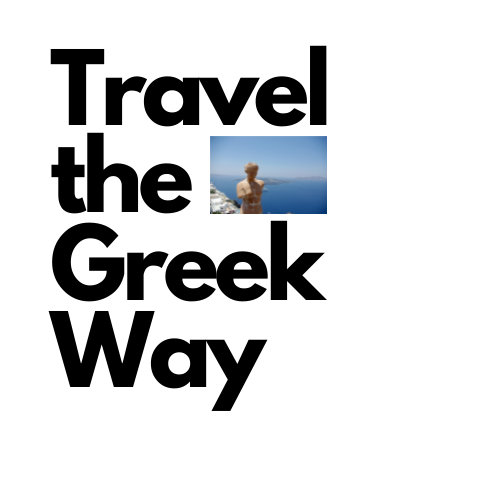
Crete in Winter: A Guide to Exploring the Island Off-Season
If you’re looking for a winter getaway that’s a little different from the norm, Crete in winter might be the perfect destination. Crete is the largest island in Greece, located at the southernmost point of the country. It is also the warmest place in Greece to visit during winter.
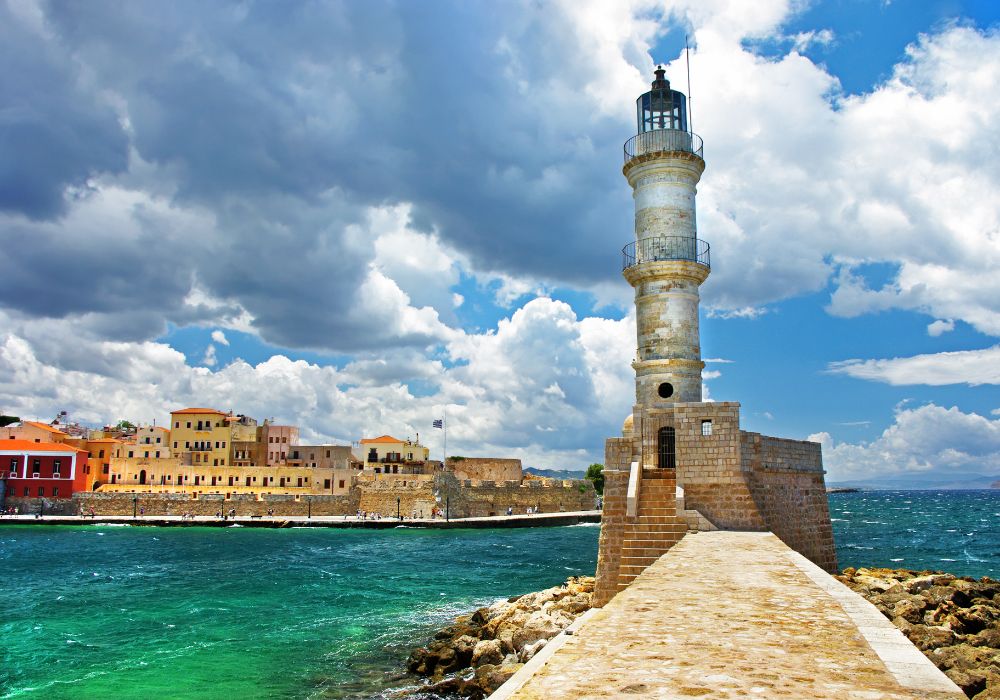
If you are wondering whether it is worth going to Crete in winter, you’ll be pleasantly surprised by the unique experiences and beauty it offers during the colder months. The winter season in Crete can be chilly at times (it snows on the mountains in January and February) but the temperatures are generally mild.
Plus, with fewer crowds , you’ll have a chance to explore some of the island’s most popular places without feeling rushed or overwhelmed. And at much better rates compared to visiting Crete during the summer. Up next I am going to tell you about the best things to do in Crete in winter!
Crete Quick Reference
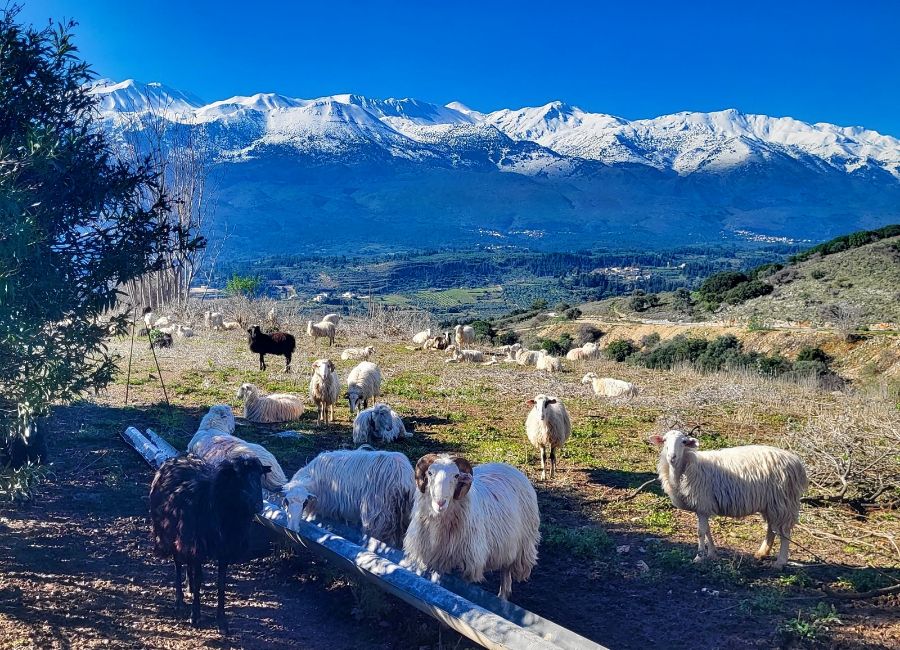
- Population: 634.930 residents (census 2019)
- Acreage: 8,336 sq km with 81 uninhabited islets. 5th largest island in the Mediterranean after Sicily, Sardinia, Cyprus, and Corsica.
- Economy : Agriculture, processing-packaging, and services (tourism).
- Terrain : Extremely mountainous with three main mountain ranges. The highest mountain is Psiloritis at 2.456 meters. Numerous imposing gorges with the most famous being the Samaria Gorge.
- It has 502 beaches. Lasithi has 164, Chania 136, Heraklion 131 and Rethymno 71.
- Airports: Heraklion, Chania, Sitia
- Road Conditions: Despite having a well-developed road network, especially in the northern part of the island, Crete lacks modern highways. The distance from the west to the east is 250 km.
- Public transport: KTEL buses. No train network.
Things to Do in Crete in Winter
Overall, Crete in winter is a great choice for those looking for a quieter, more authentic Greek experience. With its mix of natural beauty, fascinating history, and delicious cuisine, it’s sure to be a memorable trip.
* Some of the links in this post are affiliate links. That means I may make a commission if you click and buy. The commission comes at no additional cost to you .
What are Winters Like in Crete?
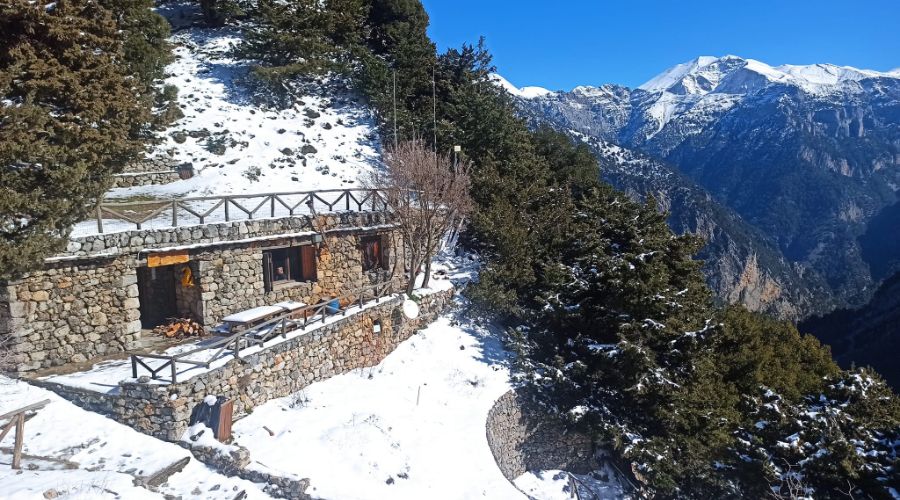
The climate and weather for Crete in winter fall between two climatic zones. The majority of the island falls within the Mediterranean zone , while the southern coasts, including the island of Gavdos, are in the North African zone . The average temperature in winter ranges between 10-15ºC while the interior alpine areas of the three major mountain ranges can have temperatures as low as -10°C. Most of the inhabited areas are located near the 1046 km-long coastline, which means mild temperatures .
December is usually the wettest month, with an average of 11 rainy days, while January and February are slightly drier, with around 8-9 rainy days per month. January will be the coldest month in Crete in winter.
Planning Your Trip to Crete Now?
If you are getting ready for your trip to Crete check out those winter guided tours that have all a Badge of Excellence:
- The 7 Villages of Apokoronas Tour – Explore East Chania Mainland
- Chania: Old Town, Public Market, Hill of Prophet Elias, Agia Triada
- Private trip to South Rethymno-Spili-Kourtaliotiko-Kalypso beach
- Private Full-day Tour to Knossos Palace and Zeus Cave
- Luxuries of Mirabello with Spinalonga Island & Agios Nikolaos from Elounda
Top Activities to Do in Crete in Winter
1. celebrate christmas in crete.
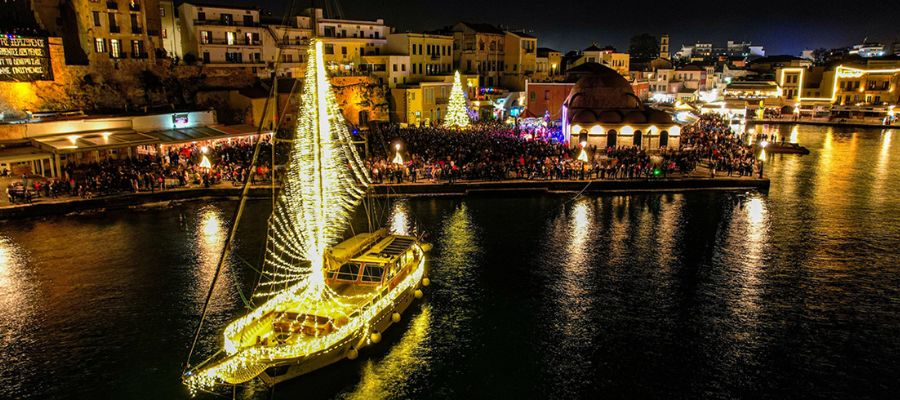
One of the unique things to do in Crete in winter is to celebrate Christmas and New Year’s Eve in one of the large towns of the island. The streets, the shops, the port, and the shore are decorated with Christmas trees and the Greek Christmas symbol, the Traditional Fishing Boat.
The town centers will come alive with Christmas Markets, with the most renowned one being the Heraklion Market. The historic districts will be bustling as people go about their holiday shopping, and you’ll find live music in the local taverns, creating a vibrant and festive atmosphere. And everywhere you look, you’ll discover delightful seasonal treats like kourabiedes and melomakarona. It’s a true holiday wonderland!
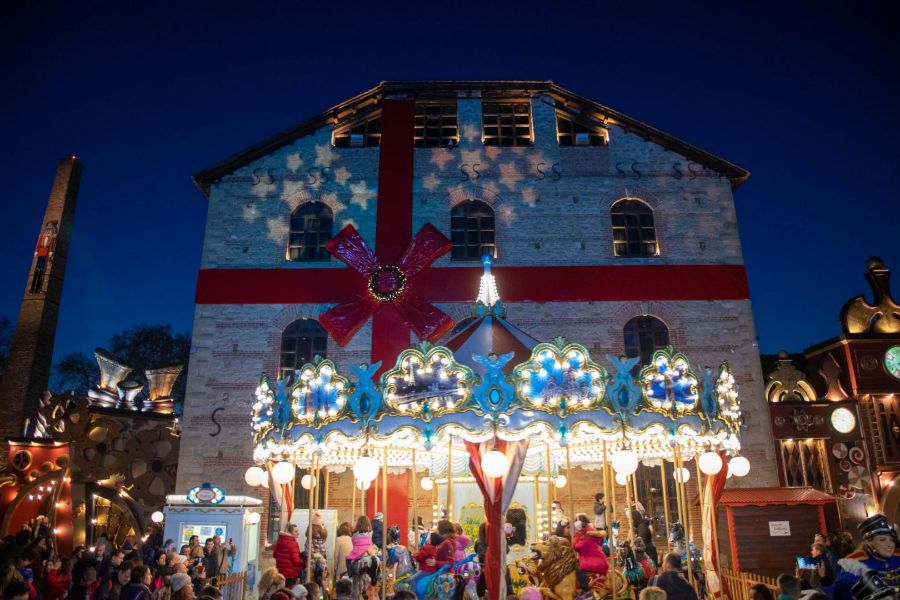
During the Christmas holiday season, a complete Christmas village comes to life in the typically snow-covered plateau of Omalos (Chania). Over in the Cave of Agios Ioannis in Marathokefala (Chania), they recreate the birth of the divine infant, complete with real animals, in a manger scene. It’s a special holiday experience!
2. Participate in Santa Run in Chania
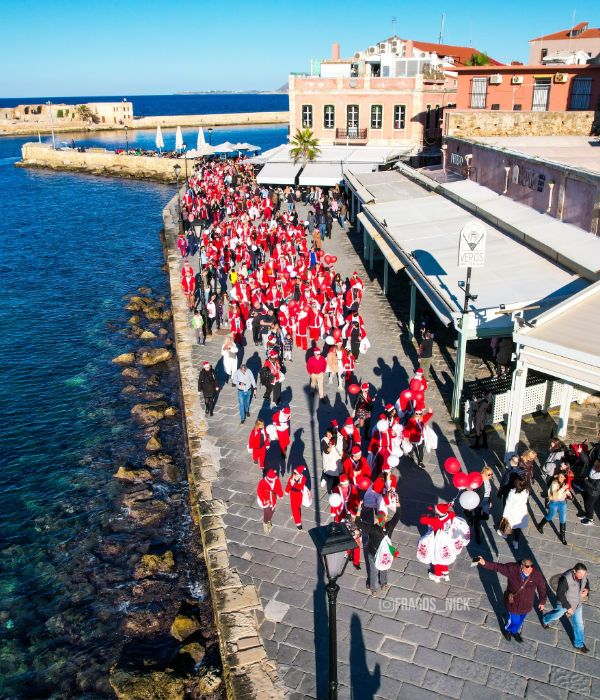
Santa Run Chania made its debut in Greece in 2011, marking the inception of this festive event. Today, it stands as Europe’s largest and most prolific fundraising Christmas initiative worldwide. All proceeds from participant registrations directly benefit four charitable associations, local shops offering treats to the runners, and the musicians and DJs who infuse the city streets with lively music, creating a vibrant atmosphere.
Find out more about this event on their official website here .
3. Stroll the Gorgeous Beaches
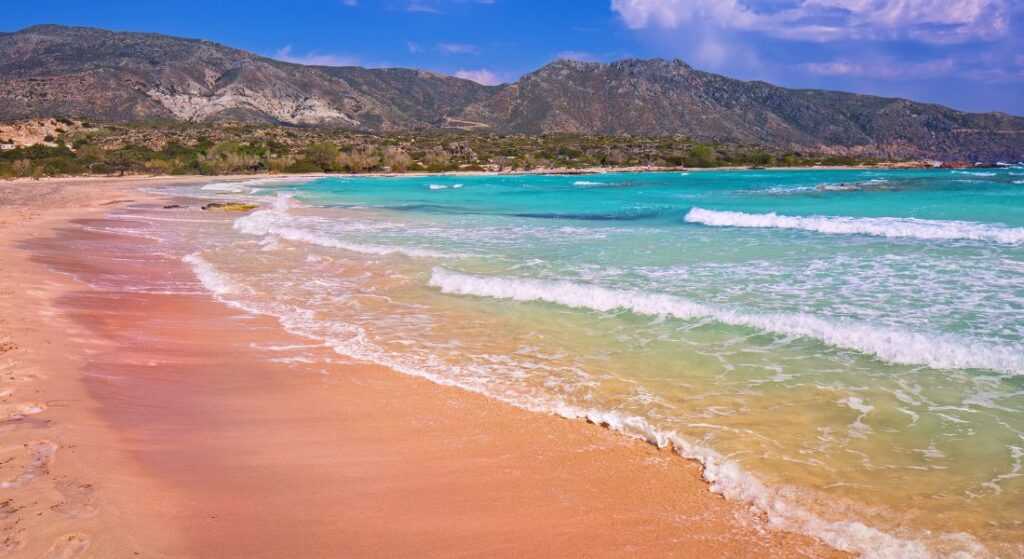
Crete boasts over 500 spacious beaches (along with hundreds of smaller ones), all waiting for you, completely unspoiled and serene. If you’ve ever been to Elafonissi, Balos, or Falasarna beaches during the summer, you’ll know exactly what I’m talking about when it comes to the overwhelming crowds.
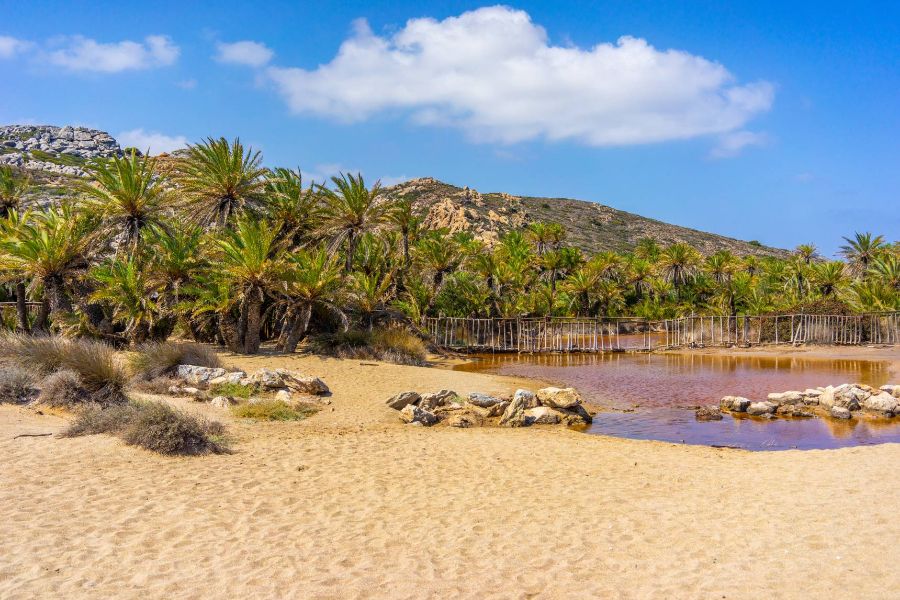
I love strolling along the peaceful shores when now and then, the sun breaks through the thick clouds, salt mingles in my hair, and with each gust of wind, a unique sense of tranquility washes over me. Best meditation ever 😀
4. Explore the Towns: Chania, Rethymno, Heraklion, Agios Nikolaos
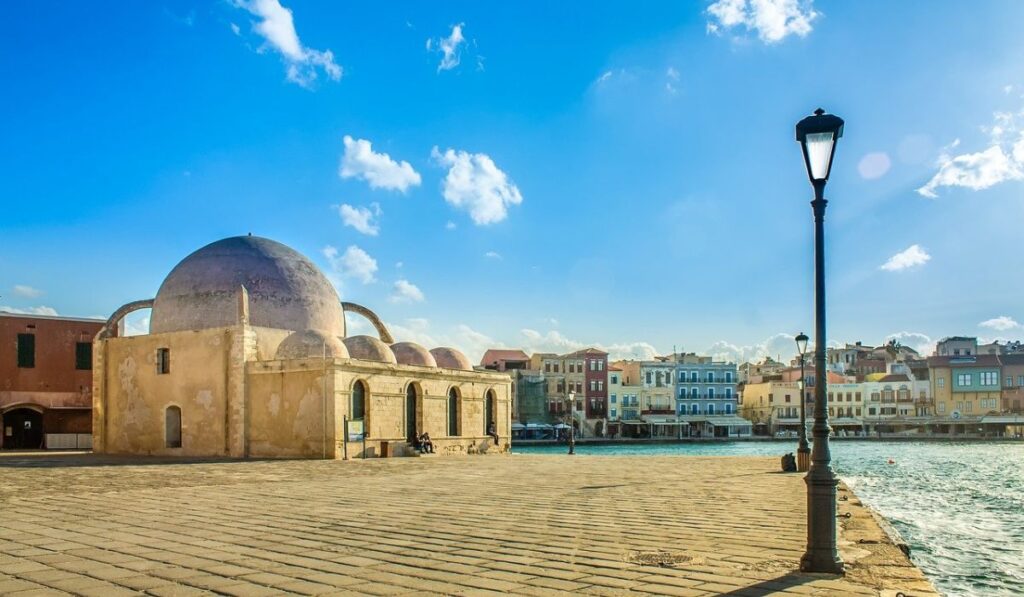
Crete has four large towns, Chania, Rethymno, Heraklion which is the capital of the island, and Agios Nikolaos to the west. If you are going to Crete for the first time then you should start with Chania, a stunning town.
The Venetian Port and Old Town of Chania transport you back in time while remaining a vibrant and thriving hub, a must-visit destination that embodies the rich tapestry of Crete’s history. You can spend a few days discovering the unbelievable wealth of picturesque areas in Chania.
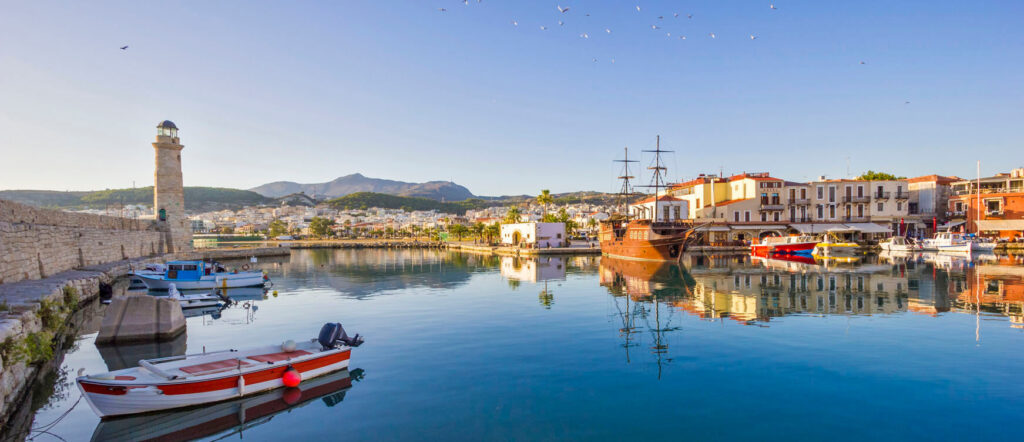
Rethymno, which is one of the oldest towns in Greece built during the Minoan Civilization, has a beautiful Venetian port and Old Town that you will love exploring.
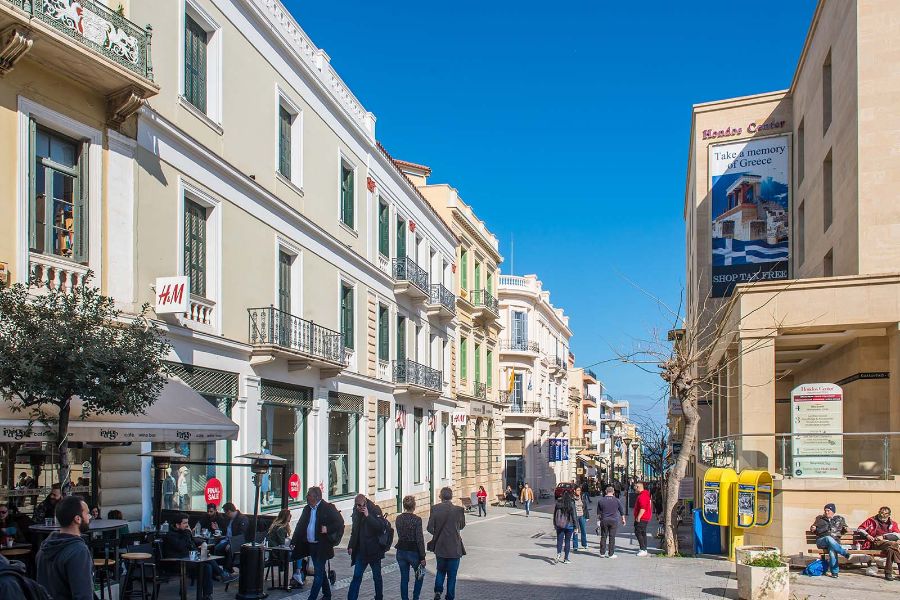
Heraklion is a vibrant town, the financial center of the island with university students that keep always the town vibrant. It also hosts Knossos Palace, the second most visited archaeological site in Greece after the Acropolis Hill in Athens.
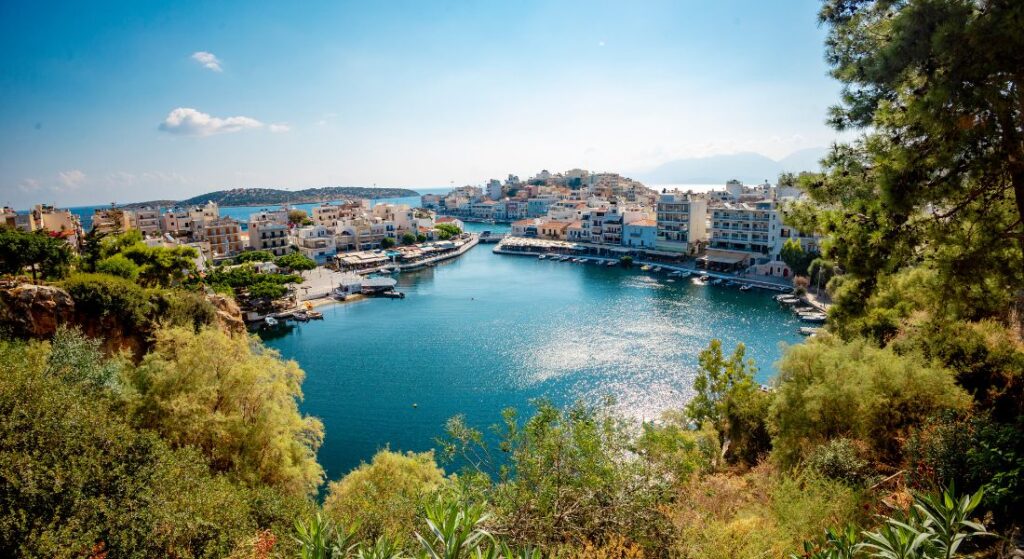
Finally, the gorgeous Agios Nikolaos built around a lake, and so close to cosmopolitan Elounda and Spinalonga island, will fascinate you.
5. Visit the Archaeological Sites
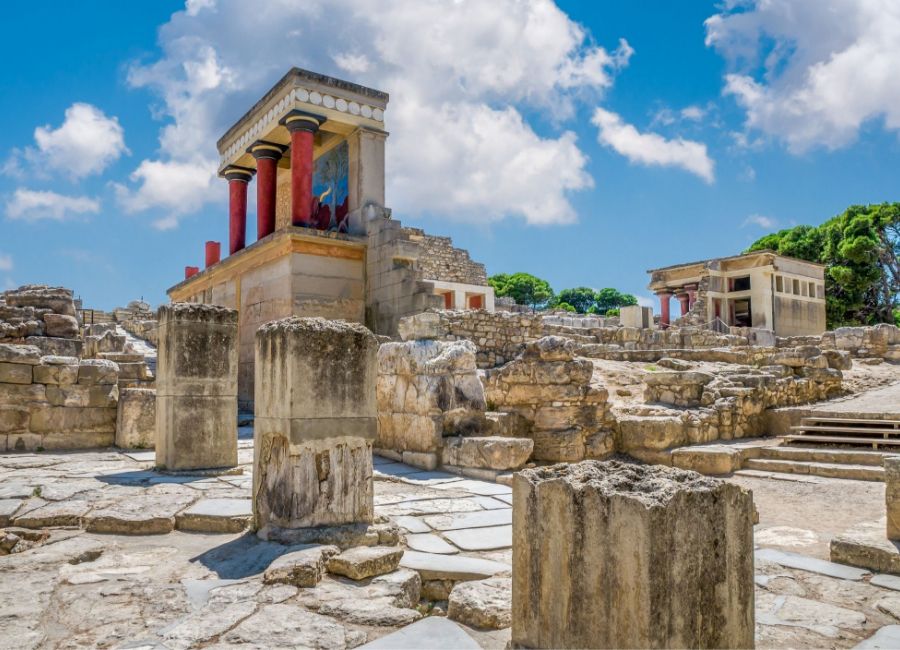
Crete boasts a rich and diverse historical heritage, with ancient ruins, archaeological sites, and well-preserved monuments that stand as a testament to its glorious past. Another great incentive to visit the sites in winter is that entrance is half-price and every first Sunday of November to March, entrance is free for everyone.
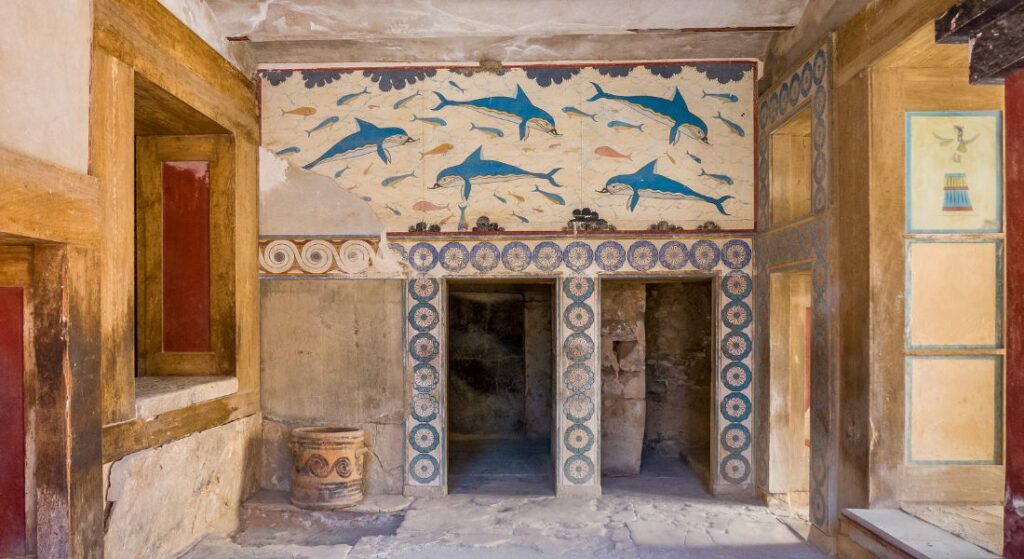
The Minoan Civilization flourished from around 3000 BCE to about 1450 BCE. The distinctive features of Minoan Crete include labyrinthine palatial complexes, vibrant wall frescoes depicting bull-leaping, and intricate golden jewelry.
The most important Minoan Palaces are:
- The ancient Minoan Palace of Knossos and the center of the Minoan civilization. It is located in Heraklion, open every day, and from the 1st of November entrance is between 08.30 and 17.00 (last admission 16:45). Ticket: €8
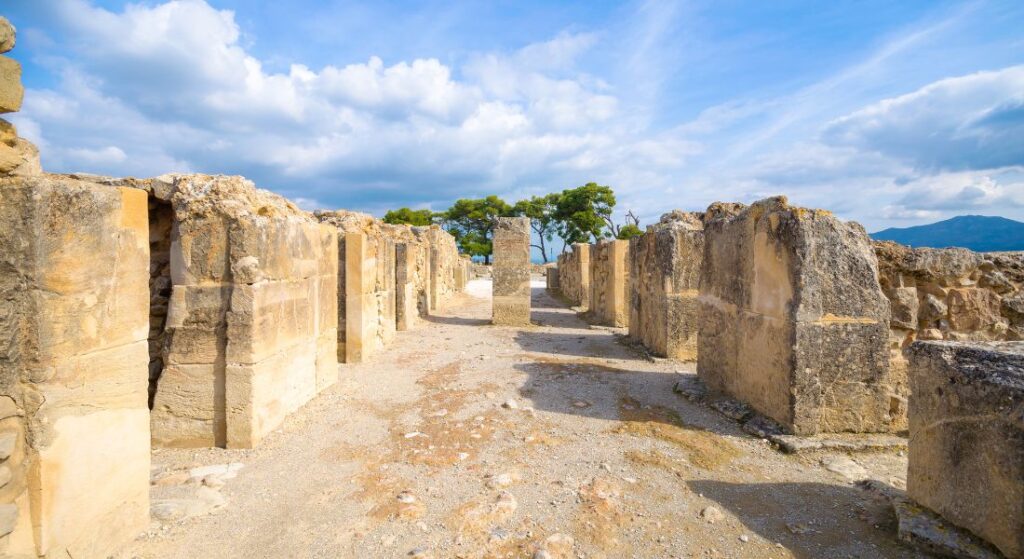
2. Phaistos Palace is a superb architectural complex and is considered to be the finest and most typical of all Minoan palaces. It is located in Heraklion, open every day, and from the 1st of November entrance is between 08.30 and 15.30 (last admission 15:15). Ticket: €4.

3. The Minoan Palace of Malia is situated 3 kilometers to the east of Malia town, next to the Potamos wetland and very close to the sea. This location once held a significant Minoan city and was the third-largest Minoan palace in size, following Knossos and Phaistos. Closed on Tuesdays . From the 1st of November, entrance is between 08.30 and 15.30 (the last admission is 15:15). Ticket: €3
Other equally significant sites are the Minoan site of Agia Triada, the Minoan Palace of Zakros, the ancient city of Aptera, and Eleutherna, home to the necropolis of Orthi Petra, which offers insight into ancient Cretan burials and rituals.
6. Go Hiking – Top Thing to Do in Crete in Winter
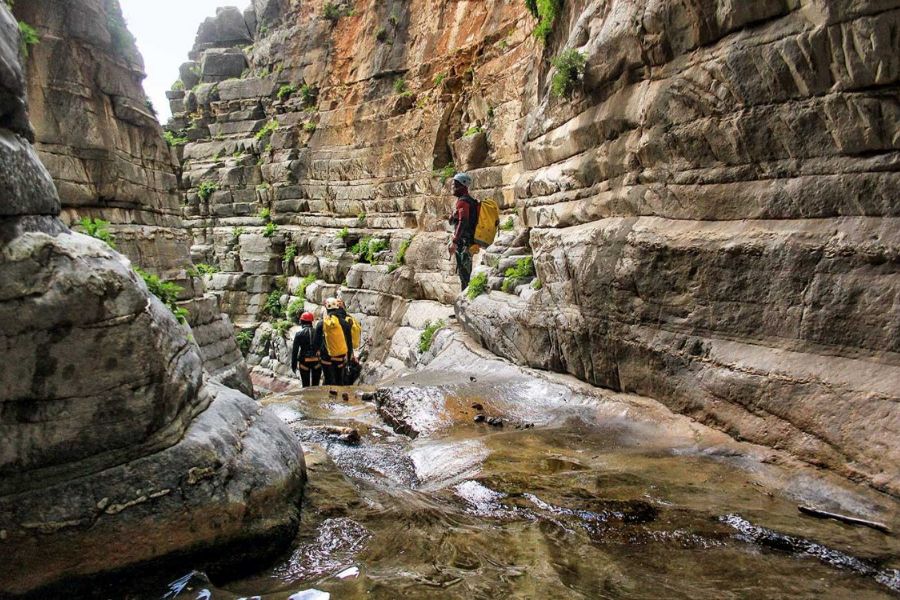
The E4 hiking route begins its journey in Portugal and spans across Spain, France, Switzerland, Austria, Hungary, Serbia, Bulgaria, and Greece, ultimately reaching its endpoint in Crete, where it stretches from Kastelli Kissamou to Kato Zakros. This extensive path is easily identifiable by the presence of distinctive yellow and black markers.
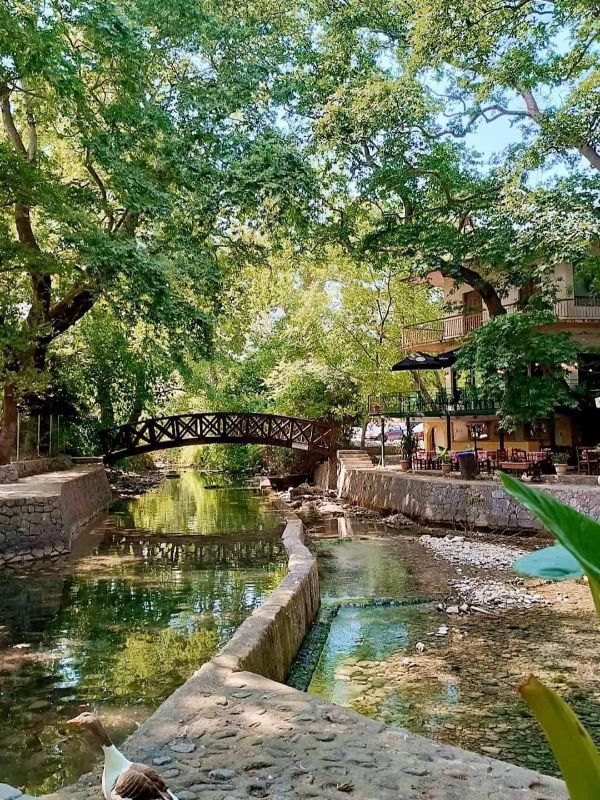
Samaria Gorge may be closed between the 15th of October and the 1st of May but Crete has numerous other trails and gorges to hike, appropriate for winter hiking. However, these hiking trails, frequently suffer from a lack of proper signage. Typically, these trails are indicated by red signs and, on rare occasions, by blue markers. I suggest, depending on the area you are staying, to contact a local guide to take you to the best and safest trails of your area.
Some of my favorite trails are:
- Perdika Gorge in Chania where the largest waterfall in Greece is located (240 meters high).
- The Apokoronou network in Hania is composed of 12 trails, altogether measuring a total of 150km where you will discover small villages, nature, and mountains.
- Ha Gorge in Lasithi with 27 waterfalls and vertical walls 400 m high.
7. Ski in Winter Crete
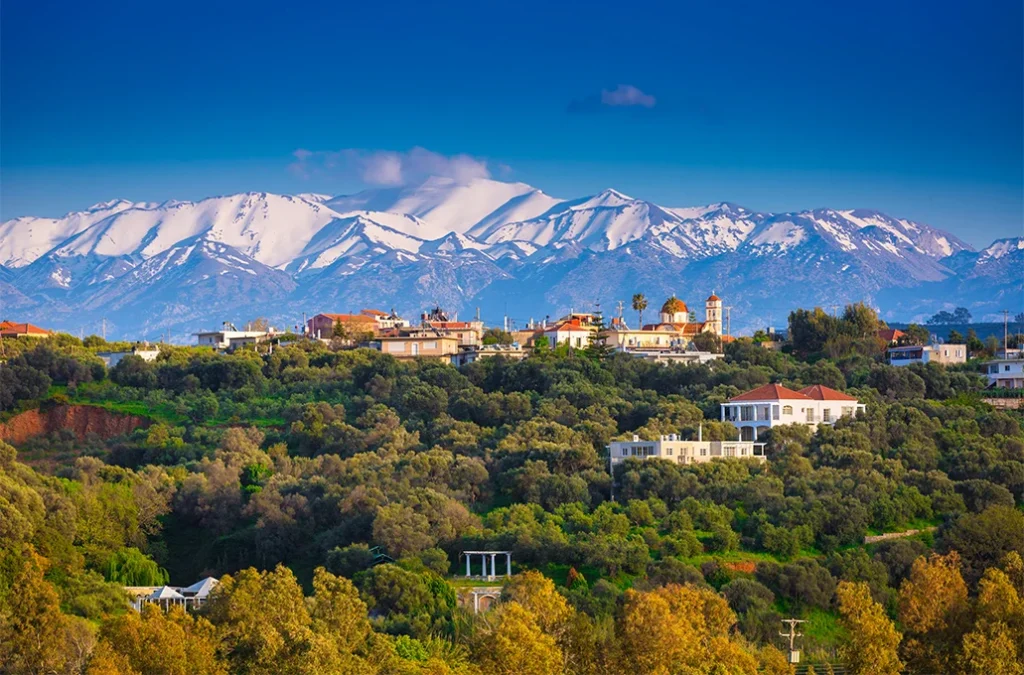
While Crete is not typically known for its ski resorts, there are a few options available for those who want to hit the slopes during their winter visit. The island boasts Mount Psiloritis (in Rethymno) featuring the highest peak, Timios Stavros, at 2,456 meters, the White Mountains or Lefka Ori (in Chania) with Pachnes at 2,454 meters, and Mount Dikti (in Lasithi) with the peak of Spathi at 2,148 meters.
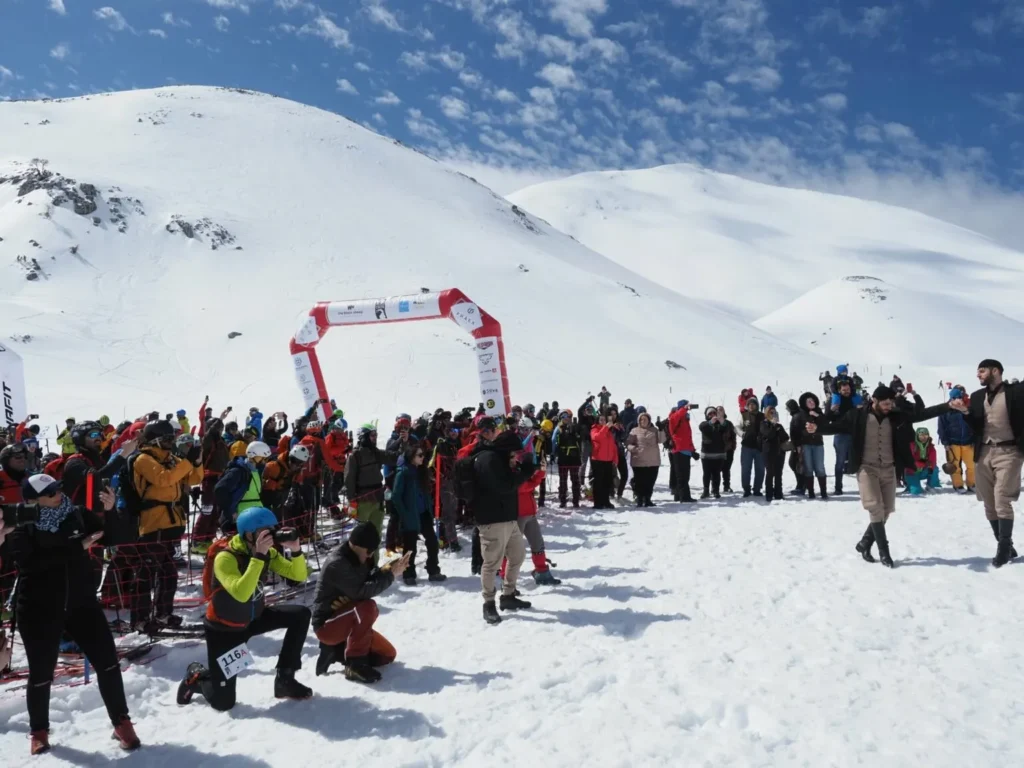
Cretan mountains are ideal for mountaineering in the snow, meaning more hiking and less skiing. In 2014, a small group of devoted hikers organized the first mountain skiing race in Psiloritis, which is now known as Pierra Creta and has become a tradition. Next Pierra Creta will take place 8–10 March 2024 and here you can find out more about the event.
You can contact the Cretan Ski School for more information about skiing in Rethymno.
8. Food Tasting in Crete in Winter
Crete is famous in Greece as the place with the most delicious Greek food. When visiting Crete in winter, you’ll find a wide variety of traditional dishes that are perfect for the colder months. Here are a few top must-try winter dishes in Crete:
Marathopita

Marathopita is a delicious, flat pie with a soft crust, baked with minimal oil in a pan. It is a traditional recipe of Chania, but it is found throughout Crete. For the filling, you will need fresh fennel, which gives a wonderful aroma while usually, they also add spinach and fresh onions.
Gamopilafo (Perfect for winter)
Gamopilafo is a traditional Cretan wedding dish made from rice, lamb, and a variety of herbs and spices. The rice is boiled in the broth of the meat that has been previously cooked. It is served hot, along with the boiled meat, with lemon, salt, and pepper. It’s a comforting and filling dish that’s perfect for a cold winter day.

Dakos is a traditional Cretan salad made with barley rusk, tomato, xinomizithra cheese, and extra virgin olive oil. For extra flavor, in many small taverns, they soak the barley rusk in seawater.
Kalitsounia

Kalitsounia are small pies that are a popular snack in Crete. They are made with mizithra cheese or greens and herbs wrapped in dough. Those containing mizithra are usually served with plenty of honey and cinnamon.
These are traditional dishes that you will find in the vast majority of restaurants and taverns wherever you are in Crete. One of the best ways to enjoy the local food is to book the Authentic Cooking Class in the White Mountains (Chania).
Where To Stay in Crete in Winter
Many hotels and resorts remain open year-round in Crete, and you can often find great deals on accommodation during the winter months. I suggest you stay at one of the large towns in Crete and take day trips to various destinations around the island.
Where to Stay in Chania
Hyperion City Hotel & Spa is a 4-star seafront hotel near all the attractions in Chania (mid-range).
Captain Nick is a great apartment very close to the sea and the center of Chania (budget).
Where to Stay in Rethymno
Palazzino Di Corina is a beautiful hotel featuring antique furniture and spa baths, located in a quiet street in the heart of Rethymno’s Old Town.
Polyxenia Suites is a fantastic apartment in the Old part of Rethymno with stunning city views.
Where to Stay in Heraklion
Infinity City Boutique Hotel has modern, minimalist-style decor in the center of Heraklion(mid-range).
Kipos Boutique Suites has beautifully decorated rooms in the center of the town (budget).
Where to Stay in Agios Nikolaos
Naiades Marina Hotel is a fantastic value-for-money seafront hotel 300 meters from Agios Nikolaos Port (budget).
Beachfront Salty Sea Luxury Suite 2 is located at an exceptional location (mid-range, self-catering).
FAQ for Crete Island
How to get around crete in winter.
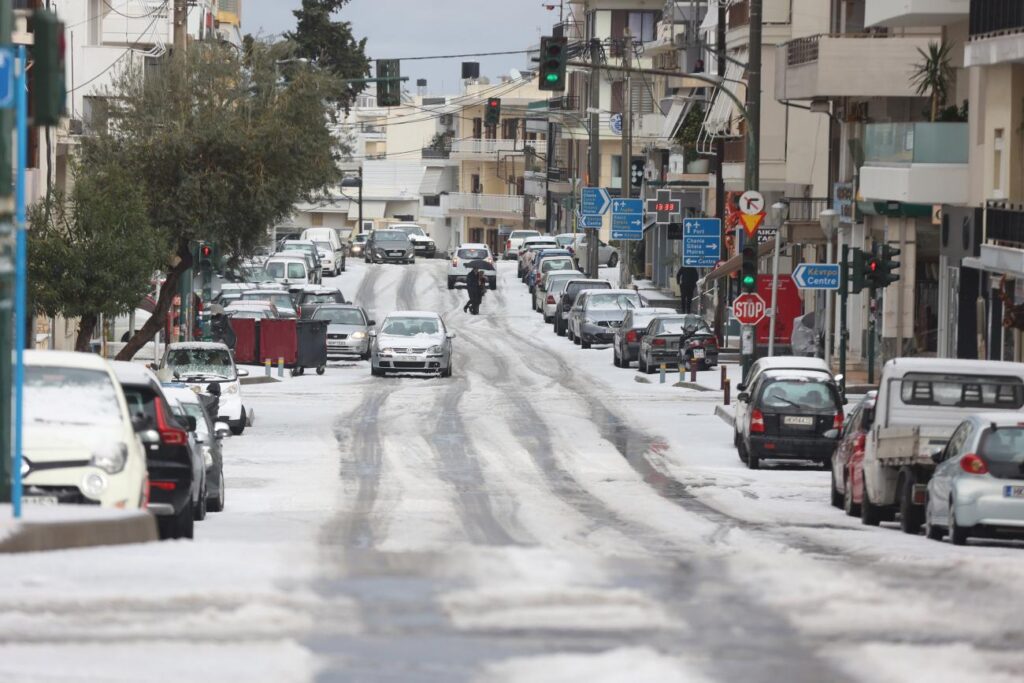
Renting a car is the best way to explore Crete during the winter season. The roads are less congested, making it easy to travel to various parts of the island. There will be 2 to 3 days of snow in January and February in the towns, much more, however, in the mountains. If you plan to head into the mountains, ensure that you have a suitable vehicle for wet roads and carry chains with you in case you encounter snow.
How to Get to Crete in Winter
Flights to Crete : There are daily flights from Athens to Crete . Aegean Airlines operates daily flights from Athens to both Chania and Heraklion, while additional flights to Heraklion are offered by Sky Εxpress . The flight time to Crete is 50 minutes.
Ferries to Crete: There are daily connections from Piraeus, Athens’ main port, by ANEK Lines that takes you to Chania or Heraklion, and Minoan Lines offering transportation to Heraklion. The ferry travel time ranges from 8.5 to 10 hours.
How Long Should I Stay in Crete
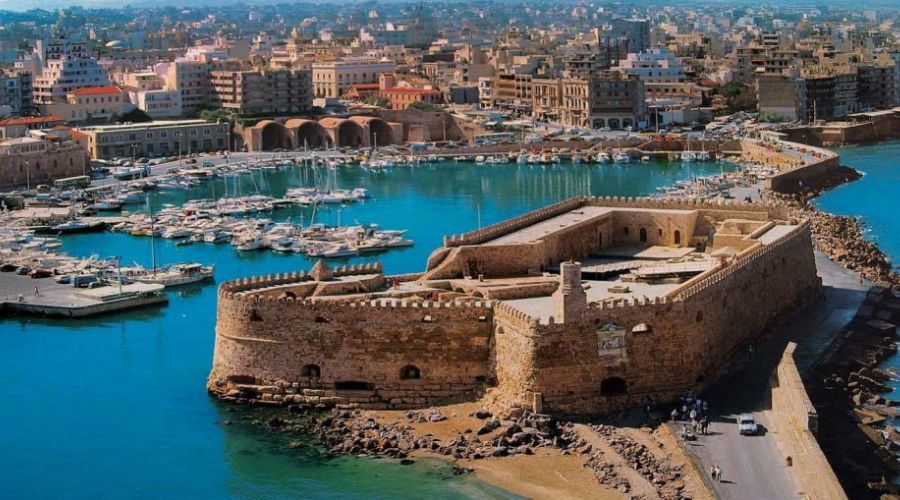
No matter what season you are visiting, you should keep aside a minimum of a week and even better 2 weeks.
How crowded is Crete during the winter months?
Crete is much less crowded during the winter months, which makes it an ideal time to visit if you prefer a more relaxed and peaceful atmosphere. You can enjoy the island’s attractions without the crowds and queues that are common during the summer months. However, there are hundreds of thousands of locals and many major universities so it will be quite lively.
Is it cheaper to visit Crete during the winter season?
Yes, it is generally cheaper to visit Crete during the winter season. Flights and accommodations are usually less expensive, and you can often find discounts on tours and activities. Plus all the archaeological sites are half price and every first Sunday of November to March, entrance is free for everyone.
FAQ for Driving in Greece in Winter
- In case you want to rent a car, you may need an International Driving Permit. However, the residents of the US, Canada Australia, the UK, and Gibralta r are exempted from this obligation and can rent with their national driving permits as long as they are over 18 years old ( Article 94 of Greek Law No. 4850/2021 – November 5, 2021) . Greeks drive the right-hand side of a street.
- Always carry chains for your tires , you never know when the next crazy blizzard will find you.
- Rent a car with Discover Cars for new and affordable vehicles.
- Most of the country is connected by a highway system that uses tolls – open all year through. However, smaller roads in the mountains might be closed due to heavy snow.
- Belts are mandatory and you get a huge fine if you haven’t fastened them up.
- Young children should always be kept in their special seats, fastened, in the back seat. Children under 10 are not allowed in the front seat.
- Driving and talking on the phone also can give you a gigantic fine, use hands-free options.
- It’s illegal to drive with a blood-alcohol level of more than 0.05%.
- The high-speed roads are in excellent condition. When you get off the main highways, the roads get significantly smaller.
- Read here some regulations about vehicles in Greece .
What to Pack for Winter in Crete
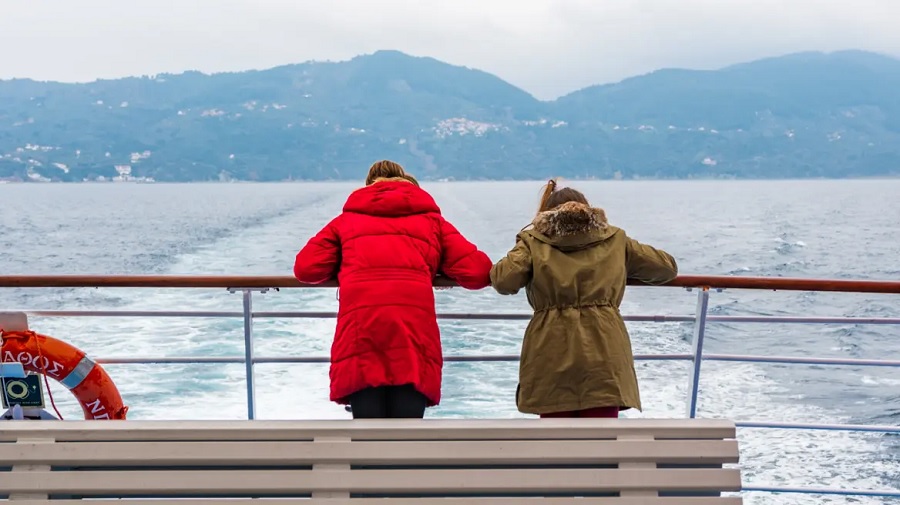
Although Crete is generally warmer than other parts of Europe during winter, it can still get chilly. Make sure to pack warm clothing, including a coat , hat , gloves , and scarf. You may also want to bring a rain jacket , as winter in Crete can be wet. Make sure you check the weather forecast before you start packing but just in case add some heavy wintry clothes.
Visiting Crete in winter is a great idea for those who want to escape from harsh cold climates and enjoy the culture and history of one of Europe’s most popular islands without dealing with the hordes of tourists who come in the summer.
Other Posts for Crete Island:
- 21 Best Things to Do in Rethymno
- 28 Best Places in Crete
- What to Do in Chania
- Where to Stay on Crete Island
Athens Airport to Piraeus Port

- Bus: If you are arriving at Athens International Airport you can travel straight to the port by taking the X96 express bus (€5.5, children <6 yo, free entrance) , which departs every 40 minutes and the average trip lasts 1 hour – runs 24/7.
- Metro : (€9) is easily found across airport arrivals (blue line – M3) going directly to Piraeus port. The average trip to Piraeus lasts 1 hour.
- Taxis are available in front of the airport (around €40 to Athens, €55-60 to Piraeus (depending on the traffic in Kifisos), and take up to 3 or 4 people with small luggage)
- Rent a car with Discover Cars for reliable, new cars at affordable prices
- You don’t like driving but love hassle-free solutions? Book a Private transfer with an English-speaking driver from Athens International Airport to Piraeus Ferries, or anywhere else in Greece
- Are you looking for domestic flights in Greece ? Check out the official Aegean Airlines Website.
Essential Travel Info for Greece
- ‘Hello’ and ‘Thank You’ in Greek: “Ya sou” and “Efharisto”
- Booking.com : I use Booking.com because I can get the best deals on hotels and apartments, free cancellations, and great prices!
- All-Inclusive Resorts in Greece
- FerryScanner to book f erries to the Greek Islands
- Rent an Affordable Car in Greece
- Athens Metro Website (timetables and ticket info)
- Map of Athens Metro
- Trains (Hellenic Train)
- Public Buses KTEL
- Get Your Guide : For all your day or multi-day tours and city guide needs, I use Get Your Guide
- Emergency Numbers Anywhere in Greece: AMBULANCE 166 – FIRE 199 – POLICE 100 – EMERGENCY NUMBER 112
Evgenia Mataragka
What is best to wear in greece in november, sailing in greece: everything you need to know, leave a comment cancel reply.
Save my name, email, and website in this browser for the next time I comment.
About Evgenia
Privacy Policy
FOLLOW US ON SOCIAL
GEMI: 169951603000
TRAVEL RESOURCES
Hotels in Athens
Plan My Trip to Greece
Guided Tours
© 2024 Travel The Greek Way
Travel Blog for Greece
You cannot copy content of this page

ICOT2022 Annual Conference
Back to the future: reconfiguring the travel industry.
The ICOT2022 conference builds on the eminent support of the international scholarly community and the success of the previous eleven International Conferences on Tourism (ICOT) held in Greece, China, Cyprus, U.K., Italy, Thailand, Portugal but also virtually following the COVID-19 outbreak.
The twenty-first century brought unprecedented challenges for the tourism, hospitality and events industries. Until the end of 2019, globalization vs glocalization, extravagant economic and travel activities, marked issues related to climate change, overtourism vs degrowth, terrorism and the aftermath of the economic crisis of 2008 comprised the most talked-about topics in tourism studies. Then, the outbreak of the COVID-19 pandemic changed dramatically the scenery and the priorities of the tourism and hospitality industries. Even experienced and ‘heavy’ travelers and travel lovers have to rethink on their beloved hobby. Destinations, which were troubled with over-tourism in 2019, need now to re-orientate their strategic plans. Focusing on the place rather than the destination, branding becomes a priority in order to effectively manage the destinations as safe places for international and domestic travelers, investors and local communities alike.
ICOT 2022 seeks to contribute to the debate regarding how to decrease risk and uncertainty in order to resume the viability of tourism. For some, a focus on sustainable practices and crisis management initiatives, appears more necessary than ever before. On the other hand, other practitioners and scholars believe that the COVID-19 impacts on destinations and the traveler’s attitude is temporary.
The conference will stimulate discussion and exchange of ideas related to the conference theme and beyond, between tourism professionals, academics, researchers, policy-makers, consultants, practitioners, government officials and postgraduate students from tourism academia and related fields.
We therefore invite submissions on all aspects of tourism development, policy, planning, growth and degrowth that will add to the current debate.

We've detected unusual activity from your computer network
To continue, please click the box below to let us know you're not a robot.
Why did this happen?
Please make sure your browser supports JavaScript and cookies and that you are not blocking them from loading. For more information you can review our Terms of Service and Cookie Policy .
For inquiries related to this message please contact our support team and provide the reference ID below.

IMAGES
VIDEO
COMMENTS
Crete 2021: Occupancy rate between 70 and 94% in August. Crete, this season, is aiming to regain a large percentage of ground lost last summer following record tourism figures registered in pre-pandemic 2019.Looking further ahead, the island is striving for a return to full normality in 2022 and 2023.. High occupancy rates have been registered for accommodation units at popular destinations ...
Crete is the largest Greek island and a landmark in the maritime crossroads between the West and the East, Europe and Africa, a unique and fascinating place full of transitions and surprises. With its infinite coastline and mountain tops, a history that spans back to the end of times and a distinctive identity that bears its mark on every ...
Number of inbound tourist visits to the Greek Island of Crete from 2019 to 2022, by country of origin (in 1,000s) [Graph], Bank of Greece, April 12, 2023. [Online].
The largest island in Greece, Crete is renowned for its pin-up beaches, wild natural beauty, exquisite cuisine and thousands of years of culture and history. As Crete's most celebrated author, Nikos Kazantzakis (of Zorba the Greek fame), once wrote: " The mystery of Crete runs deep. Whoever sets foot on this island senses a mysterious force ...
Crete has lovely weather year-round, with temperatures rarely dropping below 12°C (61°F) in the coldest months and averaging 26°C (79°F) daily during the summer. May to the end of September are the busiest tourist months, so if you want to avoid the crowds and inflated prices, come during the shoulder seasons (spring and autumn).
Whatever your mood, Crete has the perfect place for you - here are eight of our favorites. 1. Hania. Best city for dining and walking. Crete's second-largest city has many excellent places to eat, lining the labyrinth of ancient stone lanes that make up its 17th-century Venetian quarter. Some of the finest food in all of Greece can be found ...
1. Visit the famous historical Palace of Knossos. At the Palace of Knossos , you can feel the playful passion of the artists who painted its many frescoes 4000 years ago, such as the one in the queen's megaron (bedroom) showing dolphins frolicking. Check out the charging bulls on the famous work near the North Entrance.
3. Agios Nikolaos. Agios Nikolaos. Rimmed by beautiful beaches and looking across scenic Mirabello Bay, Agios Nikolaos is a charming small city on the north coast of eastern Crete, about 65 kilometers east of Heraklion. Although it is definitely a tourist town, it feels much less touristy than places like Chania.
Crete is a very popular destination but that doesn't mean there aren't ways to visit on a budget. Here are some top tips to stretch your euros even further. Read article. Free Things to Do. Check out our top tips on free things to do in Crete. From beaches to historical landmarks, there are plenty of activities that won't break the bank.
Crete is the largest island in Greece, and the fifth largest one in the Mediterranean Sea. Here, you can admire the remnants of brilliant civilizations, explore glorious beaches, impressive mountainscapes, fertile valleys and steep gorges, and become part of the island's rich gastronomic culture. Crete is, after all, a small universe teeming ...
Crete Travel & Tourism Guide. Tours, Beaches / Long Road Map / Entertainment. Welcome to the beautiful island of Crete, a heavenly and pure land brimming with natural beauty, history and culture. Discover marvelous beaches, explore rugged gorges, enjoy unique local flavors and enjoy the rare Cretan hospitality. Visitcreta.gr.
In 2022, the total contribution of travel and tourism to GDP in Greece was around 38 billion euros. This figure, however, was roughly seven percent lower than in 2019, the year prior to the onset ...
Rethymnon: The 13 best things to do. Balos Beach: All my best tips to visit Balos Lagoon! Elafonissi Beach: The definitive guide to discover Crete's famous pink sand beach. Palace of Knossos: The definitive guide to visit the most famous archaeological site of Crete. Samaria Gorge: How to plan the best hike in Crete.
The market share of the French market in inbound tourism in 2021 was 8.0%, when in 2016 it was 5.3% and in 2019 it was 4.9%. The Greek Tourism 2022 Statistics most popular destinations for tourists from France to Greece in 2021 were the South Aegean, Crete and Attica. In terms of overnight stays, in the period 2016-2019 there was an increase of ...
In terms of tourism earnings, the Bank of Greece's figures for the first eight months of 2023 appear to support the initial estimates, which projected over 20 billion euros. From January to August 2023, travel earnings saw a notable increase of 15.3% compared to the same period in 2022, reaching a total of 14.6 billion euros.
From INSETE's annual report, the direct contribution of tourism to the Greek GDP in 2023 is estimated at 24 billion euros or 11.5%, with five Regions representing almost 90% of the country's receipts, three of which are purely tourist Regions. For this year, based on the estimates from the Central Bank, Greek tourism figures are expected to ...
Rough Guides® is a trademark owned by Apa Group with its headquarters at 7 Bell Yard London WC2A 2JR, United Kingdom. Plan your visit to Crete, Greece: find out where to go and what to do in Crete with Rough Guides. Read about itineraries, activities, places to stay and travel essentials and get inspiration from the blog in the best guide to ...
Let's explore the best things to do in Crete: 1. Knossos. Source: Timofeev Vladimir / shutterstock. Knossos, Crete. A few kilometres south of Crete's modern capital, Heraklion was the capital of Minoan Crete. Knossos is the name of a palace and its encompassing city, which had a population of up to 100,000 in the 18th century BC.
Leading inbound travel markets in Crete, Greece 2019-2022, by number of visits; International air arrivals on the Ionian Islands, Greece 2010-2023, by island ... Inbound tourism volume in Trinidad ...
Weather Considerations: October in Crete is generally pleasant with mild temperatures. However, it's essential to be prepared for variations. Average temperatures during the day can range from 20°C to 25°C (68°F to 77°F), but evenings can be cooler, so having a light jacket or sweater is advisable.
Apokoronas in Chania. Credit: Crete my Second Home. Population: 634.930 residents (census 2019) Acreage: 8,336 sq km with 81 uninhabited islets. 5th largest island in the Mediterranean after Sicily, Sardinia, Cyprus, and Corsica. Economy: Agriculture, processing-packaging, and services (tourism).; Terrain: Extremely mountainous with three main mountain ranges.
The town of Lindos on Rhodes. Credit: Wikipedia/ Jebulon /Public domain. Greece's tourism figures have soared in the first 10 months of the year, as the air and road arrivals data published by the Greek Tourism Confederation (SETE) show.. Specifically in the January-October 2023 period, 23 million international air arrivals were recorded, surpassing the January-October 2022 figures, showing ...
The ICOT2022 conference builds on the eminent support of the international scholarly community and the success of the previous eleven International Conferences on Tourism (ICOT) held in Greece, China, Cyprus, U.K., Italy, Thailand, Portugal but also virtually following the COVID-19 outbreak. The twenty-first century brought unprecedented ...
The wildfires on Crete started one month before the official fire season was scheduled to kick off in the Mediterranean country, which over the recent years has been embattled by heatwaves, strong ...
The region's economy is set to grow at a 4.9% pace this year and in 2025, according to the group's annual outlook. Inflation is seen easing slightly to 3.2% this year and 3% in 2025 from an ...